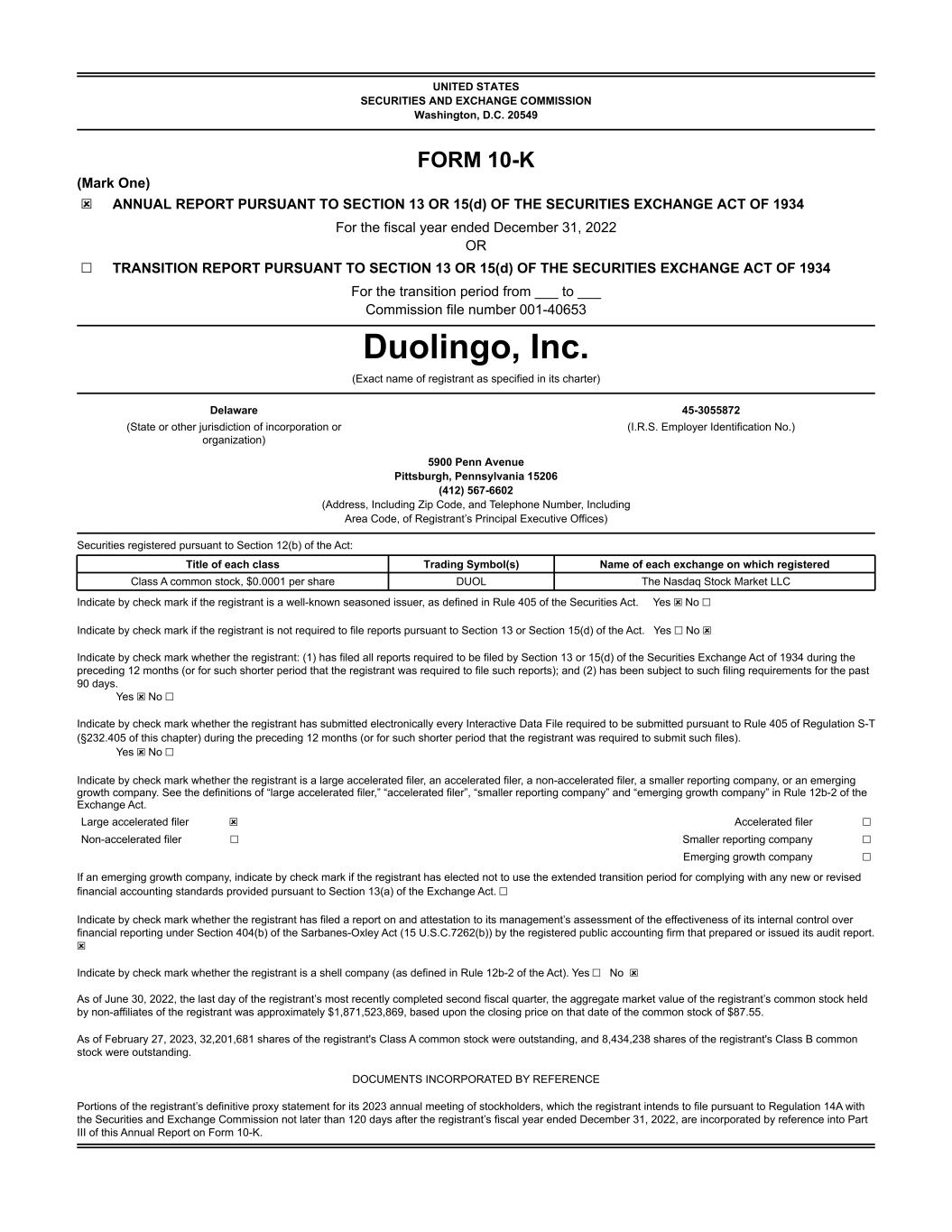
UNITED STATES SECURITIES AND EXCHANGE COMMISSION Washington, D.C. 20549 FORM 10-K (Mark One) ☒ ANNUAL REPORT PURSUANT TO SECTION 13 OR 15(d) OF THE SECURITIES EXCHANGE ACT OF 1934 For the fiscal year ended December 31, 2022 OR ☐ TRANSITION REPORT PURSUANT TO SECTION 13 OR 15(d) OF THE SECURITIES EXCHANGE ACT OF 1934 For the transition period from ___ to ___ Commission file number 001-40653 Duolingo, Inc. (Exact name of registrant as specified in its charter) Delaware 45-3055872 (State or other jurisdiction of incorporation or organization) (I.R.S. Employer Identification No.) 5900 Penn Avenue Pittsburgh, Pennsylvania 15206 (412) 567-6602 (Address, Including Zip Code, and Telephone Number, Including Area Code, of Registrant’s Principal Executive Offices) Securities registered pursuant to Section 12(b) of the Act: Title of each class Trading Symbol(s) Name of each exchange on which registered Class A common stock, $0.0001 per share DUOL The Nasdaq Stock Market LLC Indicate by check mark if the registrant is a well-known seasoned issuer, as defined in Rule 405 of the Securities Act. Yes ☒ No ☐ Indicate by check mark if the registrant is not required to file reports pursuant to Section 13 or Section 15(d) of the Act. Yes ☐ No ☒ Indicate by check mark whether the registrant: (1) has filed all reports required to be filed by Section 13 or 15(d) of the Securities Exchange Act of 1934 during the preceding 12 months (or for such shorter period that the registrant was required to file such reports); and (2) has been subject to such filing requirements for the past 90 days. Yes ☒ No ☐ Indicate by check mark whether the registrant has submitted electronically every Interactive Data File required to be submitted pursuant to Rule 405 of Regulation S-T (§232.405 of this chapter) during the preceding 12 months (or for such shorter period that the registrant was required to submit such files). Yes ☒ No ☐ Indicate by check mark whether the registrant is a large accelerated filer, an accelerated filer, a non-accelerated filer, a smaller reporting company, or an emerging growth company. See the definitions of “large accelerated filer,” “accelerated filer”, “smaller reporting company” and “emerging growth company” in Rule 12b-2 of the Exchange Act. Large accelerated filer ☒ Accelerated filer ☐ Non-accelerated filer ☐ Smaller reporting company ☐ Emerging growth company ☐ If an emerging growth company, indicate by check mark if the registrant has elected not to use the extended transition period for complying with any new or revised financial accounting standards provided pursuant to Section 13(a) of the Exchange Act. ☐ Indicate by check mark whether the registrant has filed a report on and attestation to its management’s assessment of the effectiveness of its internal control over financial reporting under Section 404(b) of the Sarbanes-Oxley Act (15 U.S.C.7262(b)) by the registered public accounting firm that prepared or issued its audit report. ☒ Indicate by check mark whether the registrant is a shell company (as defined in Rule 12b-2 of the Act). Yes ☐ No ☒ As of June 30, 2022, the last day of the registrant’s most recently completed second fiscal quarter, the aggregate market value of the registrant’s common stock held by non-affiliates of the registrant was approximately $1,871,523,869, based upon the closing price on that date of the common stock of $87.55. As of February 27, 2023, 32,201,681 shares of the registrant's Class A common stock were outstanding, and 8,434,238 shares of the registrant's Class B common stock were outstanding. DOCUMENTS INCORPORATED BY REFERENCE Portions of the registrant’s definitive proxy statement for its 2023 annual meeting of stockholders, which the registrant intends to file pursuant to Regulation 14A with the Securities and Exchange Commission not later than 120 days after the registrant’s fiscal year ended December 31, 2022, are incorporated by reference into Part III of this Annual Report on Form 10-K.
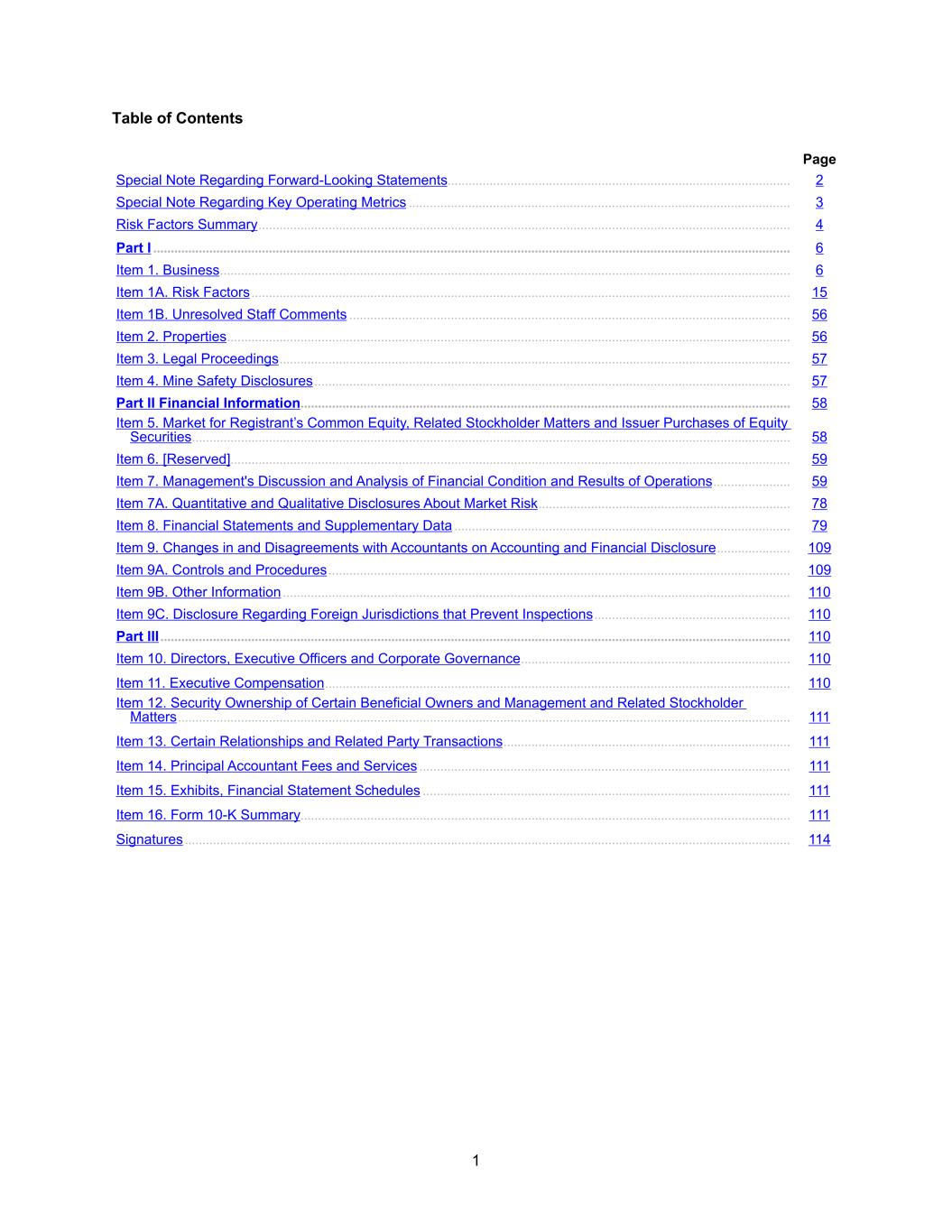
Table of Contents Page Special Note Regarding Forward-Looking Statements .................................................................................................. 2 Special Note Regarding Key Operating Metrics ............................................................................................................. 3 Risk Factors Summary ........................................................................................................................................................ 4 Part I ...................................................................................................................................................................................... 6 Item 1. Business ................................................................................................................................................................... 6 Item 1A. Risk Factors .......................................................................................................................................................... 15 Item 1B. Unresolved Staff Comments .............................................................................................................................. 56 Item 2. Properties ................................................................................................................................................................. 56 Item 3. Legal Proceedings .................................................................................................................................................. 57 Item 4. Mine Safety Disclosures ........................................................................................................................................ 57 Part II Financial Information ............................................................................................................................................ 58 Item 5. Market for Registrant’s Common Equity, Related Stockholder Matters and Issuer Purchases of Equity Securities ........................................................................................................................................................................... 58 Item 6. [Reserved] ................................................................................................................................................................ 59 Item 7. Management's Discussion and Analysis of Financial Condition and Results of Operations ...................... 59 Item 7A. Quantitative and Qualitative Disclosures About Market Risk ........................................................................ 78 Item 8. Financial Statements and Supplementary Data ................................................................................................ 79 Item 9. Changes in and Disagreements with Accountants on Accounting and Financial Disclosure ..................... 109 Item 9A. Controls and Procedures .................................................................................................................................... 109 Item 9B. Other Information ................................................................................................................................................. 110 Item 9C. Disclosure Regarding Foreign Jurisdictions that Prevent Inspections ........................................................ 110 Part III .................................................................................................................................................................................... 110 Item 10. Directors, Executive Officers and Corporate Governance ............................................................................. 110 Item 11. Executive Compensation ..................................................................................................................................... 110 Item 12. Security Ownership of Certain Beneficial Owners and Management and Related Stockholder Matters ............................................................................................................................................................................... 111 Item 13. Certain Relationships and Related Party Transactions .................................................................................. 111 Item 14. Principal Accountant Fees and Services .......................................................................................................... 111 Item 15. Exhibits, Financial Statement Schedules ......................................................................................................... 111 Item 16. Form 10-K Summary ............................................................................................................................................ 111 Signatures ............................................................................................................................................................................. 114 1
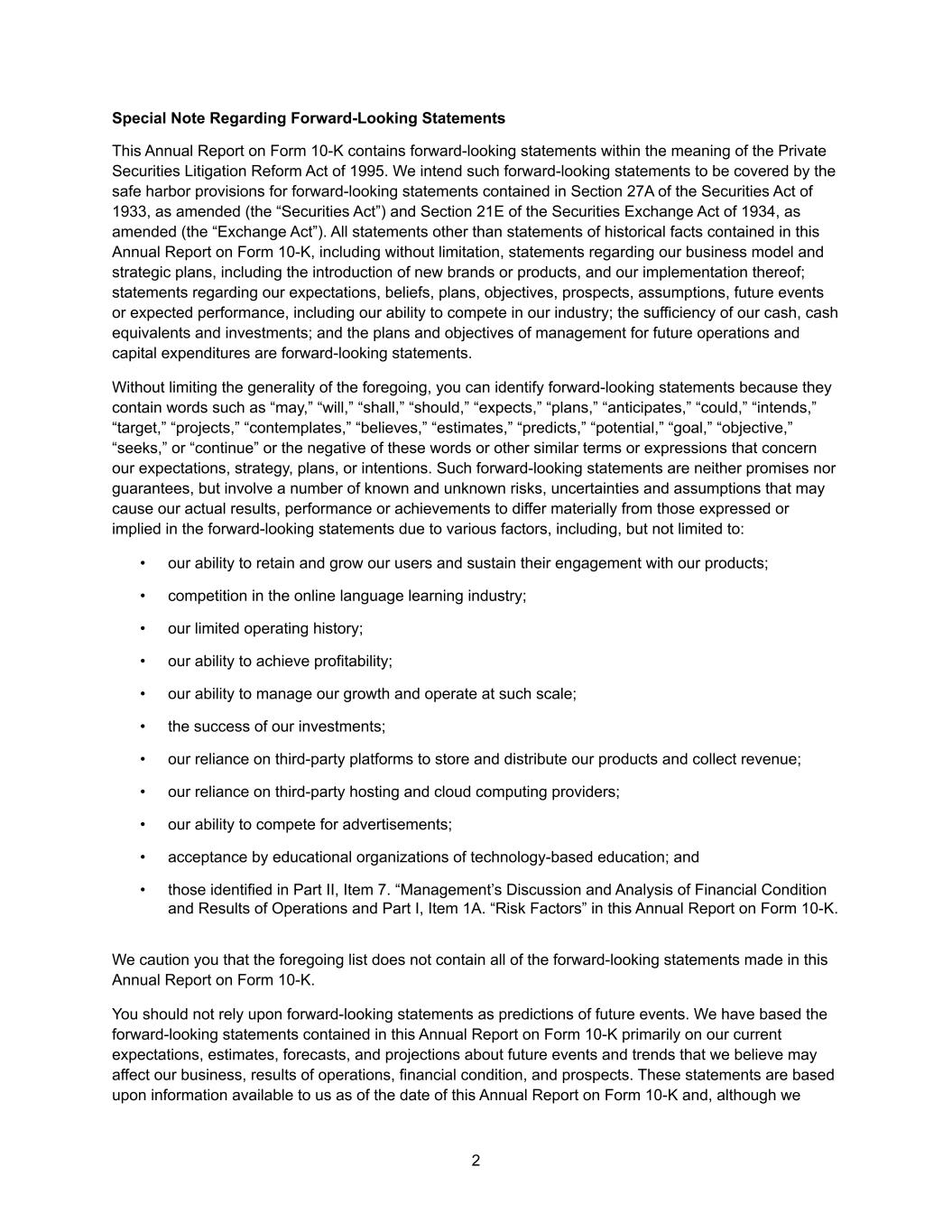
Special Note Regarding Forward-Looking Statements This Annual Report on Form 10-K contains forward-looking statements within the meaning of the Private Securities Litigation Reform Act of 1995. We intend such forward-looking statements to be covered by the safe harbor provisions for forward-looking statements contained in Section 27A of the Securities Act of 1933, as amended (the “Securities Act”) and Section 21E of the Securities Exchange Act of 1934, as amended (the “Exchange Act”). All statements other than statements of historical facts contained in this Annual Report on Form 10-K, including without limitation, statements regarding our business model and strategic plans, including the introduction of new brands or products, and our implementation thereof; statements regarding our expectations, beliefs, plans, objectives, prospects, assumptions, future events or expected performance, including our ability to compete in our industry; the sufficiency of our cash, cash equivalents and investments; and the plans and objectives of management for future operations and capital expenditures are forward-looking statements. Without limiting the generality of the foregoing, you can identify forward-looking statements because they contain words such as “may,” “will,” “shall,” “should,” “expects,” “plans,” “anticipates,” “could,” “intends,” “target,” “projects,” “contemplates,” “believes,” “estimates,” “predicts,” “potential,” “goal,” “objective,” “seeks,” or “continue” or the negative of these words or other similar terms or expressions that concern our expectations, strategy, plans, or intentions. Such forward-looking statements are neither promises nor guarantees, but involve a number of known and unknown risks, uncertainties and assumptions that may cause our actual results, performance or achievements to differ materially from those expressed or implied in the forward-looking statements due to various factors, including, but not limited to: • our ability to retain and grow our users and sustain their engagement with our products; • competition in the online language learning industry; • our limited operating history; • our ability to achieve profitability; • our ability to manage our growth and operate at such scale; • the success of our investments; • our reliance on third-party platforms to store and distribute our products and collect revenue; • our reliance on third-party hosting and cloud computing providers; • our ability to compete for advertisements; • acceptance by educational organizations of technology-based education; and • those identified in Part II, Item 7. “Management’s Discussion and Analysis of Financial Condition and Results of Operations and Part I, Item 1A. “Risk Factors” in this Annual Report on Form 10-K. We caution you that the foregoing list does not contain all of the forward-looking statements made in this Annual Report on Form 10-K. You should not rely upon forward-looking statements as predictions of future events. We have based the forward-looking statements contained in this Annual Report on Form 10-K primarily on our current expectations, estimates, forecasts, and projections about future events and trends that we believe may affect our business, results of operations, financial condition, and prospects. These statements are based upon information available to us as of the date of this Annual Report on Form 10-K and, although we 2
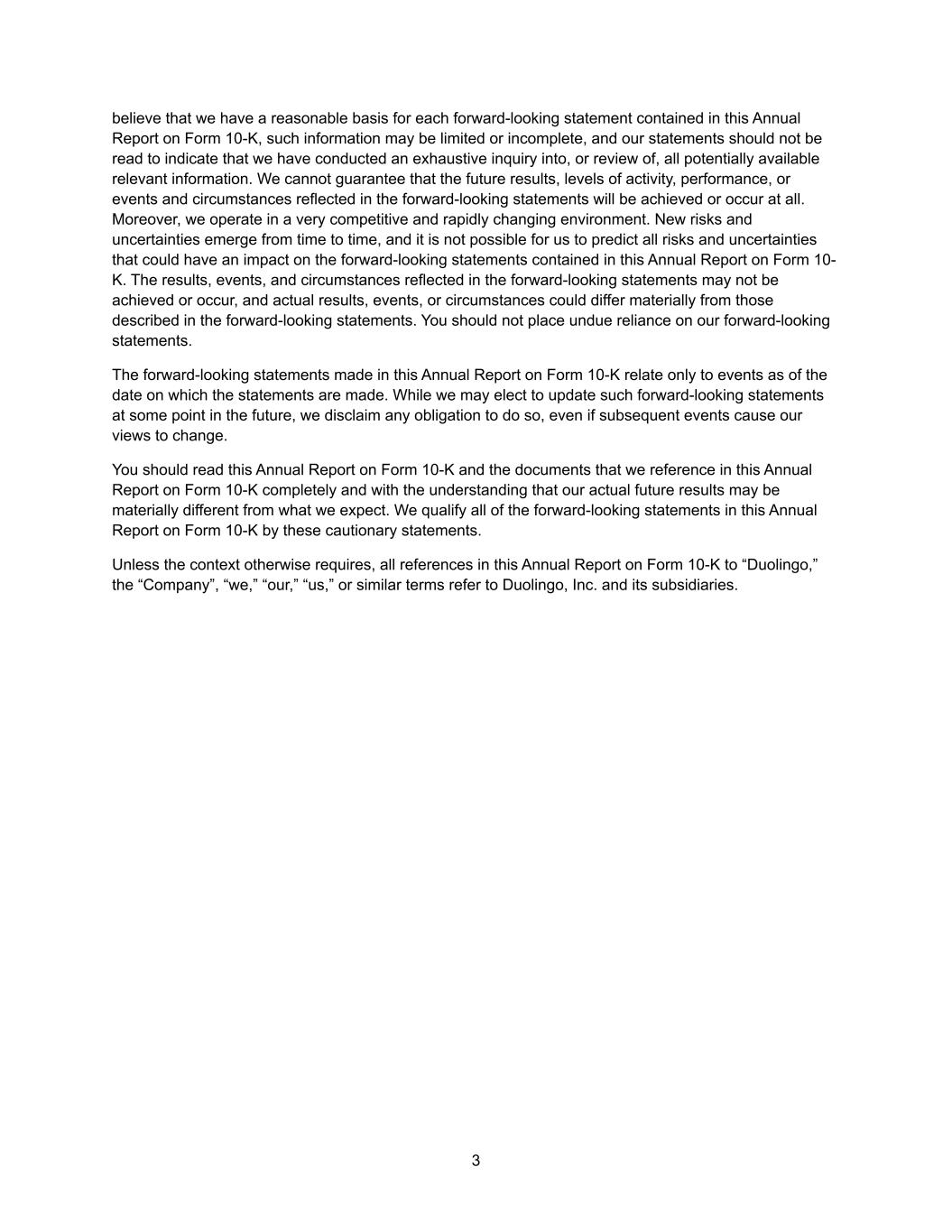
believe that we have a reasonable basis for each forward-looking statement contained in this Annual Report on Form 10-K, such information may be limited or incomplete, and our statements should not be read to indicate that we have conducted an exhaustive inquiry into, or review of, all potentially available relevant information. We cannot guarantee that the future results, levels of activity, performance, or events and circumstances reflected in the forward-looking statements will be achieved or occur at all. Moreover, we operate in a very competitive and rapidly changing environment. New risks and uncertainties emerge from time to time, and it is not possible for us to predict all risks and uncertainties that could have an impact on the forward-looking statements contained in this Annual Report on Form 10- K. The results, events, and circumstances reflected in the forward-looking statements may not be achieved or occur, and actual results, events, or circumstances could differ materially from those described in the forward-looking statements. You should not place undue reliance on our forward-looking statements. The forward-looking statements made in this Annual Report on Form 10-K relate only to events as of the date on which the statements are made. While we may elect to update such forward-looking statements at some point in the future, we disclaim any obligation to do so, even if subsequent events cause our views to change. You should read this Annual Report on Form 10-K and the documents that we reference in this Annual Report on Form 10-K completely and with the understanding that our actual future results may be materially different from what we expect. We qualify all of the forward-looking statements in this Annual Report on Form 10-K by these cautionary statements. Unless the context otherwise requires, all references in this Annual Report on Form 10-K to “Duolingo,” the “Company”, “we,” “our,” “us,” or similar terms refer to Duolingo, Inc. and its subsidiaries. 3
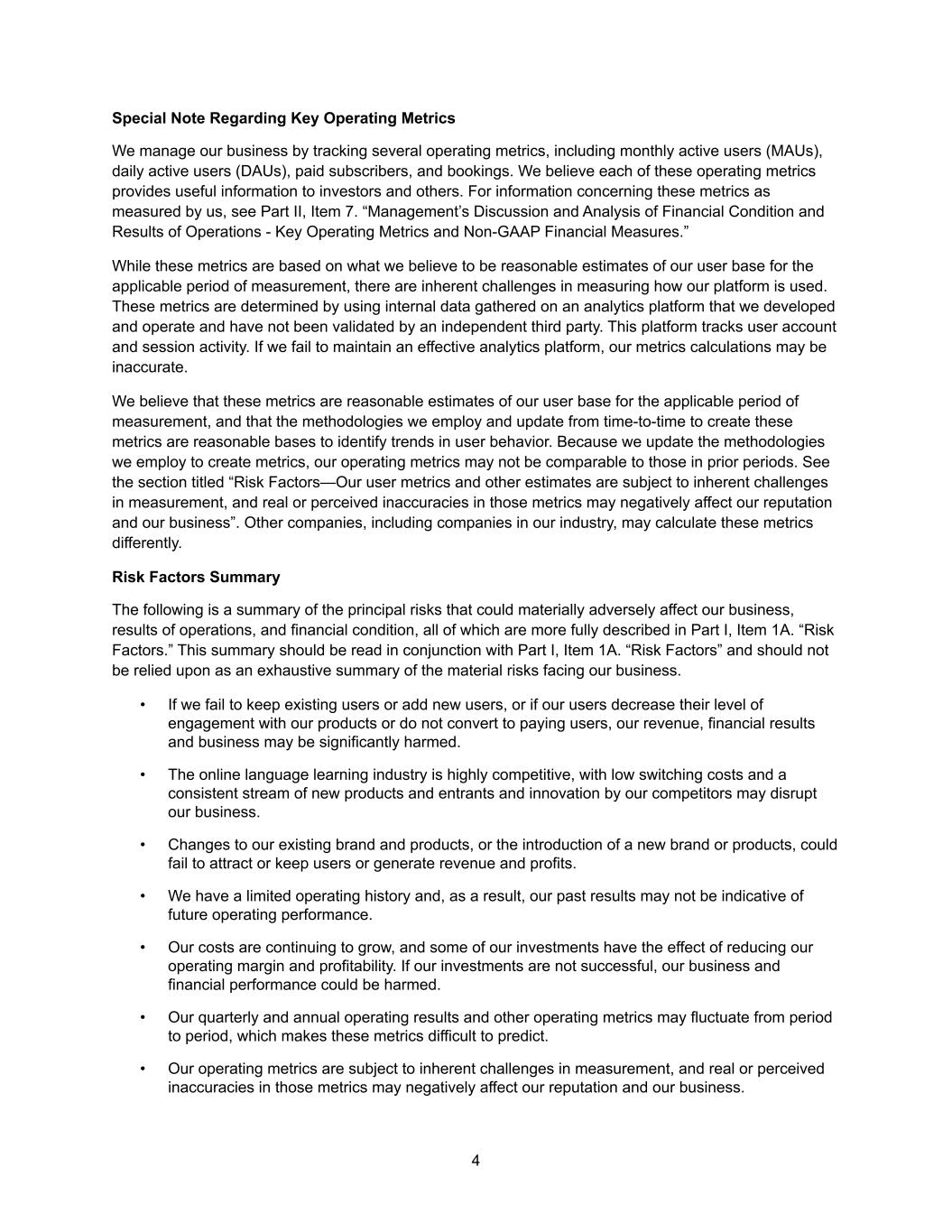
Special Note Regarding Key Operating Metrics We manage our business by tracking several operating metrics, including monthly active users (MAUs), daily active users (DAUs), paid subscribers, and bookings. We believe each of these operating metrics provides useful information to investors and others. For information concerning these metrics as measured by us, see Part II, Item 7. “Management’s Discussion and Analysis of Financial Condition and Results of Operations - Key Operating Metrics and Non-GAAP Financial Measures.” While these metrics are based on what we believe to be reasonable estimates of our user base for the applicable period of measurement, there are inherent challenges in measuring how our platform is used. These metrics are determined by using internal data gathered on an analytics platform that we developed and operate and have not been validated by an independent third party. This platform tracks user account and session activity. If we fail to maintain an effective analytics platform, our metrics calculations may be inaccurate. We believe that these metrics are reasonable estimates of our user base for the applicable period of measurement, and that the methodologies we employ and update from time-to-time to create these metrics are reasonable bases to identify trends in user behavior. Because we update the methodologies we employ to create metrics, our operating metrics may not be comparable to those in prior periods. See the section titled “Risk Factors—Our user metrics and other estimates are subject to inherent challenges in measurement, and real or perceived inaccuracies in those metrics may negatively affect our reputation and our business”. Other companies, including companies in our industry, may calculate these metrics differently. Risk Factors Summary The following is a summary of the principal risks that could materially adversely affect our business, results of operations, and financial condition, all of which are more fully described in Part I, Item 1A. “Risk Factors.” This summary should be read in conjunction with Part I, Item 1A. “Risk Factors” and should not be relied upon as an exhaustive summary of the material risks facing our business. • If we fail to keep existing users or add new users, or if our users decrease their level of engagement with our products or do not convert to paying users, our revenue, financial results and business may be significantly harmed. • The online language learning industry is highly competitive, with low switching costs and a consistent stream of new products and entrants and innovation by our competitors may disrupt our business. • Changes to our existing brand and products, or the introduction of a new brand or products, could fail to attract or keep users or generate revenue and profits. • We have a limited operating history and, as a result, our past results may not be indicative of future operating performance. • Our costs are continuing to grow, and some of our investments have the effect of reducing our operating margin and profitability. If our investments are not successful, our business and financial performance could be harmed. • Our quarterly and annual operating results and other operating metrics may fluctuate from period to period, which makes these metrics difficult to predict. • Our operating metrics are subject to inherent challenges in measurement, and real or perceived inaccuracies in those metrics may negatively affect our reputation and our business. 4
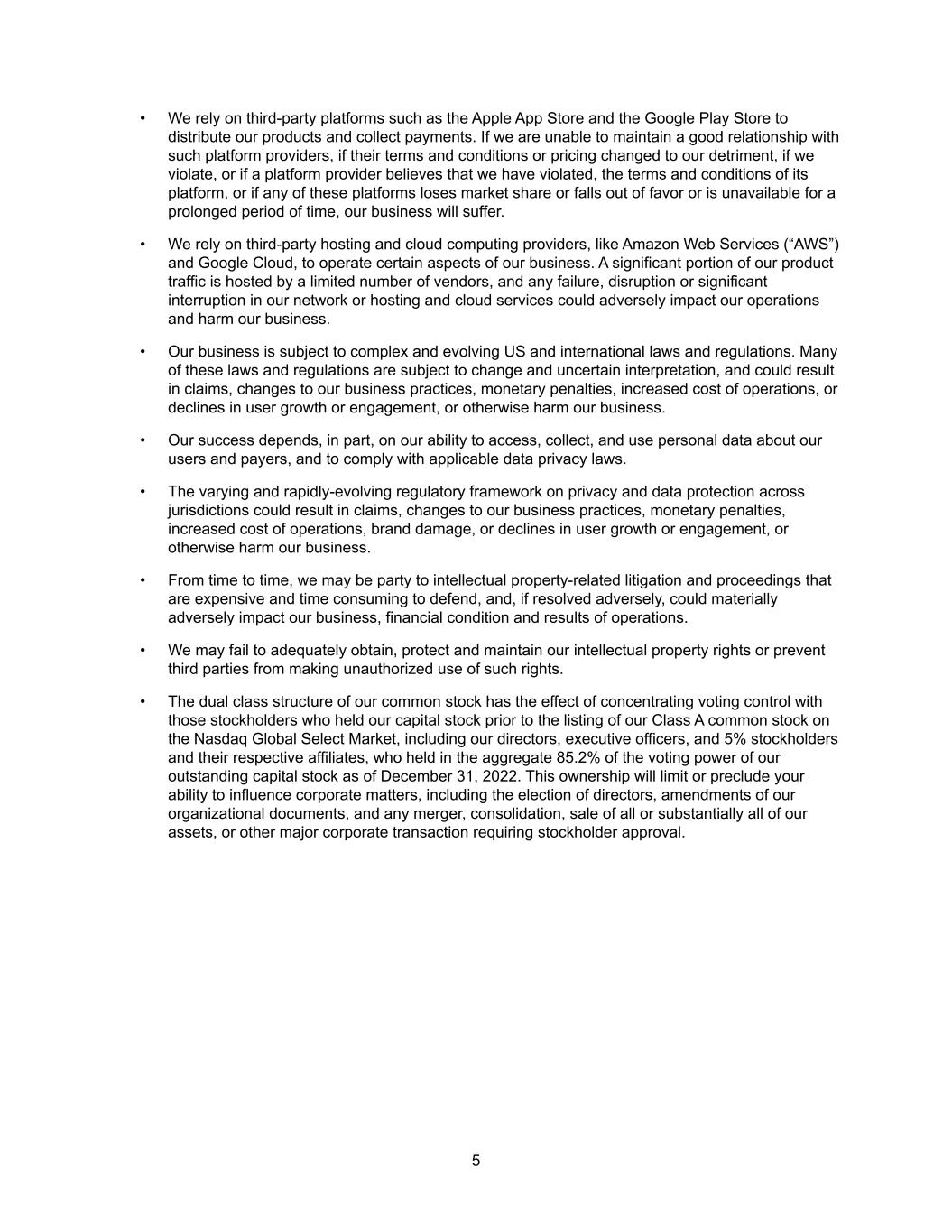
• We rely on third-party platforms such as the Apple App Store and the Google Play Store to distribute our products and collect payments. If we are unable to maintain a good relationship with such platform providers, if their terms and conditions or pricing changed to our detriment, if we violate, or if a platform provider believes that we have violated, the terms and conditions of its platform, or if any of these platforms loses market share or falls out of favor or is unavailable for a prolonged period of time, our business will suffer. • We rely on third-party hosting and cloud computing providers, like Amazon Web Services (“AWS”) and Google Cloud, to operate certain aspects of our business. A significant portion of our product traffic is hosted by a limited number of vendors, and any failure, disruption or significant interruption in our network or hosting and cloud services could adversely impact our operations and harm our business. • Our business is subject to complex and evolving US and international laws and regulations. Many of these laws and regulations are subject to change and uncertain interpretation, and could result in claims, changes to our business practices, monetary penalties, increased cost of operations, or declines in user growth or engagement, or otherwise harm our business. • Our success depends, in part, on our ability to access, collect, and use personal data about our users and payers, and to comply with applicable data privacy laws. • The varying and rapidly-evolving regulatory framework on privacy and data protection across jurisdictions could result in claims, changes to our business practices, monetary penalties, increased cost of operations, brand damage, or declines in user growth or engagement, or otherwise harm our business. • From time to time, we may be party to intellectual property-related litigation and proceedings that are expensive and time consuming to defend, and, if resolved adversely, could materially adversely impact our business, financial condition and results of operations. • We may fail to adequately obtain, protect and maintain our intellectual property rights or prevent third parties from making unauthorized use of such rights. • The dual class structure of our common stock has the effect of concentrating voting control with those stockholders who held our capital stock prior to the listing of our Class A common stock on the Nasdaq Global Select Market, including our directors, executive officers, and 5% stockholders and their respective affiliates, who held in the aggregate 85.2% of the voting power of our outstanding capital stock as of December 31, 2022. This ownership will limit or preclude your ability to influence corporate matters, including the election of directors, amendments of our organizational documents, and any merger, consolidation, sale of all or substantially all of our assets, or other major corporate transaction requiring stockholder approval. 5
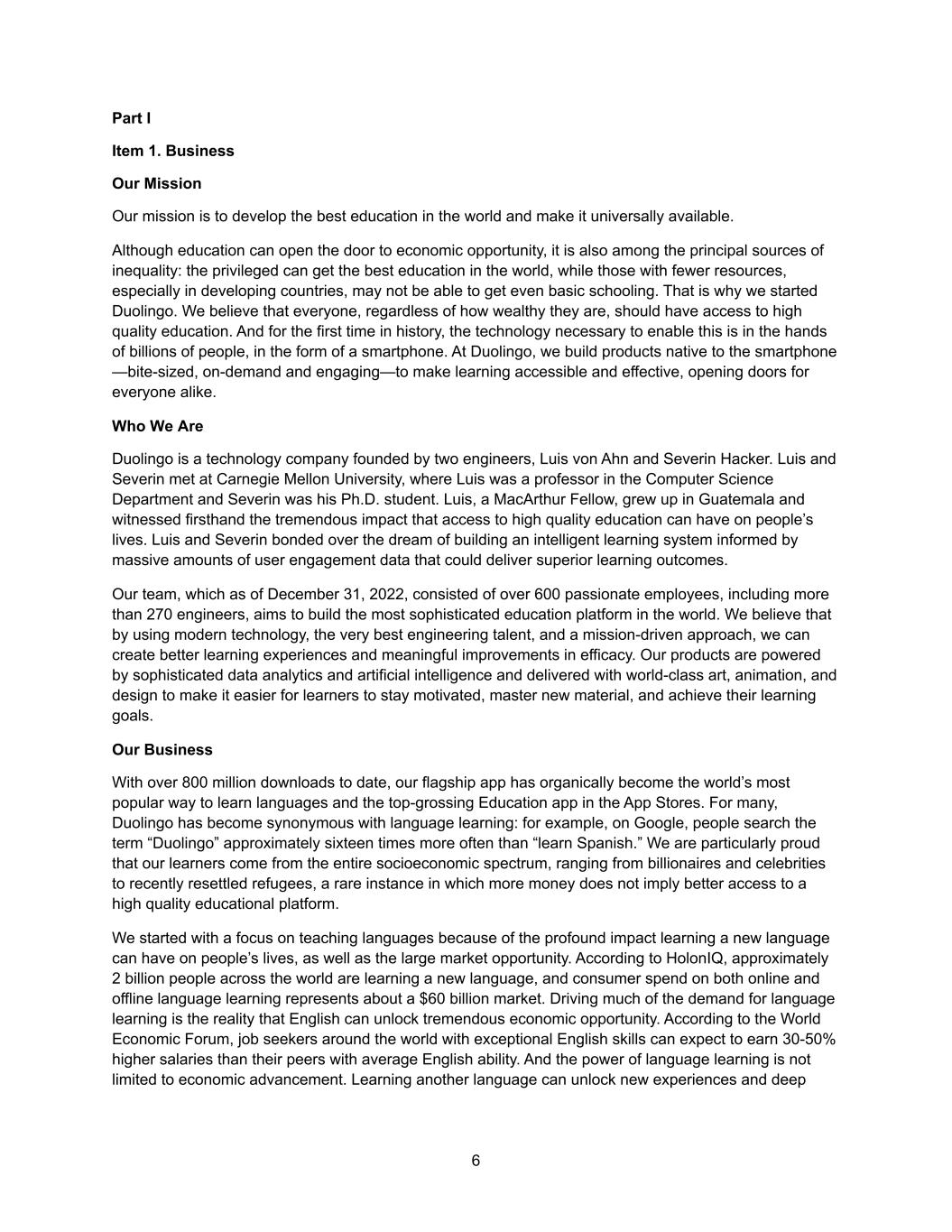
Part I Item 1. Business Our Mission Our mission is to develop the best education in the world and make it universally available. Although education can open the door to economic opportunity, it is also among the principal sources of inequality: the privileged can get the best education in the world, while those with fewer resources, especially in developing countries, may not be able to get even basic schooling. That is why we started Duolingo. We believe that everyone, regardless of how wealthy they are, should have access to high quality education. And for the first time in history, the technology necessary to enable this is in the hands of billions of people, in the form of a smartphone. At Duolingo, we build products native to the smartphone —bite-sized, on-demand and engaging—to make learning accessible and effective, opening doors for everyone alike. Who We Are Duolingo is a technology company founded by two engineers, Luis von Ahn and Severin Hacker. Luis and Severin met at Carnegie Mellon University, where Luis was a professor in the Computer Science Department and Severin was his Ph.D. student. Luis, a MacArthur Fellow, grew up in Guatemala and witnessed firsthand the tremendous impact that access to high quality education can have on people’s lives. Luis and Severin bonded over the dream of building an intelligent learning system informed by massive amounts of user engagement data that could deliver superior learning outcomes. Our team, which as of December 31, 2022, consisted of over 600 passionate employees, including more than 270 engineers, aims to build the most sophisticated education platform in the world. We believe that by using modern technology, the very best engineering talent, and a mission-driven approach, we can create better learning experiences and meaningful improvements in efficacy. Our products are powered by sophisticated data analytics and artificial intelligence and delivered with world-class art, animation, and design to make it easier for learners to stay motivated, master new material, and achieve their learning goals. Our Business With over 800 million downloads to date, our flagship app has organically become the world’s most popular way to learn languages and the top-grossing Education app in the App Stores. For many, Duolingo has become synonymous with language learning: for example, on Google, people search the term “Duolingo” approximately sixteen times more often than “learn Spanish.” We are particularly proud that our learners come from the entire socioeconomic spectrum, ranging from billionaires and celebrities to recently resettled refugees, a rare instance in which more money does not imply better access to a high quality educational platform. We started with a focus on teaching languages because of the profound impact learning a new language can have on people’s lives, as well as the large market opportunity. According to HolonIQ, approximately 2 billion people across the world are learning a new language, and consumer spend on both online and offline language learning represents about a $60 billion market. Driving much of the demand for language learning is the reality that English can unlock tremendous economic opportunity. According to the World Economic Forum, job seekers around the world with exceptional English skills can expect to earn 30-50% higher salaries than their peers with average English ability. And the power of language learning is not limited to economic advancement. Learning another language can unlock new experiences and deep 6
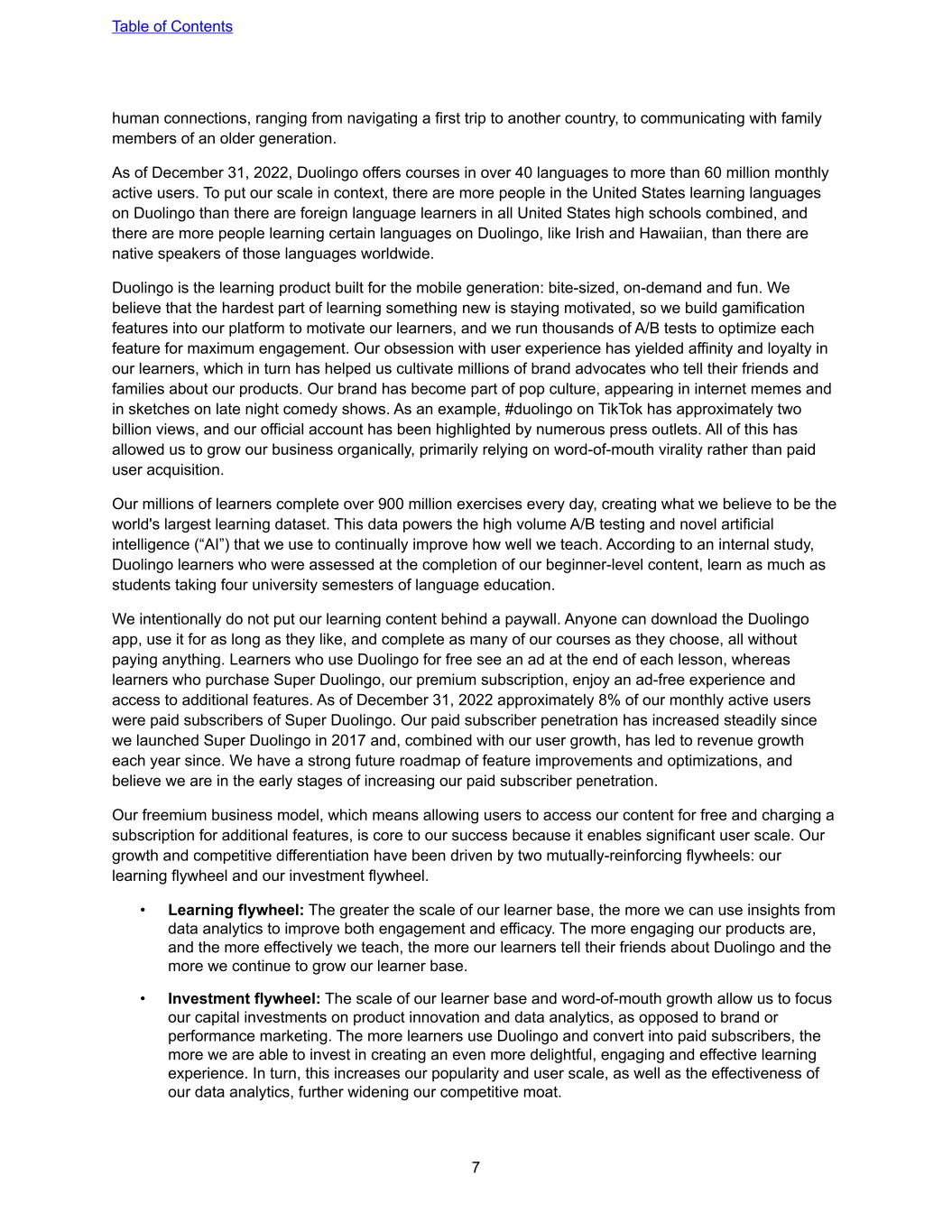
human connections, ranging from navigating a first trip to another country, to communicating with family members of an older generation. As of December 31, 2022, Duolingo offers courses in over 40 languages to more than 60 million monthly active users. To put our scale in context, there are more people in the United States learning languages on Duolingo than there are foreign language learners in all United States high schools combined, and there are more people learning certain languages on Duolingo, like Irish and Hawaiian, than there are native speakers of those languages worldwide. Duolingo is the learning product built for the mobile generation: bite-sized, on-demand and fun. We believe that the hardest part of learning something new is staying motivated, so we build gamification features into our platform to motivate our learners, and we run thousands of A/B tests to optimize each feature for maximum engagement. Our obsession with user experience has yielded affinity and loyalty in our learners, which in turn has helped us cultivate millions of brand advocates who tell their friends and families about our products. Our brand has become part of pop culture, appearing in internet memes and in sketches on late night comedy shows. As an example, #duolingo on TikTok has approximately two billion views, and our official account has been highlighted by numerous press outlets. All of this has allowed us to grow our business organically, primarily relying on word-of-mouth virality rather than paid user acquisition. Our millions of learners complete over 900 million exercises every day, creating what we believe to be the world's largest learning dataset. This data powers the high volume A/B testing and novel artificial intelligence (“AI”) that we use to continually improve how well we teach. According to an internal study, Duolingo learners who were assessed at the completion of our beginner-level content, learn as much as students taking four university semesters of language education. We intentionally do not put our learning content behind a paywall. Anyone can download the Duolingo app, use it for as long as they like, and complete as many of our courses as they choose, all without paying anything. Learners who use Duolingo for free see an ad at the end of each lesson, whereas learners who purchase Super Duolingo, our premium subscription, enjoy an ad-free experience and access to additional features. As of December 31, 2022 approximately 8% of our monthly active users were paid subscribers of Super Duolingo. Our paid subscriber penetration has increased steadily since we launched Super Duolingo in 2017 and, combined with our user growth, has led to revenue growth each year since. We have a strong future roadmap of feature improvements and optimizations, and believe we are in the early stages of increasing our paid subscriber penetration. Our freemium business model, which means allowing users to access our content for free and charging a subscription for additional features, is core to our success because it enables significant user scale. Our growth and competitive differentiation have been driven by two mutually-reinforcing flywheels: our learning flywheel and our investment flywheel. • Learning flywheel: The greater the scale of our learner base, the more we can use insights from data analytics to improve both engagement and efficacy. The more engaging our products are, and the more effectively we teach, the more our learners tell their friends about Duolingo and the more we continue to grow our learner base. • Investment flywheel: The scale of our learner base and word-of-mouth growth allow us to focus our capital investments on product innovation and data analytics, as opposed to brand or performance marketing. The more learners use Duolingo and convert into paid subscribers, the more we are able to invest in creating an even more delightful, engaging and effective learning experience. In turn, this increases our popularity and user scale, as well as the effectiveness of our data analytics, further widening our competitive moat. Table of Contents 7
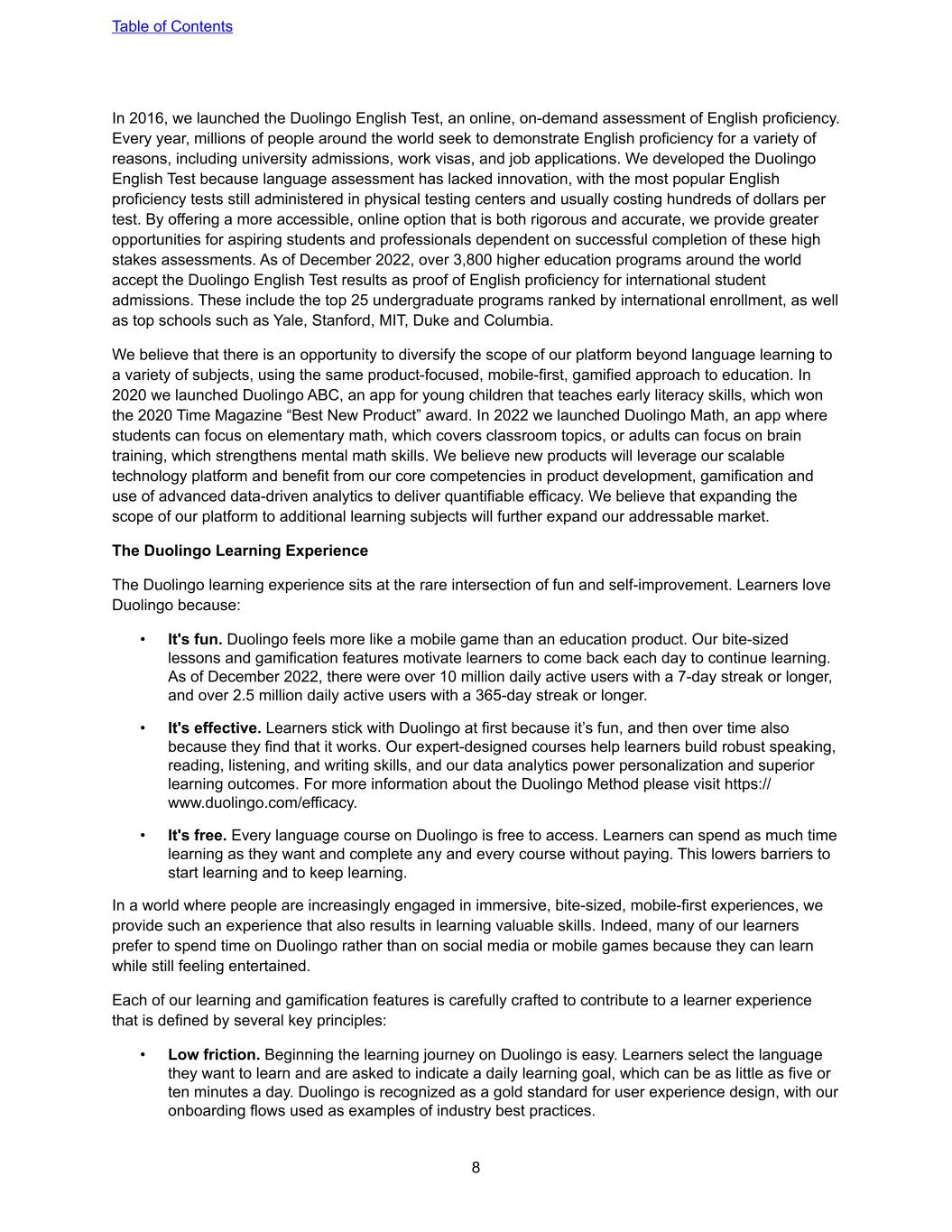
In 2016, we launched the Duolingo English Test, an online, on-demand assessment of English proficiency. Every year, millions of people around the world seek to demonstrate English proficiency for a variety of reasons, including university admissions, work visas, and job applications. We developed the Duolingo English Test because language assessment has lacked innovation, with the most popular English proficiency tests still administered in physical testing centers and usually costing hundreds of dollars per test. By offering a more accessible, online option that is both rigorous and accurate, we provide greater opportunities for aspiring students and professionals dependent on successful completion of these high stakes assessments. As of December 2022, over 3,800 higher education programs around the world accept the Duolingo English Test results as proof of English proficiency for international student admissions. These include the top 25 undergraduate programs ranked by international enrollment, as well as top schools such as Yale, Stanford, MIT, Duke and Columbia. We believe that there is an opportunity to diversify the scope of our platform beyond language learning to a variety of subjects, using the same product-focused, mobile-first, gamified approach to education. In 2020 we launched Duolingo ABC, an app for young children that teaches early literacy skills, which won the 2020 Time Magazine “Best New Product” award. In 2022 we launched Duolingo Math, an app where students can focus on elementary math, which covers classroom topics, or adults can focus on brain training, which strengthens mental math skills. We believe new products will leverage our scalable technology platform and benefit from our core competencies in product development, gamification and use of advanced data-driven analytics to deliver quantifiable efficacy. We believe that expanding the scope of our platform to additional learning subjects will further expand our addressable market. The Duolingo Learning Experience The Duolingo learning experience sits at the rare intersection of fun and self-improvement. Learners love Duolingo because: • It's fun. Duolingo feels more like a mobile game than an education product. Our bite-sized lessons and gamification features motivate learners to come back each day to continue learning. As of December 2022, there were over 10 million daily active users with a 7-day streak or longer, and over 2.5 million daily active users with a 365-day streak or longer. • It's effective. Learners stick with Duolingo at first because it’s fun, and then over time also because they find that it works. Our expert-designed courses help learners build robust speaking, reading, listening, and writing skills, and our data analytics power personalization and superior learning outcomes. For more information about the Duolingo Method please visit https:// www.duolingo.com/efficacy. • It's free. Every language course on Duolingo is free to access. Learners can spend as much time learning as they want and complete any and every course without paying. This lowers barriers to start learning and to keep learning. In a world where people are increasingly engaged in immersive, bite-sized, mobile-first experiences, we provide such an experience that also results in learning valuable skills. Indeed, many of our learners prefer to spend time on Duolingo rather than on social media or mobile games because they can learn while still feeling entertained. Each of our learning and gamification features is carefully crafted to contribute to a learner experience that is defined by several key principles: • Low friction. Beginning the learning journey on Duolingo is easy. Learners select the language they want to learn and are asked to indicate a daily learning goal, which can be as little as five or ten minutes a day. Duolingo is recognized as a gold standard for user experience design, with our onboarding flows used as examples of industry best practices. Table of Contents 8
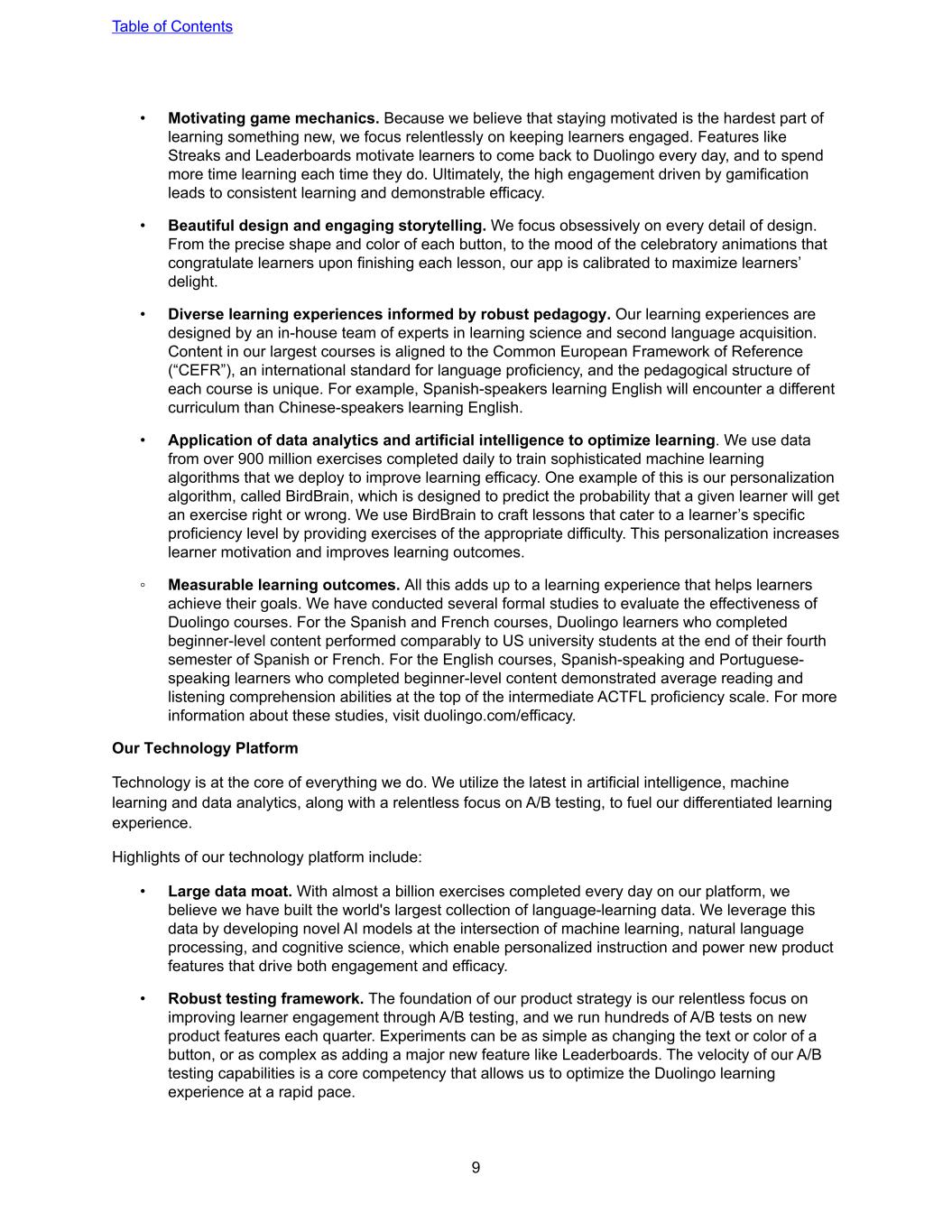
• Motivating game mechanics. Because we believe that staying motivated is the hardest part of learning something new, we focus relentlessly on keeping learners engaged. Features like Streaks and Leaderboards motivate learners to come back to Duolingo every day, and to spend more time learning each time they do. Ultimately, the high engagement driven by gamification leads to consistent learning and demonstrable efficacy. • Beautiful design and engaging storytelling. We focus obsessively on every detail of design. From the precise shape and color of each button, to the mood of the celebratory animations that congratulate learners upon finishing each lesson, our app is calibrated to maximize learners’ delight. • Diverse learning experiences informed by robust pedagogy. Our learning experiences are designed by an in-house team of experts in learning science and second language acquisition. Content in our largest courses is aligned to the Common European Framework of Reference (“CEFR”), an international standard for language proficiency, and the pedagogical structure of each course is unique. For example, Spanish-speakers learning English will encounter a different curriculum than Chinese-speakers learning English. • Application of data analytics and artificial intelligence to optimize learning. We use data from over 900 million exercises completed daily to train sophisticated machine learning algorithms that we deploy to improve learning efficacy. One example of this is our personalization algorithm, called BirdBrain, which is designed to predict the probability that a given learner will get an exercise right or wrong. We use BirdBrain to craft lessons that cater to a learner’s specific proficiency level by providing exercises of the appropriate difficulty. This personalization increases learner motivation and improves learning outcomes. ◦ Measurable learning outcomes. All this adds up to a learning experience that helps learners achieve their goals. We have conducted several formal studies to evaluate the effectiveness of Duolingo courses. For the Spanish and French courses, Duolingo learners who completed beginner-level content performed comparably to US university students at the end of their fourth semester of Spanish or French. For the English courses, Spanish-speaking and Portuguese- speaking learners who completed beginner-level content demonstrated average reading and listening comprehension abilities at the top of the intermediate ACTFL proficiency scale. For more information about these studies, visit duolingo.com/efficacy. Our Technology Platform Technology is at the core of everything we do. We utilize the latest in artificial intelligence, machine learning and data analytics, along with a relentless focus on A/B testing, to fuel our differentiated learning experience. Highlights of our technology platform include: • Large data moat. With almost a billion exercises completed every day on our platform, we believe we have built the world's largest collection of language-learning data. We leverage this data by developing novel AI models at the intersection of machine learning, natural language processing, and cognitive science, which enable personalized instruction and power new product features that drive both engagement and efficacy. • Robust testing framework. The foundation of our product strategy is our relentless focus on improving learner engagement through A/B testing, and we run hundreds of A/B tests on new product features each quarter. Experiments can be as simple as changing the text or color of a button, or as complex as adding a major new feature like Leaderboards. The velocity of our A/B testing capabilities is a core competency that allows us to optimize the Duolingo learning experience at a rapid pace. Table of Contents 9
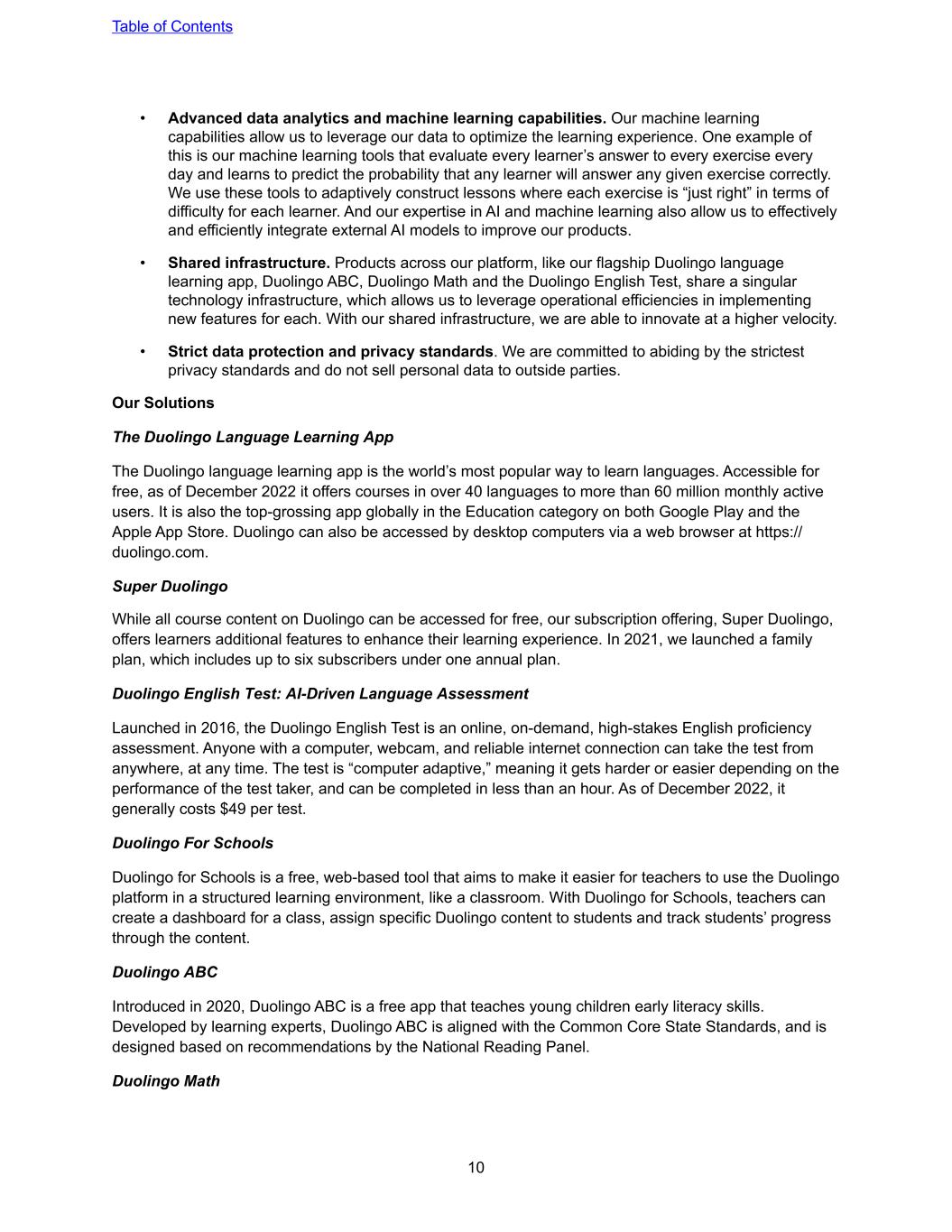
• Advanced data analytics and machine learning capabilities. Our machine learning capabilities allow us to leverage our data to optimize the learning experience. One example of this is our machine learning tools that evaluate every learner’s answer to every exercise every day and learns to predict the probability that any learner will answer any given exercise correctly. We use these tools to adaptively construct lessons where each exercise is “just right” in terms of difficulty for each learner. And our expertise in AI and machine learning also allow us to effectively and efficiently integrate external AI models to improve our products. • Shared infrastructure. Products across our platform, like our flagship Duolingo language learning app, Duolingo ABC, Duolingo Math and the Duolingo English Test, share a singular technology infrastructure, which allows us to leverage operational efficiencies in implementing new features for each. With our shared infrastructure, we are able to innovate at a higher velocity. • Strict data protection and privacy standards. We are committed to abiding by the strictest privacy standards and do not sell personal data to outside parties. Our Solutions The Duolingo Language Learning App The Duolingo language learning app is the world’s most popular way to learn languages. Accessible for free, as of December 2022 it offers courses in over 40 languages to more than 60 million monthly active users. It is also the top-grossing app globally in the Education category on both Google Play and the Apple App Store. Duolingo can also be accessed by desktop computers via a web browser at https:// duolingo.com. Super Duolingo While all course content on Duolingo can be accessed for free, our subscription offering, Super Duolingo, offers learners additional features to enhance their learning experience. In 2021, we launched a family plan, which includes up to six subscribers under one annual plan. Duolingo English Test: AI-Driven Language Assessment Launched in 2016, the Duolingo English Test is an online, on-demand, high-stakes English proficiency assessment. Anyone with a computer, webcam, and reliable internet connection can take the test from anywhere, at any time. The test is “computer adaptive,” meaning it gets harder or easier depending on the performance of the test taker, and can be completed in less than an hour. As of December 2022, it generally costs $49 per test. Duolingo For Schools Duolingo for Schools is a free, web-based tool that aims to make it easier for teachers to use the Duolingo platform in a structured learning environment, like a classroom. With Duolingo for Schools, teachers can create a dashboard for a class, assign specific Duolingo content to students and track students’ progress through the content. Duolingo ABC Introduced in 2020, Duolingo ABC is a free app that teaches young children early literacy skills. Developed by learning experts, Duolingo ABC is aligned with the Common Core State Standards, and is designed based on recommendations by the National Reading Panel. Duolingo Math Table of Contents 10
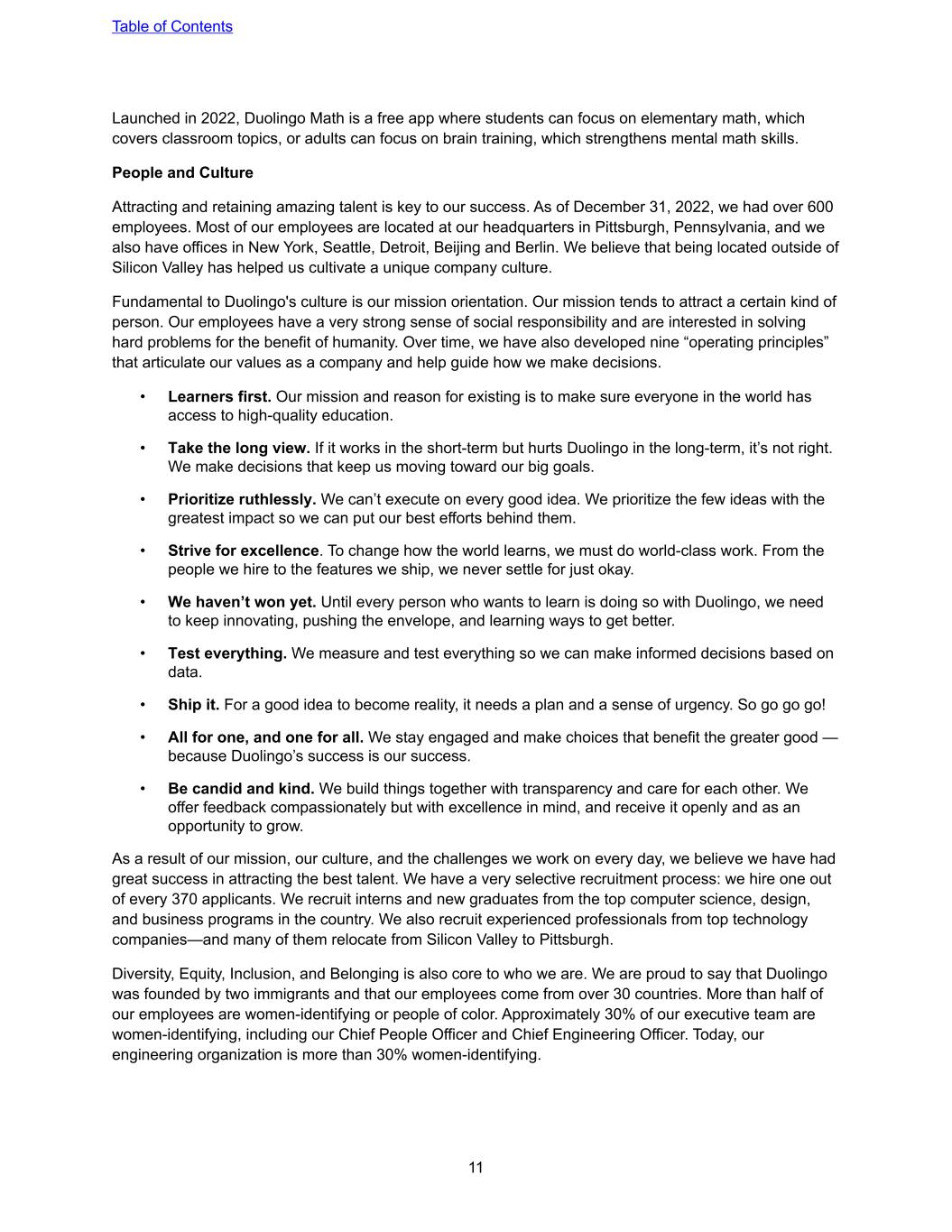
Launched in 2022, Duolingo Math is a free app where students can focus on elementary math, which covers classroom topics, or adults can focus on brain training, which strengthens mental math skills. People and Culture Attracting and retaining amazing talent is key to our success. As of December 31, 2022, we had over 600 employees. Most of our employees are located at our headquarters in Pittsburgh, Pennsylvania, and we also have offices in New York, Seattle, Detroit, Beijing and Berlin. We believe that being located outside of Silicon Valley has helped us cultivate a unique company culture. Fundamental to Duolingo's culture is our mission orientation. Our mission tends to attract a certain kind of person. Our employees have a very strong sense of social responsibility and are interested in solving hard problems for the benefit of humanity. Over time, we have also developed nine “operating principles” that articulate our values as a company and help guide how we make decisions. • Learners first. Our mission and reason for existing is to make sure everyone in the world has access to high-quality education. • Take the long view. If it works in the short-term but hurts Duolingo in the long-term, it’s not right. We make decisions that keep us moving toward our big goals. • Prioritize ruthlessly. We can’t execute on every good idea. We prioritize the few ideas with the greatest impact so we can put our best efforts behind them. • Strive for excellence. To change how the world learns, we must do world-class work. From the people we hire to the features we ship, we never settle for just okay. • We haven’t won yet. Until every person who wants to learn is doing so with Duolingo, we need to keep innovating, pushing the envelope, and learning ways to get better. • Test everything. We measure and test everything so we can make informed decisions based on data. • Ship it. For a good idea to become reality, it needs a plan and a sense of urgency. So go go go! • All for one, and one for all. We stay engaged and make choices that benefit the greater good — because Duolingo’s success is our success. • Be candid and kind. We build things together with transparency and care for each other. We offer feedback compassionately but with excellence in mind, and receive it openly and as an opportunity to grow. As a result of our mission, our culture, and the challenges we work on every day, we believe we have had great success in attracting the best talent. We have a very selective recruitment process: we hire one out of every 370 applicants. We recruit interns and new graduates from the top computer science, design, and business programs in the country. We also recruit experienced professionals from top technology companies—and many of them relocate from Silicon Valley to Pittsburgh. Diversity, Equity, Inclusion, and Belonging is also core to who we are. We are proud to say that Duolingo was founded by two immigrants and that our employees come from over 30 countries. More than half of our employees are women-identifying or people of color. Approximately 30% of our executive team are women-identifying, including our Chief People Officer and Chief Engineering Officer. Today, our engineering organization is more than 30% women-identifying. Table of Contents 11
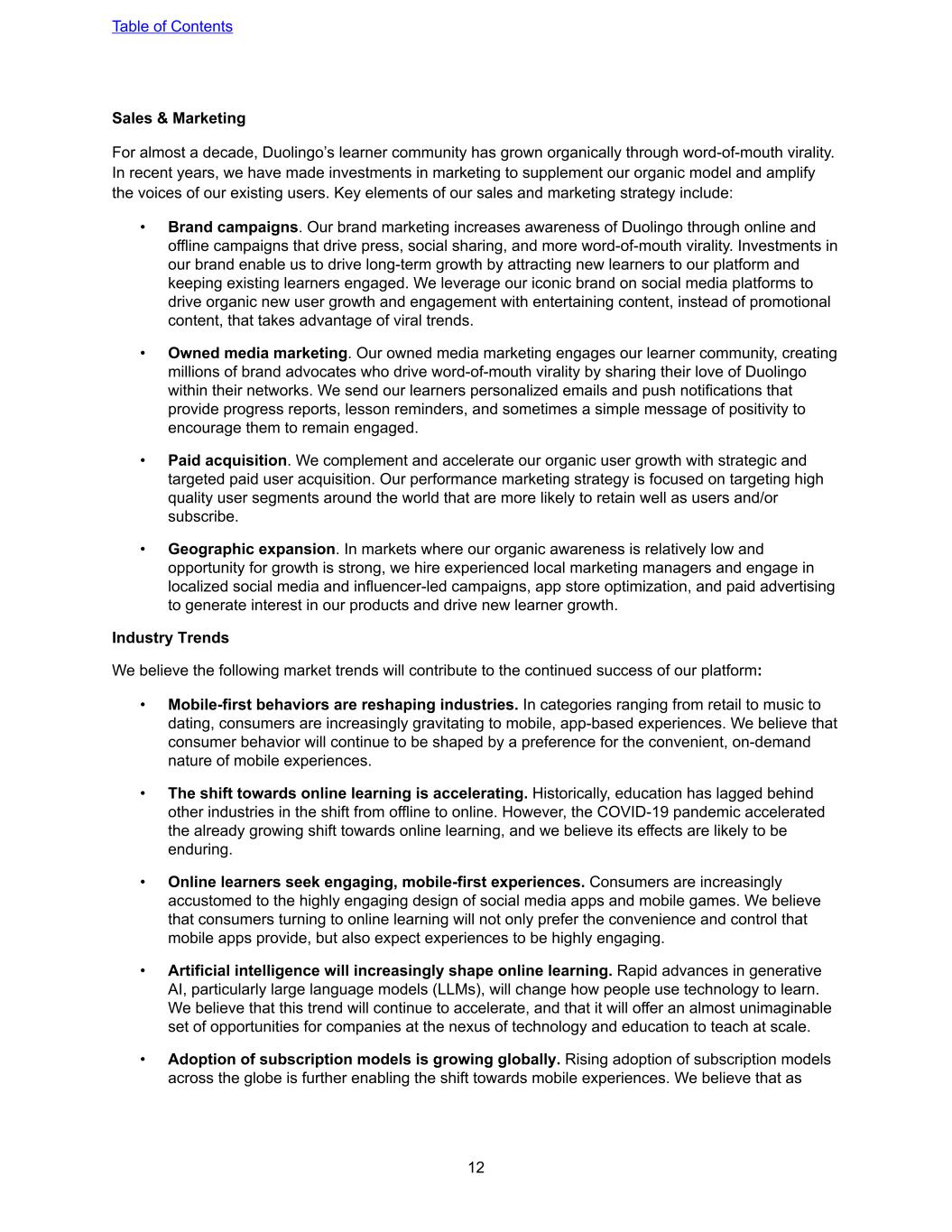
Sales & Marketing For almost a decade, Duolingo’s learner community has grown organically through word-of-mouth virality. In recent years, we have made investments in marketing to supplement our organic model and amplify the voices of our existing users. Key elements of our sales and marketing strategy include: • Brand campaigns. Our brand marketing increases awareness of Duolingo through online and offline campaigns that drive press, social sharing, and more word-of-mouth virality. Investments in our brand enable us to drive long-term growth by attracting new learners to our platform and keeping existing learners engaged. We leverage our iconic brand on social media platforms to drive organic new user growth and engagement with entertaining content, instead of promotional content, that takes advantage of viral trends. • Owned media marketing. Our owned media marketing engages our learner community, creating millions of brand advocates who drive word-of-mouth virality by sharing their love of Duolingo within their networks. We send our learners personalized emails and push notifications that provide progress reports, lesson reminders, and sometimes a simple message of positivity to encourage them to remain engaged. • Paid acquisition. We complement and accelerate our organic user growth with strategic and targeted paid user acquisition. Our performance marketing strategy is focused on targeting high quality user segments around the world that are more likely to retain well as users and/or subscribe. • Geographic expansion. In markets where our organic awareness is relatively low and opportunity for growth is strong, we hire experienced local marketing managers and engage in localized social media and influencer-led campaigns, app store optimization, and paid advertising to generate interest in our products and drive new learner growth. Industry Trends We believe the following market trends will contribute to the continued success of our platform: • Mobile-first behaviors are reshaping industries. In categories ranging from retail to music to dating, consumers are increasingly gravitating to mobile, app-based experiences. We believe that consumer behavior will continue to be shaped by a preference for the convenient, on-demand nature of mobile experiences. • The shift towards online learning is accelerating. Historically, education has lagged behind other industries in the shift from offline to online. However, the COVID-19 pandemic accelerated the already growing shift towards online learning, and we believe its effects are likely to be enduring. • Online learners seek engaging, mobile-first experiences. Consumers are increasingly accustomed to the highly engaging design of social media apps and mobile games. We believe that consumers turning to online learning will not only prefer the convenience and control that mobile apps provide, but also expect experiences to be highly engaging. • Artificial intelligence will increasingly shape online learning. Rapid advances in generative AI, particularly large language models (LLMs), will change how people use technology to learn. We believe that this trend will continue to accelerate, and that it will offer an almost unimaginable set of opportunities for companies at the nexus of technology and education to teach at scale. • Adoption of subscription models is growing globally. Rising adoption of subscription models across the globe is further enabling the shift towards mobile experiences. We believe that as Table of Contents 12
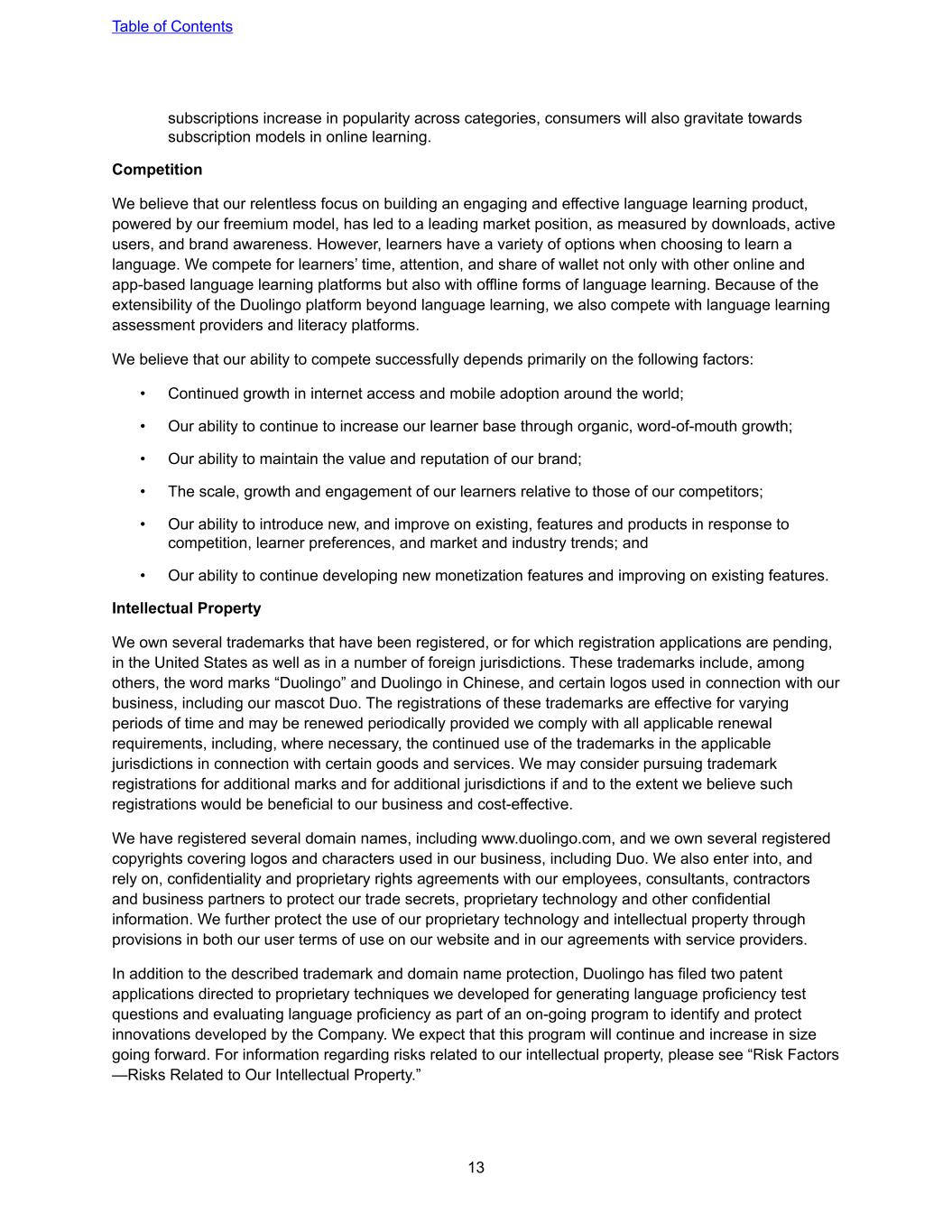
subscriptions increase in popularity across categories, consumers will also gravitate towards subscription models in online learning. Competition We believe that our relentless focus on building an engaging and effective language learning product, powered by our freemium model, has led to a leading market position, as measured by downloads, active users, and brand awareness. However, learners have a variety of options when choosing to learn a language. We compete for learners’ time, attention, and share of wallet not only with other online and app-based language learning platforms but also with offline forms of language learning. Because of the extensibility of the Duolingo platform beyond language learning, we also compete with language learning assessment providers and literacy platforms. We believe that our ability to compete successfully depends primarily on the following factors: • Continued growth in internet access and mobile adoption around the world; • Our ability to continue to increase our learner base through organic, word-of-mouth growth; • Our ability to maintain the value and reputation of our brand; • The scale, growth and engagement of our learners relative to those of our competitors; • Our ability to introduce new, and improve on existing, features and products in response to competition, learner preferences, and market and industry trends; and • Our ability to continue developing new monetization features and improving on existing features. Intellectual Property We own several trademarks that have been registered, or for which registration applications are pending, in the United States as well as in a number of foreign jurisdictions. These trademarks include, among others, the word marks “Duolingo” and Duolingo in Chinese, and certain logos used in connection with our business, including our mascot Duo. The registrations of these trademarks are effective for varying periods of time and may be renewed periodically provided we comply with all applicable renewal requirements, including, where necessary, the continued use of the trademarks in the applicable jurisdictions in connection with certain goods and services. We may consider pursuing trademark registrations for additional marks and for additional jurisdictions if and to the extent we believe such registrations would be beneficial to our business and cost-effective. We have registered several domain names, including www.duolingo.com, and we own several registered copyrights covering logos and characters used in our business, including Duo. We also enter into, and rely on, confidentiality and proprietary rights agreements with our employees, consultants, contractors and business partners to protect our trade secrets, proprietary technology and other confidential information. We further protect the use of our proprietary technology and intellectual property through provisions in both our user terms of use on our website and in our agreements with service providers. In addition to the described trademark and domain name protection, Duolingo has filed two patent applications directed to proprietary techniques we developed for generating language proficiency test questions and evaluating language proficiency as part of an on-going program to identify and protect innovations developed by the Company. We expect that this program will continue and increase in size going forward. For information regarding risks related to our intellectual property, please see “Risk Factors —Risks Related to Our Intellectual Property.” Table of Contents 13
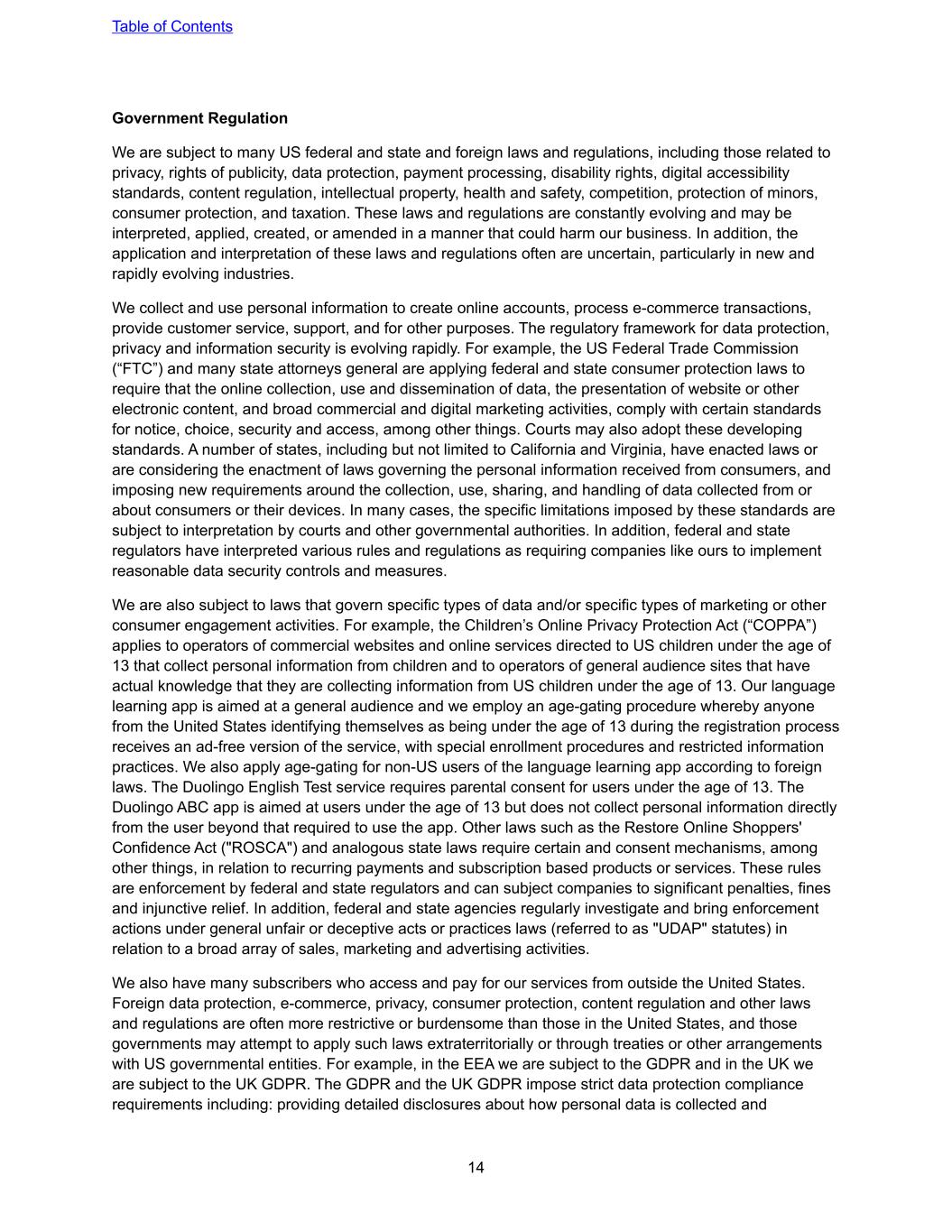
Government Regulation We are subject to many US federal and state and foreign laws and regulations, including those related to privacy, rights of publicity, data protection, payment processing, disability rights, digital accessibility standards, content regulation, intellectual property, health and safety, competition, protection of minors, consumer protection, and taxation. These laws and regulations are constantly evolving and may be interpreted, applied, created, or amended in a manner that could harm our business. In addition, the application and interpretation of these laws and regulations often are uncertain, particularly in new and rapidly evolving industries. We collect and use personal information to create online accounts, process e-commerce transactions, provide customer service, support, and for other purposes. The regulatory framework for data protection, privacy and information security is evolving rapidly. For example, the US Federal Trade Commission (“FTC”) and many state attorneys general are applying federal and state consumer protection laws to require that the online collection, use and dissemination of data, the presentation of website or other electronic content, and broad commercial and digital marketing activities, comply with certain standards for notice, choice, security and access, among other things. Courts may also adopt these developing standards. A number of states, including but not limited to California and Virginia, have enacted laws or are considering the enactment of laws governing the personal information received from consumers, and imposing new requirements around the collection, use, sharing, and handling of data collected from or about consumers or their devices. In many cases, the specific limitations imposed by these standards are subject to interpretation by courts and other governmental authorities. In addition, federal and state regulators have interpreted various rules and regulations as requiring companies like ours to implement reasonable data security controls and measures. We are also subject to laws that govern specific types of data and/or specific types of marketing or other consumer engagement activities. For example, the Children’s Online Privacy Protection Act (“COPPA”) applies to operators of commercial websites and online services directed to US children under the age of 13 that collect personal information from children and to operators of general audience sites that have actual knowledge that they are collecting information from US children under the age of 13. Our language learning app is aimed at a general audience and we employ an age-gating procedure whereby anyone from the United States identifying themselves as being under the age of 13 during the registration process receives an ad-free version of the service, with special enrollment procedures and restricted information practices. We also apply age-gating for non-US users of the language learning app according to foreign laws. The Duolingo English Test service requires parental consent for users under the age of 13. The Duolingo ABC app is aimed at users under the age of 13 but does not collect personal information directly from the user beyond that required to use the app. Other laws such as the Restore Online Shoppers' Confidence Act ("ROSCA") and analogous state laws require certain and consent mechanisms, among other things, in relation to recurring payments and subscription based products or services. These rules are enforcement by federal and state regulators and can subject companies to significant penalties, fines and injunctive relief. In addition, federal and state agencies regularly investigate and bring enforcement actions under general unfair or deceptive acts or practices laws (referred to as "UDAP" statutes) in relation to a broad array of sales, marketing and advertising activities. We also have many subscribers who access and pay for our services from outside the United States. Foreign data protection, e-commerce, privacy, consumer protection, content regulation and other laws and regulations are often more restrictive or burdensome than those in the United States, and those governments may attempt to apply such laws extraterritorially or through treaties or other arrangements with US governmental entities. For example, in the EEA we are subject to the GDPR and in the UK we are subject to the UK GDPR. The GDPR and the UK GDPR impose strict data protection compliance requirements including: providing detailed disclosures about how personal data is collected and Table of Contents 14
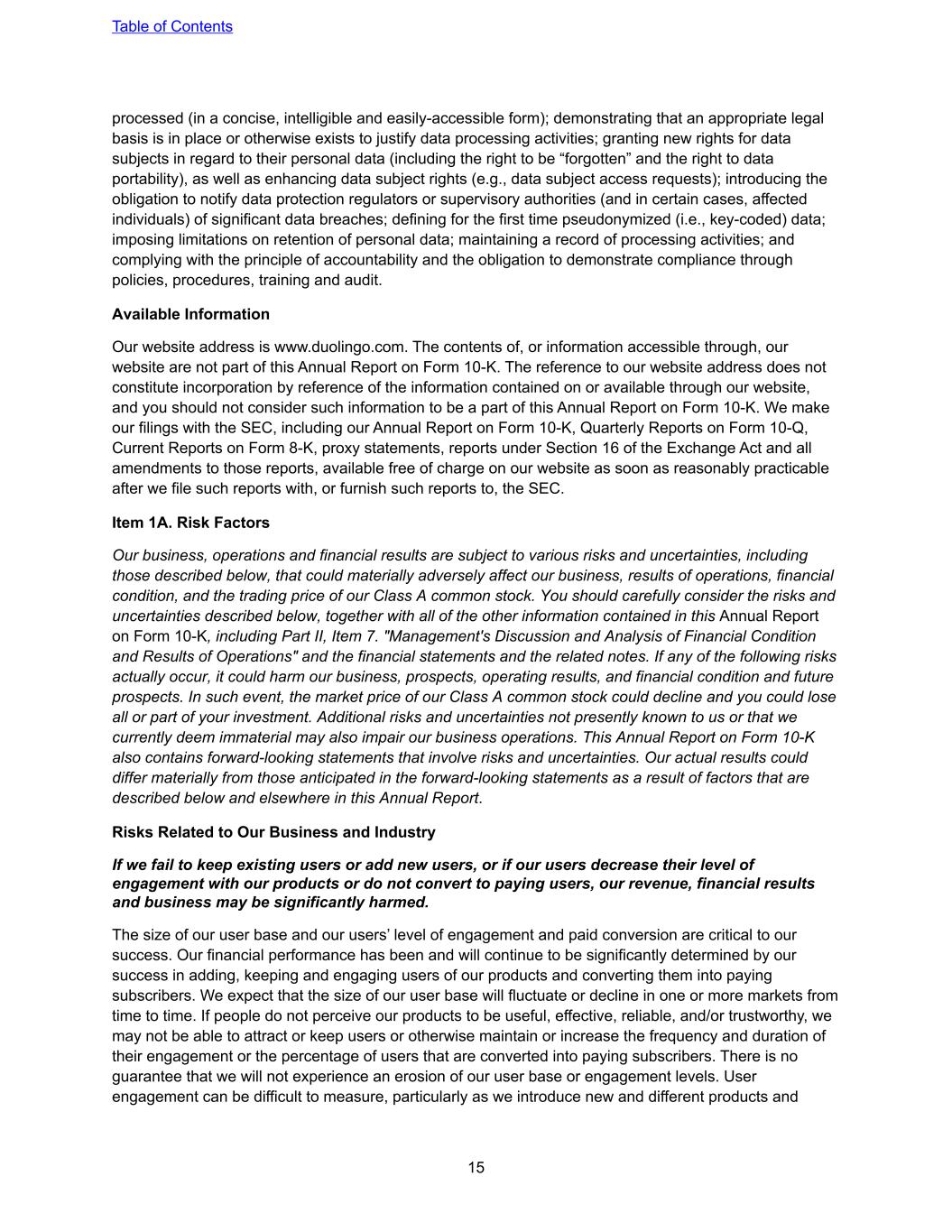
processed (in a concise, intelligible and easily-accessible form); demonstrating that an appropriate legal basis is in place or otherwise exists to justify data processing activities; granting new rights for data subjects in regard to their personal data (including the right to be “forgotten” and the right to data portability), as well as enhancing data subject rights (e.g., data subject access requests); introducing the obligation to notify data protection regulators or supervisory authorities (and in certain cases, affected individuals) of significant data breaches; defining for the first time pseudonymized (i.e., key-coded) data; imposing limitations on retention of personal data; maintaining a record of processing activities; and complying with the principle of accountability and the obligation to demonstrate compliance through policies, procedures, training and audit. Available Information Our website address is www.duolingo.com. The contents of, or information accessible through, our website are not part of this Annual Report on Form 10-K. The reference to our website address does not constitute incorporation by reference of the information contained on or available through our website, and you should not consider such information to be a part of this Annual Report on Form 10-K. We make our filings with the SEC, including our Annual Report on Form 10-K, Quarterly Reports on Form 10-Q, Current Reports on Form 8-K, proxy statements, reports under Section 16 of the Exchange Act and all amendments to those reports, available free of charge on our website as soon as reasonably practicable after we file such reports with, or furnish such reports to, the SEC. Item 1A. Risk Factors Our business, operations and financial results are subject to various risks and uncertainties, including those described below, that could materially adversely affect our business, results of operations, financial condition, and the trading price of our Class A common stock. You should carefully consider the risks and uncertainties described below, together with all of the other information contained in this Annual Report on Form 10-K, including Part II, Item 7. "Management's Discussion and Analysis of Financial Condition and Results of Operations" and the financial statements and the related notes. If any of the following risks actually occur, it could harm our business, prospects, operating results, and financial condition and future prospects. In such event, the market price of our Class A common stock could decline and you could lose all or part of your investment. Additional risks and uncertainties not presently known to us or that we currently deem immaterial may also impair our business operations. This Annual Report on Form 10-K also contains forward-looking statements that involve risks and uncertainties. Our actual results could differ materially from those anticipated in the forward-looking statements as a result of factors that are described below and elsewhere in this Annual Report. Risks Related to Our Business and Industry If we fail to keep existing users or add new users, or if our users decrease their level of engagement with our products or do not convert to paying users, our revenue, financial results and business may be significantly harmed. The size of our user base and our users’ level of engagement and paid conversion are critical to our success. Our financial performance has been and will continue to be significantly determined by our success in adding, keeping and engaging users of our products and converting them into paying subscribers. We expect that the size of our user base will fluctuate or decline in one or more markets from time to time. If people do not perceive our products to be useful, effective, reliable, and/or trustworthy, we may not be able to attract or keep users or otherwise maintain or increase the frequency and duration of their engagement or the percentage of users that are converted into paying subscribers. There is no guarantee that we will not experience an erosion of our user base or engagement levels. User engagement can be difficult to measure, particularly as we introduce new and different products and Table of Contents 15
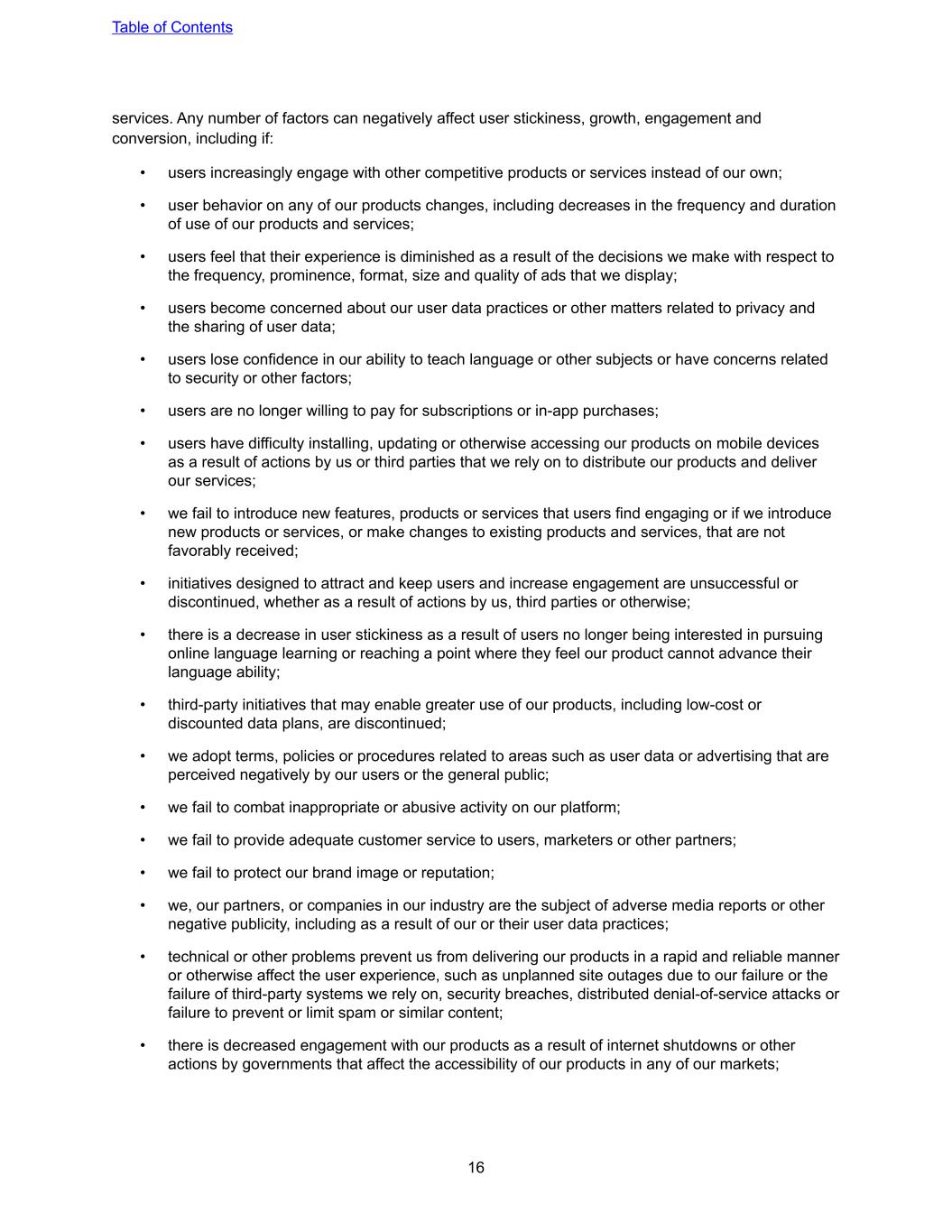
services. Any number of factors can negatively affect user stickiness, growth, engagement and conversion, including if: • users increasingly engage with other competitive products or services instead of our own; • user behavior on any of our products changes, including decreases in the frequency and duration of use of our products and services; • users feel that their experience is diminished as a result of the decisions we make with respect to the frequency, prominence, format, size and quality of ads that we display; • users become concerned about our user data practices or other matters related to privacy and the sharing of user data; • users lose confidence in our ability to teach language or other subjects or have concerns related to security or other factors; • users are no longer willing to pay for subscriptions or in-app purchases; • users have difficulty installing, updating or otherwise accessing our products on mobile devices as a result of actions by us or third parties that we rely on to distribute our products and deliver our services; • we fail to introduce new features, products or services that users find engaging or if we introduce new products or services, or make changes to existing products and services, that are not favorably received; • initiatives designed to attract and keep users and increase engagement are unsuccessful or discontinued, whether as a result of actions by us, third parties or otherwise; • there is a decrease in user stickiness as a result of users no longer being interested in pursuing online language learning or reaching a point where they feel our product cannot advance their language ability; • third-party initiatives that may enable greater use of our products, including low-cost or discounted data plans, are discontinued; • we adopt terms, policies or procedures related to areas such as user data or advertising that are perceived negatively by our users or the general public; • we fail to combat inappropriate or abusive activity on our platform; • we fail to provide adequate customer service to users, marketers or other partners; • we fail to protect our brand image or reputation; • we, our partners, or companies in our industry are the subject of adverse media reports or other negative publicity, including as a result of our or their user data practices; • technical or other problems prevent us from delivering our products in a rapid and reliable manner or otherwise affect the user experience, such as unplanned site outages due to our failure or the failure of third-party systems we rely on, security breaches, distributed denial-of-service attacks or failure to prevent or limit spam or similar content; • there is decreased engagement with our products as a result of internet shutdowns or other actions by governments that affect the accessibility of our products in any of our markets; Table of Contents 16
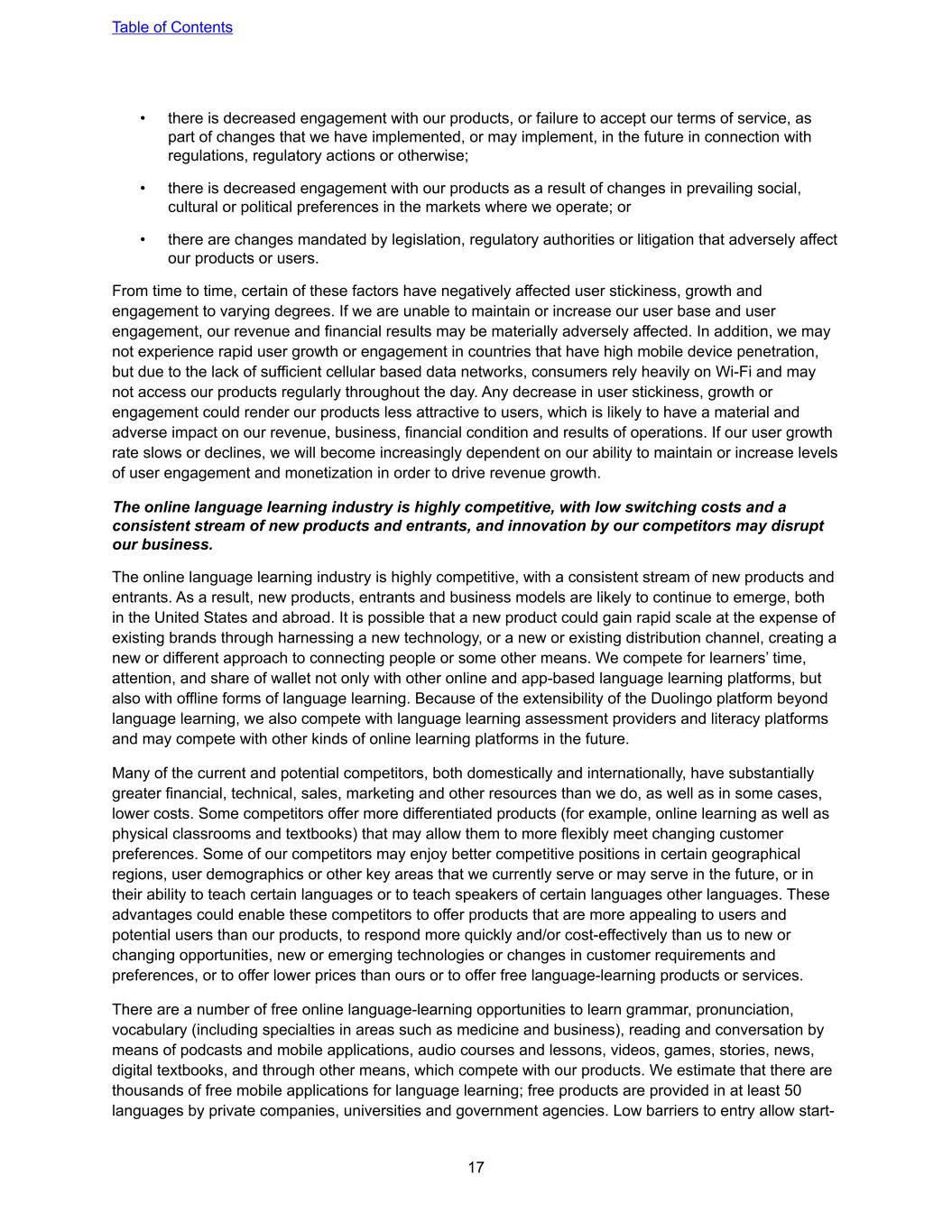
• there is decreased engagement with our products, or failure to accept our terms of service, as part of changes that we have implemented, or may implement, in the future in connection with regulations, regulatory actions or otherwise; • there is decreased engagement with our products as a result of changes in prevailing social, cultural or political preferences in the markets where we operate; or • there are changes mandated by legislation, regulatory authorities or litigation that adversely affect our products or users. From time to time, certain of these factors have negatively affected user stickiness, growth and engagement to varying degrees. If we are unable to maintain or increase our user base and user engagement, our revenue and financial results may be materially adversely affected. In addition, we may not experience rapid user growth or engagement in countries that have high mobile device penetration, but due to the lack of sufficient cellular based data networks, consumers rely heavily on Wi-Fi and may not access our products regularly throughout the day. Any decrease in user stickiness, growth or engagement could render our products less attractive to users, which is likely to have a material and adverse impact on our revenue, business, financial condition and results of operations. If our user growth rate slows or declines, we will become increasingly dependent on our ability to maintain or increase levels of user engagement and monetization in order to drive revenue growth. The online language learning industry is highly competitive, with low switching costs and a consistent stream of new products and entrants, and innovation by our competitors may disrupt our business. The online language learning industry is highly competitive, with a consistent stream of new products and entrants. As a result, new products, entrants and business models are likely to continue to emerge, both in the United States and abroad. It is possible that a new product could gain rapid scale at the expense of existing brands through harnessing a new technology, or a new or existing distribution channel, creating a new or different approach to connecting people or some other means. We compete for learners’ time, attention, and share of wallet not only with other online and app-based language learning platforms, but also with offline forms of language learning. Because of the extensibility of the Duolingo platform beyond language learning, we also compete with language learning assessment providers and literacy platforms and may compete with other kinds of online learning platforms in the future. Many of the current and potential competitors, both domestically and internationally, have substantially greater financial, technical, sales, marketing and other resources than we do, as well as in some cases, lower costs. Some competitors offer more differentiated products (for example, online learning as well as physical classrooms and textbooks) that may allow them to more flexibly meet changing customer preferences. Some of our competitors may enjoy better competitive positions in certain geographical regions, user demographics or other key areas that we currently serve or may serve in the future, or in their ability to teach certain languages or to teach speakers of certain languages other languages. These advantages could enable these competitors to offer products that are more appealing to users and potential users than our products, to respond more quickly and/or cost-effectively than us to new or changing opportunities, new or emerging technologies or changes in customer requirements and preferences, or to offer lower prices than ours or to offer free language-learning products or services. There are a number of free online language-learning opportunities to learn grammar, pronunciation, vocabulary (including specialties in areas such as medicine and business), reading and conversation by means of podcasts and mobile applications, audio courses and lessons, videos, games, stories, news, digital textbooks, and through other means, which compete with our products. We estimate that there are thousands of free mobile applications for language learning; free products are provided in at least 50 languages by private companies, universities and government agencies. Low barriers to entry allow start- Table of Contents 17
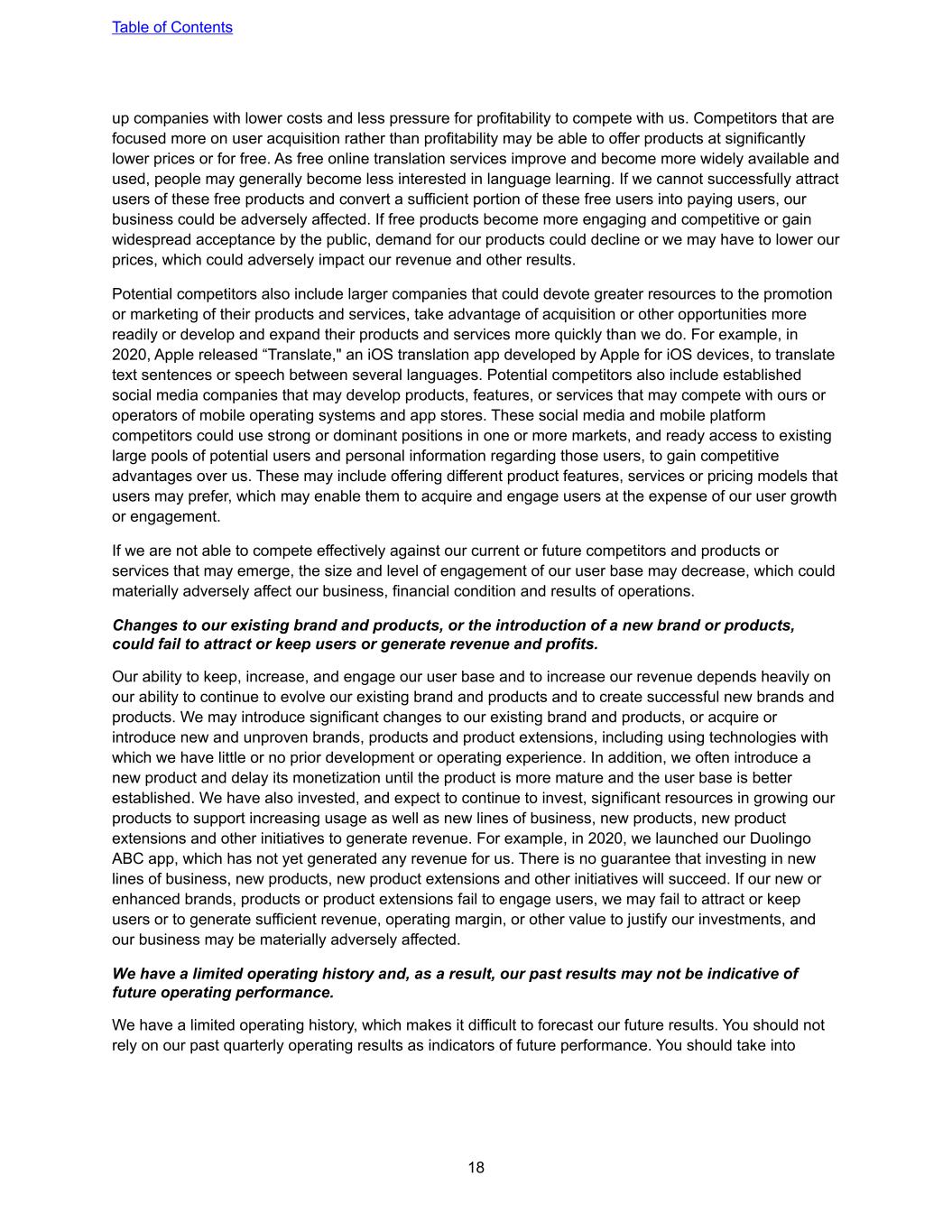
up companies with lower costs and less pressure for profitability to compete with us. Competitors that are focused more on user acquisition rather than profitability may be able to offer products at significantly lower prices or for free. As free online translation services improve and become more widely available and used, people may generally become less interested in language learning. If we cannot successfully attract users of these free products and convert a sufficient portion of these free users into paying users, our business could be adversely affected. If free products become more engaging and competitive or gain widespread acceptance by the public, demand for our products could decline or we may have to lower our prices, which could adversely impact our revenue and other results. Potential competitors also include larger companies that could devote greater resources to the promotion or marketing of their products and services, take advantage of acquisition or other opportunities more readily or develop and expand their products and services more quickly than we do. For example, in 2020, Apple released “Translate," an iOS translation app developed by Apple for iOS devices, to translate text sentences or speech between several languages. Potential competitors also include established social media companies that may develop products, features, or services that may compete with ours or operators of mobile operating systems and app stores. These social media and mobile platform competitors could use strong or dominant positions in one or more markets, and ready access to existing large pools of potential users and personal information regarding those users, to gain competitive advantages over us. These may include offering different product features, services or pricing models that users may prefer, which may enable them to acquire and engage users at the expense of our user growth or engagement. If we are not able to compete effectively against our current or future competitors and products or services that may emerge, the size and level of engagement of our user base may decrease, which could materially adversely affect our business, financial condition and results of operations. Changes to our existing brand and products, or the introduction of a new brand or products, could fail to attract or keep users or generate revenue and profits. Our ability to keep, increase, and engage our user base and to increase our revenue depends heavily on our ability to continue to evolve our existing brand and products and to create successful new brands and products. We may introduce significant changes to our existing brand and products, or acquire or introduce new and unproven brands, products and product extensions, including using technologies with which we have little or no prior development or operating experience. In addition, we often introduce a new product and delay its monetization until the product is more mature and the user base is better established. We have also invested, and expect to continue to invest, significant resources in growing our products to support increasing usage as well as new lines of business, new products, new product extensions and other initiatives to generate revenue. For example, in 2020, we launched our Duolingo ABC app, which has not yet generated any revenue for us. There is no guarantee that investing in new lines of business, new products, new product extensions and other initiatives will succeed. If our new or enhanced brands, products or product extensions fail to engage users, we may fail to attract or keep users or to generate sufficient revenue, operating margin, or other value to justify our investments, and our business may be materially adversely affected. We have a limited operating history and, as a result, our past results may not be indicative of future operating performance. We have a limited operating history, which makes it difficult to forecast our future results. You should not rely on our past quarterly operating results as indicators of future performance. You should take into Table of Contents 18
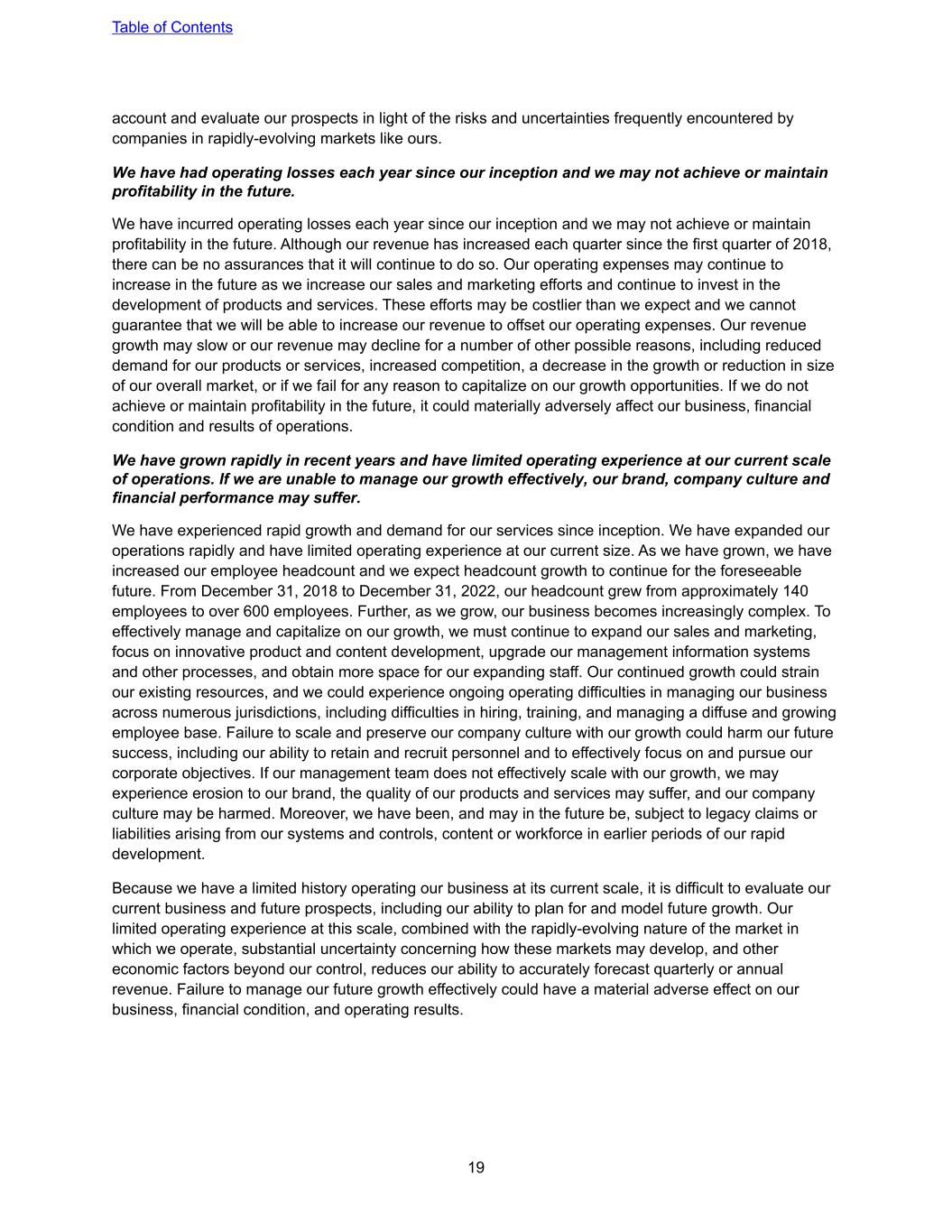
account and evaluate our prospects in light of the risks and uncertainties frequently encountered by companies in rapidly-evolving markets like ours. We have had operating losses each year since our inception and we may not achieve or maintain profitability in the future. We have incurred operating losses each year since our inception and we may not achieve or maintain profitability in the future. Although our revenue has increased each quarter since the first quarter of 2018, there can be no assurances that it will continue to do so. Our operating expenses may continue to increase in the future as we increase our sales and marketing efforts and continue to invest in the development of products and services. These efforts may be costlier than we expect and we cannot guarantee that we will be able to increase our revenue to offset our operating expenses. Our revenue growth may slow or our revenue may decline for a number of other possible reasons, including reduced demand for our products or services, increased competition, a decrease in the growth or reduction in size of our overall market, or if we fail for any reason to capitalize on our growth opportunities. If we do not achieve or maintain profitability in the future, it could materially adversely affect our business, financial condition and results of operations. We have grown rapidly in recent years and have limited operating experience at our current scale of operations. If we are unable to manage our growth effectively, our brand, company culture and financial performance may suffer. We have experienced rapid growth and demand for our services since inception. We have expanded our operations rapidly and have limited operating experience at our current size. As we have grown, we have increased our employee headcount and we expect headcount growth to continue for the foreseeable future. From December 31, 2018 to December 31, 2022, our headcount grew from approximately 140 employees to over 600 employees. Further, as we grow, our business becomes increasingly complex. To effectively manage and capitalize on our growth, we must continue to expand our sales and marketing, focus on innovative product and content development, upgrade our management information systems and other processes, and obtain more space for our expanding staff. Our continued growth could strain our existing resources, and we could experience ongoing operating difficulties in managing our business across numerous jurisdictions, including difficulties in hiring, training, and managing a diffuse and growing employee base. Failure to scale and preserve our company culture with our growth could harm our future success, including our ability to retain and recruit personnel and to effectively focus on and pursue our corporate objectives. If our management team does not effectively scale with our growth, we may experience erosion to our brand, the quality of our products and services may suffer, and our company culture may be harmed. Moreover, we have been, and may in the future be, subject to legacy claims or liabilities arising from our systems and controls, content or workforce in earlier periods of our rapid development. Because we have a limited history operating our business at its current scale, it is difficult to evaluate our current business and future prospects, including our ability to plan for and model future growth. Our limited operating experience at this scale, combined with the rapidly-evolving nature of the market in which we operate, substantial uncertainty concerning how these markets may develop, and other economic factors beyond our control, reduces our ability to accurately forecast quarterly or annual revenue. Failure to manage our future growth effectively could have a material adverse effect on our business, financial condition, and operating results. Table of Contents 19
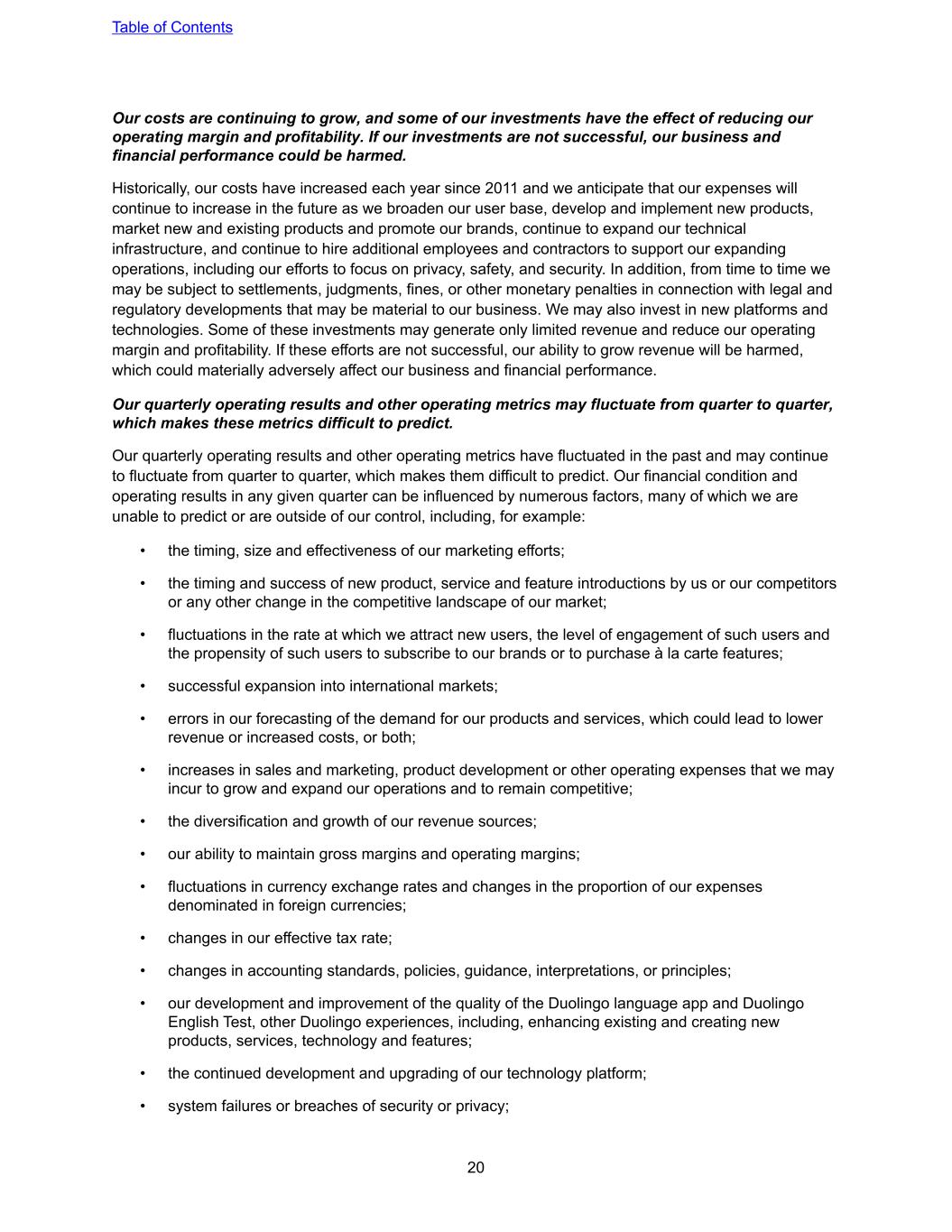
Our costs are continuing to grow, and some of our investments have the effect of reducing our operating margin and profitability. If our investments are not successful, our business and financial performance could be harmed. Historically, our costs have increased each year since 2011 and we anticipate that our expenses will continue to increase in the future as we broaden our user base, develop and implement new products, market new and existing products and promote our brands, continue to expand our technical infrastructure, and continue to hire additional employees and contractors to support our expanding operations, including our efforts to focus on privacy, safety, and security. In addition, from time to time we may be subject to settlements, judgments, fines, or other monetary penalties in connection with legal and regulatory developments that may be material to our business. We may also invest in new platforms and technologies. Some of these investments may generate only limited revenue and reduce our operating margin and profitability. If these efforts are not successful, our ability to grow revenue will be harmed, which could materially adversely affect our business and financial performance. Our quarterly operating results and other operating metrics may fluctuate from quarter to quarter, which makes these metrics difficult to predict. Our quarterly operating results and other operating metrics have fluctuated in the past and may continue to fluctuate from quarter to quarter, which makes them difficult to predict. Our financial condition and operating results in any given quarter can be influenced by numerous factors, many of which we are unable to predict or are outside of our control, including, for example: • the timing, size and effectiveness of our marketing efforts; • the timing and success of new product, service and feature introductions by us or our competitors or any other change in the competitive landscape of our market; • fluctuations in the rate at which we attract new users, the level of engagement of such users and the propensity of such users to subscribe to our brands or to purchase à la carte features; • successful expansion into international markets; • errors in our forecasting of the demand for our products and services, which could lead to lower revenue or increased costs, or both; • increases in sales and marketing, product development or other operating expenses that we may incur to grow and expand our operations and to remain competitive; • the diversification and growth of our revenue sources; • our ability to maintain gross margins and operating margins; • fluctuations in currency exchange rates and changes in the proportion of our expenses denominated in foreign currencies; • changes in our effective tax rate; • changes in accounting standards, policies, guidance, interpretations, or principles; • our development and improvement of the quality of the Duolingo language app and Duolingo English Test, other Duolingo experiences, including, enhancing existing and creating new products, services, technology and features; • the continued development and upgrading of our technology platform; • system failures or breaches of security or privacy; Table of Contents 20
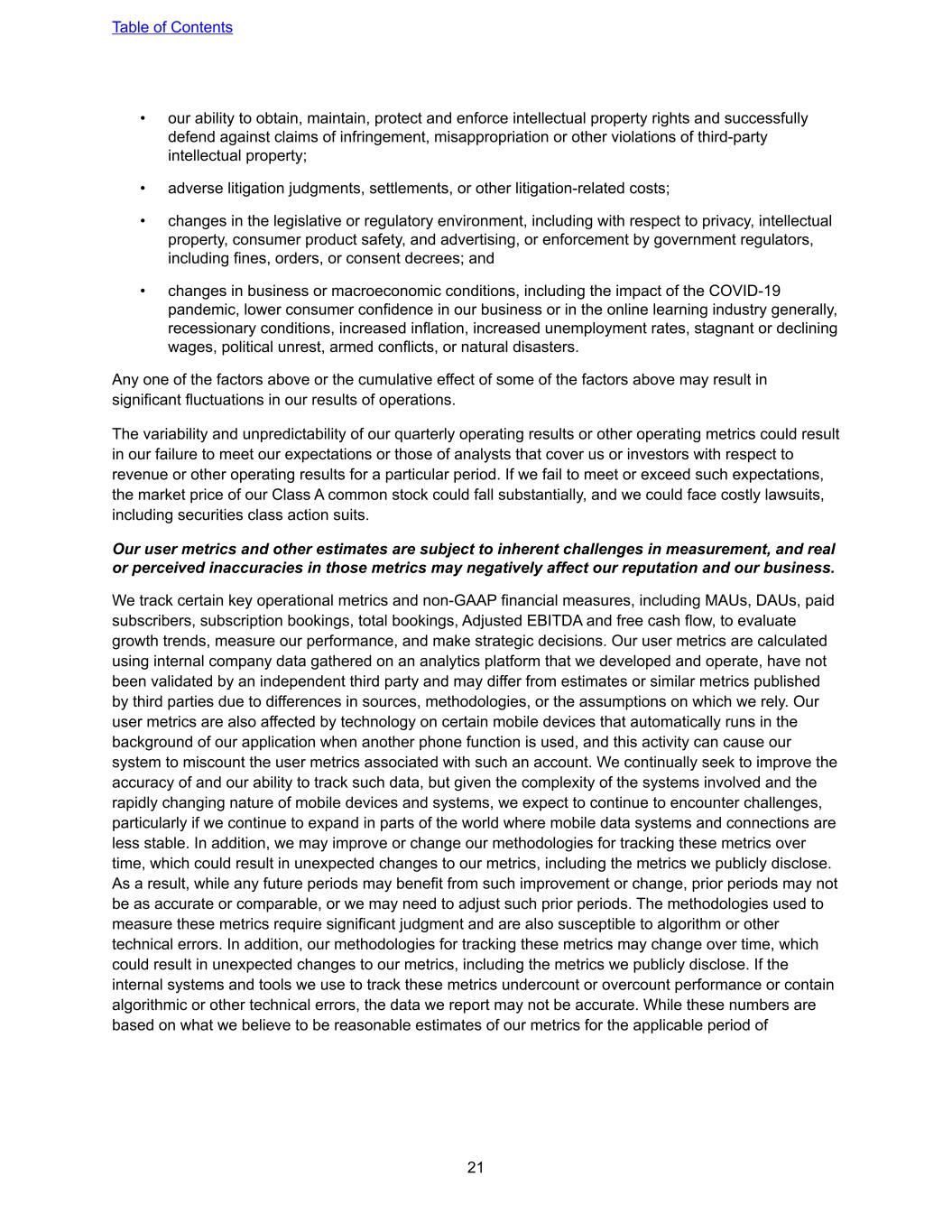
• our ability to obtain, maintain, protect and enforce intellectual property rights and successfully defend against claims of infringement, misappropriation or other violations of third-party intellectual property; • adverse litigation judgments, settlements, or other litigation-related costs; • changes in the legislative or regulatory environment, including with respect to privacy, intellectual property, consumer product safety, and advertising, or enforcement by government regulators, including fines, orders, or consent decrees; and • changes in business or macroeconomic conditions, including the impact of the COVID-19 pandemic, lower consumer confidence in our business or in the online learning industry generally, recessionary conditions, increased inflation, increased unemployment rates, stagnant or declining wages, political unrest, armed conflicts, or natural disasters. Any one of the factors above or the cumulative effect of some of the factors above may result in significant fluctuations in our results of operations. The variability and unpredictability of our quarterly operating results or other operating metrics could result in our failure to meet our expectations or those of analysts that cover us or investors with respect to revenue or other operating results for a particular period. If we fail to meet or exceed such expectations, the market price of our Class A common stock could fall substantially, and we could face costly lawsuits, including securities class action suits. Our user metrics and other estimates are subject to inherent challenges in measurement, and real or perceived inaccuracies in those metrics may negatively affect our reputation and our business. We track certain key operational metrics and non-GAAP financial measures, including MAUs, DAUs, paid subscribers, subscription bookings, total bookings, Adjusted EBITDA and free cash flow, to evaluate growth trends, measure our performance, and make strategic decisions. Our user metrics are calculated using internal company data gathered on an analytics platform that we developed and operate, have not been validated by an independent third party and may differ from estimates or similar metrics published by third parties due to differences in sources, methodologies, or the assumptions on which we rely. Our user metrics are also affected by technology on certain mobile devices that automatically runs in the background of our application when another phone function is used, and this activity can cause our system to miscount the user metrics associated with such an account. We continually seek to improve the accuracy of and our ability to track such data, but given the complexity of the systems involved and the rapidly changing nature of mobile devices and systems, we expect to continue to encounter challenges, particularly if we continue to expand in parts of the world where mobile data systems and connections are less stable. In addition, we may improve or change our methodologies for tracking these metrics over time, which could result in unexpected changes to our metrics, including the metrics we publicly disclose. As a result, while any future periods may benefit from such improvement or change, prior periods may not be as accurate or comparable, or we may need to adjust such prior periods. The methodologies used to measure these metrics require significant judgment and are also susceptible to algorithm or other technical errors. In addition, our methodologies for tracking these metrics may change over time, which could result in unexpected changes to our metrics, including the metrics we publicly disclose. If the internal systems and tools we use to track these metrics undercount or overcount performance or contain algorithmic or other technical errors, the data we report may not be accurate. While these numbers are based on what we believe to be reasonable estimates of our metrics for the applicable period of Table of Contents 21
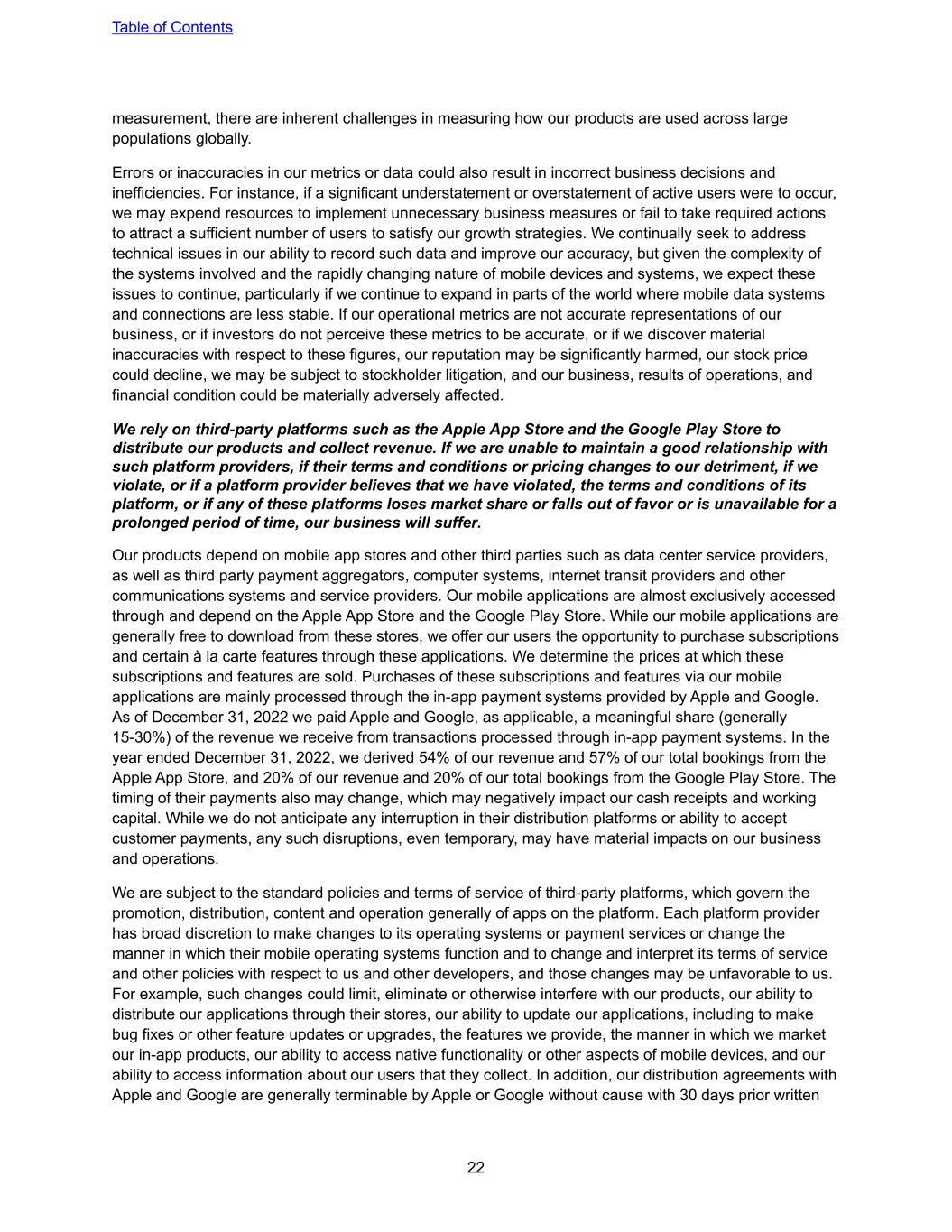
measurement, there are inherent challenges in measuring how our products are used across large populations globally. Errors or inaccuracies in our metrics or data could also result in incorrect business decisions and inefficiencies. For instance, if a significant understatement or overstatement of active users were to occur, we may expend resources to implement unnecessary business measures or fail to take required actions to attract a sufficient number of users to satisfy our growth strategies. We continually seek to address technical issues in our ability to record such data and improve our accuracy, but given the complexity of the systems involved and the rapidly changing nature of mobile devices and systems, we expect these issues to continue, particularly if we continue to expand in parts of the world where mobile data systems and connections are less stable. If our operational metrics are not accurate representations of our business, or if investors do not perceive these metrics to be accurate, or if we discover material inaccuracies with respect to these figures, our reputation may be significantly harmed, our stock price could decline, we may be subject to stockholder litigation, and our business, results of operations, and financial condition could be materially adversely affected. We rely on third-party platforms such as the Apple App Store and the Google Play Store to distribute our products and collect revenue. If we are unable to maintain a good relationship with such platform providers, if their terms and conditions or pricing changes to our detriment, if we violate, or if a platform provider believes that we have violated, the terms and conditions of its platform, or if any of these platforms loses market share or falls out of favor or is unavailable for a prolonged period of time, our business will suffer. Our products depend on mobile app stores and other third parties such as data center service providers, as well as third party payment aggregators, computer systems, internet transit providers and other communications systems and service providers. Our mobile applications are almost exclusively accessed through and depend on the Apple App Store and the Google Play Store. While our mobile applications are generally free to download from these stores, we offer our users the opportunity to purchase subscriptions and certain à la carte features through these applications. We determine the prices at which these subscriptions and features are sold. Purchases of these subscriptions and features via our mobile applications are mainly processed through the in-app payment systems provided by Apple and Google. As of December 31, 2022 we paid Apple and Google, as applicable, a meaningful share (generally 15-30%) of the revenue we receive from transactions processed through in-app payment systems. In the year ended December 31, 2022, we derived 54% of our revenue and 57% of our total bookings from the Apple App Store, and 20% of our revenue and 20% of our total bookings from the Google Play Store. The timing of their payments also may change, which may negatively impact our cash receipts and working capital. While we do not anticipate any interruption in their distribution platforms or ability to accept customer payments, any such disruptions, even temporary, may have material impacts on our business and operations. We are subject to the standard policies and terms of service of third-party platforms, which govern the promotion, distribution, content and operation generally of apps on the platform. Each platform provider has broad discretion to make changes to its operating systems or payment services or change the manner in which their mobile operating systems function and to change and interpret its terms of service and other policies with respect to us and other developers, and those changes may be unfavorable to us. For example, such changes could limit, eliminate or otherwise interfere with our products, our ability to distribute our applications through their stores, our ability to update our applications, including to make bug fixes or other feature updates or upgrades, the features we provide, the manner in which we market our in-app products, our ability to access native functionality or other aspects of mobile devices, and our ability to access information about our users that they collect. In addition, our distribution agreements with Apple and Google are generally terminable by Apple or Google without cause with 30 days prior written Table of Contents 22
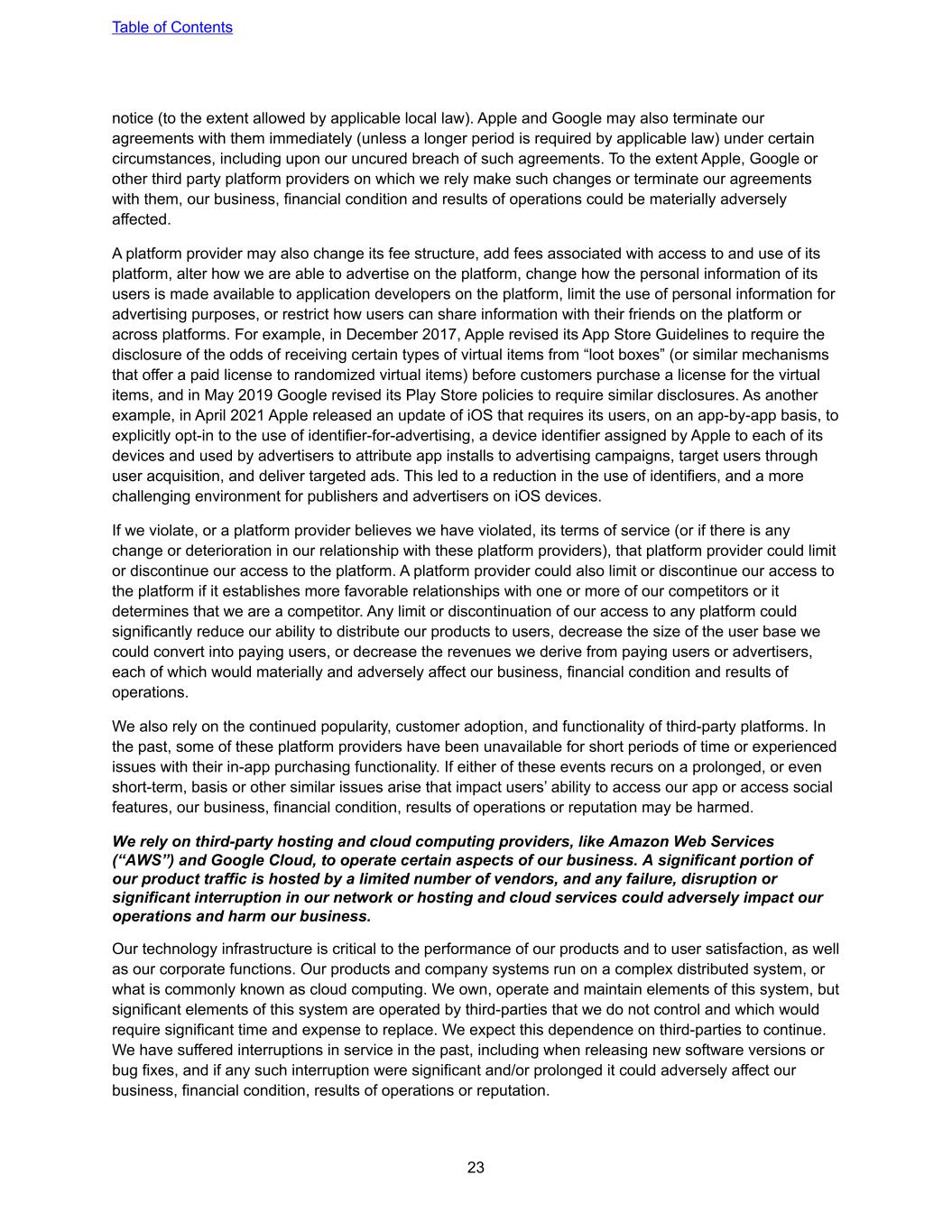
notice (to the extent allowed by applicable local law). Apple and Google may also terminate our agreements with them immediately (unless a longer period is required by applicable law) under certain circumstances, including upon our uncured breach of such agreements. To the extent Apple, Google or other third party platform providers on which we rely make such changes or terminate our agreements with them, our business, financial condition and results of operations could be materially adversely affected. A platform provider may also change its fee structure, add fees associated with access to and use of its platform, alter how we are able to advertise on the platform, change how the personal information of its users is made available to application developers on the platform, limit the use of personal information for advertising purposes, or restrict how users can share information with their friends on the platform or across platforms. For example, in December 2017, Apple revised its App Store Guidelines to require the disclosure of the odds of receiving certain types of virtual items from “loot boxes” (or similar mechanisms that offer a paid license to randomized virtual items) before customers purchase a license for the virtual items, and in May 2019 Google revised its Play Store policies to require similar disclosures. As another example, in April 2021 Apple released an update of iOS that requires its users, on an app-by-app basis, to explicitly opt-in to the use of identifier-for-advertising, a device identifier assigned by Apple to each of its devices and used by advertisers to attribute app installs to advertising campaigns, target users through user acquisition, and deliver targeted ads. This led to a reduction in the use of identifiers, and a more challenging environment for publishers and advertisers on iOS devices. If we violate, or a platform provider believes we have violated, its terms of service (or if there is any change or deterioration in our relationship with these platform providers), that platform provider could limit or discontinue our access to the platform. A platform provider could also limit or discontinue our access to the platform if it establishes more favorable relationships with one or more of our competitors or it determines that we are a competitor. Any limit or discontinuation of our access to any platform could significantly reduce our ability to distribute our products to users, decrease the size of the user base we could convert into paying users, or decrease the revenues we derive from paying users or advertisers, each of which would materially and adversely affect our business, financial condition and results of operations. We also rely on the continued popularity, customer adoption, and functionality of third-party platforms. In the past, some of these platform providers have been unavailable for short periods of time or experienced issues with their in-app purchasing functionality. If either of these events recurs on a prolonged, or even short-term, basis or other similar issues arise that impact users’ ability to access our app or access social features, our business, financial condition, results of operations or reputation may be harmed. We rely on third-party hosting and cloud computing providers, like Amazon Web Services (“AWS”) and Google Cloud, to operate certain aspects of our business. A significant portion of our product traffic is hosted by a limited number of vendors, and any failure, disruption or significant interruption in our network or hosting and cloud services could adversely impact our operations and harm our business. Our technology infrastructure is critical to the performance of our products and to user satisfaction, as well as our corporate functions. Our products and company systems run on a complex distributed system, or what is commonly known as cloud computing. We own, operate and maintain elements of this system, but significant elements of this system are operated by third-parties that we do not control and which would require significant time and expense to replace. We expect this dependence on third-parties to continue. We have suffered interruptions in service in the past, including when releasing new software versions or bug fixes, and if any such interruption were significant and/or prolonged it could adversely affect our business, financial condition, results of operations or reputation. Table of Contents 23
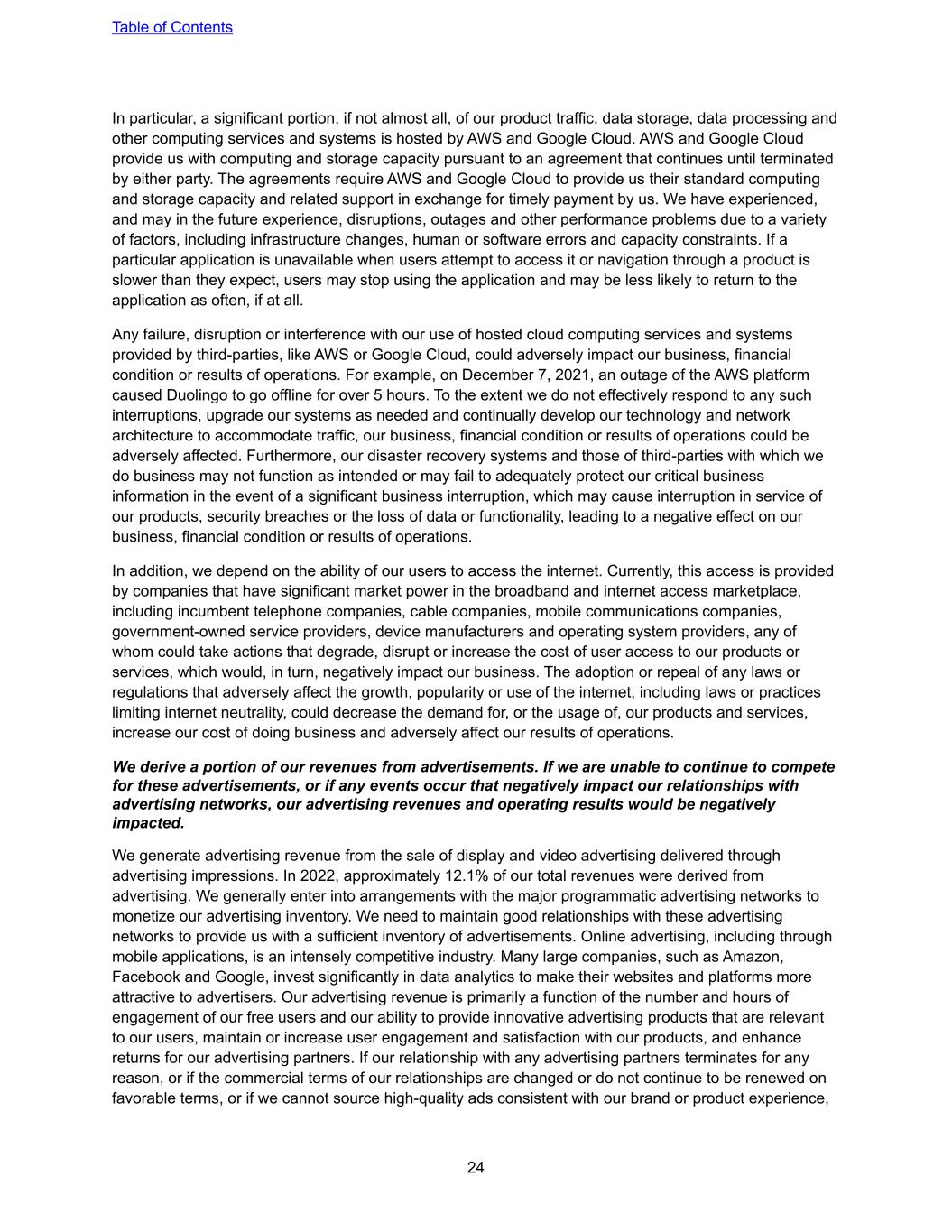
In particular, a significant portion, if not almost all, of our product traffic, data storage, data processing and other computing services and systems is hosted by AWS and Google Cloud. AWS and Google Cloud provide us with computing and storage capacity pursuant to an agreement that continues until terminated by either party. The agreements require AWS and Google Cloud to provide us their standard computing and storage capacity and related support in exchange for timely payment by us. We have experienced, and may in the future experience, disruptions, outages and other performance problems due to a variety of factors, including infrastructure changes, human or software errors and capacity constraints. If a particular application is unavailable when users attempt to access it or navigation through a product is slower than they expect, users may stop using the application and may be less likely to return to the application as often, if at all. Any failure, disruption or interference with our use of hosted cloud computing services and systems provided by third-parties, like AWS or Google Cloud, could adversely impact our business, financial condition or results of operations. For example, on December 7, 2021, an outage of the AWS platform caused Duolingo to go offline for over 5 hours. To the extent we do not effectively respond to any such interruptions, upgrade our systems as needed and continually develop our technology and network architecture to accommodate traffic, our business, financial condition or results of operations could be adversely affected. Furthermore, our disaster recovery systems and those of third-parties with which we do business may not function as intended or may fail to adequately protect our critical business information in the event of a significant business interruption, which may cause interruption in service of our products, security breaches or the loss of data or functionality, leading to a negative effect on our business, financial condition or results of operations. In addition, we depend on the ability of our users to access the internet. Currently, this access is provided by companies that have significant market power in the broadband and internet access marketplace, including incumbent telephone companies, cable companies, mobile communications companies, government-owned service providers, device manufacturers and operating system providers, any of whom could take actions that degrade, disrupt or increase the cost of user access to our products or services, which would, in turn, negatively impact our business. The adoption or repeal of any laws or regulations that adversely affect the growth, popularity or use of the internet, including laws or practices limiting internet neutrality, could decrease the demand for, or the usage of, our products and services, increase our cost of doing business and adversely affect our results of operations. We derive a portion of our revenues from advertisements. If we are unable to continue to compete for these advertisements, or if any events occur that negatively impact our relationships with advertising networks, our advertising revenues and operating results would be negatively impacted. We generate advertising revenue from the sale of display and video advertising delivered through advertising impressions. In 2022, approximately 12.1% of our total revenues were derived from advertising. We generally enter into arrangements with the major programmatic advertising networks to monetize our advertising inventory. We need to maintain good relationships with these advertising networks to provide us with a sufficient inventory of advertisements. Online advertising, including through mobile applications, is an intensely competitive industry. Many large companies, such as Amazon, Facebook and Google, invest significantly in data analytics to make their websites and platforms more attractive to advertisers. Our advertising revenue is primarily a function of the number and hours of engagement of our free users and our ability to provide innovative advertising products that are relevant to our users, maintain or increase user engagement and satisfaction with our products, and enhance returns for our advertising partners. If our relationship with any advertising partners terminates for any reason, or if the commercial terms of our relationships are changed or do not continue to be renewed on favorable terms, or if we cannot source high-quality ads consistent with our brand or product experience, Table of Contents 24
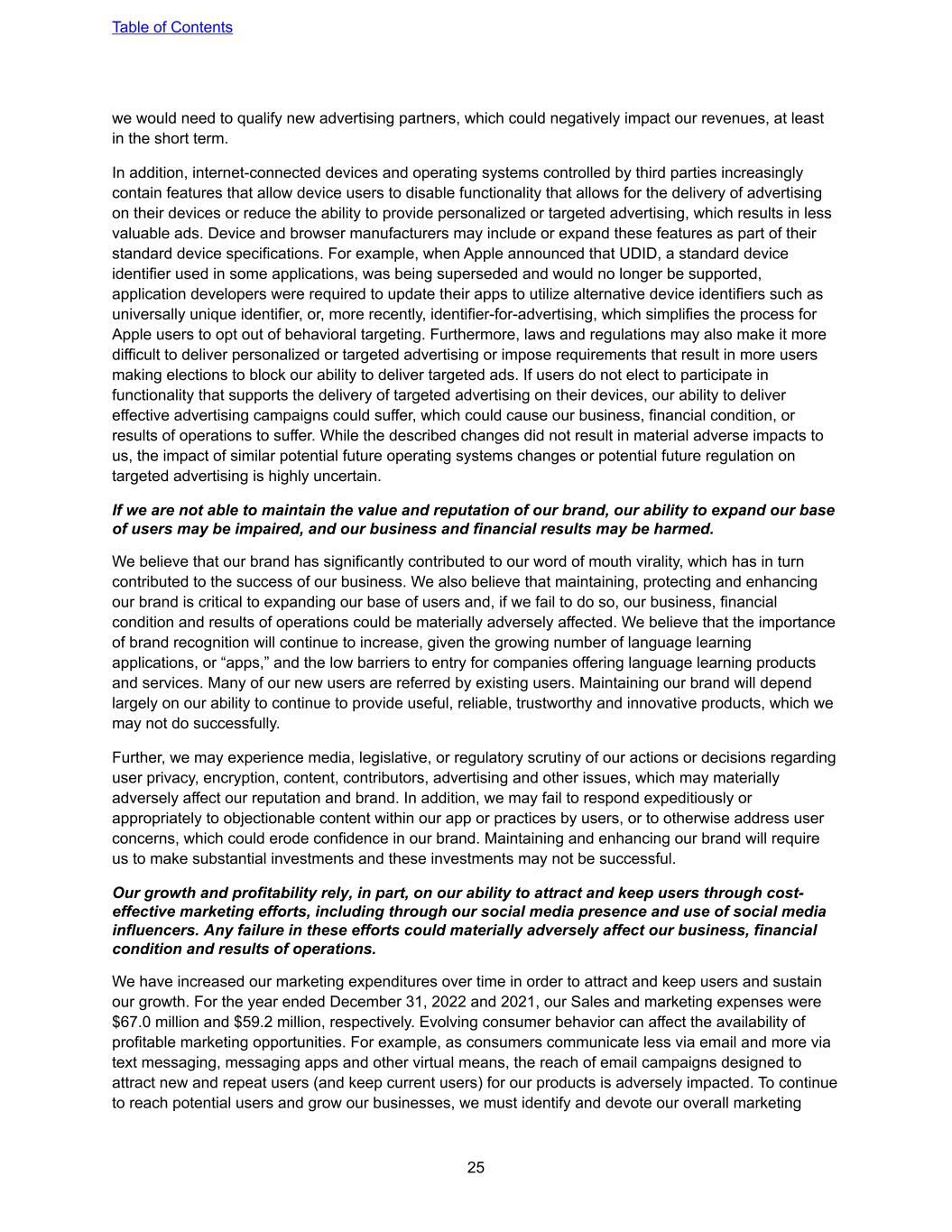
we would need to qualify new advertising partners, which could negatively impact our revenues, at least in the short term. In addition, internet-connected devices and operating systems controlled by third parties increasingly contain features that allow device users to disable functionality that allows for the delivery of advertising on their devices or reduce the ability to provide personalized or targeted advertising, which results in less valuable ads. Device and browser manufacturers may include or expand these features as part of their standard device specifications. For example, when Apple announced that UDID, a standard device identifier used in some applications, was being superseded and would no longer be supported, application developers were required to update their apps to utilize alternative device identifiers such as universally unique identifier, or, more recently, identifier-for-advertising, which simplifies the process for Apple users to opt out of behavioral targeting. Furthermore, laws and regulations may also make it more difficult to deliver personalized or targeted advertising or impose requirements that result in more users making elections to block our ability to deliver targeted ads. If users do not elect to participate in functionality that supports the delivery of targeted advertising on their devices, our ability to deliver effective advertising campaigns could suffer, which could cause our business, financial condition, or results of operations to suffer. While the described changes did not result in material adverse impacts to us, the impact of similar potential future operating systems changes or potential future regulation on targeted advertising is highly uncertain. If we are not able to maintain the value and reputation of our brand, our ability to expand our base of users may be impaired, and our business and financial results may be harmed. We believe that our brand has significantly contributed to our word of mouth virality, which has in turn contributed to the success of our business. We also believe that maintaining, protecting and enhancing our brand is critical to expanding our base of users and, if we fail to do so, our business, financial condition and results of operations could be materially adversely affected. We believe that the importance of brand recognition will continue to increase, given the growing number of language learning applications, or “apps,” and the low barriers to entry for companies offering language learning products and services. Many of our new users are referred by existing users. Maintaining our brand will depend largely on our ability to continue to provide useful, reliable, trustworthy and innovative products, which we may not do successfully. Further, we may experience media, legislative, or regulatory scrutiny of our actions or decisions regarding user privacy, encryption, content, contributors, advertising and other issues, which may materially adversely affect our reputation and brand. In addition, we may fail to respond expeditiously or appropriately to objectionable content within our app or practices by users, or to otherwise address user concerns, which could erode confidence in our brand. Maintaining and enhancing our brand will require us to make substantial investments and these investments may not be successful. Our growth and profitability rely, in part, on our ability to attract and keep users through cost- effective marketing efforts, including through our social media presence and use of social media influencers. Any failure in these efforts could materially adversely affect our business, financial condition and results of operations. We have increased our marketing expenditures over time in order to attract and keep users and sustain our growth. For the year ended December 31, 2022 and 2021, our Sales and marketing expenses were $67.0 million and $59.2 million, respectively. Evolving consumer behavior can affect the availability of profitable marketing opportunities. For example, as consumers communicate less via email and more via text messaging, messaging apps and other virtual means, the reach of email campaigns designed to attract new and repeat users (and keep current users) for our products is adversely impacted. To continue to reach potential users and grow our businesses, we must identify and devote our overall marketing Table of Contents 25
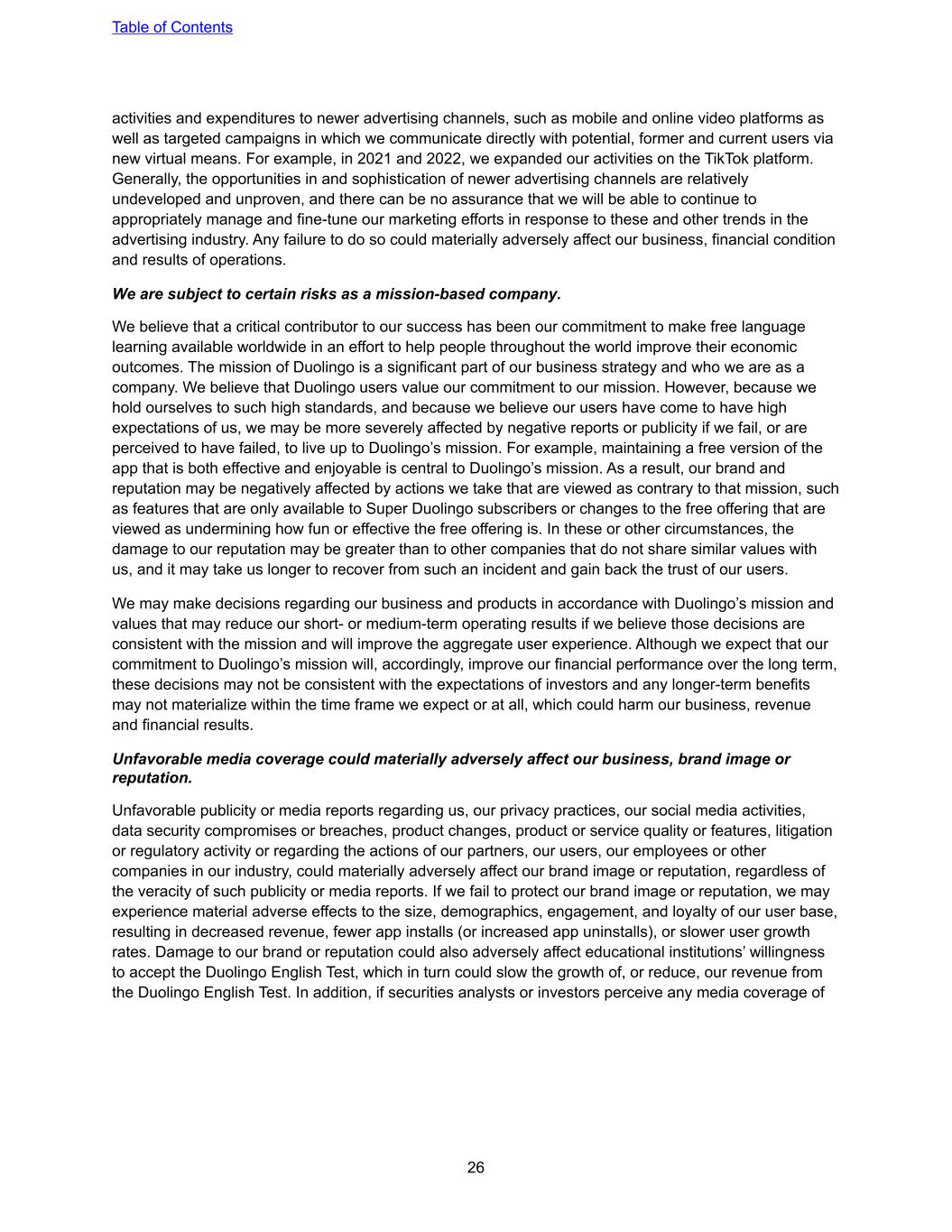
activities and expenditures to newer advertising channels, such as mobile and online video platforms as well as targeted campaigns in which we communicate directly with potential, former and current users via new virtual means. For example, in 2021 and 2022, we expanded our activities on the TikTok platform. Generally, the opportunities in and sophistication of newer advertising channels are relatively undeveloped and unproven, and there can be no assurance that we will be able to continue to appropriately manage and fine-tune our marketing efforts in response to these and other trends in the advertising industry. Any failure to do so could materially adversely affect our business, financial condition and results of operations. We are subject to certain risks as a mission-based company. We believe that a critical contributor to our success has been our commitment to make free language learning available worldwide in an effort to help people throughout the world improve their economic outcomes. The mission of Duolingo is a significant part of our business strategy and who we are as a company. We believe that Duolingo users value our commitment to our mission. However, because we hold ourselves to such high standards, and because we believe our users have come to have high expectations of us, we may be more severely affected by negative reports or publicity if we fail, or are perceived to have failed, to live up to Duolingo’s mission. For example, maintaining a free version of the app that is both effective and enjoyable is central to Duolingo’s mission. As a result, our brand and reputation may be negatively affected by actions we take that are viewed as contrary to that mission, such as features that are only available to Super Duolingo subscribers or changes to the free offering that are viewed as undermining how fun or effective the free offering is. In these or other circumstances, the damage to our reputation may be greater than to other companies that do not share similar values with us, and it may take us longer to recover from such an incident and gain back the trust of our users. We may make decisions regarding our business and products in accordance with Duolingo’s mission and values that may reduce our short- or medium-term operating results if we believe those decisions are consistent with the mission and will improve the aggregate user experience. Although we expect that our commitment to Duolingo’s mission will, accordingly, improve our financial performance over the long term, these decisions may not be consistent with the expectations of investors and any longer-term benefits may not materialize within the time frame we expect or at all, which could harm our business, revenue and financial results. Unfavorable media coverage could materially adversely affect our business, brand image or reputation. Unfavorable publicity or media reports regarding us, our privacy practices, our social media activities, data security compromises or breaches, product changes, product or service quality or features, litigation or regulatory activity or regarding the actions of our partners, our users, our employees or other companies in our industry, could materially adversely affect our brand image or reputation, regardless of the veracity of such publicity or media reports. If we fail to protect our brand image or reputation, we may experience material adverse effects to the size, demographics, engagement, and loyalty of our user base, resulting in decreased revenue, fewer app installs (or increased app uninstalls), or slower user growth rates. Damage to our brand or reputation could also adversely affect educational institutions’ willingness to accept the Duolingo English Test, which in turn could slow the growth of, or reduce, our revenue from the Duolingo English Test. In addition, if securities analysts or investors perceive any media coverage of Table of Contents 26
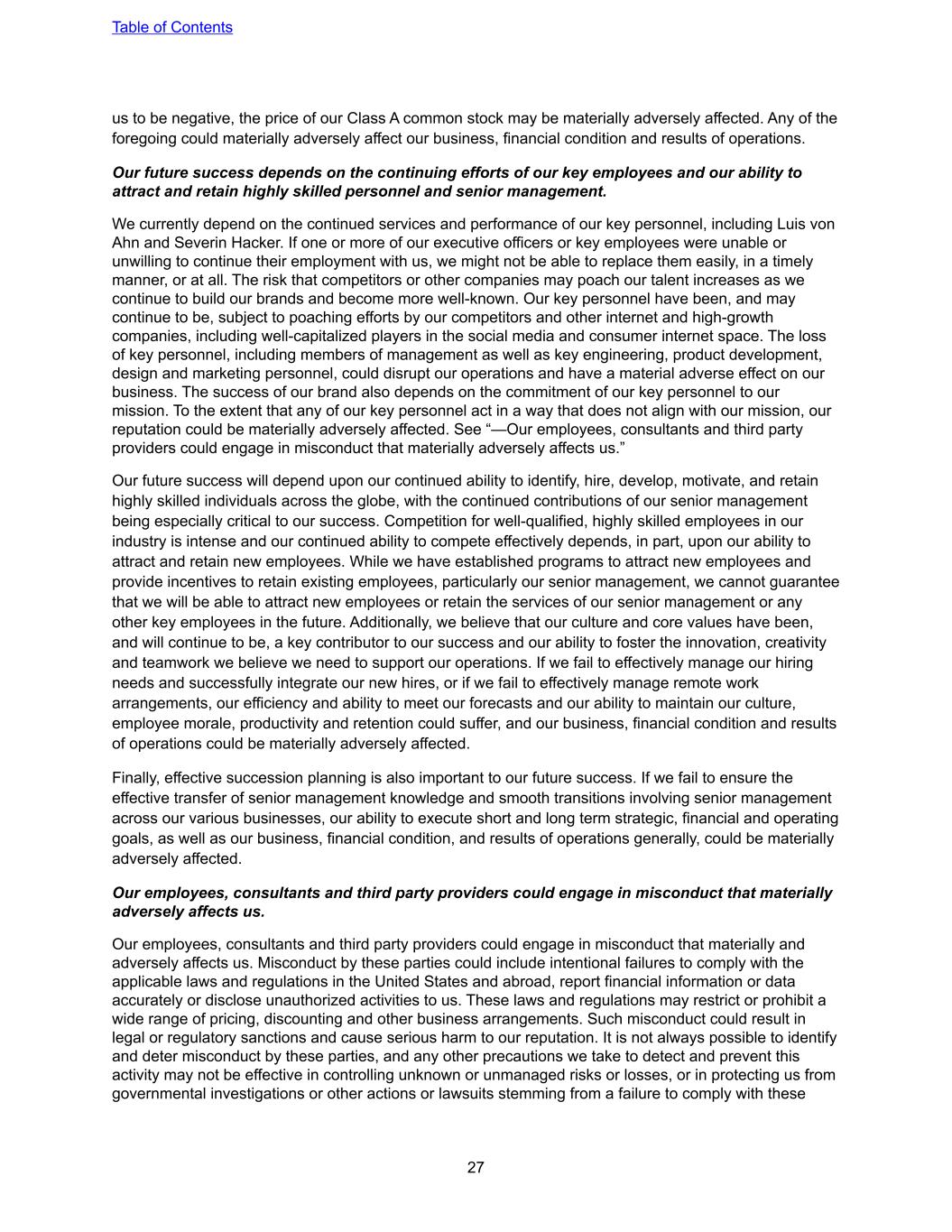
us to be negative, the price of our Class A common stock may be materially adversely affected. Any of the foregoing could materially adversely affect our business, financial condition and results of operations. Our future success depends on the continuing efforts of our key employees and our ability to attract and retain highly skilled personnel and senior management. We currently depend on the continued services and performance of our key personnel, including Luis von Ahn and Severin Hacker. If one or more of our executive officers or key employees were unable or unwilling to continue their employment with us, we might not be able to replace them easily, in a timely manner, or at all. The risk that competitors or other companies may poach our talent increases as we continue to build our brands and become more well-known. Our key personnel have been, and may continue to be, subject to poaching efforts by our competitors and other internet and high-growth companies, including well-capitalized players in the social media and consumer internet space. The loss of key personnel, including members of management as well as key engineering, product development, design and marketing personnel, could disrupt our operations and have a material adverse effect on our business. The success of our brand also depends on the commitment of our key personnel to our mission. To the extent that any of our key personnel act in a way that does not align with our mission, our reputation could be materially adversely affected. See “—Our employees, consultants and third party providers could engage in misconduct that materially adversely affects us.” Our future success will depend upon our continued ability to identify, hire, develop, motivate, and retain highly skilled individuals across the globe, with the continued contributions of our senior management being especially critical to our success. Competition for well-qualified, highly skilled employees in our industry is intense and our continued ability to compete effectively depends, in part, upon our ability to attract and retain new employees. While we have established programs to attract new employees and provide incentives to retain existing employees, particularly our senior management, we cannot guarantee that we will be able to attract new employees or retain the services of our senior management or any other key employees in the future. Additionally, we believe that our culture and core values have been, and will continue to be, a key contributor to our success and our ability to foster the innovation, creativity and teamwork we believe we need to support our operations. If we fail to effectively manage our hiring needs and successfully integrate our new hires, or if we fail to effectively manage remote work arrangements, our efficiency and ability to meet our forecasts and our ability to maintain our culture, employee morale, productivity and retention could suffer, and our business, financial condition and results of operations could be materially adversely affected. Finally, effective succession planning is also important to our future success. If we fail to ensure the effective transfer of senior management knowledge and smooth transitions involving senior management across our various businesses, our ability to execute short and long term strategic, financial and operating goals, as well as our business, financial condition, and results of operations generally, could be materially adversely affected. Our employees, consultants and third party providers could engage in misconduct that materially adversely affects us. Our employees, consultants and third party providers could engage in misconduct that materially and adversely affects us. Misconduct by these parties could include intentional failures to comply with the applicable laws and regulations in the United States and abroad, report financial information or data accurately or disclose unauthorized activities to us. These laws and regulations may restrict or prohibit a wide range of pricing, discounting and other business arrangements. Such misconduct could result in legal or regulatory sanctions and cause serious harm to our reputation. It is not always possible to identify and deter misconduct by these parties, and any other precautions we take to detect and prevent this activity may not be effective in controlling unknown or unmanaged risks or losses, or in protecting us from governmental investigations or other actions or lawsuits stemming from a failure to comply with these Table of Contents 27
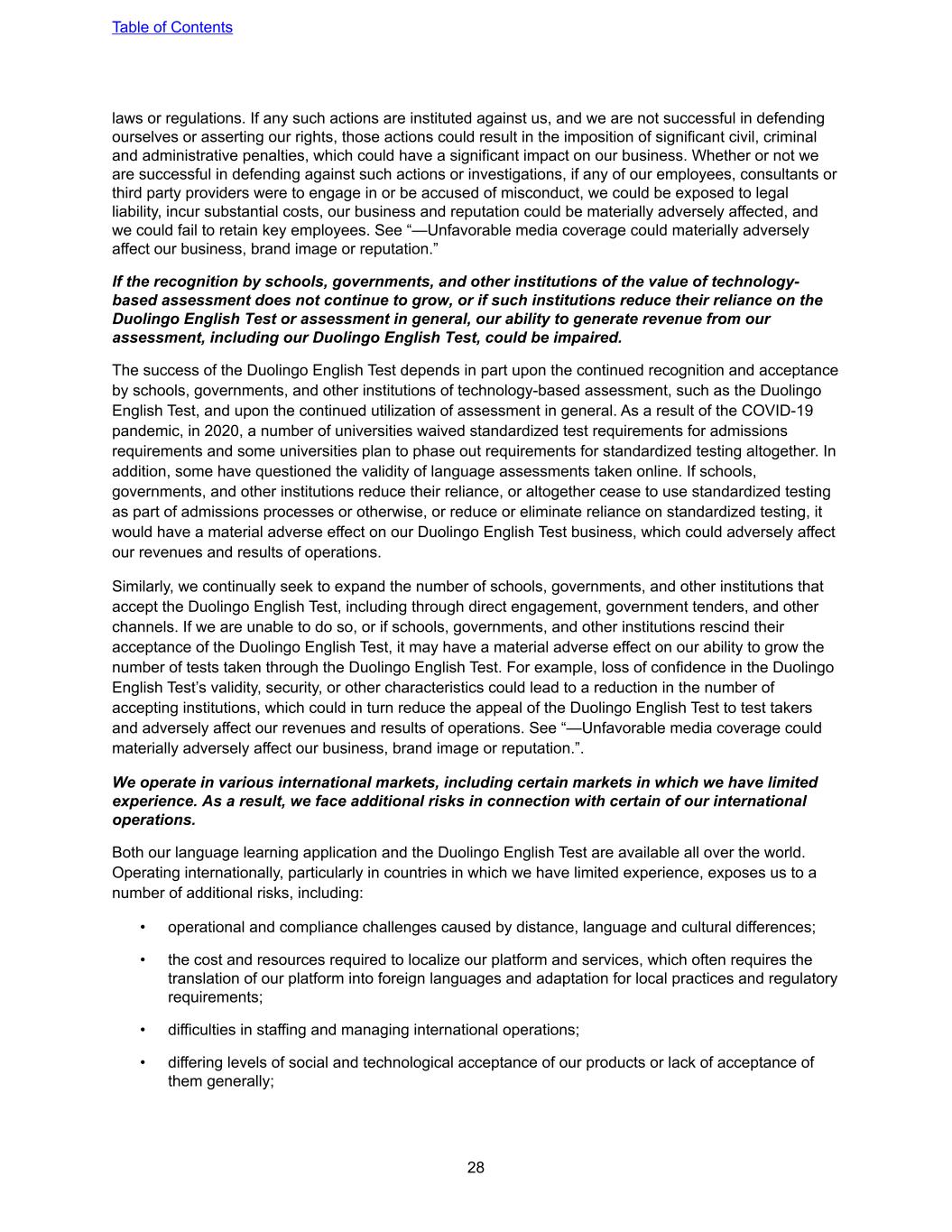
laws or regulations. If any such actions are instituted against us, and we are not successful in defending ourselves or asserting our rights, those actions could result in the imposition of significant civil, criminal and administrative penalties, which could have a significant impact on our business. Whether or not we are successful in defending against such actions or investigations, if any of our employees, consultants or third party providers were to engage in or be accused of misconduct, we could be exposed to legal liability, incur substantial costs, our business and reputation could be materially adversely affected, and we could fail to retain key employees. See “—Unfavorable media coverage could materially adversely affect our business, brand image or reputation.” If the recognition by schools, governments, and other institutions of the value of technology- based assessment does not continue to grow, or if such institutions reduce their reliance on the Duolingo English Test or assessment in general, our ability to generate revenue from our assessment, including our Duolingo English Test, could be impaired. The success of the Duolingo English Test depends in part upon the continued recognition and acceptance by schools, governments, and other institutions of technology-based assessment, such as the Duolingo English Test, and upon the continued utilization of assessment in general. As a result of the COVID-19 pandemic, in 2020, a number of universities waived standardized test requirements for admissions requirements and some universities plan to phase out requirements for standardized testing altogether. In addition, some have questioned the validity of language assessments taken online. If schools, governments, and other institutions reduce their reliance, or altogether cease to use standardized testing as part of admissions processes or otherwise, or reduce or eliminate reliance on standardized testing, it would have a material adverse effect on our Duolingo English Test business, which could adversely affect our revenues and results of operations. Similarly, we continually seek to expand the number of schools, governments, and other institutions that accept the Duolingo English Test, including through direct engagement, government tenders, and other channels. If we are unable to do so, or if schools, governments, and other institutions rescind their acceptance of the Duolingo English Test, it may have a material adverse effect on our ability to grow the number of tests taken through the Duolingo English Test. For example, loss of confidence in the Duolingo English Test’s validity, security, or other characteristics could lead to a reduction in the number of accepting institutions, which could in turn reduce the appeal of the Duolingo English Test to test takers and adversely affect our revenues and results of operations. See “—Unfavorable media coverage could materially adversely affect our business, brand image or reputation.”. We operate in various international markets, including certain markets in which we have limited experience. As a result, we face additional risks in connection with certain of our international operations. Both our language learning application and the Duolingo English Test are available all over the world. Operating internationally, particularly in countries in which we have limited experience, exposes us to a number of additional risks, including: • operational and compliance challenges caused by distance, language and cultural differences; • the cost and resources required to localize our platform and services, which often requires the translation of our platform into foreign languages and adaptation for local practices and regulatory requirements; • difficulties in staffing and managing international operations; • differing levels of social and technological acceptance of our products or lack of acceptance of them generally; Table of Contents 28
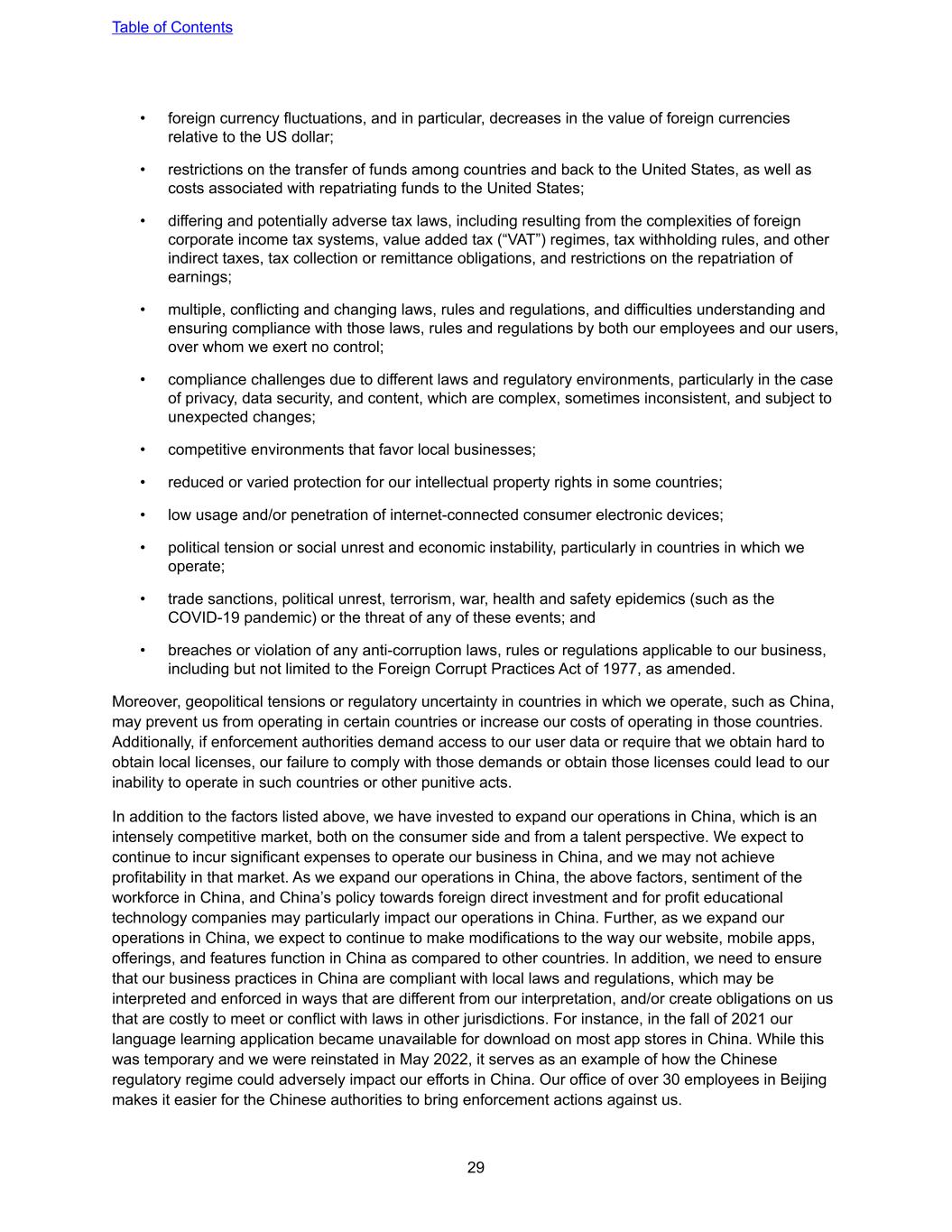
• foreign currency fluctuations, and in particular, decreases in the value of foreign currencies relative to the US dollar; • restrictions on the transfer of funds among countries and back to the United States, as well as costs associated with repatriating funds to the United States; • differing and potentially adverse tax laws, including resulting from the complexities of foreign corporate income tax systems, value added tax (“VAT”) regimes, tax withholding rules, and other indirect taxes, tax collection or remittance obligations, and restrictions on the repatriation of earnings; • multiple, conflicting and changing laws, rules and regulations, and difficulties understanding and ensuring compliance with those laws, rules and regulations by both our employees and our users, over whom we exert no control; • compliance challenges due to different laws and regulatory environments, particularly in the case of privacy, data security, and content, which are complex, sometimes inconsistent, and subject to unexpected changes; • competitive environments that favor local businesses; • reduced or varied protection for our intellectual property rights in some countries; • low usage and/or penetration of internet-connected consumer electronic devices; • political tension or social unrest and economic instability, particularly in countries in which we operate; • trade sanctions, political unrest, terrorism, war, health and safety epidemics (such as the COVID-19 pandemic) or the threat of any of these events; and • breaches or violation of any anti-corruption laws, rules or regulations applicable to our business, including but not limited to the Foreign Corrupt Practices Act of 1977, as amended. Moreover, geopolitical tensions or regulatory uncertainty in countries in which we operate, such as China, may prevent us from operating in certain countries or increase our costs of operating in those countries. Additionally, if enforcement authorities demand access to our user data or require that we obtain hard to obtain local licenses, our failure to comply with those demands or obtain those licenses could lead to our inability to operate in such countries or other punitive acts. In addition to the factors listed above, we have invested to expand our operations in China, which is an intensely competitive market, both on the consumer side and from a talent perspective. We expect to continue to incur significant expenses to operate our business in China, and we may not achieve profitability in that market. As we expand our operations in China, the above factors, sentiment of the workforce in China, and China’s policy towards foreign direct investment and for profit educational technology companies may particularly impact our operations in China. Further, as we expand our operations in China, we expect to continue to make modifications to the way our website, mobile apps, offerings, and features function in China as compared to other countries. In addition, we need to ensure that our business practices in China are compliant with local laws and regulations, which may be interpreted and enforced in ways that are different from our interpretation, and/or create obligations on us that are costly to meet or conflict with laws in other jurisdictions. For instance, in the fall of 2021 our language learning application became unavailable for download on most app stores in China. While this was temporary and we were reinstated in May 2022, it serves as an example of how the Chinese regulatory regime could adversely impact our efforts in China. Our office of over 30 employees in Beijing makes it easier for the Chinese authorities to bring enforcement actions against us. Table of Contents 29
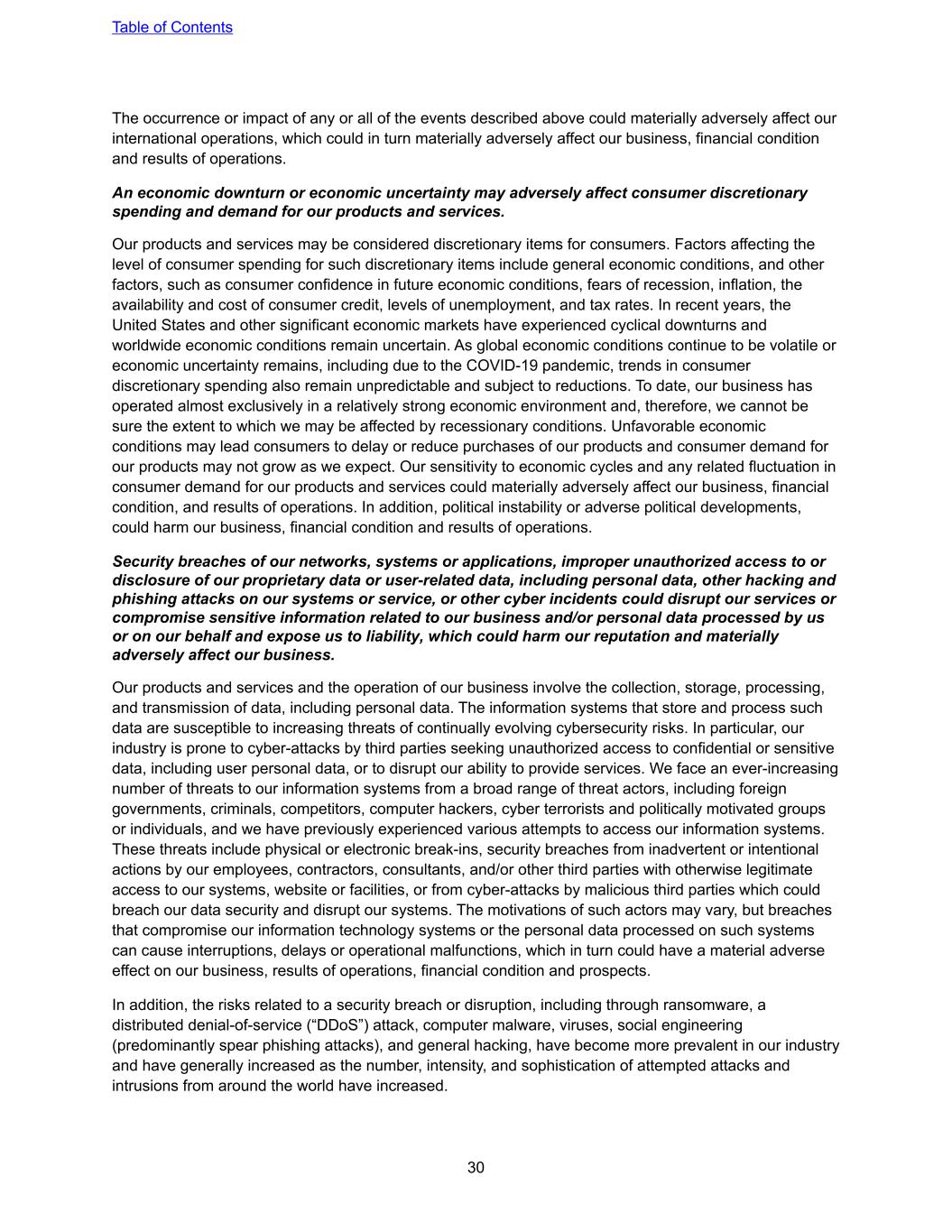
The occurrence or impact of any or all of the events described above could materially adversely affect our international operations, which could in turn materially adversely affect our business, financial condition and results of operations. An economic downturn or economic uncertainty may adversely affect consumer discretionary spending and demand for our products and services. Our products and services may be considered discretionary items for consumers. Factors affecting the level of consumer spending for such discretionary items include general economic conditions, and other factors, such as consumer confidence in future economic conditions, fears of recession, inflation, the availability and cost of consumer credit, levels of unemployment, and tax rates. In recent years, the United States and other significant economic markets have experienced cyclical downturns and worldwide economic conditions remain uncertain. As global economic conditions continue to be volatile or economic uncertainty remains, including due to the COVID-19 pandemic, trends in consumer discretionary spending also remain unpredictable and subject to reductions. To date, our business has operated almost exclusively in a relatively strong economic environment and, therefore, we cannot be sure the extent to which we may be affected by recessionary conditions. Unfavorable economic conditions may lead consumers to delay or reduce purchases of our products and consumer demand for our products may not grow as we expect. Our sensitivity to economic cycles and any related fluctuation in consumer demand for our products and services could materially adversely affect our business, financial condition, and results of operations. In addition, political instability or adverse political developments, could harm our business, financial condition and results of operations. Security breaches of our networks, systems or applications, improper unauthorized access to or disclosure of our proprietary data or user-related data, including personal data, other hacking and phishing attacks on our systems or service, or other cyber incidents could disrupt our services or compromise sensitive information related to our business and/or personal data processed by us or on our behalf and expose us to liability, which could harm our reputation and materially adversely affect our business. Our products and services and the operation of our business involve the collection, storage, processing, and transmission of data, including personal data. The information systems that store and process such data are susceptible to increasing threats of continually evolving cybersecurity risks. In particular, our industry is prone to cyber-attacks by third parties seeking unauthorized access to confidential or sensitive data, including user personal data, or to disrupt our ability to provide services. We face an ever-increasing number of threats to our information systems from a broad range of threat actors, including foreign governments, criminals, competitors, computer hackers, cyber terrorists and politically motivated groups or individuals, and we have previously experienced various attempts to access our information systems. These threats include physical or electronic break-ins, security breaches from inadvertent or intentional actions by our employees, contractors, consultants, and/or other third parties with otherwise legitimate access to our systems, website or facilities, or from cyber-attacks by malicious third parties which could breach our data security and disrupt our systems. The motivations of such actors may vary, but breaches that compromise our information technology systems or the personal data processed on such systems can cause interruptions, delays or operational malfunctions, which in turn could have a material adverse effect on our business, results of operations, financial condition and prospects. In addition, the risks related to a security breach or disruption, including through ransomware, a distributed denial-of-service (“DDoS”) attack, computer malware, viruses, social engineering (predominantly spear phishing attacks), and general hacking, have become more prevalent in our industry and have generally increased as the number, intensity, and sophistication of attempted attacks and intrusions from around the world have increased. Table of Contents 30
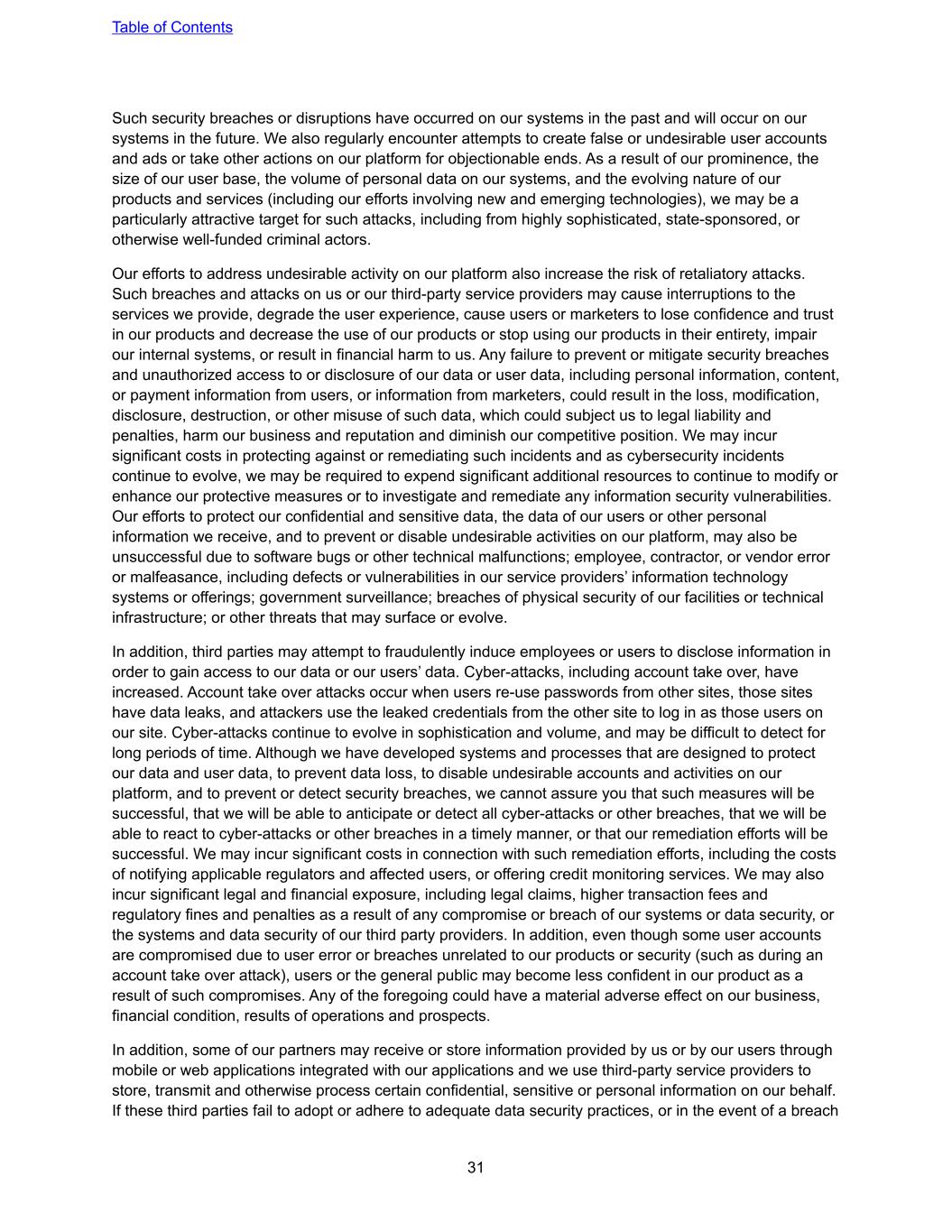
Such security breaches or disruptions have occurred on our systems in the past and will occur on our systems in the future. We also regularly encounter attempts to create false or undesirable user accounts and ads or take other actions on our platform for objectionable ends. As a result of our prominence, the size of our user base, the volume of personal data on our systems, and the evolving nature of our products and services (including our efforts involving new and emerging technologies), we may be a particularly attractive target for such attacks, including from highly sophisticated, state-sponsored, or otherwise well-funded criminal actors. Our efforts to address undesirable activity on our platform also increase the risk of retaliatory attacks. Such breaches and attacks on us or our third-party service providers may cause interruptions to the services we provide, degrade the user experience, cause users or marketers to lose confidence and trust in our products and decrease the use of our products or stop using our products in their entirety, impair our internal systems, or result in financial harm to us. Any failure to prevent or mitigate security breaches and unauthorized access to or disclosure of our data or user data, including personal information, content, or payment information from users, or information from marketers, could result in the loss, modification, disclosure, destruction, or other misuse of such data, which could subject us to legal liability and penalties, harm our business and reputation and diminish our competitive position. We may incur significant costs in protecting against or remediating such incidents and as cybersecurity incidents continue to evolve, we may be required to expend significant additional resources to continue to modify or enhance our protective measures or to investigate and remediate any information security vulnerabilities. Our efforts to protect our confidential and sensitive data, the data of our users or other personal information we receive, and to prevent or disable undesirable activities on our platform, may also be unsuccessful due to software bugs or other technical malfunctions; employee, contractor, or vendor error or malfeasance, including defects or vulnerabilities in our service providers’ information technology systems or offerings; government surveillance; breaches of physical security of our facilities or technical infrastructure; or other threats that may surface or evolve. In addition, third parties may attempt to fraudulently induce employees or users to disclose information in order to gain access to our data or our users’ data. Cyber-attacks, including account take over, have increased. Account take over attacks occur when users re-use passwords from other sites, those sites have data leaks, and attackers use the leaked credentials from the other site to log in as those users on our site. Cyber-attacks continue to evolve in sophistication and volume, and may be difficult to detect for long periods of time. Although we have developed systems and processes that are designed to protect our data and user data, to prevent data loss, to disable undesirable accounts and activities on our platform, and to prevent or detect security breaches, we cannot assure you that such measures will be successful, that we will be able to anticipate or detect all cyber-attacks or other breaches, that we will be able to react to cyber-attacks or other breaches in a timely manner, or that our remediation efforts will be successful. We may incur significant costs in connection with such remediation efforts, including the costs of notifying applicable regulators and affected users, or offering credit monitoring services. We may also incur significant legal and financial exposure, including legal claims, higher transaction fees and regulatory fines and penalties as a result of any compromise or breach of our systems or data security, or the systems and data security of our third party providers. In addition, even though some user accounts are compromised due to user error or breaches unrelated to our products or security (such as during an account take over attack), users or the general public may become less confident in our product as a result of such compromises. Any of the foregoing could have a material adverse effect on our business, financial condition, results of operations and prospects. In addition, some of our partners may receive or store information provided by us or by our users through mobile or web applications integrated with our applications and we use third-party service providers to store, transmit and otherwise process certain confidential, sensitive or personal information on our behalf. If these third parties fail to adopt or adhere to adequate data security practices, or in the event of a breach Table of Contents 31
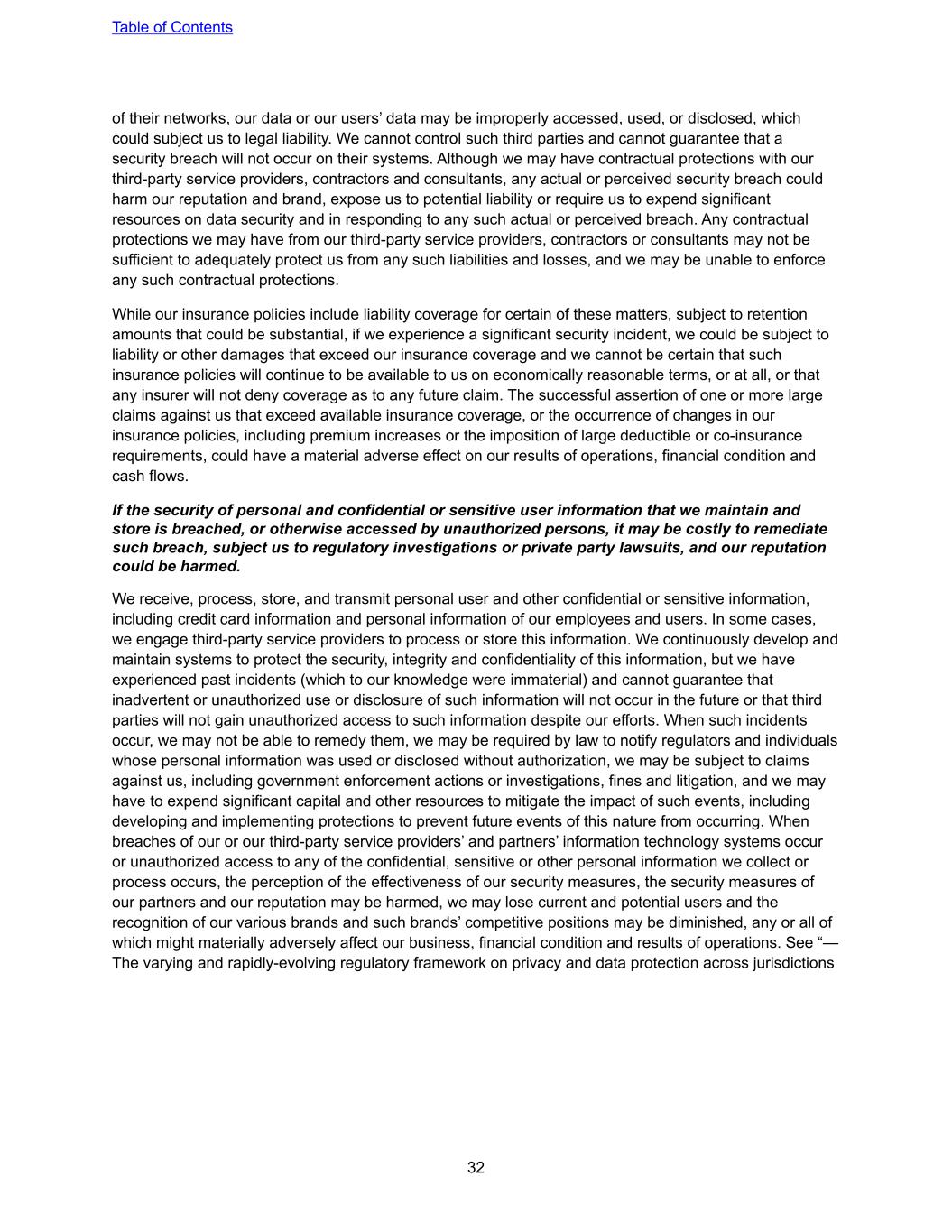
of their networks, our data or our users’ data may be improperly accessed, used, or disclosed, which could subject us to legal liability. We cannot control such third parties and cannot guarantee that a security breach will not occur on their systems. Although we may have contractual protections with our third-party service providers, contractors and consultants, any actual or perceived security breach could harm our reputation and brand, expose us to potential liability or require us to expend significant resources on data security and in responding to any such actual or perceived breach. Any contractual protections we may have from our third-party service providers, contractors or consultants may not be sufficient to adequately protect us from any such liabilities and losses, and we may be unable to enforce any such contractual protections. While our insurance policies include liability coverage for certain of these matters, subject to retention amounts that could be substantial, if we experience a significant security incident, we could be subject to liability or other damages that exceed our insurance coverage and we cannot be certain that such insurance policies will continue to be available to us on economically reasonable terms, or at all, or that any insurer will not deny coverage as to any future claim. The successful assertion of one or more large claims against us that exceed available insurance coverage, or the occurrence of changes in our insurance policies, including premium increases or the imposition of large deductible or co-insurance requirements, could have a material adverse effect on our results of operations, financial condition and cash flows. If the security of personal and confidential or sensitive user information that we maintain and store is breached, or otherwise accessed by unauthorized persons, it may be costly to remediate such breach, subject us to regulatory investigations or private party lawsuits, and our reputation could be harmed. We receive, process, store, and transmit personal user and other confidential or sensitive information, including credit card information and personal information of our employees and users. In some cases, we engage third-party service providers to process or store this information. We continuously develop and maintain systems to protect the security, integrity and confidentiality of this information, but we have experienced past incidents (which to our knowledge were immaterial) and cannot guarantee that inadvertent or unauthorized use or disclosure of such information will not occur in the future or that third parties will not gain unauthorized access to such information despite our efforts. When such incidents occur, we may not be able to remedy them, we may be required by law to notify regulators and individuals whose personal information was used or disclosed without authorization, we may be subject to claims against us, including government enforcement actions or investigations, fines and litigation, and we may have to expend significant capital and other resources to mitigate the impact of such events, including developing and implementing protections to prevent future events of this nature from occurring. When breaches of our or our third-party service providers’ and partners’ information technology systems occur or unauthorized access to any of the confidential, sensitive or other personal information we collect or process occurs, the perception of the effectiveness of our security measures, the security measures of our partners and our reputation may be harmed, we may lose current and potential users and the recognition of our various brands and such brands’ competitive positions may be diminished, any or all of which might materially adversely affect our business, financial condition and results of operations. See “— The varying and rapidly-evolving regulatory framework on privacy and data protection across jurisdictions Table of Contents 32
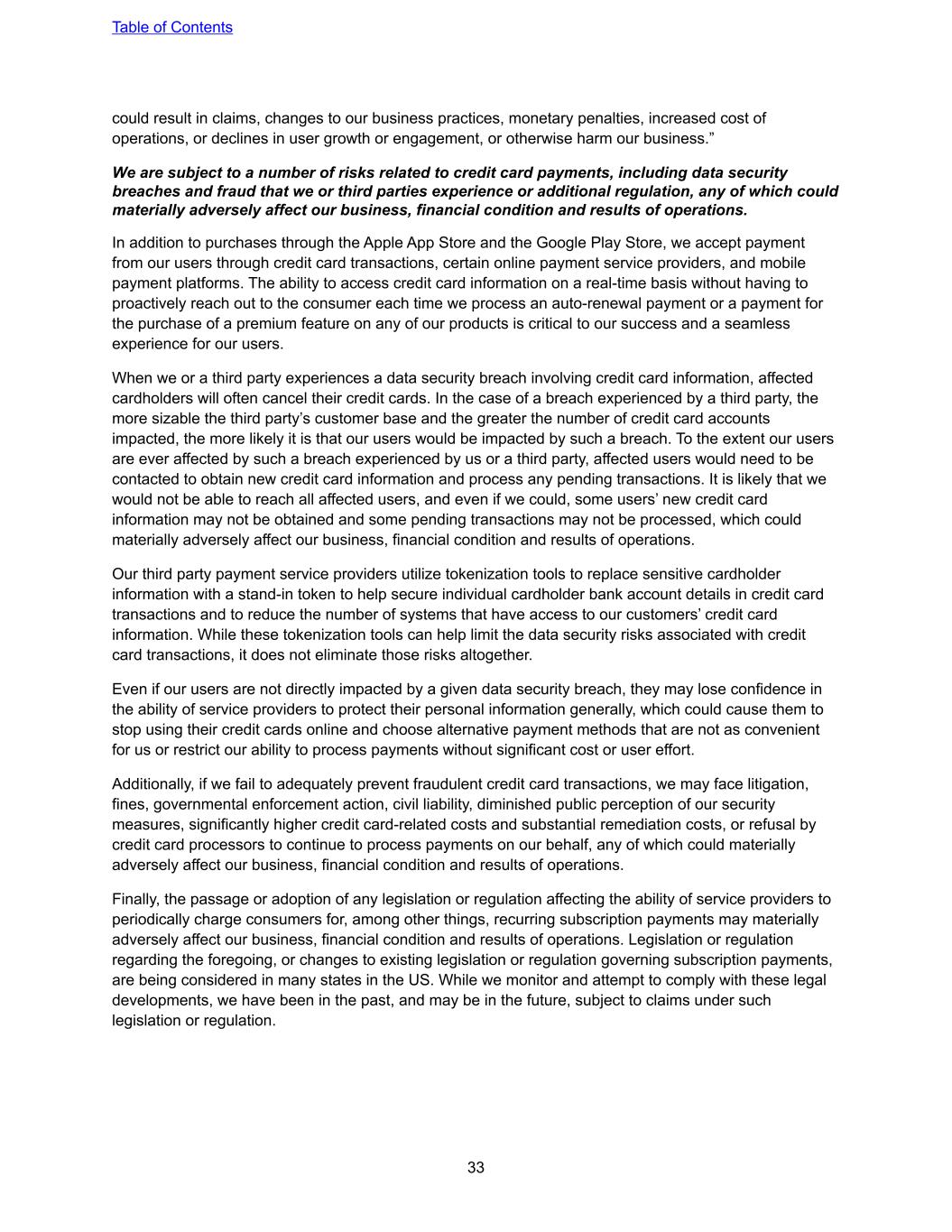
could result in claims, changes to our business practices, monetary penalties, increased cost of operations, or declines in user growth or engagement, or otherwise harm our business.” We are subject to a number of risks related to credit card payments, including data security breaches and fraud that we or third parties experience or additional regulation, any of which could materially adversely affect our business, financial condition and results of operations. In addition to purchases through the Apple App Store and the Google Play Store, we accept payment from our users through credit card transactions, certain online payment service providers, and mobile payment platforms. The ability to access credit card information on a real-time basis without having to proactively reach out to the consumer each time we process an auto-renewal payment or a payment for the purchase of a premium feature on any of our products is critical to our success and a seamless experience for our users. When we or a third party experiences a data security breach involving credit card information, affected cardholders will often cancel their credit cards. In the case of a breach experienced by a third party, the more sizable the third party’s customer base and the greater the number of credit card accounts impacted, the more likely it is that our users would be impacted by such a breach. To the extent our users are ever affected by such a breach experienced by us or a third party, affected users would need to be contacted to obtain new credit card information and process any pending transactions. It is likely that we would not be able to reach all affected users, and even if we could, some users’ new credit card information may not be obtained and some pending transactions may not be processed, which could materially adversely affect our business, financial condition and results of operations. Our third party payment service providers utilize tokenization tools to replace sensitive cardholder information with a stand-in token to help secure individual cardholder bank account details in credit card transactions and to reduce the number of systems that have access to our customers’ credit card information. While these tokenization tools can help limit the data security risks associated with credit card transactions, it does not eliminate those risks altogether. Even if our users are not directly impacted by a given data security breach, they may lose confidence in the ability of service providers to protect their personal information generally, which could cause them to stop using their credit cards online and choose alternative payment methods that are not as convenient for us or restrict our ability to process payments without significant cost or user effort. Additionally, if we fail to adequately prevent fraudulent credit card transactions, we may face litigation, fines, governmental enforcement action, civil liability, diminished public perception of our security measures, significantly higher credit card-related costs and substantial remediation costs, or refusal by credit card processors to continue to process payments on our behalf, any of which could materially adversely affect our business, financial condition and results of operations. Finally, the passage or adoption of any legislation or regulation affecting the ability of service providers to periodically charge consumers for, among other things, recurring subscription payments may materially adversely affect our business, financial condition and results of operations. Legislation or regulation regarding the foregoing, or changes to existing legislation or regulation governing subscription payments, are being considered in many states in the US. While we monitor and attempt to comply with these legal developments, we have been in the past, and may be in the future, subject to claims under such legislation or regulation. Table of Contents 33
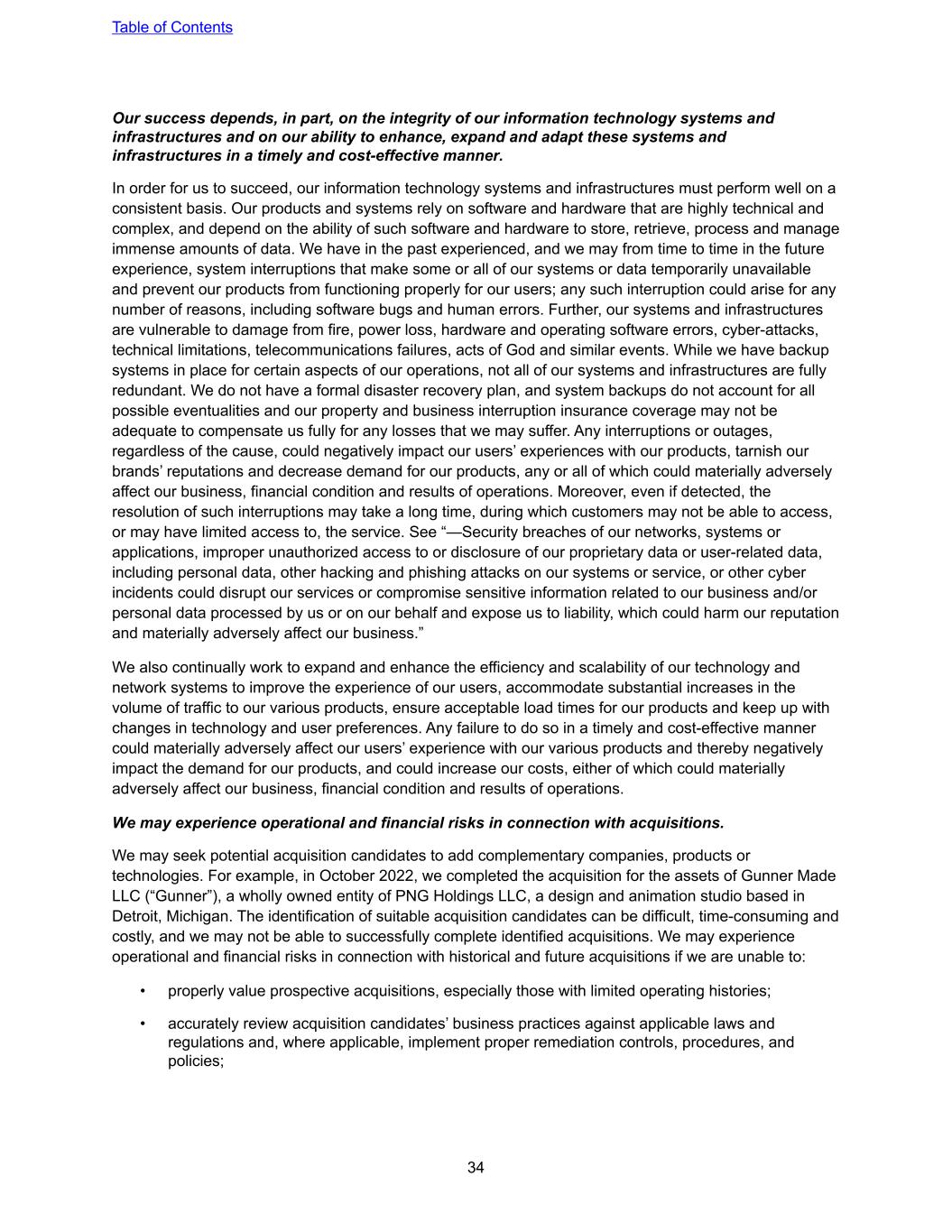
Our success depends, in part, on the integrity of our information technology systems and infrastructures and on our ability to enhance, expand and adapt these systems and infrastructures in a timely and cost-effective manner. In order for us to succeed, our information technology systems and infrastructures must perform well on a consistent basis. Our products and systems rely on software and hardware that are highly technical and complex, and depend on the ability of such software and hardware to store, retrieve, process and manage immense amounts of data. We have in the past experienced, and we may from time to time in the future experience, system interruptions that make some or all of our systems or data temporarily unavailable and prevent our products from functioning properly for our users; any such interruption could arise for any number of reasons, including software bugs and human errors. Further, our systems and infrastructures are vulnerable to damage from fire, power loss, hardware and operating software errors, cyber-attacks, technical limitations, telecommunications failures, acts of God and similar events. While we have backup systems in place for certain aspects of our operations, not all of our systems and infrastructures are fully redundant. We do not have a formal disaster recovery plan, and system backups do not account for all possible eventualities and our property and business interruption insurance coverage may not be adequate to compensate us fully for any losses that we may suffer. Any interruptions or outages, regardless of the cause, could negatively impact our users’ experiences with our products, tarnish our brands’ reputations and decrease demand for our products, any or all of which could materially adversely affect our business, financial condition and results of operations. Moreover, even if detected, the resolution of such interruptions may take a long time, during which customers may not be able to access, or may have limited access to, the service. See “—Security breaches of our networks, systems or applications, improper unauthorized access to or disclosure of our proprietary data or user-related data, including personal data, other hacking and phishing attacks on our systems or service, or other cyber incidents could disrupt our services or compromise sensitive information related to our business and/or personal data processed by us or on our behalf and expose us to liability, which could harm our reputation and materially adversely affect our business.” We also continually work to expand and enhance the efficiency and scalability of our technology and network systems to improve the experience of our users, accommodate substantial increases in the volume of traffic to our various products, ensure acceptable load times for our products and keep up with changes in technology and user preferences. Any failure to do so in a timely and cost-effective manner could materially adversely affect our users’ experience with our various products and thereby negatively impact the demand for our products, and could increase our costs, either of which could materially adversely affect our business, financial condition and results of operations. We may experience operational and financial risks in connection with acquisitions. We may seek potential acquisition candidates to add complementary companies, products or technologies. For example, in October 2022, we completed the acquisition for the assets of Gunner Made LLC (“Gunner”), a wholly owned entity of PNG Holdings LLC, a design and animation studio based in Detroit, Michigan. The identification of suitable acquisition candidates can be difficult, time-consuming and costly, and we may not be able to successfully complete identified acquisitions. We may experience operational and financial risks in connection with historical and future acquisitions if we are unable to: • properly value prospective acquisitions, especially those with limited operating histories; • accurately review acquisition candidates’ business practices against applicable laws and regulations and, where applicable, implement proper remediation controls, procedures, and policies; Table of Contents 34
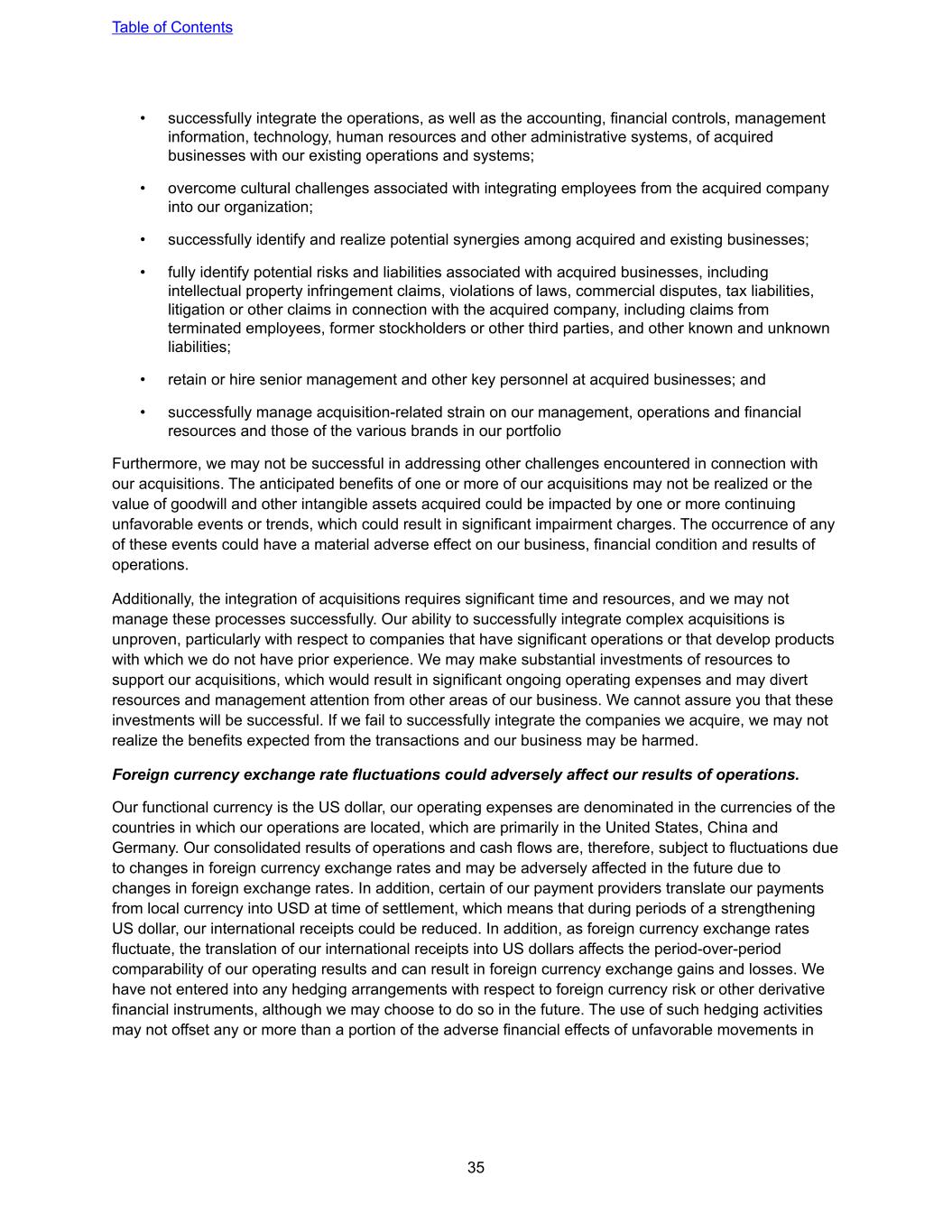
• successfully integrate the operations, as well as the accounting, financial controls, management information, technology, human resources and other administrative systems, of acquired businesses with our existing operations and systems; • overcome cultural challenges associated with integrating employees from the acquired company into our organization; • successfully identify and realize potential synergies among acquired and existing businesses; • fully identify potential risks and liabilities associated with acquired businesses, including intellectual property infringement claims, violations of laws, commercial disputes, tax liabilities, litigation or other claims in connection with the acquired company, including claims from terminated employees, former stockholders or other third parties, and other known and unknown liabilities; • retain or hire senior management and other key personnel at acquired businesses; and • successfully manage acquisition-related strain on our management, operations and financial resources and those of the various brands in our portfolio Furthermore, we may not be successful in addressing other challenges encountered in connection with our acquisitions. The anticipated benefits of one or more of our acquisitions may not be realized or the value of goodwill and other intangible assets acquired could be impacted by one or more continuing unfavorable events or trends, which could result in significant impairment charges. The occurrence of any of these events could have a material adverse effect on our business, financial condition and results of operations. Additionally, the integration of acquisitions requires significant time and resources, and we may not manage these processes successfully. Our ability to successfully integrate complex acquisitions is unproven, particularly with respect to companies that have significant operations or that develop products with which we do not have prior experience. We may make substantial investments of resources to support our acquisitions, which would result in significant ongoing operating expenses and may divert resources and management attention from other areas of our business. We cannot assure you that these investments will be successful. If we fail to successfully integrate the companies we acquire, we may not realize the benefits expected from the transactions and our business may be harmed. Foreign currency exchange rate fluctuations could adversely affect our results of operations. Our functional currency is the US dollar, our operating expenses are denominated in the currencies of the countries in which our operations are located, which are primarily in the United States, China and Germany. Our consolidated results of operations and cash flows are, therefore, subject to fluctuations due to changes in foreign currency exchange rates and may be adversely affected in the future due to changes in foreign exchange rates. In addition, certain of our payment providers translate our payments from local currency into USD at time of settlement, which means that during periods of a strengthening US dollar, our international receipts could be reduced. In addition, as foreign currency exchange rates fluctuate, the translation of our international receipts into US dollars affects the period-over-period comparability of our operating results and can result in foreign currency exchange gains and losses. We have not entered into any hedging arrangements with respect to foreign currency risk or other derivative financial instruments, although we may choose to do so in the future. The use of such hedging activities may not offset any or more than a portion of the adverse financial effects of unfavorable movements in Table of Contents 35
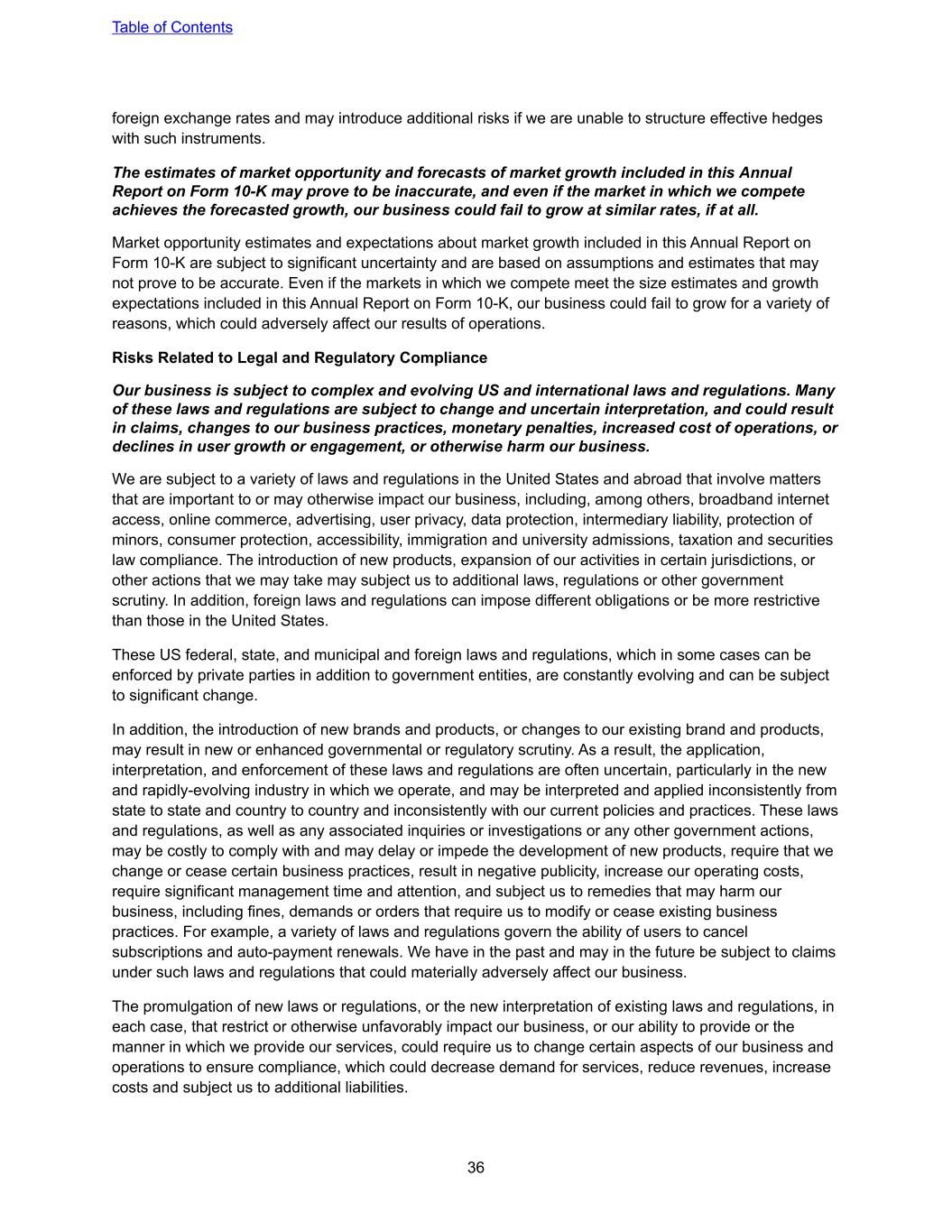
foreign exchange rates and may introduce additional risks if we are unable to structure effective hedges with such instruments. The estimates of market opportunity and forecasts of market growth included in this Annual Report on Form 10-K may prove to be inaccurate, and even if the market in which we compete achieves the forecasted growth, our business could fail to grow at similar rates, if at all. Market opportunity estimates and expectations about market growth included in this Annual Report on Form 10-K are subject to significant uncertainty and are based on assumptions and estimates that may not prove to be accurate. Even if the markets in which we compete meet the size estimates and growth expectations included in this Annual Report on Form 10-K, our business could fail to grow for a variety of reasons, which could adversely affect our results of operations. Risks Related to Legal and Regulatory Compliance Our business is subject to complex and evolving US and international laws and regulations. Many of these laws and regulations are subject to change and uncertain interpretation, and could result in claims, changes to our business practices, monetary penalties, increased cost of operations, or declines in user growth or engagement, or otherwise harm our business. We are subject to a variety of laws and regulations in the United States and abroad that involve matters that are important to or may otherwise impact our business, including, among others, broadband internet access, online commerce, advertising, user privacy, data protection, intermediary liability, protection of minors, consumer protection, accessibility, immigration and university admissions, taxation and securities law compliance. The introduction of new products, expansion of our activities in certain jurisdictions, or other actions that we may take may subject us to additional laws, regulations or other government scrutiny. In addition, foreign laws and regulations can impose different obligations or be more restrictive than those in the United States. These US federal, state, and municipal and foreign laws and regulations, which in some cases can be enforced by private parties in addition to government entities, are constantly evolving and can be subject to significant change. In addition, the introduction of new brands and products, or changes to our existing brand and products, may result in new or enhanced governmental or regulatory scrutiny. As a result, the application, interpretation, and enforcement of these laws and regulations are often uncertain, particularly in the new and rapidly-evolving industry in which we operate, and may be interpreted and applied inconsistently from state to state and country to country and inconsistently with our current policies and practices. These laws and regulations, as well as any associated inquiries or investigations or any other government actions, may be costly to comply with and may delay or impede the development of new products, require that we change or cease certain business practices, result in negative publicity, increase our operating costs, require significant management time and attention, and subject us to remedies that may harm our business, including fines, demands or orders that require us to modify or cease existing business practices. For example, a variety of laws and regulations govern the ability of users to cancel subscriptions and auto-payment renewals. We have in the past and may in the future be subject to claims under such laws and regulations that could materially adversely affect our business. The promulgation of new laws or regulations, or the new interpretation of existing laws and regulations, in each case, that restrict or otherwise unfavorably impact our business, or our ability to provide or the manner in which we provide our services, could require us to change certain aspects of our business and operations to ensure compliance, which could decrease demand for services, reduce revenues, increase costs and subject us to additional liabilities. Table of Contents 36
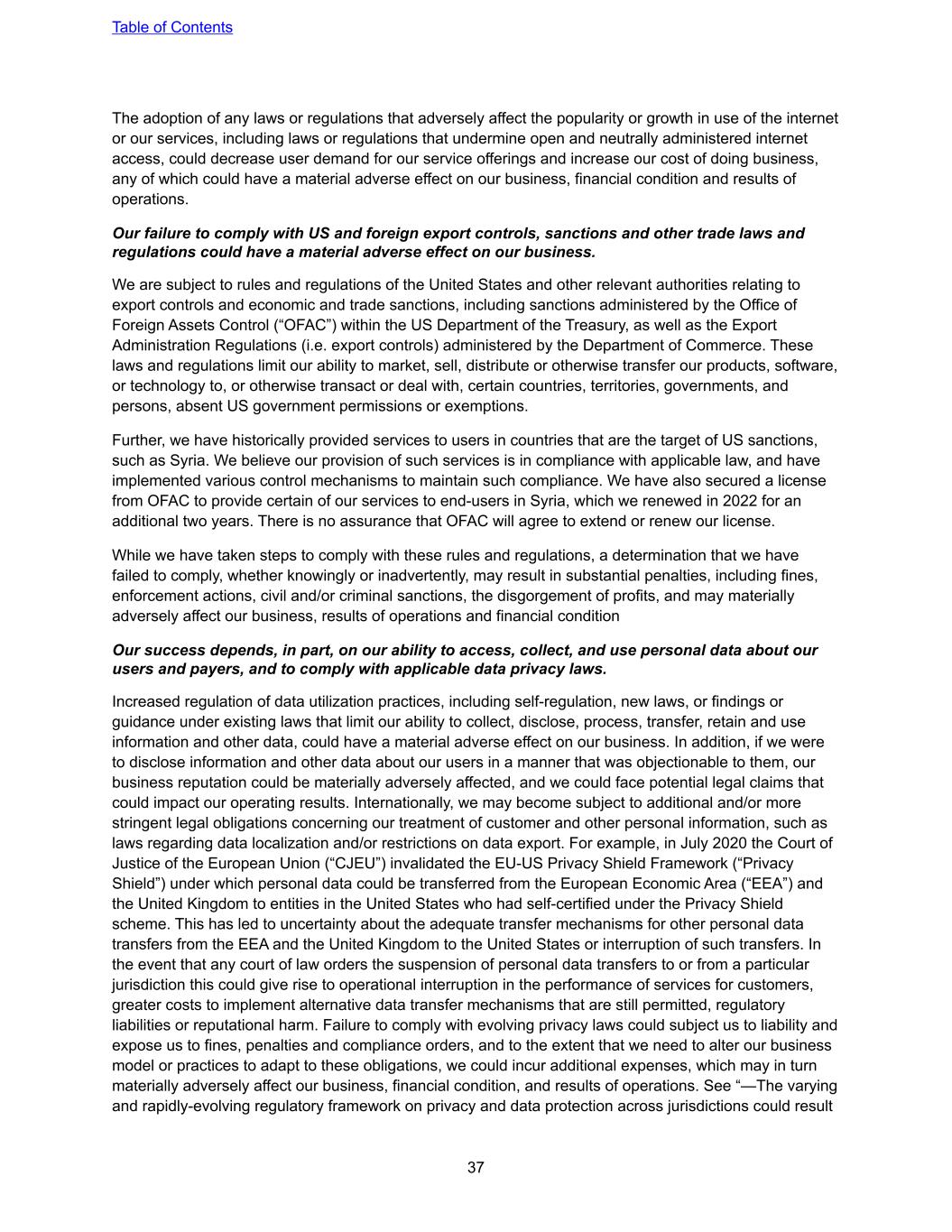
The adoption of any laws or regulations that adversely affect the popularity or growth in use of the internet or our services, including laws or regulations that undermine open and neutrally administered internet access, could decrease user demand for our service offerings and increase our cost of doing business, any of which could have a material adverse effect on our business, financial condition and results of operations. Our failure to comply with US and foreign export controls, sanctions and other trade laws and regulations could have a material adverse effect on our business. We are subject to rules and regulations of the United States and other relevant authorities relating to export controls and economic and trade sanctions, including sanctions administered by the Office of Foreign Assets Control (“OFAC”) within the US Department of the Treasury, as well as the Export Administration Regulations (i.e. export controls) administered by the Department of Commerce. These laws and regulations limit our ability to market, sell, distribute or otherwise transfer our products, software, or technology to, or otherwise transact or deal with, certain countries, territories, governments, and persons, absent US government permissions or exemptions. Further, we have historically provided services to users in countries that are the target of US sanctions, such as Syria. We believe our provision of such services is in compliance with applicable law, and have implemented various control mechanisms to maintain such compliance. We have also secured a license from OFAC to provide certain of our services to end-users in Syria, which we renewed in 2022 for an additional two years. There is no assurance that OFAC will agree to extend or renew our license. While we have taken steps to comply with these rules and regulations, a determination that we have failed to comply, whether knowingly or inadvertently, may result in substantial penalties, including fines, enforcement actions, civil and/or criminal sanctions, the disgorgement of profits, and may materially adversely affect our business, results of operations and financial condition Our success depends, in part, on our ability to access, collect, and use personal data about our users and payers, and to comply with applicable data privacy laws. Increased regulation of data utilization practices, including self-regulation, new laws, or findings or guidance under existing laws that limit our ability to collect, disclose, process, transfer, retain and use information and other data, could have a material adverse effect on our business. In addition, if we were to disclose information and other data about our users in a manner that was objectionable to them, our business reputation could be materially adversely affected, and we could face potential legal claims that could impact our operating results. Internationally, we may become subject to additional and/or more stringent legal obligations concerning our treatment of customer and other personal information, such as laws regarding data localization and/or restrictions on data export. For example, in July 2020 the Court of Justice of the European Union (“CJEU”) invalidated the EU-US Privacy Shield Framework (“Privacy Shield”) under which personal data could be transferred from the European Economic Area (“EEA”) and the United Kingdom to entities in the United States who had self-certified under the Privacy Shield scheme. This has led to uncertainty about the adequate transfer mechanisms for other personal data transfers from the EEA and the United Kingdom to the United States or interruption of such transfers. In the event that any court of law orders the suspension of personal data transfers to or from a particular jurisdiction this could give rise to operational interruption in the performance of services for customers, greater costs to implement alternative data transfer mechanisms that are still permitted, regulatory liabilities or reputational harm. Failure to comply with evolving privacy laws could subject us to liability and expose us to fines, penalties and compliance orders, and to the extent that we need to alter our business model or practices to adapt to these obligations, we could incur additional expenses, which may in turn materially adversely affect our business, financial condition, and results of operations. See “—The varying and rapidly-evolving regulatory framework on privacy and data protection across jurisdictions could result Table of Contents 37
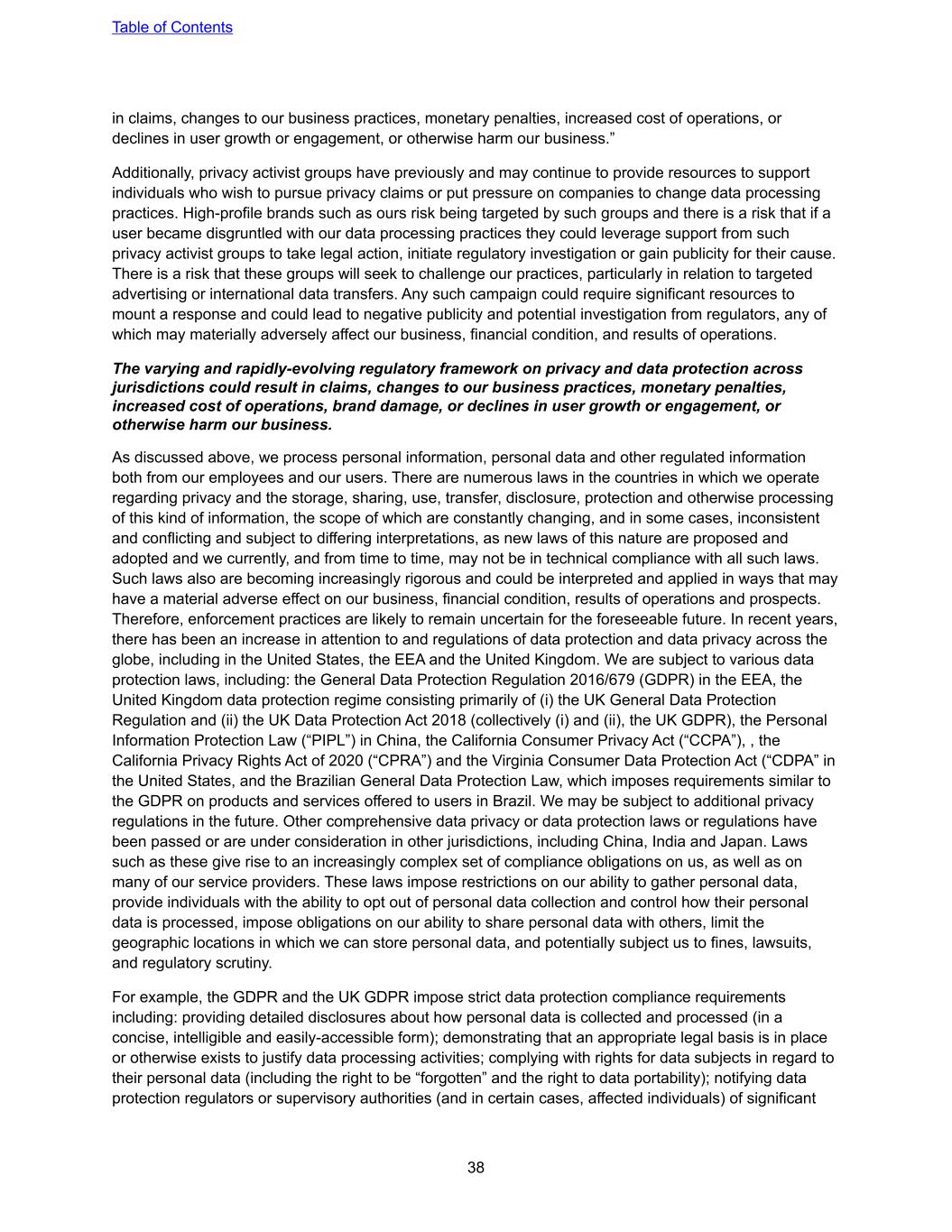
in claims, changes to our business practices, monetary penalties, increased cost of operations, or declines in user growth or engagement, or otherwise harm our business.” Additionally, privacy activist groups have previously and may continue to provide resources to support individuals who wish to pursue privacy claims or put pressure on companies to change data processing practices. High-profile brands such as ours risk being targeted by such groups and there is a risk that if a user became disgruntled with our data processing practices they could leverage support from such privacy activist groups to take legal action, initiate regulatory investigation or gain publicity for their cause. There is a risk that these groups will seek to challenge our practices, particularly in relation to targeted advertising or international data transfers. Any such campaign could require significant resources to mount a response and could lead to negative publicity and potential investigation from regulators, any of which may materially adversely affect our business, financial condition, and results of operations. The varying and rapidly-evolving regulatory framework on privacy and data protection across jurisdictions could result in claims, changes to our business practices, monetary penalties, increased cost of operations, brand damage, or declines in user growth or engagement, or otherwise harm our business. As discussed above, we process personal information, personal data and other regulated information both from our employees and our users. There are numerous laws in the countries in which we operate regarding privacy and the storage, sharing, use, transfer, disclosure, protection and otherwise processing of this kind of information, the scope of which are constantly changing, and in some cases, inconsistent and conflicting and subject to differing interpretations, as new laws of this nature are proposed and adopted and we currently, and from time to time, may not be in technical compliance with all such laws. Such laws also are becoming increasingly rigorous and could be interpreted and applied in ways that may have a material adverse effect on our business, financial condition, results of operations and prospects. Therefore, enforcement practices are likely to remain uncertain for the foreseeable future. In recent years, there has been an increase in attention to and regulations of data protection and data privacy across the globe, including in the United States, the EEA and the United Kingdom. We are subject to various data protection laws, including: the General Data Protection Regulation 2016/679 (GDPR) in the EEA, the United Kingdom data protection regime consisting primarily of (i) the UK General Data Protection Regulation and (ii) the UK Data Protection Act 2018 (collectively (i) and (ii), the UK GDPR), the Personal Information Protection Law (“PIPL”) in China, the California Consumer Privacy Act (“CCPA”), , the California Privacy Rights Act of 2020 (“CPRA”) and the Virginia Consumer Data Protection Act (“CDPA” in the United States, and the Brazilian General Data Protection Law, which imposes requirements similar to the GDPR on products and services offered to users in Brazil. We may be subject to additional privacy regulations in the future. Other comprehensive data privacy or data protection laws or regulations have been passed or are under consideration in other jurisdictions, including China, India and Japan. Laws such as these give rise to an increasingly complex set of compliance obligations on us, as well as on many of our service providers. These laws impose restrictions on our ability to gather personal data, provide individuals with the ability to opt out of personal data collection and control how their personal data is processed, impose obligations on our ability to share personal data with others, limit the geographic locations in which we can store personal data, and potentially subject us to fines, lawsuits, and regulatory scrutiny. For example, the GDPR and the UK GDPR impose strict data protection compliance requirements including: providing detailed disclosures about how personal data is collected and processed (in a concise, intelligible and easily-accessible form); demonstrating that an appropriate legal basis is in place or otherwise exists to justify data processing activities; complying with rights for data subjects in regard to their personal data (including the right to be “forgotten” and the right to data portability); notifying data protection regulators or supervisory authorities (and in certain cases, affected individuals) of significant Table of Contents 38
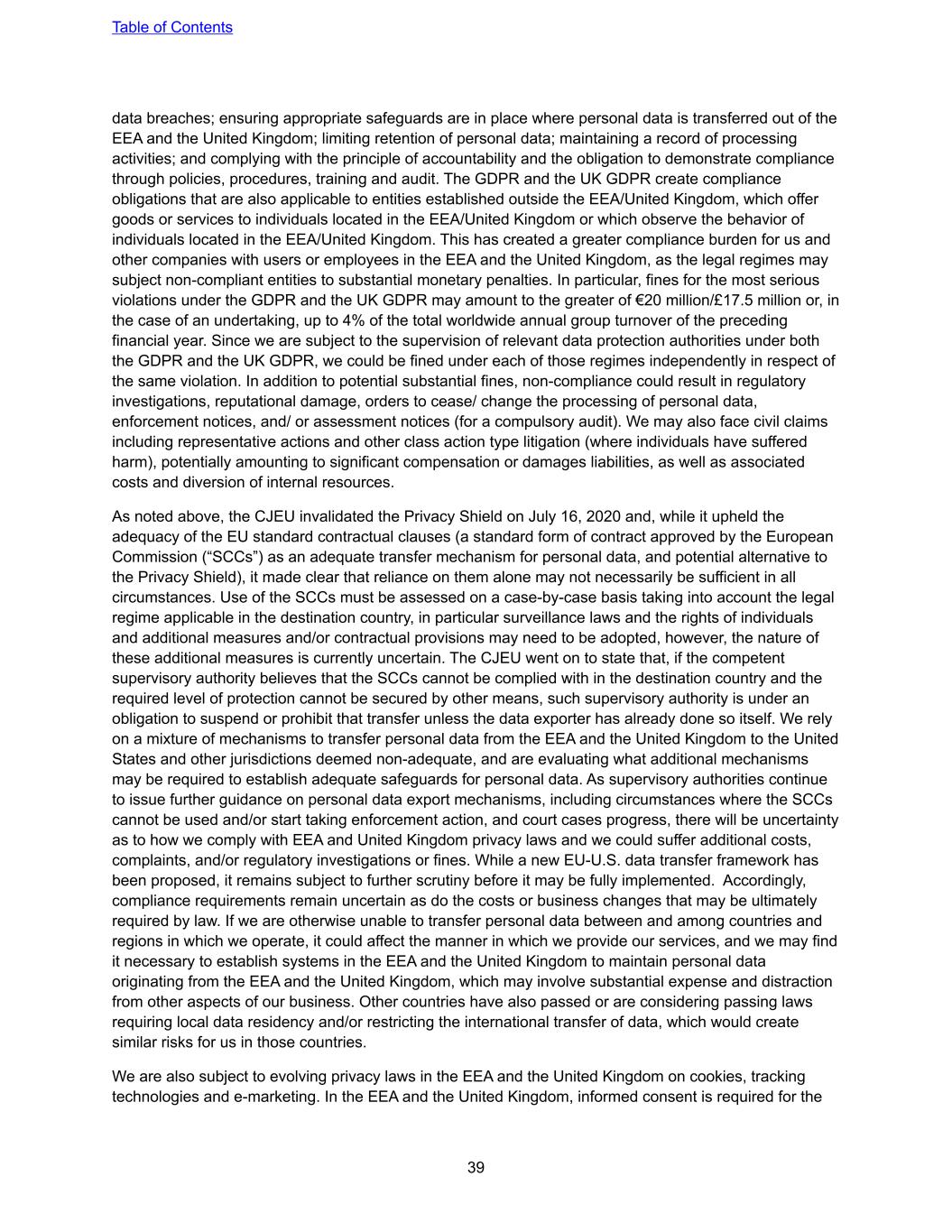
data breaches; ensuring appropriate safeguards are in place where personal data is transferred out of the EEA and the United Kingdom; limiting retention of personal data; maintaining a record of processing activities; and complying with the principle of accountability and the obligation to demonstrate compliance through policies, procedures, training and audit. The GDPR and the UK GDPR create compliance obligations that are also applicable to entities established outside the EEA/United Kingdom, which offer goods or services to individuals located in the EEA/United Kingdom or which observe the behavior of individuals located in the EEA/United Kingdom. This has created a greater compliance burden for us and other companies with users or employees in the EEA and the United Kingdom, as the legal regimes may subject non-compliant entities to substantial monetary penalties. In particular, fines for the most serious violations under the GDPR and the UK GDPR may amount to the greater of €20 million/£17.5 million or, in the case of an undertaking, up to 4% of the total worldwide annual group turnover of the preceding financial year. Since we are subject to the supervision of relevant data protection authorities under both the GDPR and the UK GDPR, we could be fined under each of those regimes independently in respect of the same violation. In addition to potential substantial fines, non-compliance could result in regulatory investigations, reputational damage, orders to cease/ change the processing of personal data, enforcement notices, and/ or assessment notices (for a compulsory audit). We may also face civil claims including representative actions and other class action type litigation (where individuals have suffered harm), potentially amounting to significant compensation or damages liabilities, as well as associated costs and diversion of internal resources. As noted above, the CJEU invalidated the Privacy Shield on July 16, 2020 and, while it upheld the adequacy of the EU standard contractual clauses (a standard form of contract approved by the European Commission (“SCCs”) as an adequate transfer mechanism for personal data, and potential alternative to the Privacy Shield), it made clear that reliance on them alone may not necessarily be sufficient in all circumstances. Use of the SCCs must be assessed on a case-by-case basis taking into account the legal regime applicable in the destination country, in particular surveillance laws and the rights of individuals and additional measures and/or contractual provisions may need to be adopted, however, the nature of these additional measures is currently uncertain. The CJEU went on to state that, if the competent supervisory authority believes that the SCCs cannot be complied with in the destination country and the required level of protection cannot be secured by other means, such supervisory authority is under an obligation to suspend or prohibit that transfer unless the data exporter has already done so itself. We rely on a mixture of mechanisms to transfer personal data from the EEA and the United Kingdom to the United States and other jurisdictions deemed non-adequate, and are evaluating what additional mechanisms may be required to establish adequate safeguards for personal data. As supervisory authorities continue to issue further guidance on personal data export mechanisms, including circumstances where the SCCs cannot be used and/or start taking enforcement action, and court cases progress, there will be uncertainty as to how we comply with EEA and United Kingdom privacy laws and we could suffer additional costs, complaints, and/or regulatory investigations or fines. While a new EU-U.S. data transfer framework has been proposed, it remains subject to further scrutiny before it may be fully implemented. Accordingly, compliance requirements remain uncertain as do the costs or business changes that may be ultimately required by law. If we are otherwise unable to transfer personal data between and among countries and regions in which we operate, it could affect the manner in which we provide our services, and we may find it necessary to establish systems in the EEA and the United Kingdom to maintain personal data originating from the EEA and the United Kingdom, which may involve substantial expense and distraction from other aspects of our business. Other countries have also passed or are considering passing laws requiring local data residency and/or restricting the international transfer of data, which would create similar risks for us in those countries. We are also subject to evolving privacy laws in the EEA and the United Kingdom on cookies, tracking technologies and e-marketing. In the EEA and the United Kingdom, informed consent is required for the Table of Contents 39
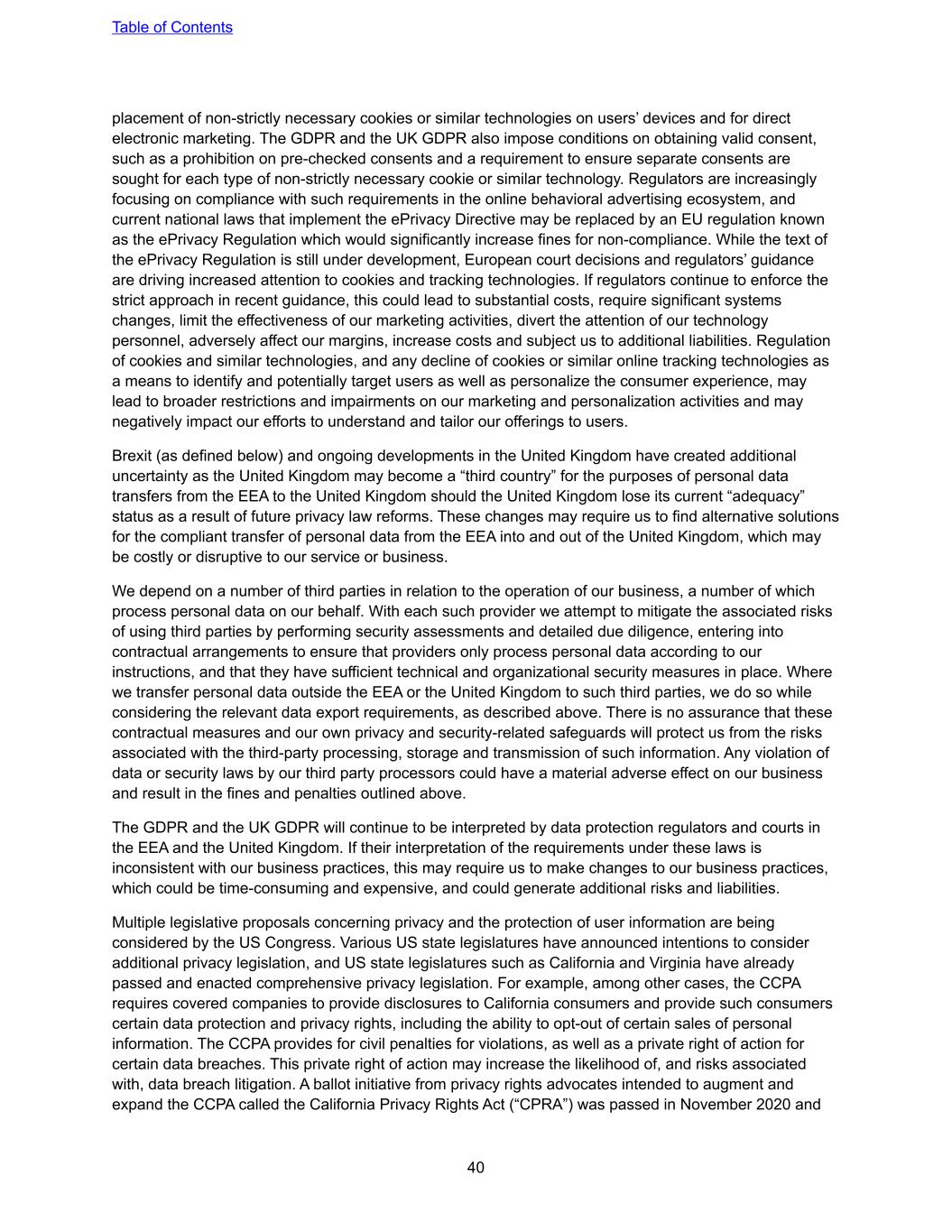
placement of non-strictly necessary cookies or similar technologies on users’ devices and for direct electronic marketing. The GDPR and the UK GDPR also impose conditions on obtaining valid consent, such as a prohibition on pre-checked consents and a requirement to ensure separate consents are sought for each type of non-strictly necessary cookie or similar technology. Regulators are increasingly focusing on compliance with such requirements in the online behavioral advertising ecosystem, and current national laws that implement the ePrivacy Directive may be replaced by an EU regulation known as the ePrivacy Regulation which would significantly increase fines for non-compliance. While the text of the ePrivacy Regulation is still under development, European court decisions and regulators’ guidance are driving increased attention to cookies and tracking technologies. If regulators continue to enforce the strict approach in recent guidance, this could lead to substantial costs, require significant systems changes, limit the effectiveness of our marketing activities, divert the attention of our technology personnel, adversely affect our margins, increase costs and subject us to additional liabilities. Regulation of cookies and similar technologies, and any decline of cookies or similar online tracking technologies as a means to identify and potentially target users as well as personalize the consumer experience, may lead to broader restrictions and impairments on our marketing and personalization activities and may negatively impact our efforts to understand and tailor our offerings to users. Brexit (as defined below) and ongoing developments in the United Kingdom have created additional uncertainty as the United Kingdom may become a “third country” for the purposes of personal data transfers from the EEA to the United Kingdom should the United Kingdom lose its current “adequacy” status as a result of future privacy law reforms. These changes may require us to find alternative solutions for the compliant transfer of personal data from the EEA into and out of the United Kingdom, which may be costly or disruptive to our service or business. We depend on a number of third parties in relation to the operation of our business, a number of which process personal data on our behalf. With each such provider we attempt to mitigate the associated risks of using third parties by performing security assessments and detailed due diligence, entering into contractual arrangements to ensure that providers only process personal data according to our instructions, and that they have sufficient technical and organizational security measures in place. Where we transfer personal data outside the EEA or the United Kingdom to such third parties, we do so while considering the relevant data export requirements, as described above. There is no assurance that these contractual measures and our own privacy and security-related safeguards will protect us from the risks associated with the third-party processing, storage and transmission of such information. Any violation of data or security laws by our third party processors could have a material adverse effect on our business and result in the fines and penalties outlined above. The GDPR and the UK GDPR will continue to be interpreted by data protection regulators and courts in the EEA and the United Kingdom. If their interpretation of the requirements under these laws is inconsistent with our business practices, this may require us to make changes to our business practices, which could be time-consuming and expensive, and could generate additional risks and liabilities. Multiple legislative proposals concerning privacy and the protection of user information are being considered by the US Congress. Various US state legislatures have announced intentions to consider additional privacy legislation, and US state legislatures such as California and Virginia have already passed and enacted comprehensive privacy legislation. For example, among other cases, the CCPA requires covered companies to provide disclosures to California consumers and provide such consumers certain data protection and privacy rights, including the ability to opt-out of certain sales of personal information. The CCPA provides for civil penalties for violations, as well as a private right of action for certain data breaches. This private right of action may increase the likelihood of, and risks associated with, data breach litigation. A ballot initiative from privacy rights advocates intended to augment and expand the CCPA called the California Privacy Rights Act (“CPRA”) was passed in November 2020 and Table of Contents 40
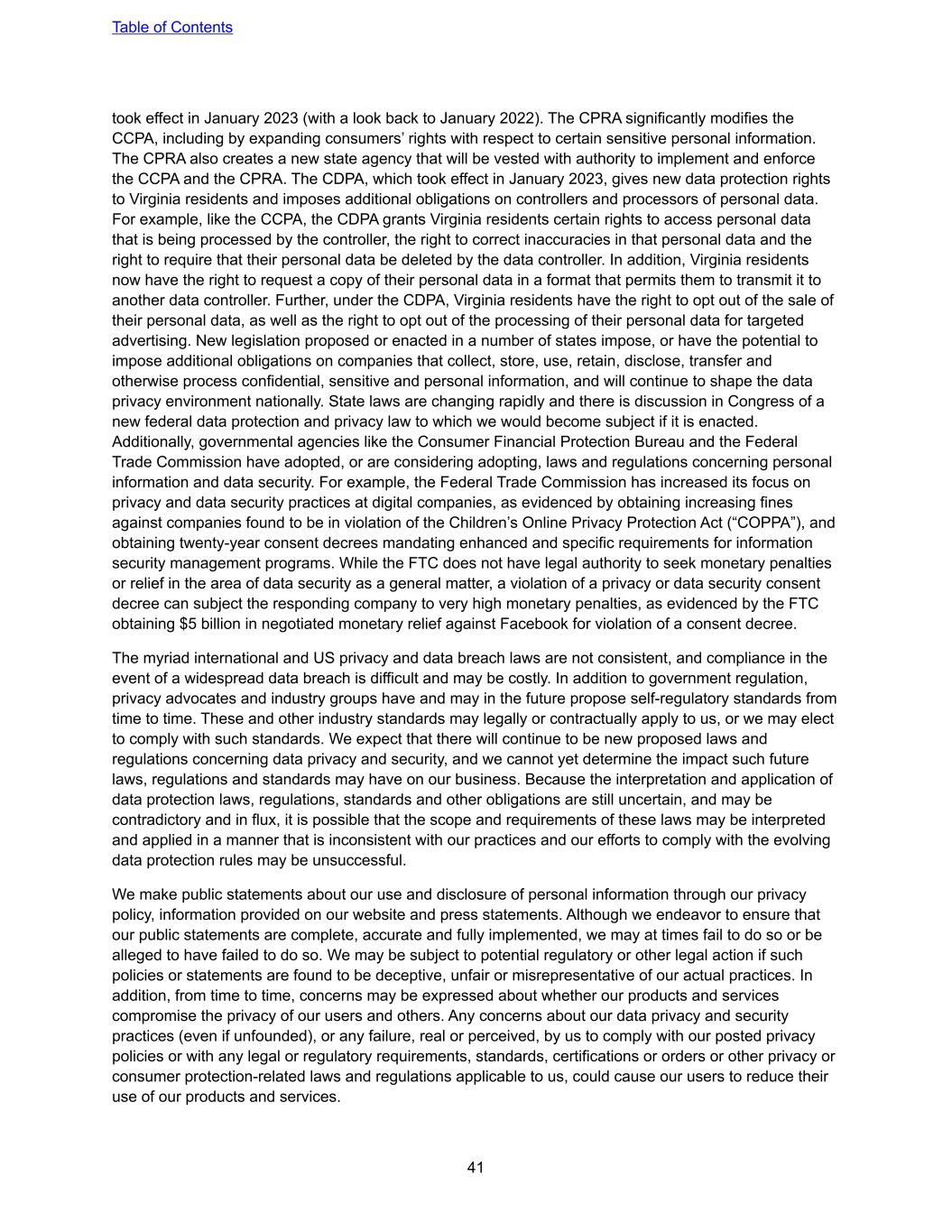
took effect in January 2023 (with a look back to January 2022). The CPRA significantly modifies the CCPA, including by expanding consumers’ rights with respect to certain sensitive personal information. The CPRA also creates a new state agency that will be vested with authority to implement and enforce the CCPA and the CPRA. The CDPA, which took effect in January 2023, gives new data protection rights to Virginia residents and imposes additional obligations on controllers and processors of personal data. For example, like the CCPA, the CDPA grants Virginia residents certain rights to access personal data that is being processed by the controller, the right to correct inaccuracies in that personal data and the right to require that their personal data be deleted by the data controller. In addition, Virginia residents now have the right to request a copy of their personal data in a format that permits them to transmit it to another data controller. Further, under the CDPA, Virginia residents have the right to opt out of the sale of their personal data, as well as the right to opt out of the processing of their personal data for targeted advertising. New legislation proposed or enacted in a number of states impose, or have the potential to impose additional obligations on companies that collect, store, use, retain, disclose, transfer and otherwise process confidential, sensitive and personal information, and will continue to shape the data privacy environment nationally. State laws are changing rapidly and there is discussion in Congress of a new federal data protection and privacy law to which we would become subject if it is enacted. Additionally, governmental agencies like the Consumer Financial Protection Bureau and the Federal Trade Commission have adopted, or are considering adopting, laws and regulations concerning personal information and data security. For example, the Federal Trade Commission has increased its focus on privacy and data security practices at digital companies, as evidenced by obtaining increasing fines against companies found to be in violation of the Children’s Online Privacy Protection Act (“COPPA”), and obtaining twenty-year consent decrees mandating enhanced and specific requirements for information security management programs. While the FTC does not have legal authority to seek monetary penalties or relief in the area of data security as a general matter, a violation of a privacy or data security consent decree can subject the responding company to very high monetary penalties, as evidenced by the FTC obtaining $5 billion in negotiated monetary relief against Facebook for violation of a consent decree. The myriad international and US privacy and data breach laws are not consistent, and compliance in the event of a widespread data breach is difficult and may be costly. In addition to government regulation, privacy advocates and industry groups have and may in the future propose self-regulatory standards from time to time. These and other industry standards may legally or contractually apply to us, or we may elect to comply with such standards. We expect that there will continue to be new proposed laws and regulations concerning data privacy and security, and we cannot yet determine the impact such future laws, regulations and standards may have on our business. Because the interpretation and application of data protection laws, regulations, standards and other obligations are still uncertain, and may be contradictory and in flux, it is possible that the scope and requirements of these laws may be interpreted and applied in a manner that is inconsistent with our practices and our efforts to comply with the evolving data protection rules may be unsuccessful. We make public statements about our use and disclosure of personal information through our privacy policy, information provided on our website and press statements. Although we endeavor to ensure that our public statements are complete, accurate and fully implemented, we may at times fail to do so or be alleged to have failed to do so. We may be subject to potential regulatory or other legal action if such policies or statements are found to be deceptive, unfair or misrepresentative of our actual practices. In addition, from time to time, concerns may be expressed about whether our products and services compromise the privacy of our users and others. Any concerns about our data privacy and security practices (even if unfounded), or any failure, real or perceived, by us to comply with our posted privacy policies or with any legal or regulatory requirements, standards, certifications or orders or other privacy or consumer protection-related laws and regulations applicable to us, could cause our users to reduce their use of our products and services. Table of Contents 41
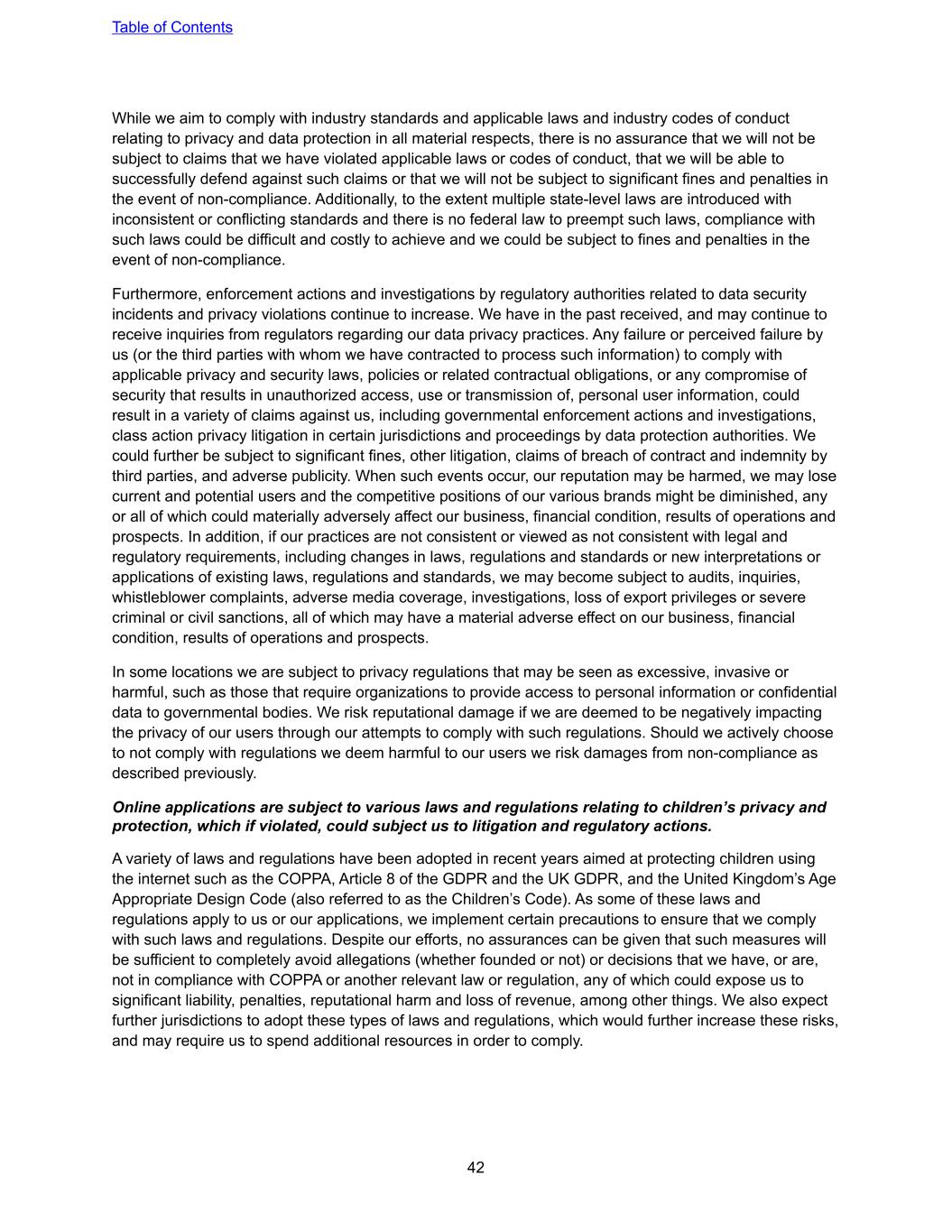
While we aim to comply with industry standards and applicable laws and industry codes of conduct relating to privacy and data protection in all material respects, there is no assurance that we will not be subject to claims that we have violated applicable laws or codes of conduct, that we will be able to successfully defend against such claims or that we will not be subject to significant fines and penalties in the event of non-compliance. Additionally, to the extent multiple state-level laws are introduced with inconsistent or conflicting standards and there is no federal law to preempt such laws, compliance with such laws could be difficult and costly to achieve and we could be subject to fines and penalties in the event of non-compliance. Furthermore, enforcement actions and investigations by regulatory authorities related to data security incidents and privacy violations continue to increase. We have in the past received, and may continue to receive inquiries from regulators regarding our data privacy practices. Any failure or perceived failure by us (or the third parties with whom we have contracted to process such information) to comply with applicable privacy and security laws, policies or related contractual obligations, or any compromise of security that results in unauthorized access, use or transmission of, personal user information, could result in a variety of claims against us, including governmental enforcement actions and investigations, class action privacy litigation in certain jurisdictions and proceedings by data protection authorities. We could further be subject to significant fines, other litigation, claims of breach of contract and indemnity by third parties, and adverse publicity. When such events occur, our reputation may be harmed, we may lose current and potential users and the competitive positions of our various brands might be diminished, any or all of which could materially adversely affect our business, financial condition, results of operations and prospects. In addition, if our practices are not consistent or viewed as not consistent with legal and regulatory requirements, including changes in laws, regulations and standards or new interpretations or applications of existing laws, regulations and standards, we may become subject to audits, inquiries, whistleblower complaints, adverse media coverage, investigations, loss of export privileges or severe criminal or civil sanctions, all of which may have a material adverse effect on our business, financial condition, results of operations and prospects. In some locations we are subject to privacy regulations that may be seen as excessive, invasive or harmful, such as those that require organizations to provide access to personal information or confidential data to governmental bodies. We risk reputational damage if we are deemed to be negatively impacting the privacy of our users through our attempts to comply with such regulations. Should we actively choose to not comply with regulations we deem harmful to our users we risk damages from non-compliance as described previously. Online applications are subject to various laws and regulations relating to children’s privacy and protection, which if violated, could subject us to litigation and regulatory actions. A variety of laws and regulations have been adopted in recent years aimed at protecting children using the internet such as the COPPA, Article 8 of the GDPR and the UK GDPR, and the United Kingdom’s Age Appropriate Design Code (also referred to as the Children’s Code). As some of these laws and regulations apply to us or our applications, we implement certain precautions to ensure that we comply with such laws and regulations. Despite our efforts, no assurances can be given that such measures will be sufficient to completely avoid allegations (whether founded or not) or decisions that we have, or are, not in compliance with COPPA or another relevant law or regulation, any of which could expose us to significant liability, penalties, reputational harm and loss of revenue, among other things. We also expect further jurisdictions to adopt these types of laws and regulations, which would further increase these risks, and may require us to spend additional resources in order to comply. Table of Contents 42
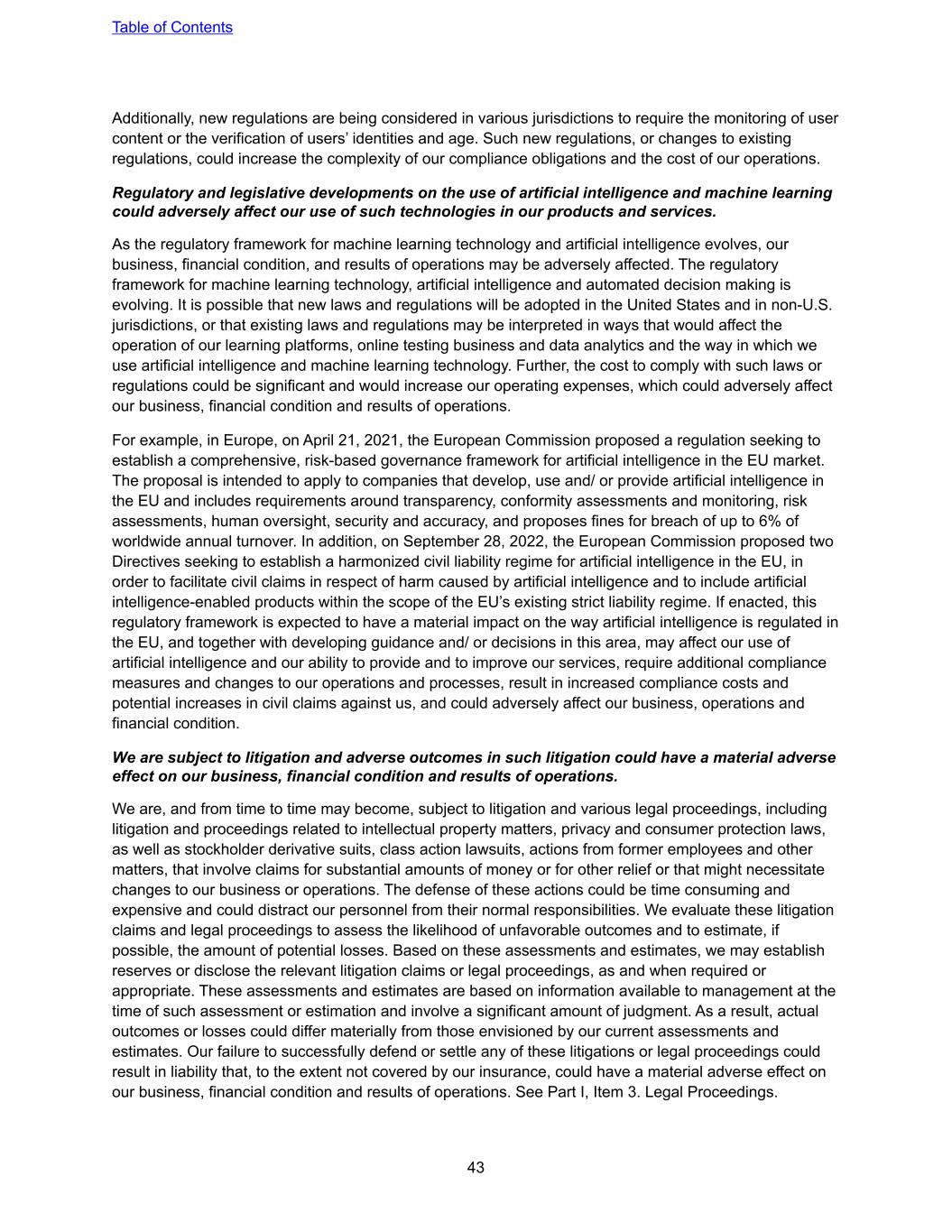
Additionally, new regulations are being considered in various jurisdictions to require the monitoring of user content or the verification of users’ identities and age. Such new regulations, or changes to existing regulations, could increase the complexity of our compliance obligations and the cost of our operations. Regulatory and legislative developments on the use of artificial intelligence and machine learning could adversely affect our use of such technologies in our products and services. As the regulatory framework for machine learning technology and artificial intelligence evolves, our business, financial condition, and results of operations may be adversely affected. The regulatory framework for machine learning technology, artificial intelligence and automated decision making is evolving. It is possible that new laws and regulations will be adopted in the United States and in non-U.S. jurisdictions, or that existing laws and regulations may be interpreted in ways that would affect the operation of our learning platforms, online testing business and data analytics and the way in which we use artificial intelligence and machine learning technology. Further, the cost to comply with such laws or regulations could be significant and would increase our operating expenses, which could adversely affect our business, financial condition and results of operations. For example, in Europe, on April 21, 2021, the European Commission proposed a regulation seeking to establish a comprehensive, risk-based governance framework for artificial intelligence in the EU market. The proposal is intended to apply to companies that develop, use and/ or provide artificial intelligence in the EU and includes requirements around transparency, conformity assessments and monitoring, risk assessments, human oversight, security and accuracy, and proposes fines for breach of up to 6% of worldwide annual turnover. In addition, on September 28, 2022, the European Commission proposed two Directives seeking to establish a harmonized civil liability regime for artificial intelligence in the EU, in order to facilitate civil claims in respect of harm caused by artificial intelligence and to include artificial intelligence-enabled products within the scope of the EU’s existing strict liability regime. If enacted, this regulatory framework is expected to have a material impact on the way artificial intelligence is regulated in the EU, and together with developing guidance and/ or decisions in this area, may affect our use of artificial intelligence and our ability to provide and to improve our services, require additional compliance measures and changes to our operations and processes, result in increased compliance costs and potential increases in civil claims against us, and could adversely affect our business, operations and financial condition. We are subject to litigation and adverse outcomes in such litigation could have a material adverse effect on our business, financial condition and results of operations. We are, and from time to time may become, subject to litigation and various legal proceedings, including litigation and proceedings related to intellectual property matters, privacy and consumer protection laws, as well as stockholder derivative suits, class action lawsuits, actions from former employees and other matters, that involve claims for substantial amounts of money or for other relief or that might necessitate changes to our business or operations. The defense of these actions could be time consuming and expensive and could distract our personnel from their normal responsibilities. We evaluate these litigation claims and legal proceedings to assess the likelihood of unfavorable outcomes and to estimate, if possible, the amount of potential losses. Based on these assessments and estimates, we may establish reserves or disclose the relevant litigation claims or legal proceedings, as and when required or appropriate. These assessments and estimates are based on information available to management at the time of such assessment or estimation and involve a significant amount of judgment. As a result, actual outcomes or losses could differ materially from those envisioned by our current assessments and estimates. Our failure to successfully defend or settle any of these litigations or legal proceedings could result in liability that, to the extent not covered by our insurance, could have a material adverse effect on our business, financial condition and results of operations. See Part I, Item 3. Legal Proceedings. Table of Contents 43
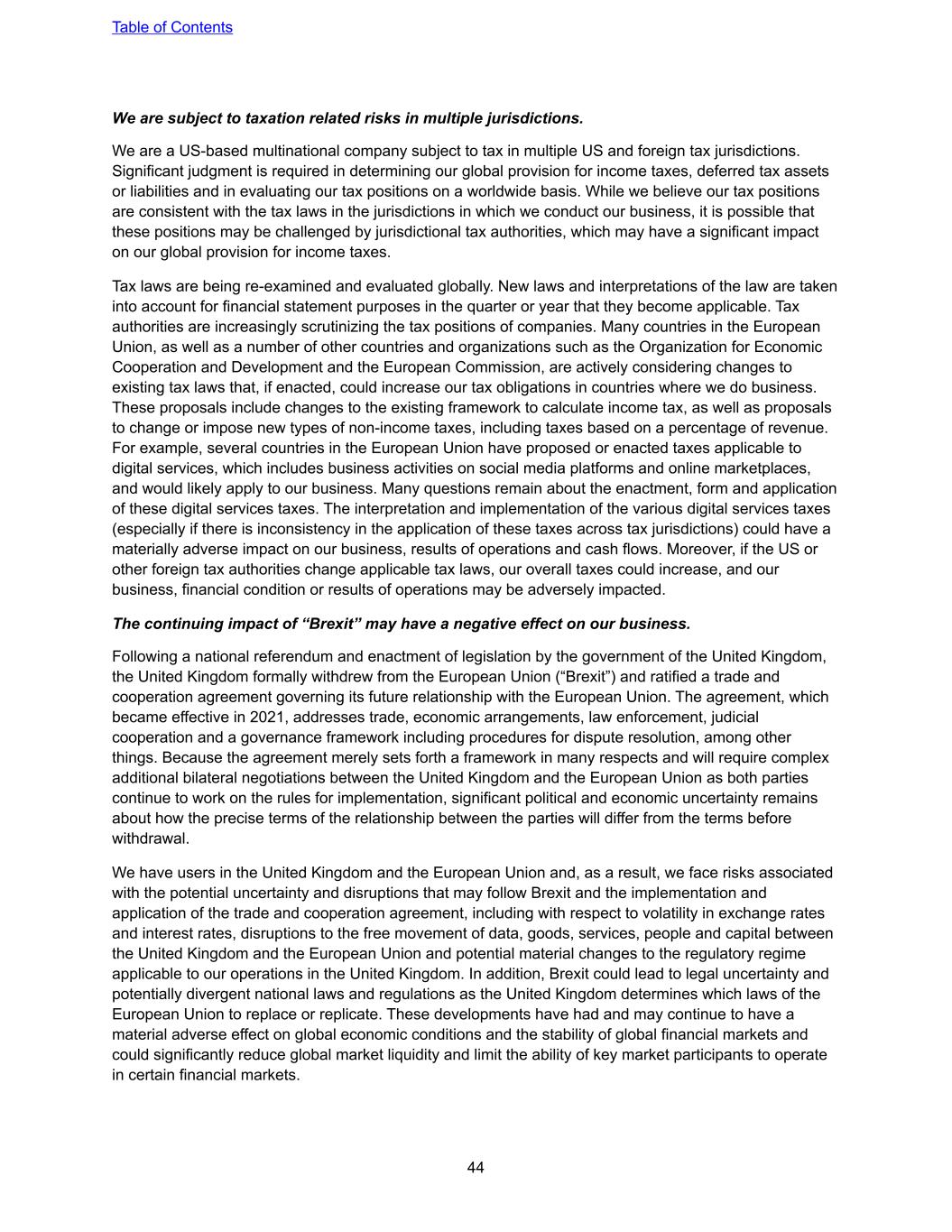
We are subject to taxation related risks in multiple jurisdictions. We are a US-based multinational company subject to tax in multiple US and foreign tax jurisdictions. Significant judgment is required in determining our global provision for income taxes, deferred tax assets or liabilities and in evaluating our tax positions on a worldwide basis. While we believe our tax positions are consistent with the tax laws in the jurisdictions in which we conduct our business, it is possible that these positions may be challenged by jurisdictional tax authorities, which may have a significant impact on our global provision for income taxes. Tax laws are being re-examined and evaluated globally. New laws and interpretations of the law are taken into account for financial statement purposes in the quarter or year that they become applicable. Tax authorities are increasingly scrutinizing the tax positions of companies. Many countries in the European Union, as well as a number of other countries and organizations such as the Organization for Economic Cooperation and Development and the European Commission, are actively considering changes to existing tax laws that, if enacted, could increase our tax obligations in countries where we do business. These proposals include changes to the existing framework to calculate income tax, as well as proposals to change or impose new types of non-income taxes, including taxes based on a percentage of revenue. For example, several countries in the European Union have proposed or enacted taxes applicable to digital services, which includes business activities on social media platforms and online marketplaces, and would likely apply to our business. Many questions remain about the enactment, form and application of these digital services taxes. The interpretation and implementation of the various digital services taxes (especially if there is inconsistency in the application of these taxes across tax jurisdictions) could have a materially adverse impact on our business, results of operations and cash flows. Moreover, if the US or other foreign tax authorities change applicable tax laws, our overall taxes could increase, and our business, financial condition or results of operations may be adversely impacted. The continuing impact of “Brexit” may have a negative effect on our business. Following a national referendum and enactment of legislation by the government of the United Kingdom, the United Kingdom formally withdrew from the European Union (“Brexit”) and ratified a trade and cooperation agreement governing its future relationship with the European Union. The agreement, which became effective in 2021, addresses trade, economic arrangements, law enforcement, judicial cooperation and a governance framework including procedures for dispute resolution, among other things. Because the agreement merely sets forth a framework in many respects and will require complex additional bilateral negotiations between the United Kingdom and the European Union as both parties continue to work on the rules for implementation, significant political and economic uncertainty remains about how the precise terms of the relationship between the parties will differ from the terms before withdrawal. We have users in the United Kingdom and the European Union and, as a result, we face risks associated with the potential uncertainty and disruptions that may follow Brexit and the implementation and application of the trade and cooperation agreement, including with respect to volatility in exchange rates and interest rates, disruptions to the free movement of data, goods, services, people and capital between the United Kingdom and the European Union and potential material changes to the regulatory regime applicable to our operations in the United Kingdom. In addition, Brexit could lead to legal uncertainty and potentially divergent national laws and regulations as the United Kingdom determines which laws of the European Union to replace or replicate. These developments have had and may continue to have a material adverse effect on global economic conditions and the stability of global financial markets and could significantly reduce global market liquidity and limit the ability of key market participants to operate in certain financial markets. Table of Contents 44
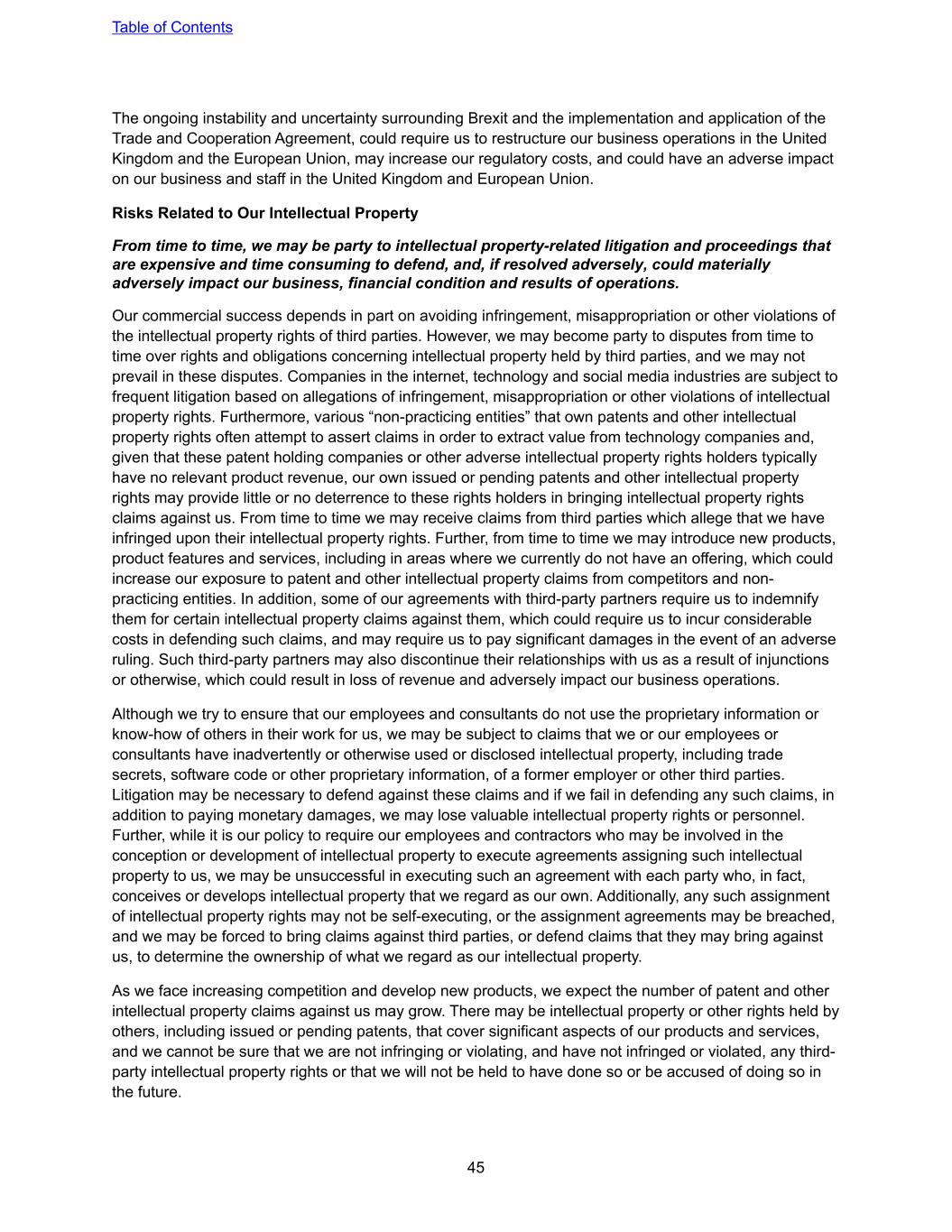
The ongoing instability and uncertainty surrounding Brexit and the implementation and application of the Trade and Cooperation Agreement, could require us to restructure our business operations in the United Kingdom and the European Union, may increase our regulatory costs, and could have an adverse impact on our business and staff in the United Kingdom and European Union. Risks Related to Our Intellectual Property From time to time, we may be party to intellectual property-related litigation and proceedings that are expensive and time consuming to defend, and, if resolved adversely, could materially adversely impact our business, financial condition and results of operations. Our commercial success depends in part on avoiding infringement, misappropriation or other violations of the intellectual property rights of third parties. However, we may become party to disputes from time to time over rights and obligations concerning intellectual property held by third parties, and we may not prevail in these disputes. Companies in the internet, technology and social media industries are subject to frequent litigation based on allegations of infringement, misappropriation or other violations of intellectual property rights. Furthermore, various “non-practicing entities” that own patents and other intellectual property rights often attempt to assert claims in order to extract value from technology companies and, given that these patent holding companies or other adverse intellectual property rights holders typically have no relevant product revenue, our own issued or pending patents and other intellectual property rights may provide little or no deterrence to these rights holders in bringing intellectual property rights claims against us. From time to time we may receive claims from third parties which allege that we have infringed upon their intellectual property rights. Further, from time to time we may introduce new products, product features and services, including in areas where we currently do not have an offering, which could increase our exposure to patent and other intellectual property claims from competitors and non- practicing entities. In addition, some of our agreements with third-party partners require us to indemnify them for certain intellectual property claims against them, which could require us to incur considerable costs in defending such claims, and may require us to pay significant damages in the event of an adverse ruling. Such third-party partners may also discontinue their relationships with us as a result of injunctions or otherwise, which could result in loss of revenue and adversely impact our business operations. Although we try to ensure that our employees and consultants do not use the proprietary information or know-how of others in their work for us, we may be subject to claims that we or our employees or consultants have inadvertently or otherwise used or disclosed intellectual property, including trade secrets, software code or other proprietary information, of a former employer or other third parties. Litigation may be necessary to defend against these claims and if we fail in defending any such claims, in addition to paying monetary damages, we may lose valuable intellectual property rights or personnel. Further, while it is our policy to require our employees and contractors who may be involved in the conception or development of intellectual property to execute agreements assigning such intellectual property to us, we may be unsuccessful in executing such an agreement with each party who, in fact, conceives or develops intellectual property that we regard as our own. Additionally, any such assignment of intellectual property rights may not be self-executing, or the assignment agreements may be breached, and we may be forced to bring claims against third parties, or defend claims that they may bring against us, to determine the ownership of what we regard as our intellectual property. As we face increasing competition and develop new products, we expect the number of patent and other intellectual property claims against us may grow. There may be intellectual property or other rights held by others, including issued or pending patents, that cover significant aspects of our products and services, and we cannot be sure that we are not infringing or violating, and have not infringed or violated, any third- party intellectual property rights or that we will not be held to have done so or be accused of doing so in the future. Table of Contents 45
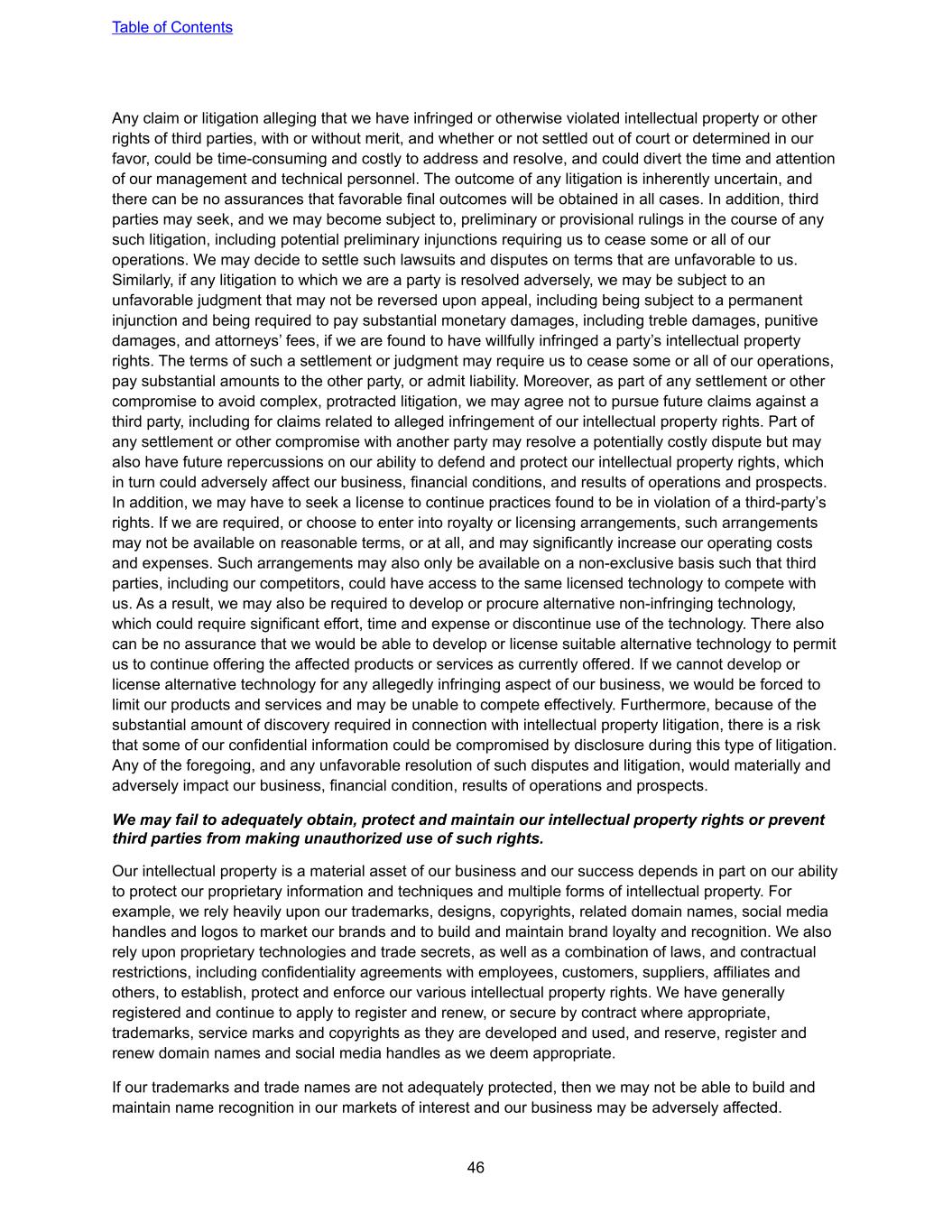
Any claim or litigation alleging that we have infringed or otherwise violated intellectual property or other rights of third parties, with or without merit, and whether or not settled out of court or determined in our favor, could be time-consuming and costly to address and resolve, and could divert the time and attention of our management and technical personnel. The outcome of any litigation is inherently uncertain, and there can be no assurances that favorable final outcomes will be obtained in all cases. In addition, third parties may seek, and we may become subject to, preliminary or provisional rulings in the course of any such litigation, including potential preliminary injunctions requiring us to cease some or all of our operations. We may decide to settle such lawsuits and disputes on terms that are unfavorable to us. Similarly, if any litigation to which we are a party is resolved adversely, we may be subject to an unfavorable judgment that may not be reversed upon appeal, including being subject to a permanent injunction and being required to pay substantial monetary damages, including treble damages, punitive damages, and attorneys’ fees, if we are found to have willfully infringed a party’s intellectual property rights. The terms of such a settlement or judgment may require us to cease some or all of our operations, pay substantial amounts to the other party, or admit liability. Moreover, as part of any settlement or other compromise to avoid complex, protracted litigation, we may agree not to pursue future claims against a third party, including for claims related to alleged infringement of our intellectual property rights. Part of any settlement or other compromise with another party may resolve a potentially costly dispute but may also have future repercussions on our ability to defend and protect our intellectual property rights, which in turn could adversely affect our business, financial conditions, and results of operations and prospects. In addition, we may have to seek a license to continue practices found to be in violation of a third-party’s rights. If we are required, or choose to enter into royalty or licensing arrangements, such arrangements may not be available on reasonable terms, or at all, and may significantly increase our operating costs and expenses. Such arrangements may also only be available on a non-exclusive basis such that third parties, including our competitors, could have access to the same licensed technology to compete with us. As a result, we may also be required to develop or procure alternative non-infringing technology, which could require significant effort, time and expense or discontinue use of the technology. There also can be no assurance that we would be able to develop or license suitable alternative technology to permit us to continue offering the affected products or services as currently offered. If we cannot develop or license alternative technology for any allegedly infringing aspect of our business, we would be forced to limit our products and services and may be unable to compete effectively. Furthermore, because of the substantial amount of discovery required in connection with intellectual property litigation, there is a risk that some of our confidential information could be compromised by disclosure during this type of litigation. Any of the foregoing, and any unfavorable resolution of such disputes and litigation, would materially and adversely impact our business, financial condition, results of operations and prospects. We may fail to adequately obtain, protect and maintain our intellectual property rights or prevent third parties from making unauthorized use of such rights. Our intellectual property is a material asset of our business and our success depends in part on our ability to protect our proprietary information and techniques and multiple forms of intellectual property. For example, we rely heavily upon our trademarks, designs, copyrights, related domain names, social media handles and logos to market our brands and to build and maintain brand loyalty and recognition. We also rely upon proprietary technologies and trade secrets, as well as a combination of laws, and contractual restrictions, including confidentiality agreements with employees, customers, suppliers, affiliates and others, to establish, protect and enforce our various intellectual property rights. We have generally registered and continue to apply to register and renew, or secure by contract where appropriate, trademarks, service marks and copyrights as they are developed and used, and reserve, register and renew domain names and social media handles as we deem appropriate. If our trademarks and trade names are not adequately protected, then we may not be able to build and maintain name recognition in our markets of interest and our business may be adversely affected. Table of Contents 46
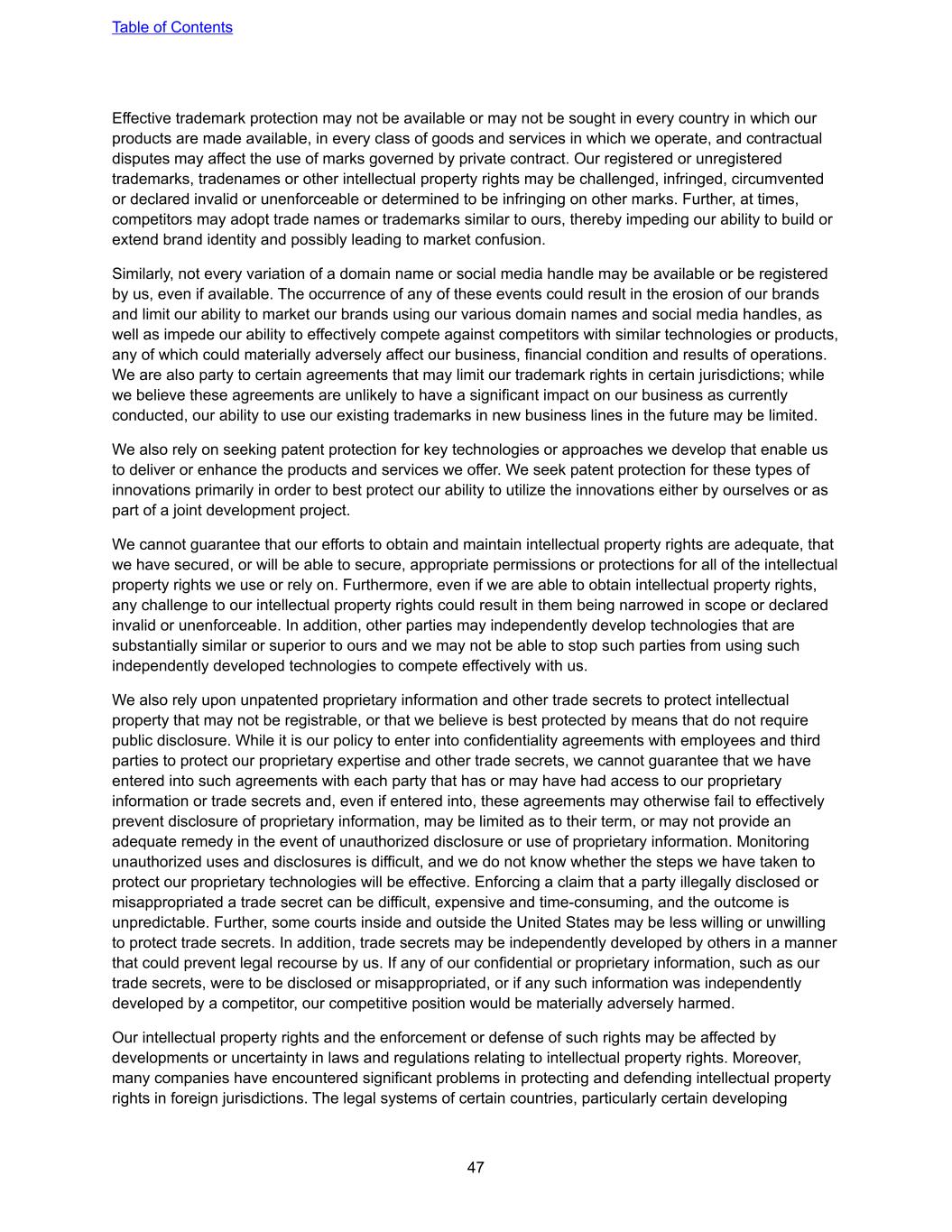
Effective trademark protection may not be available or may not be sought in every country in which our products are made available, in every class of goods and services in which we operate, and contractual disputes may affect the use of marks governed by private contract. Our registered or unregistered trademarks, tradenames or other intellectual property rights may be challenged, infringed, circumvented or declared invalid or unenforceable or determined to be infringing on other marks. Further, at times, competitors may adopt trade names or trademarks similar to ours, thereby impeding our ability to build or extend brand identity and possibly leading to market confusion. Similarly, not every variation of a domain name or social media handle may be available or be registered by us, even if available. The occurrence of any of these events could result in the erosion of our brands and limit our ability to market our brands using our various domain names and social media handles, as well as impede our ability to effectively compete against competitors with similar technologies or products, any of which could materially adversely affect our business, financial condition and results of operations. We are also party to certain agreements that may limit our trademark rights in certain jurisdictions; while we believe these agreements are unlikely to have a significant impact on our business as currently conducted, our ability to use our existing trademarks in new business lines in the future may be limited. We also rely on seeking patent protection for key technologies or approaches we develop that enable us to deliver or enhance the products and services we offer. We seek patent protection for these types of innovations primarily in order to best protect our ability to utilize the innovations either by ourselves or as part of a joint development project. We cannot guarantee that our efforts to obtain and maintain intellectual property rights are adequate, that we have secured, or will be able to secure, appropriate permissions or protections for all of the intellectual property rights we use or rely on. Furthermore, even if we are able to obtain intellectual property rights, any challenge to our intellectual property rights could result in them being narrowed in scope or declared invalid or unenforceable. In addition, other parties may independently develop technologies that are substantially similar or superior to ours and we may not be able to stop such parties from using such independently developed technologies to compete effectively with us. We also rely upon unpatented proprietary information and other trade secrets to protect intellectual property that may not be registrable, or that we believe is best protected by means that do not require public disclosure. While it is our policy to enter into confidentiality agreements with employees and third parties to protect our proprietary expertise and other trade secrets, we cannot guarantee that we have entered into such agreements with each party that has or may have had access to our proprietary information or trade secrets and, even if entered into, these agreements may otherwise fail to effectively prevent disclosure of proprietary information, may be limited as to their term, or may not provide an adequate remedy in the event of unauthorized disclosure or use of proprietary information. Monitoring unauthorized uses and disclosures is difficult, and we do not know whether the steps we have taken to protect our proprietary technologies will be effective. Enforcing a claim that a party illegally disclosed or misappropriated a trade secret can be difficult, expensive and time-consuming, and the outcome is unpredictable. Further, some courts inside and outside the United States may be less willing or unwilling to protect trade secrets. In addition, trade secrets may be independently developed by others in a manner that could prevent legal recourse by us. If any of our confidential or proprietary information, such as our trade secrets, were to be disclosed or misappropriated, or if any such information was independently developed by a competitor, our competitive position would be materially adversely harmed. Our intellectual property rights and the enforcement or defense of such rights may be affected by developments or uncertainty in laws and regulations relating to intellectual property rights. Moreover, many companies have encountered significant problems in protecting and defending intellectual property rights in foreign jurisdictions. The legal systems of certain countries, particularly certain developing Table of Contents 47
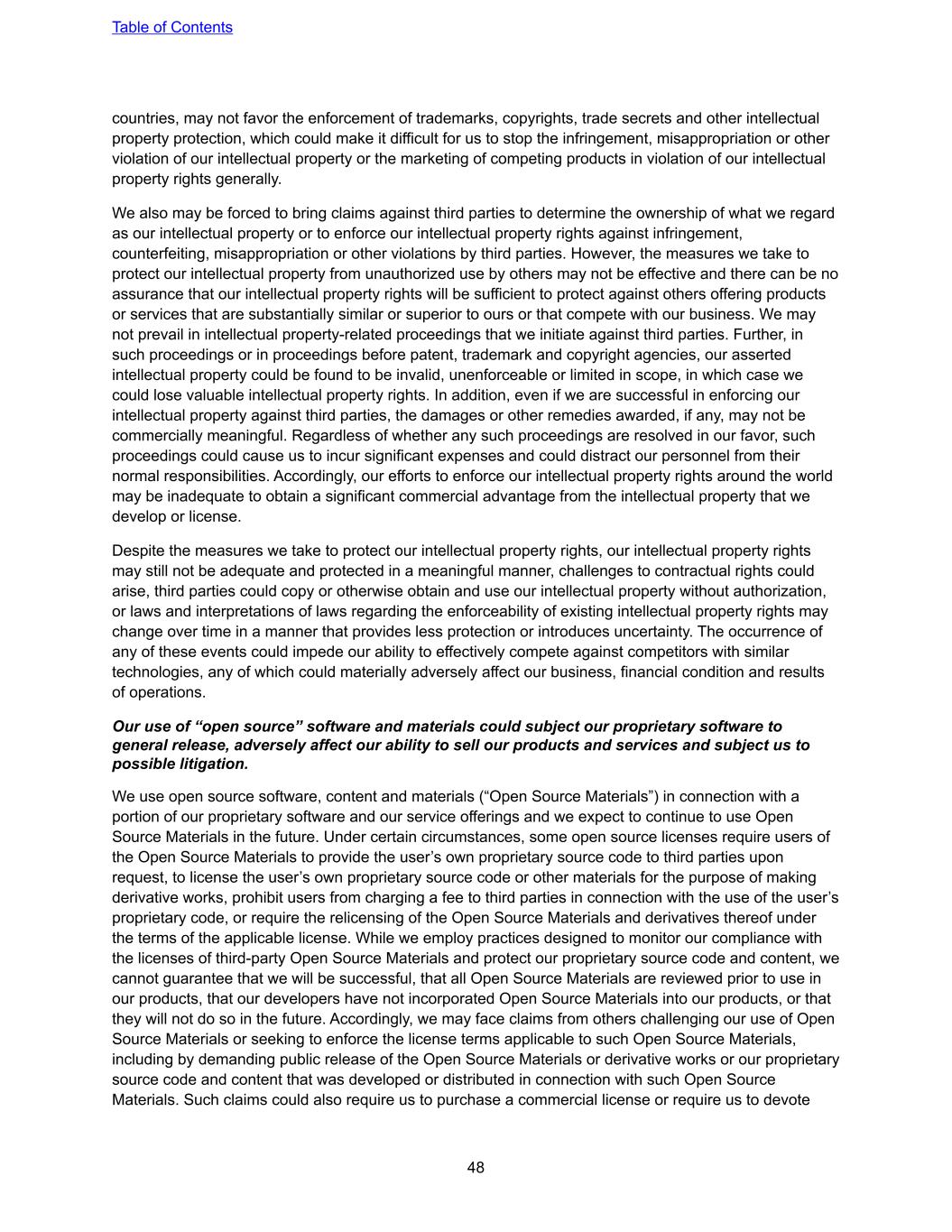
countries, may not favor the enforcement of trademarks, copyrights, trade secrets and other intellectual property protection, which could make it difficult for us to stop the infringement, misappropriation or other violation of our intellectual property or the marketing of competing products in violation of our intellectual property rights generally. We also may be forced to bring claims against third parties to determine the ownership of what we regard as our intellectual property or to enforce our intellectual property rights against infringement, counterfeiting, misappropriation or other violations by third parties. However, the measures we take to protect our intellectual property from unauthorized use by others may not be effective and there can be no assurance that our intellectual property rights will be sufficient to protect against others offering products or services that are substantially similar or superior to ours or that compete with our business. We may not prevail in intellectual property-related proceedings that we initiate against third parties. Further, in such proceedings or in proceedings before patent, trademark and copyright agencies, our asserted intellectual property could be found to be invalid, unenforceable or limited in scope, in which case we could lose valuable intellectual property rights. In addition, even if we are successful in enforcing our intellectual property against third parties, the damages or other remedies awarded, if any, may not be commercially meaningful. Regardless of whether any such proceedings are resolved in our favor, such proceedings could cause us to incur significant expenses and could distract our personnel from their normal responsibilities. Accordingly, our efforts to enforce our intellectual property rights around the world may be inadequate to obtain a significant commercial advantage from the intellectual property that we develop or license. Despite the measures we take to protect our intellectual property rights, our intellectual property rights may still not be adequate and protected in a meaningful manner, challenges to contractual rights could arise, third parties could copy or otherwise obtain and use our intellectual property without authorization, or laws and interpretations of laws regarding the enforceability of existing intellectual property rights may change over time in a manner that provides less protection or introduces uncertainty. The occurrence of any of these events could impede our ability to effectively compete against competitors with similar technologies, any of which could materially adversely affect our business, financial condition and results of operations. Our use of “open source” software and materials could subject our proprietary software to general release, adversely affect our ability to sell our products and services and subject us to possible litigation. We use open source software, content and materials (“Open Source Materials”) in connection with a portion of our proprietary software and our service offerings and we expect to continue to use Open Source Materials in the future. Under certain circumstances, some open source licenses require users of the Open Source Materials to provide the user’s own proprietary source code to third parties upon request, to license the user’s own proprietary source code or other materials for the purpose of making derivative works, prohibit users from charging a fee to third parties in connection with the use of the user’s proprietary code, or require the relicensing of the Open Source Materials and derivatives thereof under the terms of the applicable license. While we employ practices designed to monitor our compliance with the licenses of third-party Open Source Materials and protect our proprietary source code and content, we cannot guarantee that we will be successful, that all Open Source Materials are reviewed prior to use in our products, that our developers have not incorporated Open Source Materials into our products, or that they will not do so in the future. Accordingly, we may face claims from others challenging our use of Open Source Materials or seeking to enforce the license terms applicable to such Open Source Materials, including by demanding public release of the Open Source Materials or derivative works or our proprietary source code and content that was developed or distributed in connection with such Open Source Materials. Such claims could also require us to purchase a commercial license or require us to devote Table of Contents 48
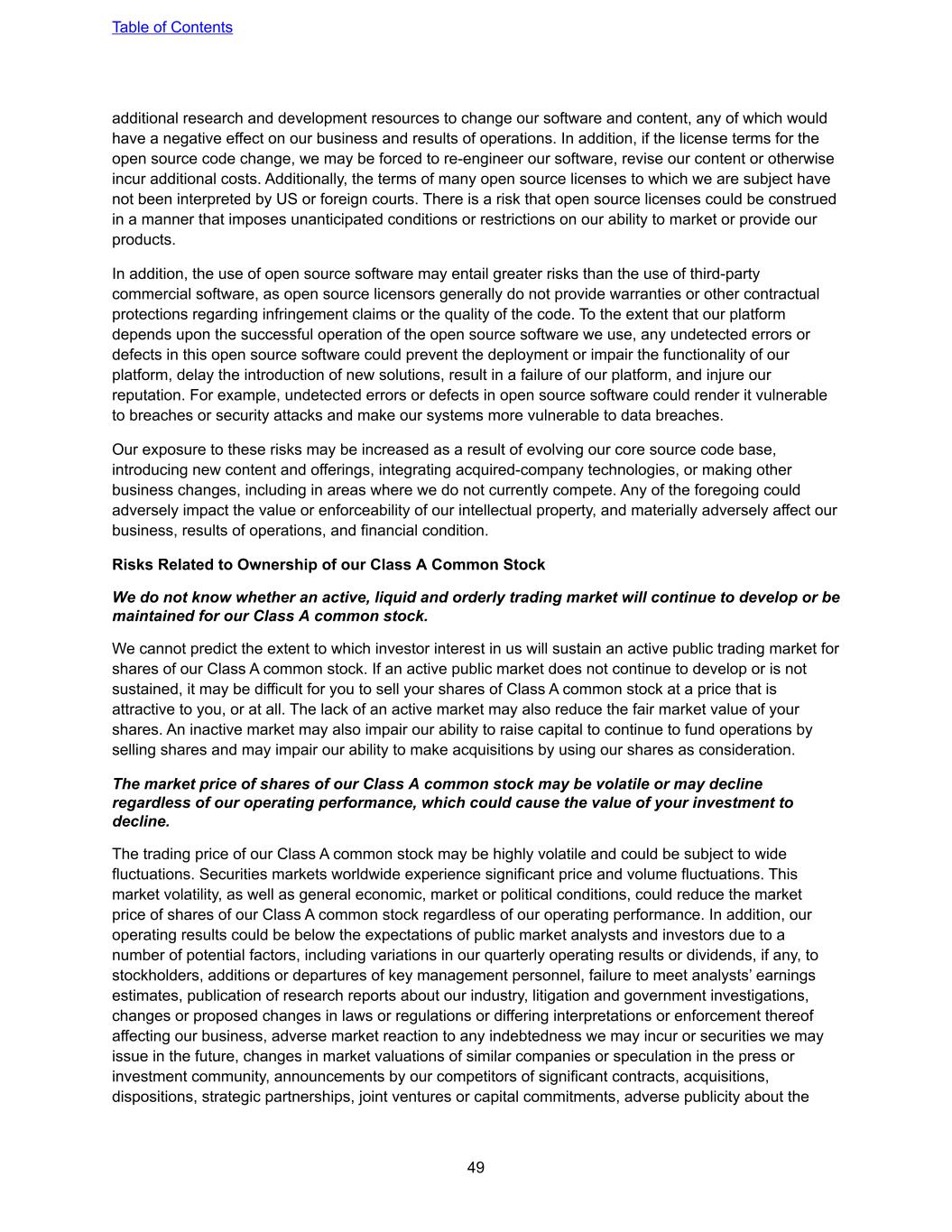
additional research and development resources to change our software and content, any of which would have a negative effect on our business and results of operations. In addition, if the license terms for the open source code change, we may be forced to re-engineer our software, revise our content or otherwise incur additional costs. Additionally, the terms of many open source licenses to which we are subject have not been interpreted by US or foreign courts. There is a risk that open source licenses could be construed in a manner that imposes unanticipated conditions or restrictions on our ability to market or provide our products. In addition, the use of open source software may entail greater risks than the use of third-party commercial software, as open source licensors generally do not provide warranties or other contractual protections regarding infringement claims or the quality of the code. To the extent that our platform depends upon the successful operation of the open source software we use, any undetected errors or defects in this open source software could prevent the deployment or impair the functionality of our platform, delay the introduction of new solutions, result in a failure of our platform, and injure our reputation. For example, undetected errors or defects in open source software could render it vulnerable to breaches or security attacks and make our systems more vulnerable to data breaches. Our exposure to these risks may be increased as a result of evolving our core source code base, introducing new content and offerings, integrating acquired-company technologies, or making other business changes, including in areas where we do not currently compete. Any of the foregoing could adversely impact the value or enforceability of our intellectual property, and materially adversely affect our business, results of operations, and financial condition. Risks Related to Ownership of our Class A Common Stock We do not know whether an active, liquid and orderly trading market will continue to develop or be maintained for our Class A common stock. We cannot predict the extent to which investor interest in us will sustain an active public trading market for shares of our Class A common stock. If an active public market does not continue to develop or is not sustained, it may be difficult for you to sell your shares of Class A common stock at a price that is attractive to you, or at all. The lack of an active market may also reduce the fair market value of your shares. An inactive market may also impair our ability to raise capital to continue to fund operations by selling shares and may impair our ability to make acquisitions by using our shares as consideration. The market price of shares of our Class A common stock may be volatile or may decline regardless of our operating performance, which could cause the value of your investment to decline. The trading price of our Class A common stock may be highly volatile and could be subject to wide fluctuations. Securities markets worldwide experience significant price and volume fluctuations. This market volatility, as well as general economic, market or political conditions, could reduce the market price of shares of our Class A common stock regardless of our operating performance. In addition, our operating results could be below the expectations of public market analysts and investors due to a number of potential factors, including variations in our quarterly operating results or dividends, if any, to stockholders, additions or departures of key management personnel, failure to meet analysts’ earnings estimates, publication of research reports about our industry, litigation and government investigations, changes or proposed changes in laws or regulations or differing interpretations or enforcement thereof affecting our business, adverse market reaction to any indebtedness we may incur or securities we may issue in the future, changes in market valuations of similar companies or speculation in the press or investment community, announcements by our competitors of significant contracts, acquisitions, dispositions, strategic partnerships, joint ventures or capital commitments, adverse publicity about the Table of Contents 49
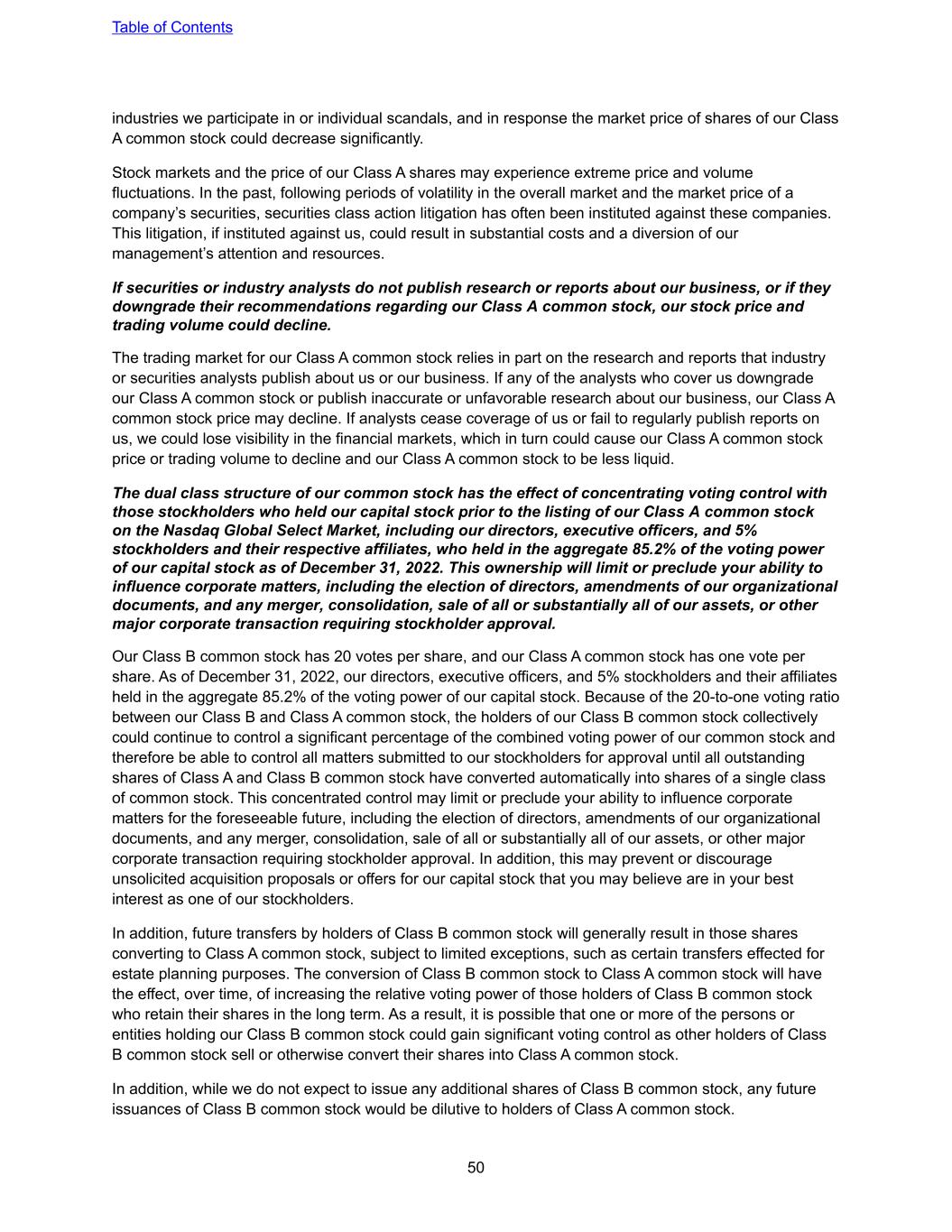
industries we participate in or individual scandals, and in response the market price of shares of our Class A common stock could decrease significantly. Stock markets and the price of our Class A shares may experience extreme price and volume fluctuations. In the past, following periods of volatility in the overall market and the market price of a company’s securities, securities class action litigation has often been instituted against these companies. This litigation, if instituted against us, could result in substantial costs and a diversion of our management’s attention and resources. If securities or industry analysts do not publish research or reports about our business, or if they downgrade their recommendations regarding our Class A common stock, our stock price and trading volume could decline. The trading market for our Class A common stock relies in part on the research and reports that industry or securities analysts publish about us or our business. If any of the analysts who cover us downgrade our Class A common stock or publish inaccurate or unfavorable research about our business, our Class A common stock price may decline. If analysts cease coverage of us or fail to regularly publish reports on us, we could lose visibility in the financial markets, which in turn could cause our Class A common stock price or trading volume to decline and our Class A common stock to be less liquid. The dual class structure of our common stock has the effect of concentrating voting control with those stockholders who held our capital stock prior to the listing of our Class A common stock on the Nasdaq Global Select Market, including our directors, executive officers, and 5% stockholders and their respective affiliates, who held in the aggregate 85.2% of the voting power of our capital stock as of December 31, 2022. This ownership will limit or preclude your ability to influence corporate matters, including the election of directors, amendments of our organizational documents, and any merger, consolidation, sale of all or substantially all of our assets, or other major corporate transaction requiring stockholder approval. Our Class B common stock has 20 votes per share, and our Class A common stock has one vote per share. As of December 31, 2022, our directors, executive officers, and 5% stockholders and their affiliates held in the aggregate 85.2% of the voting power of our capital stock. Because of the 20-to-one voting ratio between our Class B and Class A common stock, the holders of our Class B common stock collectively could continue to control a significant percentage of the combined voting power of our common stock and therefore be able to control all matters submitted to our stockholders for approval until all outstanding shares of Class A and Class B common stock have converted automatically into shares of a single class of common stock. This concentrated control may limit or preclude your ability to influence corporate matters for the foreseeable future, including the election of directors, amendments of our organizational documents, and any merger, consolidation, sale of all or substantially all of our assets, or other major corporate transaction requiring stockholder approval. In addition, this may prevent or discourage unsolicited acquisition proposals or offers for our capital stock that you may believe are in your best interest as one of our stockholders. In addition, future transfers by holders of Class B common stock will generally result in those shares converting to Class A common stock, subject to limited exceptions, such as certain transfers effected for estate planning purposes. The conversion of Class B common stock to Class A common stock will have the effect, over time, of increasing the relative voting power of those holders of Class B common stock who retain their shares in the long term. As a result, it is possible that one or more of the persons or entities holding our Class B common stock could gain significant voting control as other holders of Class B common stock sell or otherwise convert their shares into Class A common stock. In addition, while we do not expect to issue any additional shares of Class B common stock, any future issuances of Class B common stock would be dilutive to holders of Class A common stock. Table of Contents 50
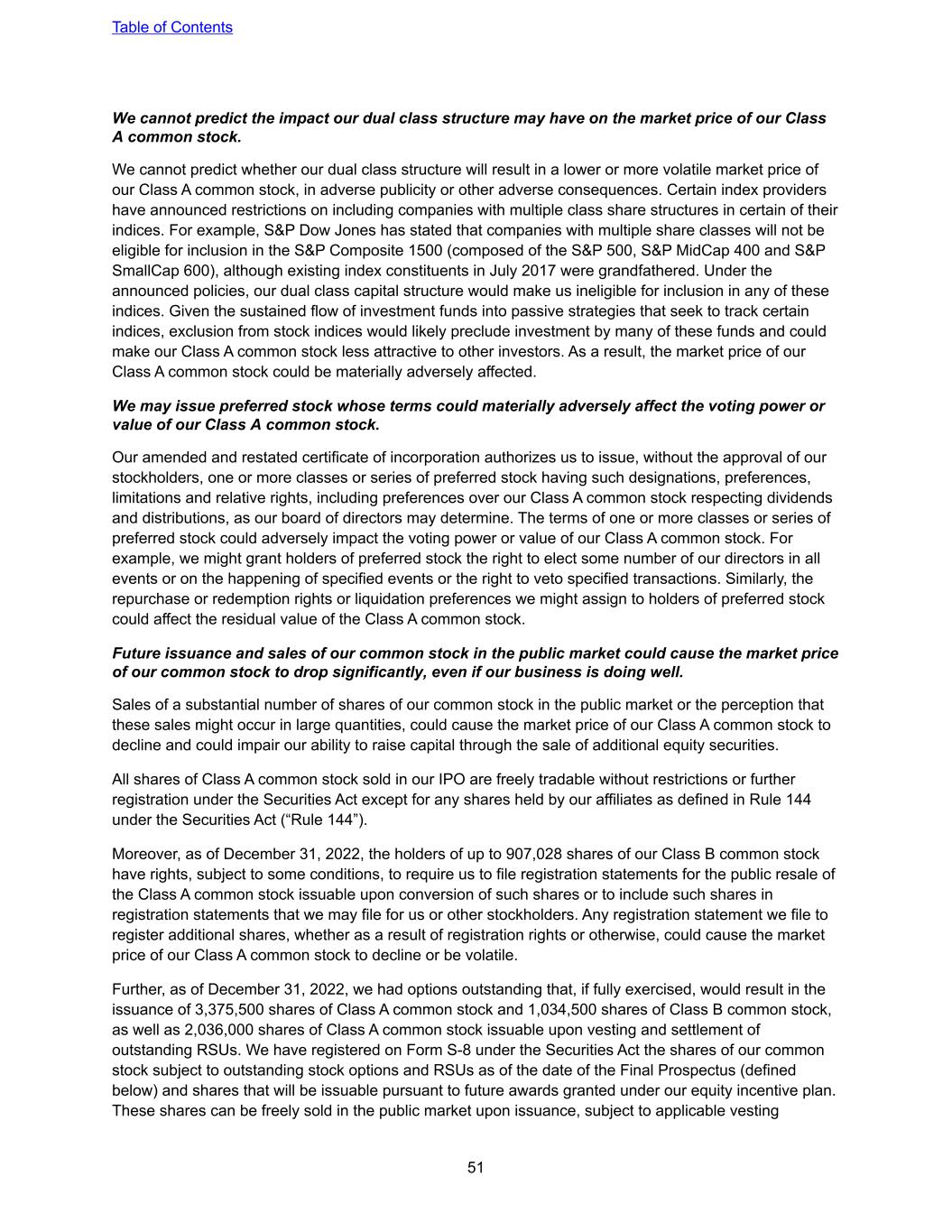
We cannot predict the impact our dual class structure may have on the market price of our Class A common stock. We cannot predict whether our dual class structure will result in a lower or more volatile market price of our Class A common stock, in adverse publicity or other adverse consequences. Certain index providers have announced restrictions on including companies with multiple class share structures in certain of their indices. For example, S&P Dow Jones has stated that companies with multiple share classes will not be eligible for inclusion in the S&P Composite 1500 (composed of the S&P 500, S&P MidCap 400 and S&P SmallCap 600), although existing index constituents in July 2017 were grandfathered. Under the announced policies, our dual class capital structure would make us ineligible for inclusion in any of these indices. Given the sustained flow of investment funds into passive strategies that seek to track certain indices, exclusion from stock indices would likely preclude investment by many of these funds and could make our Class A common stock less attractive to other investors. As a result, the market price of our Class A common stock could be materially adversely affected. We may issue preferred stock whose terms could materially adversely affect the voting power or value of our Class A common stock. Our amended and restated certificate of incorporation authorizes us to issue, without the approval of our stockholders, one or more classes or series of preferred stock having such designations, preferences, limitations and relative rights, including preferences over our Class A common stock respecting dividends and distributions, as our board of directors may determine. The terms of one or more classes or series of preferred stock could adversely impact the voting power or value of our Class A common stock. For example, we might grant holders of preferred stock the right to elect some number of our directors in all events or on the happening of specified events or the right to veto specified transactions. Similarly, the repurchase or redemption rights or liquidation preferences we might assign to holders of preferred stock could affect the residual value of the Class A common stock. Future issuance and sales of our common stock in the public market could cause the market price of our common stock to drop significantly, even if our business is doing well. Sales of a substantial number of shares of our common stock in the public market or the perception that these sales might occur in large quantities, could cause the market price of our Class A common stock to decline and could impair our ability to raise capital through the sale of additional equity securities. All shares of Class A common stock sold in our IPO are freely tradable without restrictions or further registration under the Securities Act except for any shares held by our affiliates as defined in Rule 144 under the Securities Act (“Rule 144”). Moreover, as of December 31, 2022, the holders of up to 907,028 shares of our Class B common stock have rights, subject to some conditions, to require us to file registration statements for the public resale of the Class A common stock issuable upon conversion of such shares or to include such shares in registration statements that we may file for us or other stockholders. Any registration statement we file to register additional shares, whether as a result of registration rights or otherwise, could cause the market price of our Class A common stock to decline or be volatile. Further, as of December 31, 2022, we had options outstanding that, if fully exercised, would result in the issuance of 3,375,500 shares of Class A common stock and 1,034,500 shares of Class B common stock, as well as 2,036,000 shares of Class A common stock issuable upon vesting and settlement of outstanding RSUs. We have registered on Form S-8 under the Securities Act the shares of our common stock subject to outstanding stock options and RSUs as of the date of the Final Prospectus (defined below) and shares that will be issuable pursuant to future awards granted under our equity incentive plan. These shares can be freely sold in the public market upon issuance, subject to applicable vesting Table of Contents 51
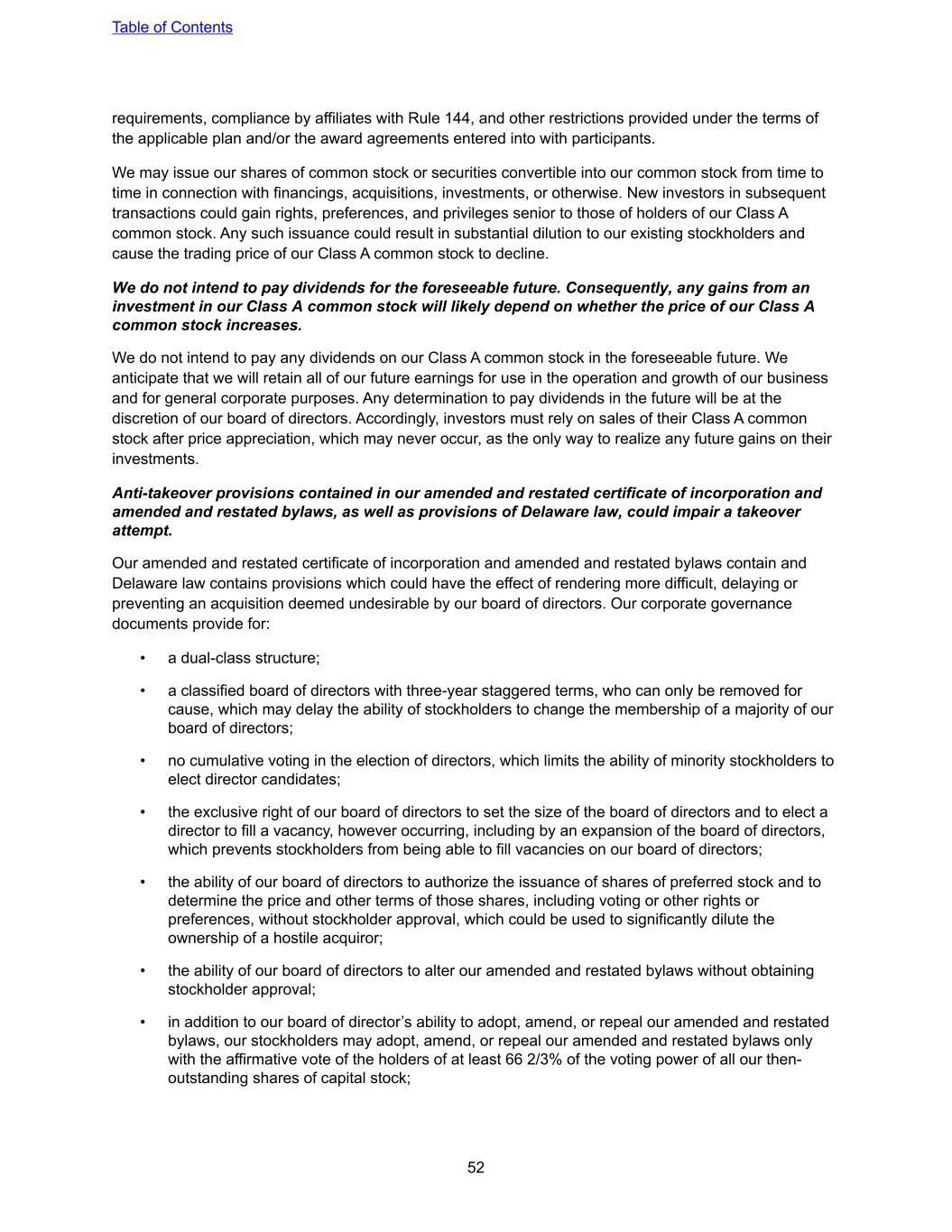
requirements, compliance by affiliates with Rule 144, and other restrictions provided under the terms of the applicable plan and/or the award agreements entered into with participants. We may issue our shares of common stock or securities convertible into our common stock from time to time in connection with financings, acquisitions, investments, or otherwise. New investors in subsequent transactions could gain rights, preferences, and privileges senior to those of holders of our Class A common stock. Any such issuance could result in substantial dilution to our existing stockholders and cause the trading price of our Class A common stock to decline. We do not intend to pay dividends for the foreseeable future. Consequently, any gains from an investment in our Class A common stock will likely depend on whether the price of our Class A common stock increases. We do not intend to pay any dividends on our Class A common stock in the foreseeable future. We anticipate that we will retain all of our future earnings for use in the operation and growth of our business and for general corporate purposes. Any determination to pay dividends in the future will be at the discretion of our board of directors. Accordingly, investors must rely on sales of their Class A common stock after price appreciation, which may never occur, as the only way to realize any future gains on their investments. Anti-takeover provisions contained in our amended and restated certificate of incorporation and amended and restated bylaws, as well as provisions of Delaware law, could impair a takeover attempt. Our amended and restated certificate of incorporation and amended and restated bylaws contain and Delaware law contains provisions which could have the effect of rendering more difficult, delaying or preventing an acquisition deemed undesirable by our board of directors. Our corporate governance documents provide for: • a dual-class structure; • a classified board of directors with three-year staggered terms, who can only be removed for cause, which may delay the ability of stockholders to change the membership of a majority of our board of directors; • no cumulative voting in the election of directors, which limits the ability of minority stockholders to elect director candidates; • the exclusive right of our board of directors to set the size of the board of directors and to elect a director to fill a vacancy, however occurring, including by an expansion of the board of directors, which prevents stockholders from being able to fill vacancies on our board of directors; • the ability of our board of directors to authorize the issuance of shares of preferred stock and to determine the price and other terms of those shares, including voting or other rights or preferences, without stockholder approval, which could be used to significantly dilute the ownership of a hostile acquiror; • the ability of our board of directors to alter our amended and restated bylaws without obtaining stockholder approval; • in addition to our board of director’s ability to adopt, amend, or repeal our amended and restated bylaws, our stockholders may adopt, amend, or repeal our amended and restated bylaws only with the affirmative vote of the holders of at least 66 2/3% of the voting power of all our then- outstanding shares of capital stock; Table of Contents 52
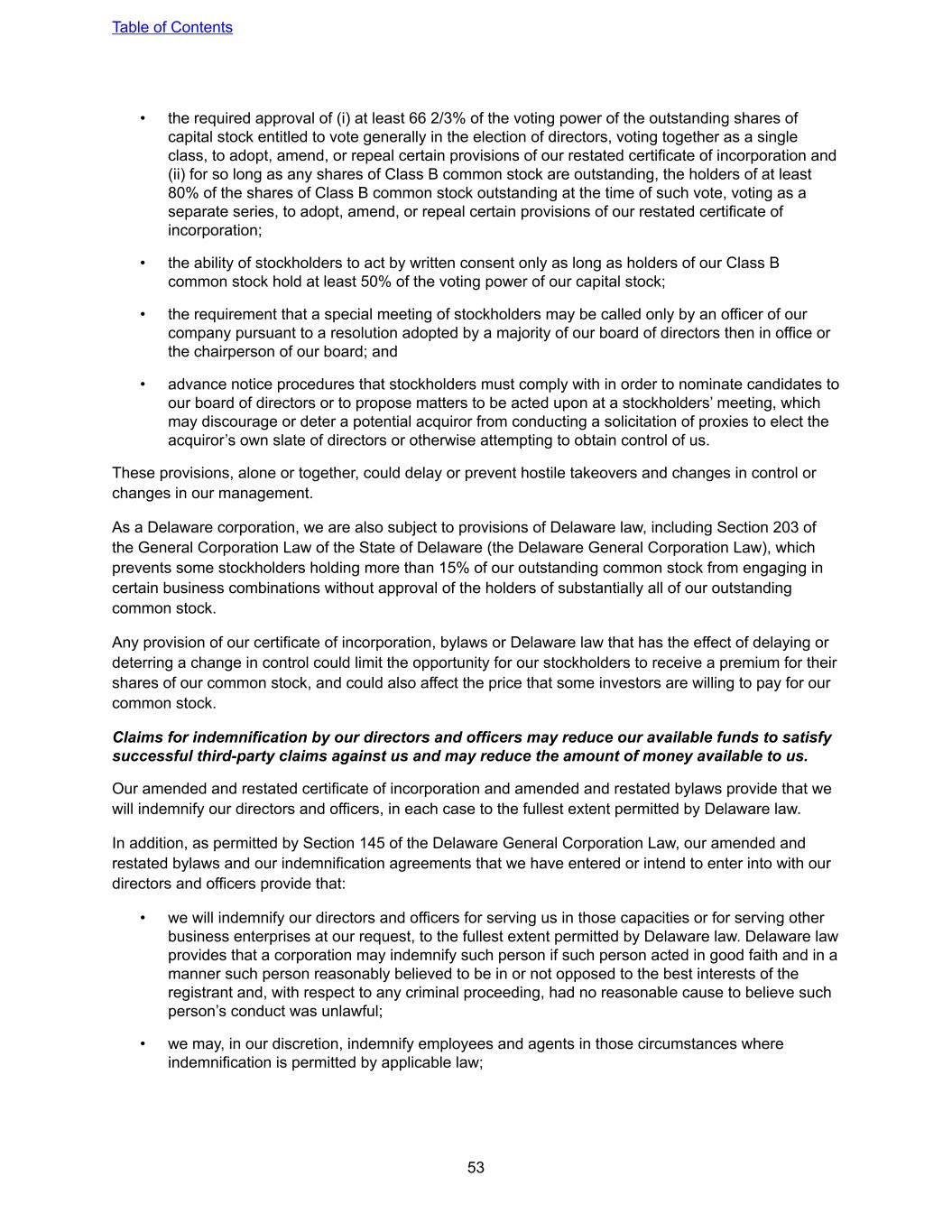
• the required approval of (i) at least 66 2/3% of the voting power of the outstanding shares of capital stock entitled to vote generally in the election of directors, voting together as a single class, to adopt, amend, or repeal certain provisions of our restated certificate of incorporation and (ii) for so long as any shares of Class B common stock are outstanding, the holders of at least 80% of the shares of Class B common stock outstanding at the time of such vote, voting as a separate series, to adopt, amend, or repeal certain provisions of our restated certificate of incorporation; • the ability of stockholders to act by written consent only as long as holders of our Class B common stock hold at least 50% of the voting power of our capital stock; • the requirement that a special meeting of stockholders may be called only by an officer of our company pursuant to a resolution adopted by a majority of our board of directors then in office or the chairperson of our board; and • advance notice procedures that stockholders must comply with in order to nominate candidates to our board of directors or to propose matters to be acted upon at a stockholders’ meeting, which may discourage or deter a potential acquiror from conducting a solicitation of proxies to elect the acquiror’s own slate of directors or otherwise attempting to obtain control of us. These provisions, alone or together, could delay or prevent hostile takeovers and changes in control or changes in our management. As a Delaware corporation, we are also subject to provisions of Delaware law, including Section 203 of the General Corporation Law of the State of Delaware (the Delaware General Corporation Law), which prevents some stockholders holding more than 15% of our outstanding common stock from engaging in certain business combinations without approval of the holders of substantially all of our outstanding common stock. Any provision of our certificate of incorporation, bylaws or Delaware law that has the effect of delaying or deterring a change in control could limit the opportunity for our stockholders to receive a premium for their shares of our common stock, and could also affect the price that some investors are willing to pay for our common stock. Claims for indemnification by our directors and officers may reduce our available funds to satisfy successful third-party claims against us and may reduce the amount of money available to us. Our amended and restated certificate of incorporation and amended and restated bylaws provide that we will indemnify our directors and officers, in each case to the fullest extent permitted by Delaware law. In addition, as permitted by Section 145 of the Delaware General Corporation Law, our amended and restated bylaws and our indemnification agreements that we have entered or intend to enter into with our directors and officers provide that: • we will indemnify our directors and officers for serving us in those capacities or for serving other business enterprises at our request, to the fullest extent permitted by Delaware law. Delaware law provides that a corporation may indemnify such person if such person acted in good faith and in a manner such person reasonably believed to be in or not opposed to the best interests of the registrant and, with respect to any criminal proceeding, had no reasonable cause to believe such person’s conduct was unlawful; • we may, in our discretion, indemnify employees and agents in those circumstances where indemnification is permitted by applicable law; Table of Contents 53
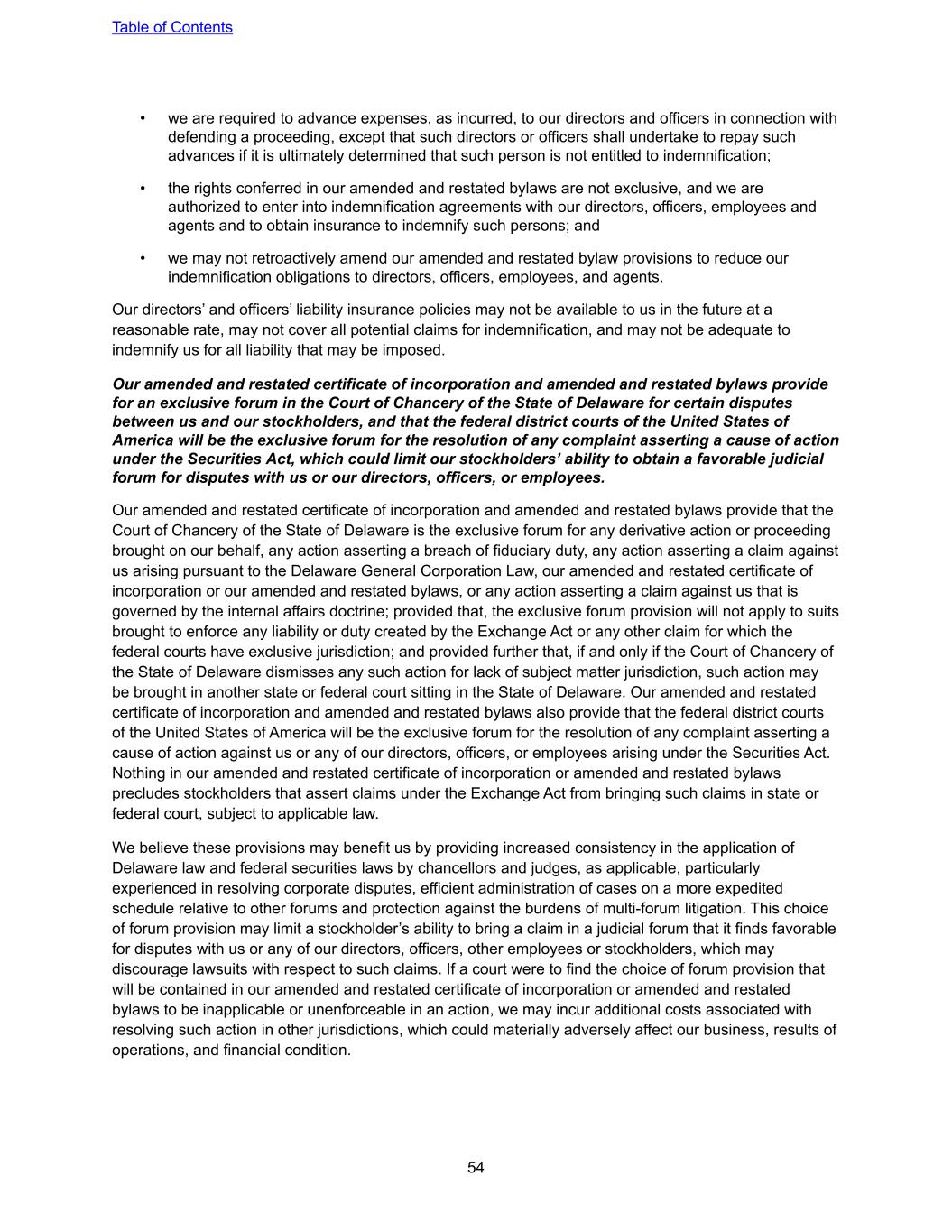
• we are required to advance expenses, as incurred, to our directors and officers in connection with defending a proceeding, except that such directors or officers shall undertake to repay such advances if it is ultimately determined that such person is not entitled to indemnification; • the rights conferred in our amended and restated bylaws are not exclusive, and we are authorized to enter into indemnification agreements with our directors, officers, employees and agents and to obtain insurance to indemnify such persons; and • we may not retroactively amend our amended and restated bylaw provisions to reduce our indemnification obligations to directors, officers, employees, and agents. Our directors’ and officers’ liability insurance policies may not be available to us in the future at a reasonable rate, may not cover all potential claims for indemnification, and may not be adequate to indemnify us for all liability that may be imposed. Our amended and restated certificate of incorporation and amended and restated bylaws provide for an exclusive forum in the Court of Chancery of the State of Delaware for certain disputes between us and our stockholders, and that the federal district courts of the United States of America will be the exclusive forum for the resolution of any complaint asserting a cause of action under the Securities Act, which could limit our stockholders’ ability to obtain a favorable judicial forum for disputes with us or our directors, officers, or employees. Our amended and restated certificate of incorporation and amended and restated bylaws provide that the Court of Chancery of the State of Delaware is the exclusive forum for any derivative action or proceeding brought on our behalf, any action asserting a breach of fiduciary duty, any action asserting a claim against us arising pursuant to the Delaware General Corporation Law, our amended and restated certificate of incorporation or our amended and restated bylaws, or any action asserting a claim against us that is governed by the internal affairs doctrine; provided that, the exclusive forum provision will not apply to suits brought to enforce any liability or duty created by the Exchange Act or any other claim for which the federal courts have exclusive jurisdiction; and provided further that, if and only if the Court of Chancery of the State of Delaware dismisses any such action for lack of subject matter jurisdiction, such action may be brought in another state or federal court sitting in the State of Delaware. Our amended and restated certificate of incorporation and amended and restated bylaws also provide that the federal district courts of the United States of America will be the exclusive forum for the resolution of any complaint asserting a cause of action against us or any of our directors, officers, or employees arising under the Securities Act. Nothing in our amended and restated certificate of incorporation or amended and restated bylaws precludes stockholders that assert claims under the Exchange Act from bringing such claims in state or federal court, subject to applicable law. We believe these provisions may benefit us by providing increased consistency in the application of Delaware law and federal securities laws by chancellors and judges, as applicable, particularly experienced in resolving corporate disputes, efficient administration of cases on a more expedited schedule relative to other forums and protection against the burdens of multi-forum litigation. This choice of forum provision may limit a stockholder’s ability to bring a claim in a judicial forum that it finds favorable for disputes with us or any of our directors, officers, other employees or stockholders, which may discourage lawsuits with respect to such claims. If a court were to find the choice of forum provision that will be contained in our amended and restated certificate of incorporation or amended and restated bylaws to be inapplicable or unenforceable in an action, we may incur additional costs associated with resolving such action in other jurisdictions, which could materially adversely affect our business, results of operations, and financial condition. Table of Contents 54
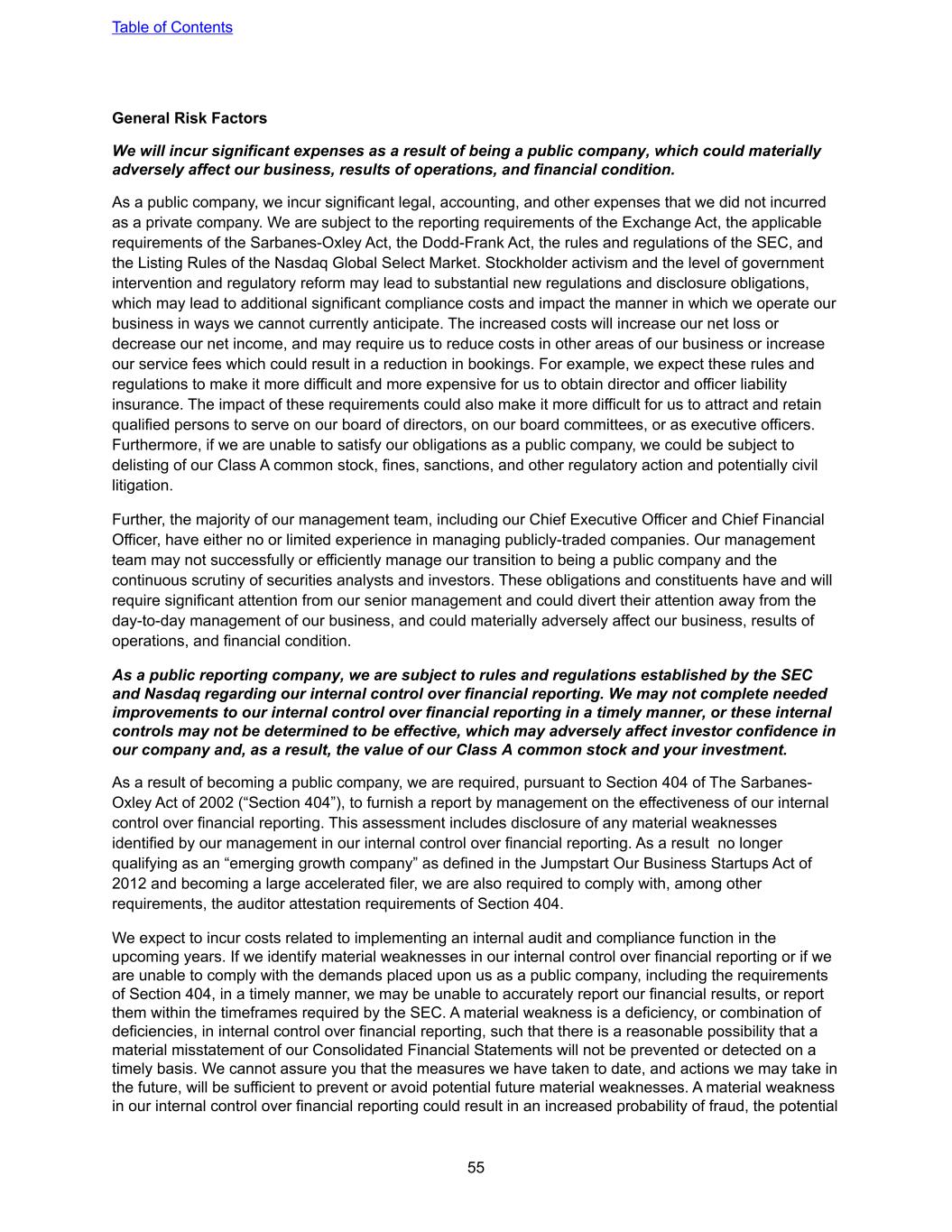
General Risk Factors We will incur significant expenses as a result of being a public company, which could materially adversely affect our business, results of operations, and financial condition. As a public company, we incur significant legal, accounting, and other expenses that we did not incurred as a private company. We are subject to the reporting requirements of the Exchange Act, the applicable requirements of the Sarbanes-Oxley Act, the Dodd-Frank Act, the rules and regulations of the SEC, and the Listing Rules of the Nasdaq Global Select Market. Stockholder activism and the level of government intervention and regulatory reform may lead to substantial new regulations and disclosure obligations, which may lead to additional significant compliance costs and impact the manner in which we operate our business in ways we cannot currently anticipate. The increased costs will increase our net loss or decrease our net income, and may require us to reduce costs in other areas of our business or increase our service fees which could result in a reduction in bookings. For example, we expect these rules and regulations to make it more difficult and more expensive for us to obtain director and officer liability insurance. The impact of these requirements could also make it more difficult for us to attract and retain qualified persons to serve on our board of directors, on our board committees, or as executive officers. Furthermore, if we are unable to satisfy our obligations as a public company, we could be subject to delisting of our Class A common stock, fines, sanctions, and other regulatory action and potentially civil litigation. Further, the majority of our management team, including our Chief Executive Officer and Chief Financial Officer, have either no or limited experience in managing publicly-traded companies. Our management team may not successfully or efficiently manage our transition to being a public company and the continuous scrutiny of securities analysts and investors. These obligations and constituents have and will require significant attention from our senior management and could divert their attention away from the day-to-day management of our business, and could materially adversely affect our business, results of operations, and financial condition. As a public reporting company, we are subject to rules and regulations established by the SEC and Nasdaq regarding our internal control over financial reporting. We may not complete needed improvements to our internal control over financial reporting in a timely manner, or these internal controls may not be determined to be effective, which may adversely affect investor confidence in our company and, as a result, the value of our Class A common stock and your investment. As a result of becoming a public company, we are required, pursuant to Section 404 of The Sarbanes- Oxley Act of 2002 (“Section 404”), to furnish a report by management on the effectiveness of our internal control over financial reporting. This assessment includes disclosure of any material weaknesses identified by our management in our internal control over financial reporting. As a result no longer qualifying as an “emerging growth company” as defined in the Jumpstart Our Business Startups Act of 2012 and becoming a large accelerated filer, we are also required to comply with, among other requirements, the auditor attestation requirements of Section 404. We expect to incur costs related to implementing an internal audit and compliance function in the upcoming years. If we identify material weaknesses in our internal control over financial reporting or if we are unable to comply with the demands placed upon us as a public company, including the requirements of Section 404, in a timely manner, we may be unable to accurately report our financial results, or report them within the timeframes required by the SEC. A material weakness is a deficiency, or combination of deficiencies, in internal control over financial reporting, such that there is a reasonable possibility that a material misstatement of our Consolidated Financial Statements will not be prevented or detected on a timely basis. We cannot assure you that the measures we have taken to date, and actions we may take in the future, will be sufficient to prevent or avoid potential future material weaknesses. A material weakness in our internal control over financial reporting could result in an increased probability of fraud, the potential Table of Contents 55
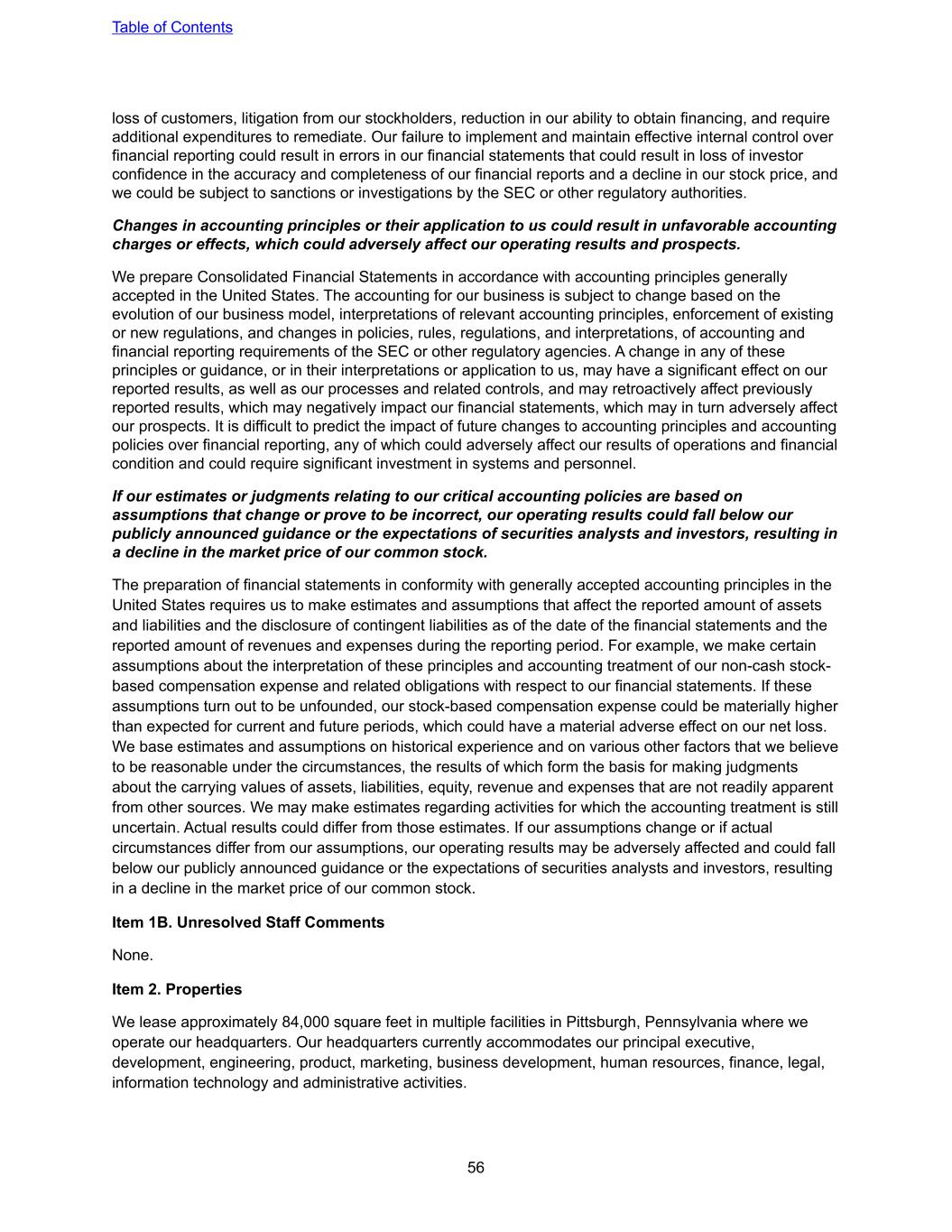
loss of customers, litigation from our stockholders, reduction in our ability to obtain financing, and require additional expenditures to remediate. Our failure to implement and maintain effective internal control over financial reporting could result in errors in our financial statements that could result in loss of investor confidence in the accuracy and completeness of our financial reports and a decline in our stock price, and we could be subject to sanctions or investigations by the SEC or other regulatory authorities. Changes in accounting principles or their application to us could result in unfavorable accounting charges or effects, which could adversely affect our operating results and prospects. We prepare Consolidated Financial Statements in accordance with accounting principles generally accepted in the United States. The accounting for our business is subject to change based on the evolution of our business model, interpretations of relevant accounting principles, enforcement of existing or new regulations, and changes in policies, rules, regulations, and interpretations, of accounting and financial reporting requirements of the SEC or other regulatory agencies. A change in any of these principles or guidance, or in their interpretations or application to us, may have a significant effect on our reported results, as well as our processes and related controls, and may retroactively affect previously reported results, which may negatively impact our financial statements, which may in turn adversely affect our prospects. It is difficult to predict the impact of future changes to accounting principles and accounting policies over financial reporting, any of which could adversely affect our results of operations and financial condition and could require significant investment in systems and personnel. If our estimates or judgments relating to our critical accounting policies are based on assumptions that change or prove to be incorrect, our operating results could fall below our publicly announced guidance or the expectations of securities analysts and investors, resulting in a decline in the market price of our common stock. The preparation of financial statements in conformity with generally accepted accounting principles in the United States requires us to make estimates and assumptions that affect the reported amount of assets and liabilities and the disclosure of contingent liabilities as of the date of the financial statements and the reported amount of revenues and expenses during the reporting period. For example, we make certain assumptions about the interpretation of these principles and accounting treatment of our non-cash stock- based compensation expense and related obligations with respect to our financial statements. If these assumptions turn out to be unfounded, our stock-based compensation expense could be materially higher than expected for current and future periods, which could have a material adverse effect on our net loss. We base estimates and assumptions on historical experience and on various other factors that we believe to be reasonable under the circumstances, the results of which form the basis for making judgments about the carrying values of assets, liabilities, equity, revenue and expenses that are not readily apparent from other sources. We may make estimates regarding activities for which the accounting treatment is still uncertain. Actual results could differ from those estimates. If our assumptions change or if actual circumstances differ from our assumptions, our operating results may be adversely affected and could fall below our publicly announced guidance or the expectations of securities analysts and investors, resulting in a decline in the market price of our common stock. Item 1B. Unresolved Staff Comments None. Item 2. Properties We lease approximately 84,000 square feet in multiple facilities in Pittsburgh, Pennsylvania where we operate our headquarters. Our headquarters currently accommodates our principal executive, development, engineering, product, marketing, business development, human resources, finance, legal, information technology and administrative activities. Table of Contents 56
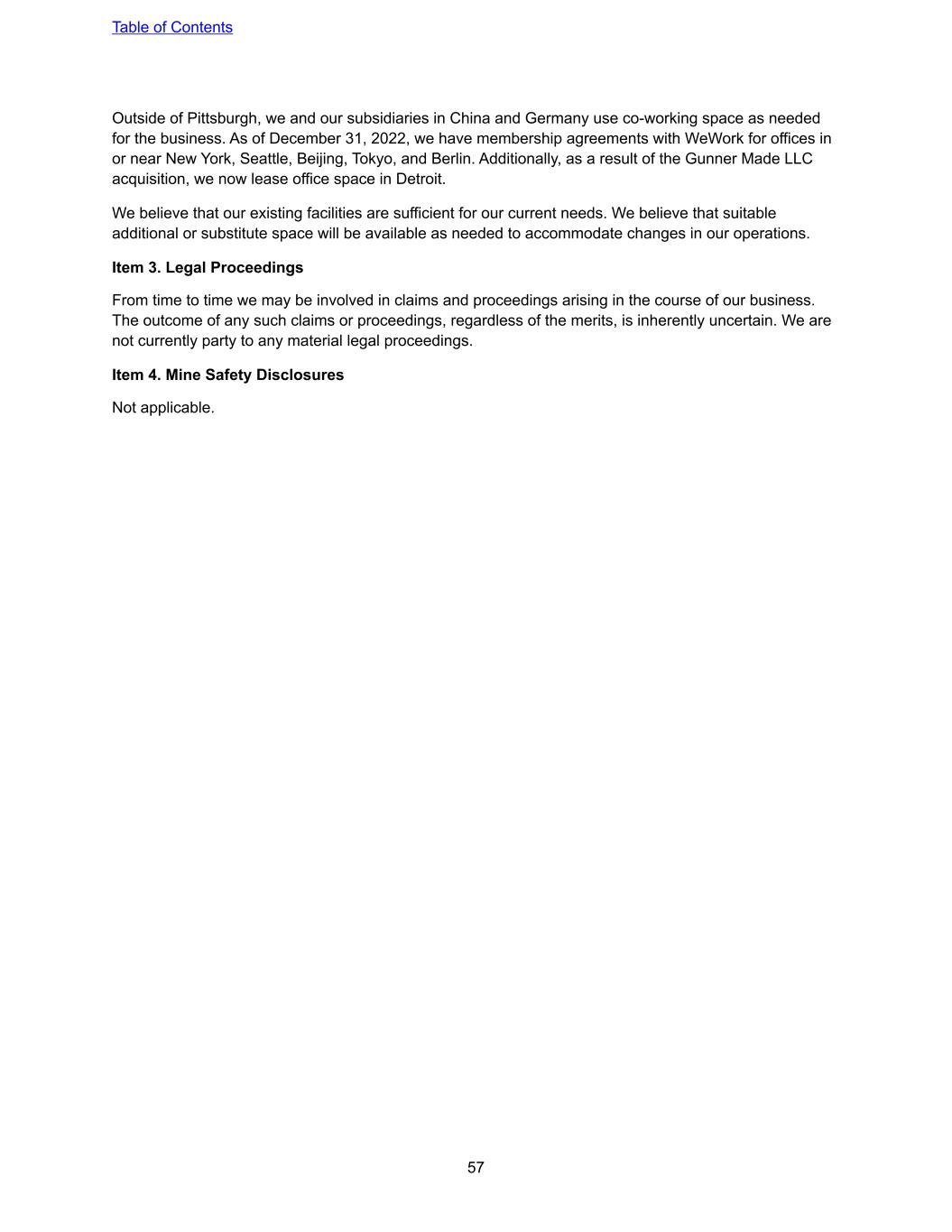
Outside of Pittsburgh, we and our subsidiaries in China and Germany use co-working space as needed for the business. As of December 31, 2022, we have membership agreements with WeWork for offices in or near New York, Seattle, Beijing, Tokyo, and Berlin. Additionally, as a result of the Gunner Made LLC acquisition, we now lease office space in Detroit. We believe that our existing facilities are sufficient for our current needs. We believe that suitable additional or substitute space will be available as needed to accommodate changes in our operations. Item 3. Legal Proceedings From time to time we may be involved in claims and proceedings arising in the course of our business. The outcome of any such claims or proceedings, regardless of the merits, is inherently uncertain. We are not currently party to any material legal proceedings. Item 4. Mine Safety Disclosures Not applicable. Table of Contents 57
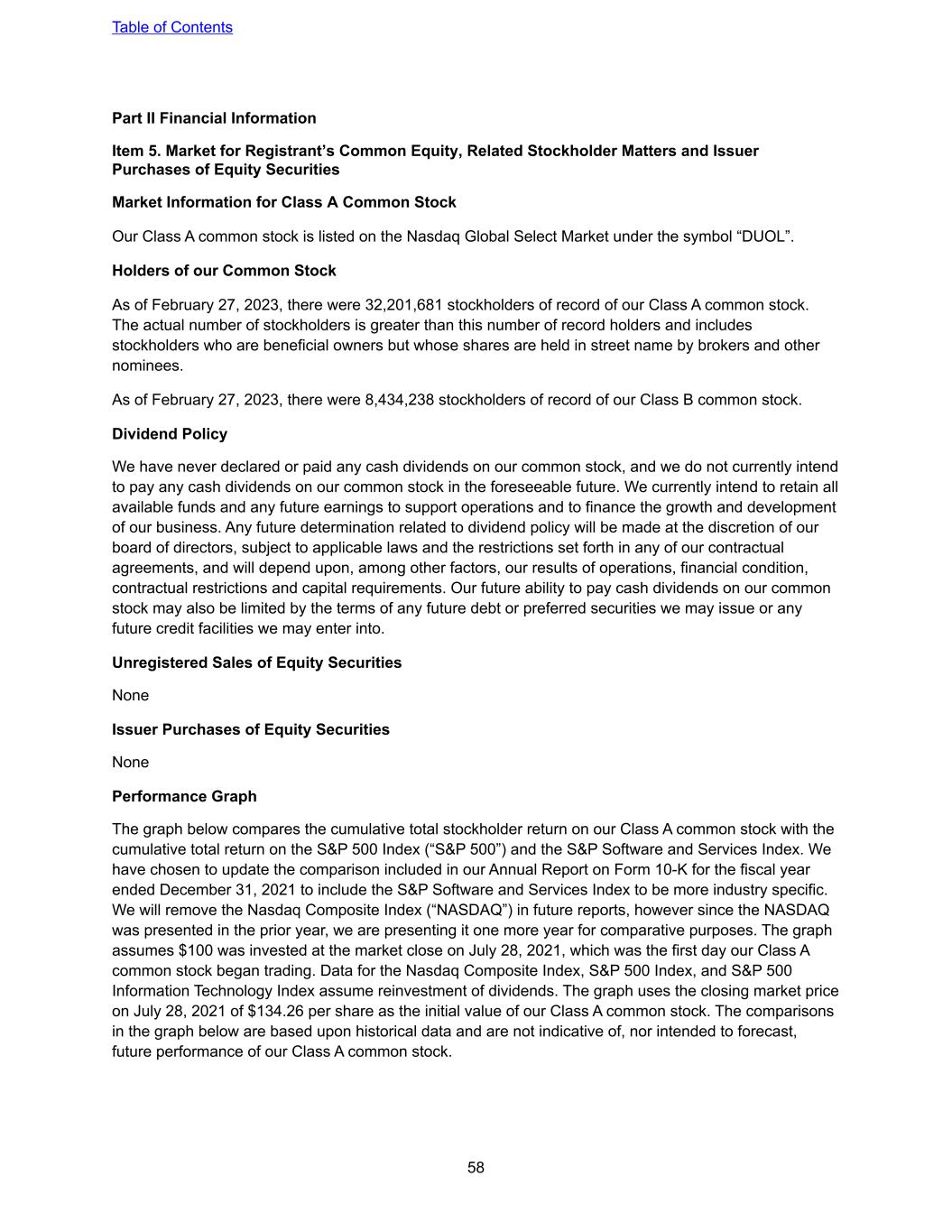
Part II Financial Information Item 5. Market for Registrant’s Common Equity, Related Stockholder Matters and Issuer Purchases of Equity Securities Market Information for Class A Common Stock Our Class A common stock is listed on the Nasdaq Global Select Market under the symbol “DUOL”. Holders of our Common Stock As of February 27, 2023, there were 32,201,681 stockholders of record of our Class A common stock. The actual number of stockholders is greater than this number of record holders and includes stockholders who are beneficial owners but whose shares are held in street name by brokers and other nominees. As of February 27, 2023, there were 8,434,238 stockholders of record of our Class B common stock. Dividend Policy We have never declared or paid any cash dividends on our common stock, and we do not currently intend to pay any cash dividends on our common stock in the foreseeable future. We currently intend to retain all available funds and any future earnings to support operations and to finance the growth and development of our business. Any future determination related to dividend policy will be made at the discretion of our board of directors, subject to applicable laws and the restrictions set forth in any of our contractual agreements, and will depend upon, among other factors, our results of operations, financial condition, contractual restrictions and capital requirements. Our future ability to pay cash dividends on our common stock may also be limited by the terms of any future debt or preferred securities we may issue or any future credit facilities we may enter into. Unregistered Sales of Equity Securities None Issuer Purchases of Equity Securities None Performance Graph The graph below compares the cumulative total stockholder return on our Class A common stock with the cumulative total return on the S&P 500 Index (“S&P 500”) and the S&P Software and Services Index. We have chosen to update the comparison included in our Annual Report on Form 10-K for the fiscal year ended December 31, 2021 to include the S&P Software and Services Index to be more industry specific. We will remove the Nasdaq Composite Index (“NASDAQ”) in future reports, however since the NASDAQ was presented in the prior year, we are presenting it one more year for comparative purposes. The graph assumes $100 was invested at the market close on July 28, 2021, which was the first day our Class A common stock began trading. Data for the Nasdaq Composite Index, S&P 500 Index, and S&P 500 Information Technology Index assume reinvestment of dividends. The graph uses the closing market price on July 28, 2021 of $134.26 per share as the initial value of our Class A common stock. The comparisons in the graph below are based upon historical data and are not indicative of, nor intended to forecast, future performance of our Class A common stock. Table of Contents 58
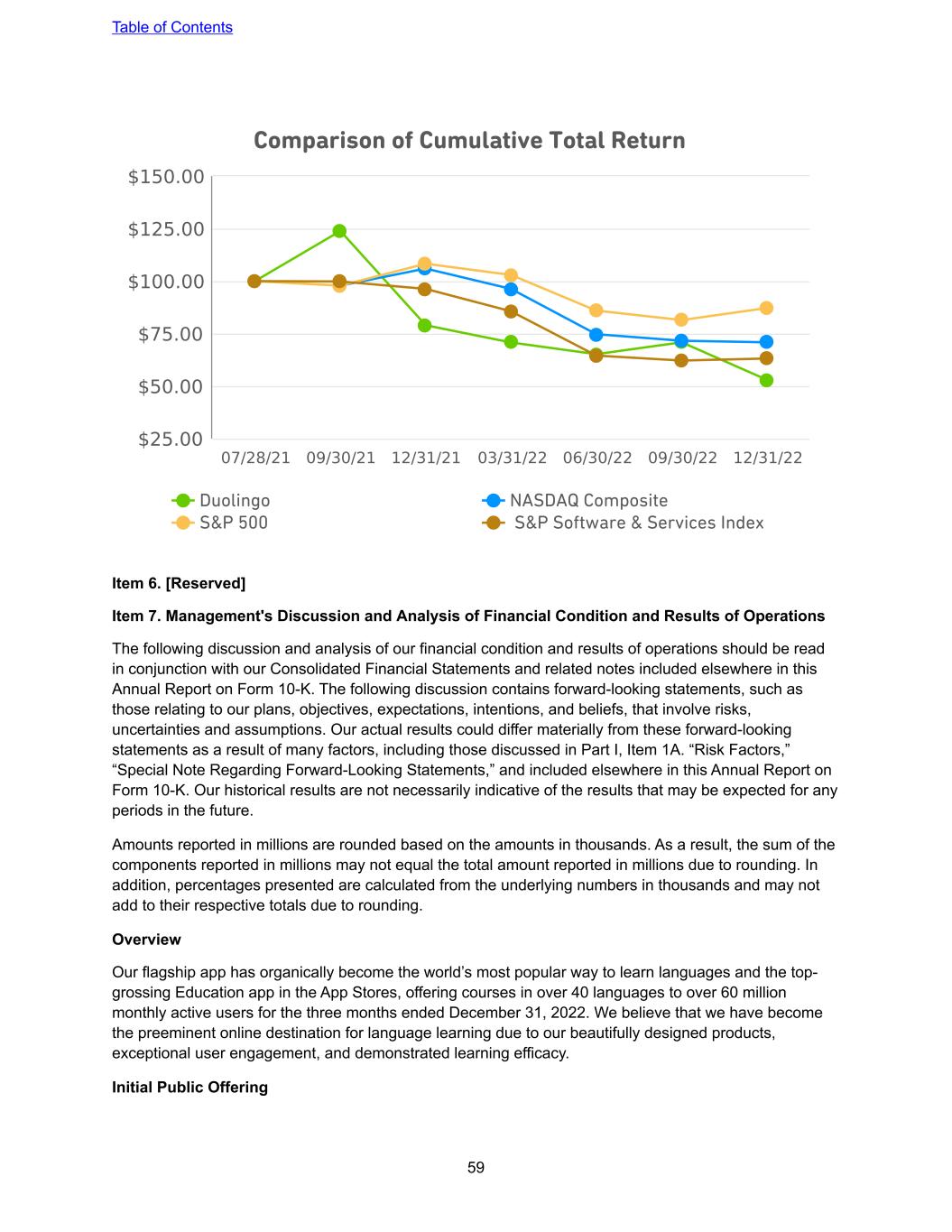
Comparison of Cumulative Total Return Duolingo NASDAQ Composite S&P 500 S&P Software & Services Index Item 6. [Reserved] Item 7. Management's Discussion and Analysis of Financial Condition and Results of Operations The following discussion and analysis of our financial condition and results of operations should be read in conjunction with our Consolidated Financial Statements and related notes included elsewhere in this Annual Report on Form 10-K. The following discussion contains forward-looking statements, such as those relating to our plans, objectives, expectations, intentions, and beliefs, that involve risks, uncertainties and assumptions. Our actual results could differ materially from these forward-looking statements as a result of many factors, including those discussed in Part I, Item 1A. “Risk Factors,” “Special Note Regarding Forward-Looking Statements,” and included elsewhere in this Annual Report on Form 10-K. Our historical results are not necessarily indicative of the results that may be expected for any periods in the future. Amounts reported in millions are rounded based on the amounts in thousands. As a result, the sum of the components reported in millions may not equal the total amount reported in millions due to rounding. In addition, percentages presented are calculated from the underlying numbers in thousands and may not add to their respective totals due to rounding. Overview Our flagship app has organically become the world’s most popular way to learn languages and the top- grossing Education app in the App Stores, offering courses in over 40 languages to over 60 million monthly active users for the three months ended December 31, 2022. We believe that we have become the preeminent online destination for language learning due to our beautifully designed products, exceptional user engagement, and demonstrated learning efficacy. Initial Public Offering Table of Contents 59
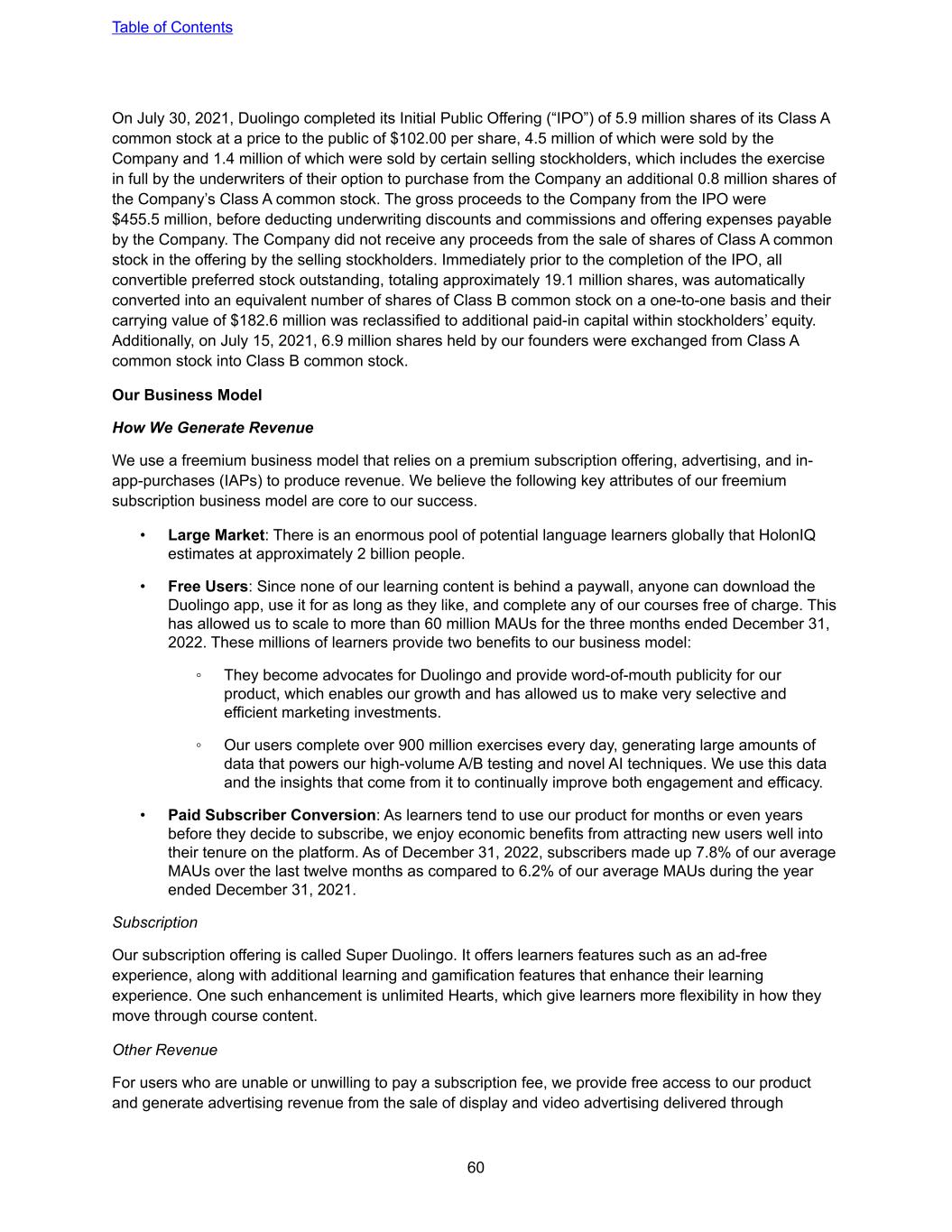
On July 30, 2021, Duolingo completed its Initial Public Offering (“IPO”) of 5.9 million shares of its Class A common stock at a price to the public of $102.00 per share, 4.5 million of which were sold by the Company and 1.4 million of which were sold by certain selling stockholders, which includes the exercise in full by the underwriters of their option to purchase from the Company an additional 0.8 million shares of the Company’s Class A common stock. The gross proceeds to the Company from the IPO were $455.5 million, before deducting underwriting discounts and commissions and offering expenses payable by the Company. The Company did not receive any proceeds from the sale of shares of Class A common stock in the offering by the selling stockholders. Immediately prior to the completion of the IPO, all convertible preferred stock outstanding, totaling approximately 19.1 million shares, was automatically converted into an equivalent number of shares of Class B common stock on a one-to-one basis and their carrying value of $182.6 million was reclassified to additional paid-in capital within stockholders’ equity. Additionally, on July 15, 2021, 6.9 million shares held by our founders were exchanged from Class A common stock into Class B common stock. Our Business Model How We Generate Revenue We use a freemium business model that relies on a premium subscription offering, advertising, and in- app-purchases (IAPs) to produce revenue. We believe the following key attributes of our freemium subscription business model are core to our success. • Large Market: There is an enormous pool of potential language learners globally that HolonIQ estimates at approximately 2 billion people. • Free Users: Since none of our learning content is behind a paywall, anyone can download the Duolingo app, use it for as long as they like, and complete any of our courses free of charge. This has allowed us to scale to more than 60 million MAUs for the three months ended December 31, 2022. These millions of learners provide two benefits to our business model: ◦ They become advocates for Duolingo and provide word-of-mouth publicity for our product, which enables our growth and has allowed us to make very selective and efficient marketing investments. ◦ Our users complete over 900 million exercises every day, generating large amounts of data that powers our high-volume A/B testing and novel AI techniques. We use this data and the insights that come from it to continually improve both engagement and efficacy. • Paid Subscriber Conversion: As learners tend to use our product for months or even years before they decide to subscribe, we enjoy economic benefits from attracting new users well into their tenure on the platform. As of December 31, 2022, subscribers made up 7.8% of our average MAUs over the last twelve months as compared to 6.2% of our average MAUs during the year ended December 31, 2021. Subscription Our subscription offering is called Super Duolingo. It offers learners features such as an ad-free experience, along with additional learning and gamification features that enhance their learning experience. One such enhancement is unlimited Hearts, which give learners more flexibility in how they move through course content. Other Revenue For users who are unable or unwilling to pay a subscription fee, we provide free access to our product and generate advertising revenue from the sale of display and video advertising delivered through Table of Contents 60
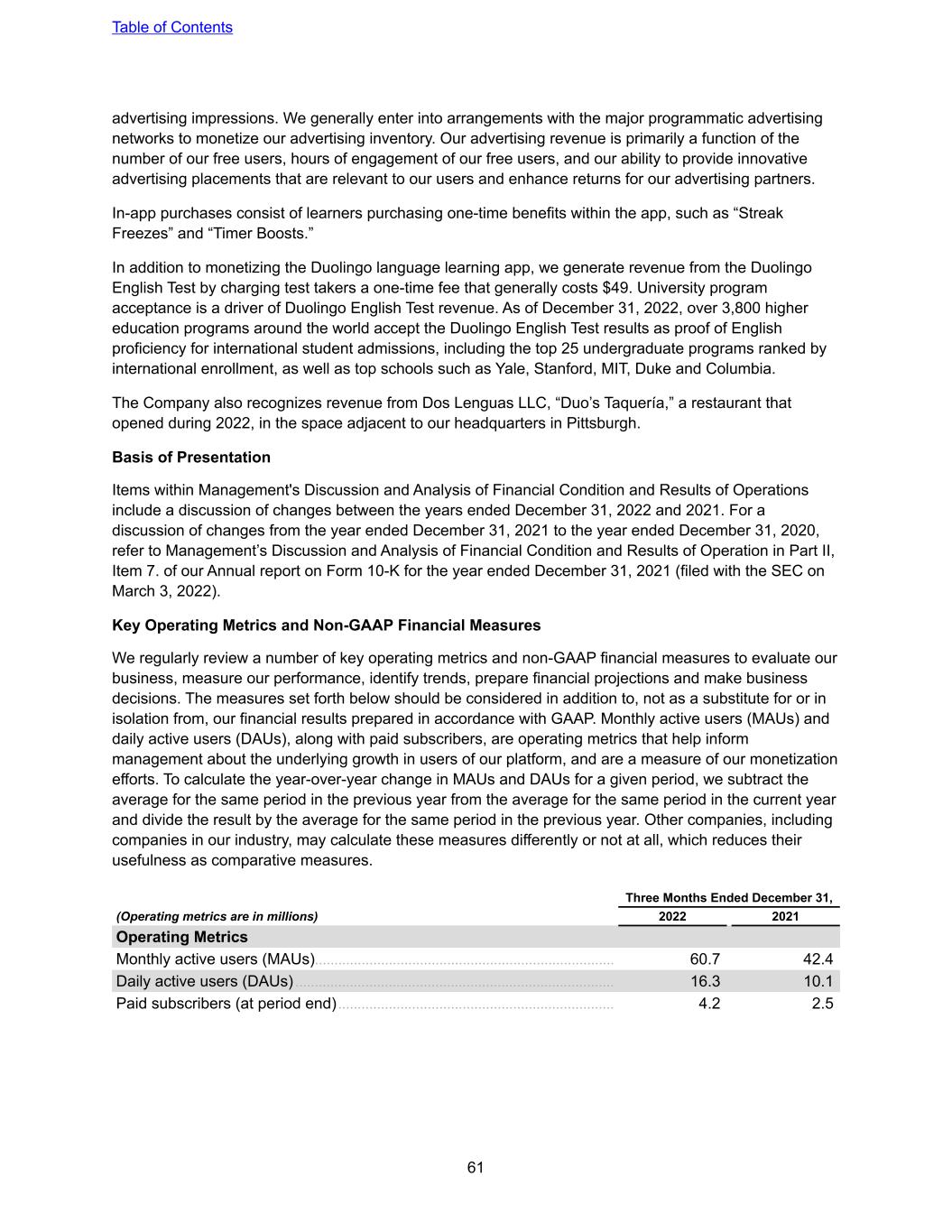
advertising impressions. We generally enter into arrangements with the major programmatic advertising networks to monetize our advertising inventory. Our advertising revenue is primarily a function of the number of our free users, hours of engagement of our free users, and our ability to provide innovative advertising placements that are relevant to our users and enhance returns for our advertising partners. In-app purchases consist of learners purchasing one-time benefits within the app, such as “Streak Freezes” and “Timer Boosts.” In addition to monetizing the Duolingo language learning app, we generate revenue from the Duolingo English Test by charging test takers a one-time fee that generally costs $49. University program acceptance is a driver of Duolingo English Test revenue. As of December 31, 2022, over 3,800 higher education programs around the world accept the Duolingo English Test results as proof of English proficiency for international student admissions, including the top 25 undergraduate programs ranked by international enrollment, as well as top schools such as Yale, Stanford, MIT, Duke and Columbia. The Company also recognizes revenue from Dos Lenguas LLC, “Duo’s Taquería,” a restaurant that opened during 2022, in the space adjacent to our headquarters in Pittsburgh. Basis of Presentation Items within Management's Discussion and Analysis of Financial Condition and Results of Operations include a discussion of changes between the years ended December 31, 2022 and 2021. For a discussion of changes from the year ended December 31, 2021 to the year ended December 31, 2020, refer to Management’s Discussion and Analysis of Financial Condition and Results of Operation in Part II, Item 7. of our Annual report on Form 10-K for the year ended December 31, 2021 (filed with the SEC on March 3, 2022). Key Operating Metrics and Non-GAAP Financial Measures We regularly review a number of key operating metrics and non-GAAP financial measures to evaluate our business, measure our performance, identify trends, prepare financial projections and make business decisions. The measures set forth below should be considered in addition to, not as a substitute for or in isolation from, our financial results prepared in accordance with GAAP. Monthly active users (MAUs) and daily active users (DAUs), along with paid subscribers, are operating metrics that help inform management about the underlying growth in users of our platform, and are a measure of our monetization efforts. To calculate the year-over-year change in MAUs and DAUs for a given period, we subtract the average for the same period in the previous year from the average for the same period in the current year and divide the result by the average for the same period in the previous year. Other companies, including companies in our industry, may calculate these measures differently or not at all, which reduces their usefulness as comparative measures. Three Months Ended December 31, (Operating metrics are in millions) 2022 2021 Operating Metrics Monthly active users (MAUs)............................................................................. 60.7 42.4 Daily active users (DAUs) .................................................................................. 16.3 10.1 Paid subscribers (at period end) ....................................................................... 4.2 2.5 Table of Contents 61
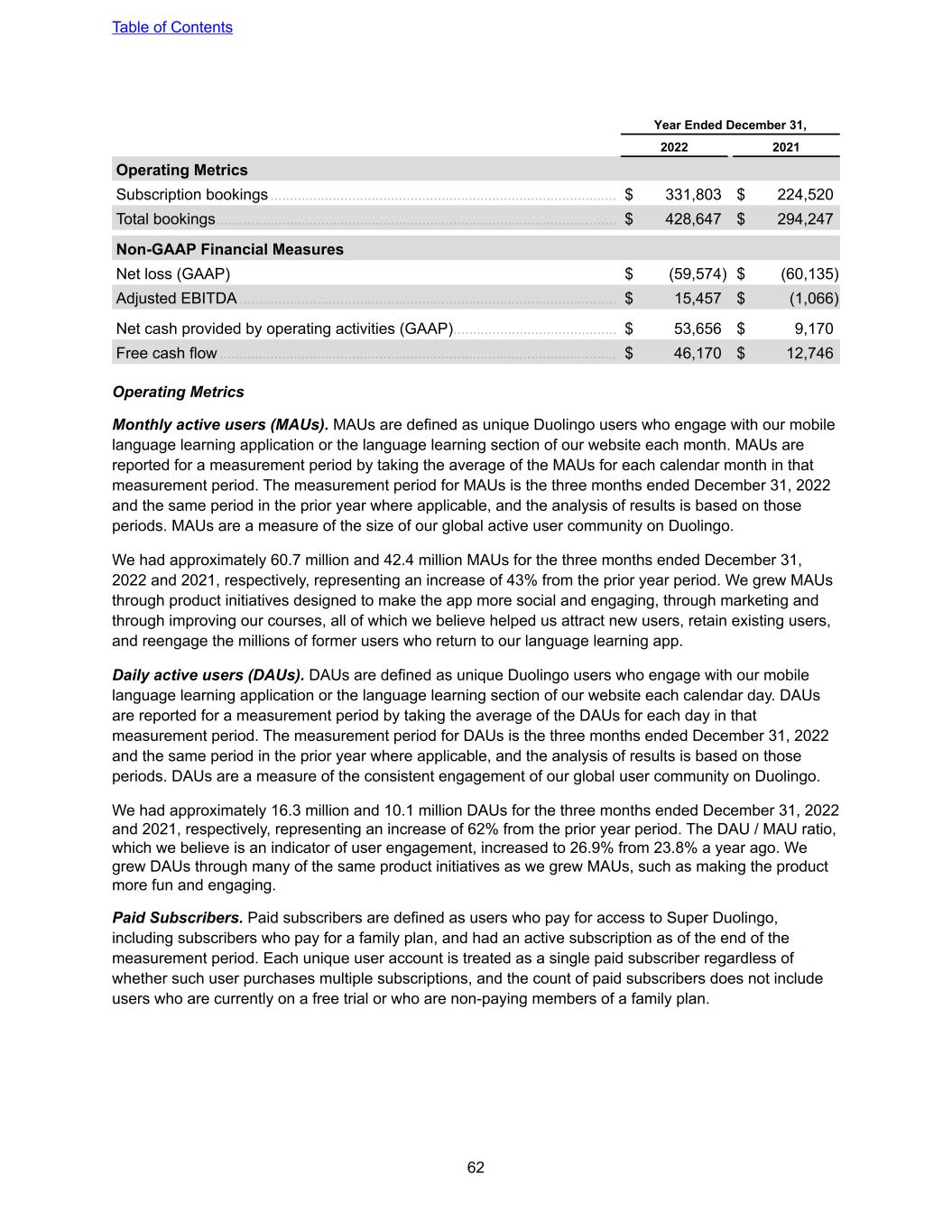
Year Ended December 31, 2022 2021 Operating Metrics Subscription bookings ......................................................................................... $ 331,803 $ 224,520 Total bookings ....................................................................................................... $ 428,647 $ 294,247 Non-GAAP Financial Measures Net loss (GAAP) $ (59,574) $ (60,135) Adjusted EBITDA ................................................................................................. $ 15,457 $ (1,066) Net cash provided by operating activities (GAAP) .......................................... $ 53,656 $ 9,170 Free cash flow ...................................................................................................... $ 46,170 $ 12,746 Operating Metrics Monthly active users (MAUs). MAUs are defined as unique Duolingo users who engage with our mobile language learning application or the language learning section of our website each month. MAUs are reported for a measurement period by taking the average of the MAUs for each calendar month in that measurement period. The measurement period for MAUs is the three months ended December 31, 2022 and the same period in the prior year where applicable, and the analysis of results is based on those periods. MAUs are a measure of the size of our global active user community on Duolingo. We had approximately 60.7 million and 42.4 million MAUs for the three months ended December 31, 2022 and 2021, respectively, representing an increase of 43% from the prior year period. We grew MAUs through product initiatives designed to make the app more social and engaging, through marketing and through improving our courses, all of which we believe helped us attract new users, retain existing users, and reengage the millions of former users who return to our language learning app. Daily active users (DAUs). DAUs are defined as unique Duolingo users who engage with our mobile language learning application or the language learning section of our website each calendar day. DAUs are reported for a measurement period by taking the average of the DAUs for each day in that measurement period. The measurement period for DAUs is the three months ended December 31, 2022 and the same period in the prior year where applicable, and the analysis of results is based on those periods. DAUs are a measure of the consistent engagement of our global user community on Duolingo. We had approximately 16.3 million and 10.1 million DAUs for the three months ended December 31, 2022 and 2021, respectively, representing an increase of 62% from the prior year period. The DAU / MAU ratio, which we believe is an indicator of user engagement, increased to 26.9% from 23.8% a year ago. We grew DAUs through many of the same product initiatives as we grew MAUs, such as making the product more fun and engaging. Paid Subscribers. Paid subscribers are defined as users who pay for access to Super Duolingo, including subscribers who pay for a family plan, and had an active subscription as of the end of the measurement period. Each unique user account is treated as a single paid subscriber regardless of whether such user purchases multiple subscriptions, and the count of paid subscribers does not include users who are currently on a free trial or who are non-paying members of a family plan. Table of Contents 62
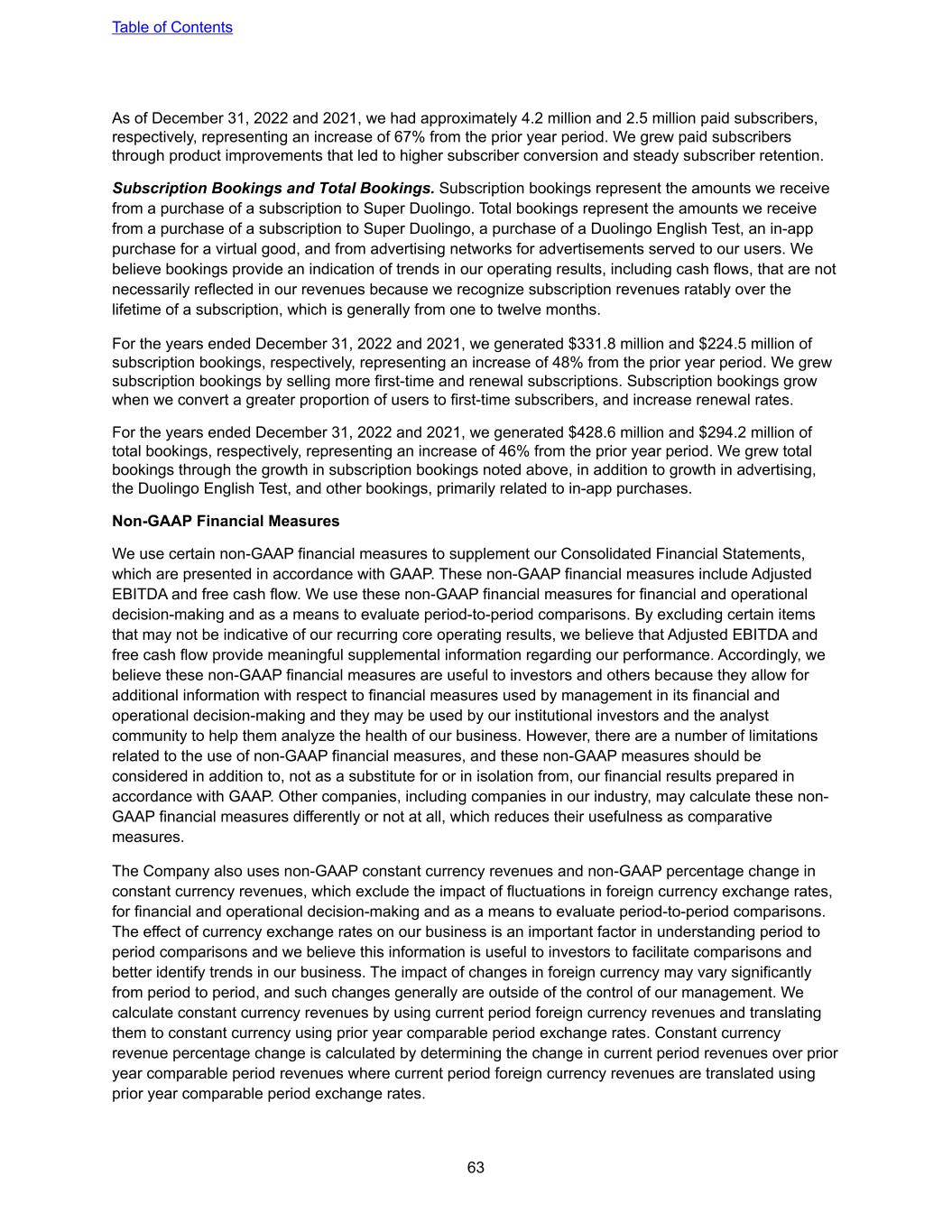
As of December 31, 2022 and 2021, we had approximately 4.2 million and 2.5 million paid subscribers, respectively, representing an increase of 67% from the prior year period. We grew paid subscribers through product improvements that led to higher subscriber conversion and steady subscriber retention. Subscription Bookings and Total Bookings. Subscription bookings represent the amounts we receive from a purchase of a subscription to Super Duolingo. Total bookings represent the amounts we receive from a purchase of a subscription to Super Duolingo, a purchase of a Duolingo English Test, an in-app purchase for a virtual good, and from advertising networks for advertisements served to our users. We believe bookings provide an indication of trends in our operating results, including cash flows, that are not necessarily reflected in our revenues because we recognize subscription revenues ratably over the lifetime of a subscription, which is generally from one to twelve months. For the years ended December 31, 2022 and 2021, we generated $331.8 million and $224.5 million of subscription bookings, respectively, representing an increase of 48% from the prior year period. We grew subscription bookings by selling more first-time and renewal subscriptions. Subscription bookings grow when we convert a greater proportion of users to first-time subscribers, and increase renewal rates. For the years ended December 31, 2022 and 2021, we generated $428.6 million and $294.2 million of total bookings, respectively, representing an increase of 46% from the prior year period. We grew total bookings through the growth in subscription bookings noted above, in addition to growth in advertising, the Duolingo English Test, and other bookings, primarily related to in-app purchases. Non-GAAP Financial Measures We use certain non-GAAP financial measures to supplement our Consolidated Financial Statements, which are presented in accordance with GAAP. These non-GAAP financial measures include Adjusted EBITDA and free cash flow. We use these non-GAAP financial measures for financial and operational decision-making and as a means to evaluate period-to-period comparisons. By excluding certain items that may not be indicative of our recurring core operating results, we believe that Adjusted EBITDA and free cash flow provide meaningful supplemental information regarding our performance. Accordingly, we believe these non-GAAP financial measures are useful to investors and others because they allow for additional information with respect to financial measures used by management in its financial and operational decision-making and they may be used by our institutional investors and the analyst community to help them analyze the health of our business. However, there are a number of limitations related to the use of non-GAAP financial measures, and these non-GAAP measures should be considered in addition to, not as a substitute for or in isolation from, our financial results prepared in accordance with GAAP. Other companies, including companies in our industry, may calculate these non- GAAP financial measures differently or not at all, which reduces their usefulness as comparative measures. The Company also uses non-GAAP constant currency revenues and non-GAAP percentage change in constant currency revenues, which exclude the impact of fluctuations in foreign currency exchange rates, for financial and operational decision-making and as a means to evaluate period-to-period comparisons. The effect of currency exchange rates on our business is an important factor in understanding period to period comparisons and we believe this information is useful to investors to facilitate comparisons and better identify trends in our business. The impact of changes in foreign currency may vary significantly from period to period, and such changes generally are outside of the control of our management. We calculate constant currency revenues by using current period foreign currency revenues and translating them to constant currency using prior year comparable period exchange rates. Constant currency revenue percentage change is calculated by determining the change in current period revenues over prior year comparable period revenues where current period foreign currency revenues are translated using prior year comparable period exchange rates. Table of Contents 63
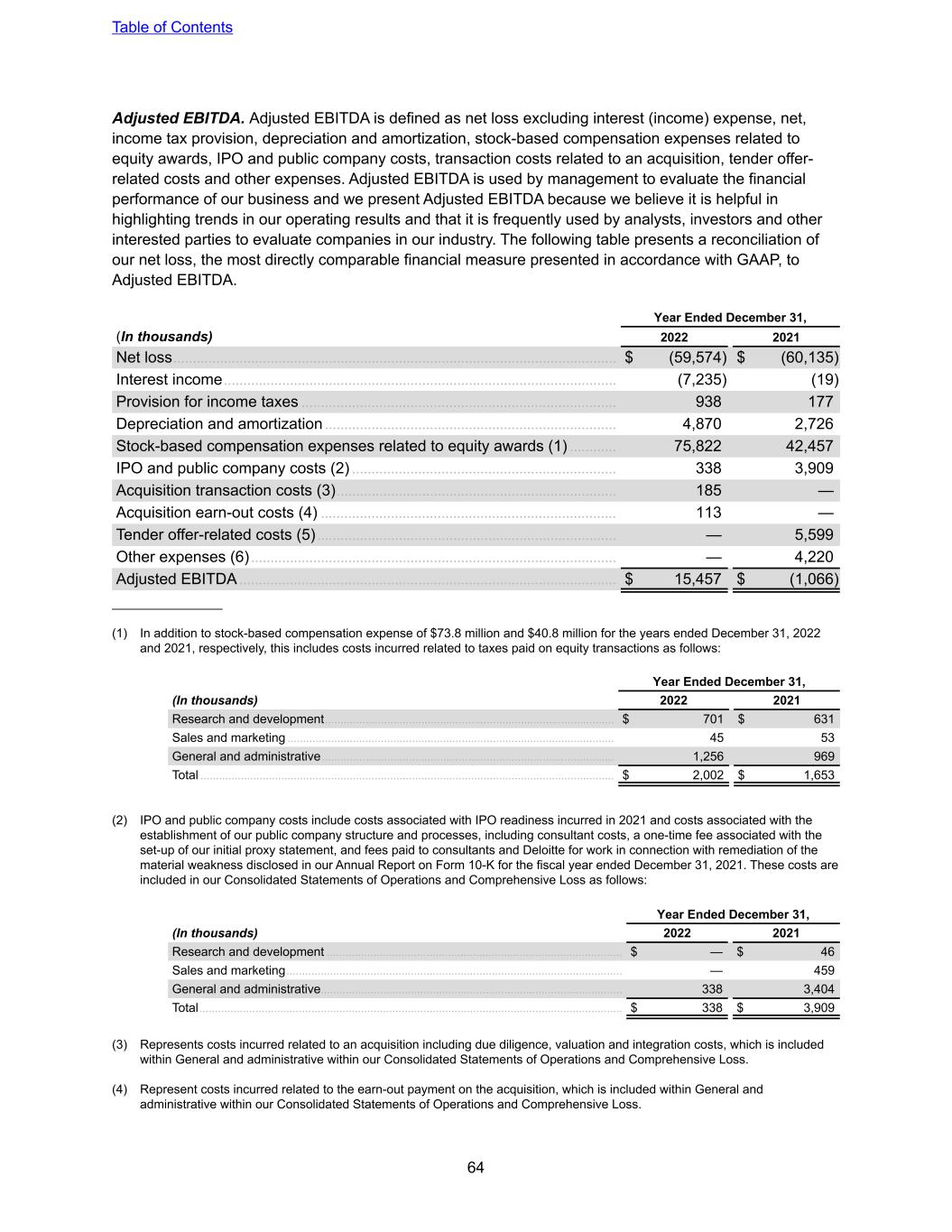
Adjusted EBITDA. Adjusted EBITDA is defined as net loss excluding interest (income) expense, net, income tax provision, depreciation and amortization, stock-based compensation expenses related to equity awards, IPO and public company costs, transaction costs related to an acquisition, tender offer- related costs and other expenses. Adjusted EBITDA is used by management to evaluate the financial performance of our business and we present Adjusted EBITDA because we believe it is helpful in highlighting trends in our operating results and that it is frequently used by analysts, investors and other interested parties to evaluate companies in our industry. The following table presents a reconciliation of our net loss, the most directly comparable financial measure presented in accordance with GAAP, to Adjusted EBITDA. Year Ended December 31, (In thousands) 2022 2021 Net loss .................................................................................................................. $ (59,574) $ (60,135) Interest income ..................................................................................................... (7,235) (19) Provision for income taxes ................................................................................. 938 177 Depreciation and amortization ........................................................................... 4,870 2,726 Stock-based compensation expenses related to equity awards (1) ............ 75,822 42,457 IPO and public company costs (2) .................................................................... 338 3,909 Acquisition transaction costs (3) ........................................................................ 185 — Acquisition earn-out costs (4) ............................................................................ 113 — Tender offer-related costs (5) ............................................................................. — 5,599 Other expenses (6) .............................................................................................. — 4,220 Adjusted EBITDA ................................................................................................. $ 15,457 $ (1,066) ________________ (1) In addition to stock-based compensation expense of $73.8 million and $40.8 million for the years ended December 31, 2022 and 2021, respectively, this includes costs incurred related to taxes paid on equity transactions as follows: Year Ended December 31, (In thousands) 2022 2021 Research and development ............................................................................................. $ 701 $ 631 Sales and marketing ......................................................................................................... 45 53 General and administrative .............................................................................................. 1,256 969 Total ..................................................................................................................................... $ 2,002 $ 1,653 (2) IPO and public company costs include costs associated with IPO readiness incurred in 2021 and costs associated with the establishment of our public company structure and processes, including consultant costs, a one-time fee associated with the set-up of our initial proxy statement, and fees paid to consultants and Deloitte for work in connection with remediation of the material weakness disclosed in our Annual Report on Form 10-K for the fiscal year ended December 31, 2021. These costs are included in our Consolidated Statements of Operations and Comprehensive Loss as follows: Year Ended December 31, (In thousands) 2022 2021 Research and development ............................................................................................... $ — $ 46 Sales and marketing ............................................................................................................ — 459 General and administrative ................................................................................................. 338 3,404 Total ........................................................................................................................................ $ 338 $ 3,909 (3) Represents costs incurred related to an acquisition including due diligence, valuation and integration costs, which is included within General and administrative within our Consolidated Statements of Operations and Comprehensive Loss. (4) Represent costs incurred related to the earn-out payment on the acquisition, which is included within General and administrative within our Consolidated Statements of Operations and Comprehensive Loss. Table of Contents 64
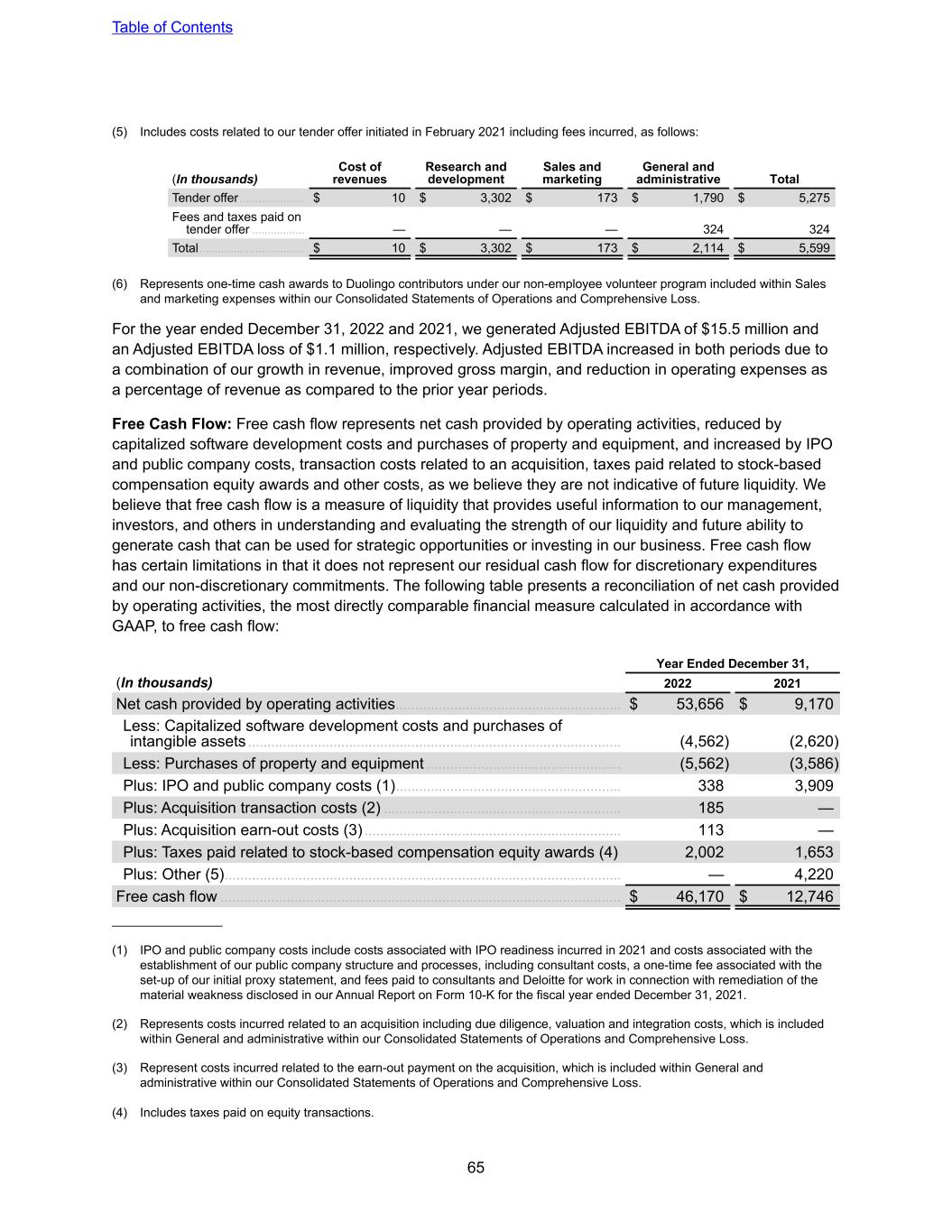
(5) Includes costs related to our tender offer initiated in February 2021 including fees incurred, as follows: (In thousands) Cost of revenues Research and development Sales and marketing General and administrative Total Tender offer ..................... $ 10 $ 3,302 $ 173 $ 1,790 $ 5,275 Fees and taxes paid on tender offer ................. — — — 324 324 Total .................................. $ 10 $ 3,302 $ 173 $ 2,114 $ 5,599 (6) Represents one-time cash awards to Duolingo contributors under our non-employee volunteer program included within Sales and marketing expenses within our Consolidated Statements of Operations and Comprehensive Loss. For the year ended December 31, 2022 and 2021, we generated Adjusted EBITDA of $15.5 million and an Adjusted EBITDA loss of $1.1 million, respectively. Adjusted EBITDA increased in both periods due to a combination of our growth in revenue, improved gross margin, and reduction in operating expenses as a percentage of revenue as compared to the prior year periods. Free Cash Flow: Free cash flow represents net cash provided by operating activities, reduced by capitalized software development costs and purchases of property and equipment, and increased by IPO and public company costs, transaction costs related to an acquisition, taxes paid related to stock-based compensation equity awards and other costs, as we believe they are not indicative of future liquidity. We believe that free cash flow is a measure of liquidity that provides useful information to our management, investors, and others in understanding and evaluating the strength of our liquidity and future ability to generate cash that can be used for strategic opportunities or investing in our business. Free cash flow has certain limitations in that it does not represent our residual cash flow for discretionary expenditures and our non-discretionary commitments. The following table presents a reconciliation of net cash provided by operating activities, the most directly comparable financial measure calculated in accordance with GAAP, to free cash flow: Year Ended December 31, (In thousands) 2022 2021 Net cash provided by operating activities .......................................................... $ 53,656 $ 9,170 Less: Capitalized software development costs and purchases of intangible assets ................................................................................................ (4,562) (2,620) Less: Purchases of property and equipment .................................................. (5,562) (3,586) Plus: IPO and public company costs (1) .......................................................... 338 3,909 Plus: Acquisition transaction costs (2) ............................................................. 185 — Plus: Acquisition earn-out costs (3) .................................................................. 113 — Plus: Taxes paid related to stock-based compensation equity awards (4) 2,002 1,653 Plus: Other (5) ...................................................................................................... — 4,220 Free cash flow ....................................................................................................... $ 46,170 $ 12,746 ________________ (1) IPO and public company costs include costs associated with IPO readiness incurred in 2021 and costs associated with the establishment of our public company structure and processes, including consultant costs, a one-time fee associated with the set-up of our initial proxy statement, and fees paid to consultants and Deloitte for work in connection with remediation of the material weakness disclosed in our Annual Report on Form 10-K for the fiscal year ended December 31, 2021. (2) Represents costs incurred related to an acquisition including due diligence, valuation and integration costs, which is included within General and administrative within our Consolidated Statements of Operations and Comprehensive Loss. (3) Represent costs incurred related to the earn-out payment on the acquisition, which is included within General and administrative within our Consolidated Statements of Operations and Comprehensive Loss. (4) Includes taxes paid on equity transactions. Table of Contents 65
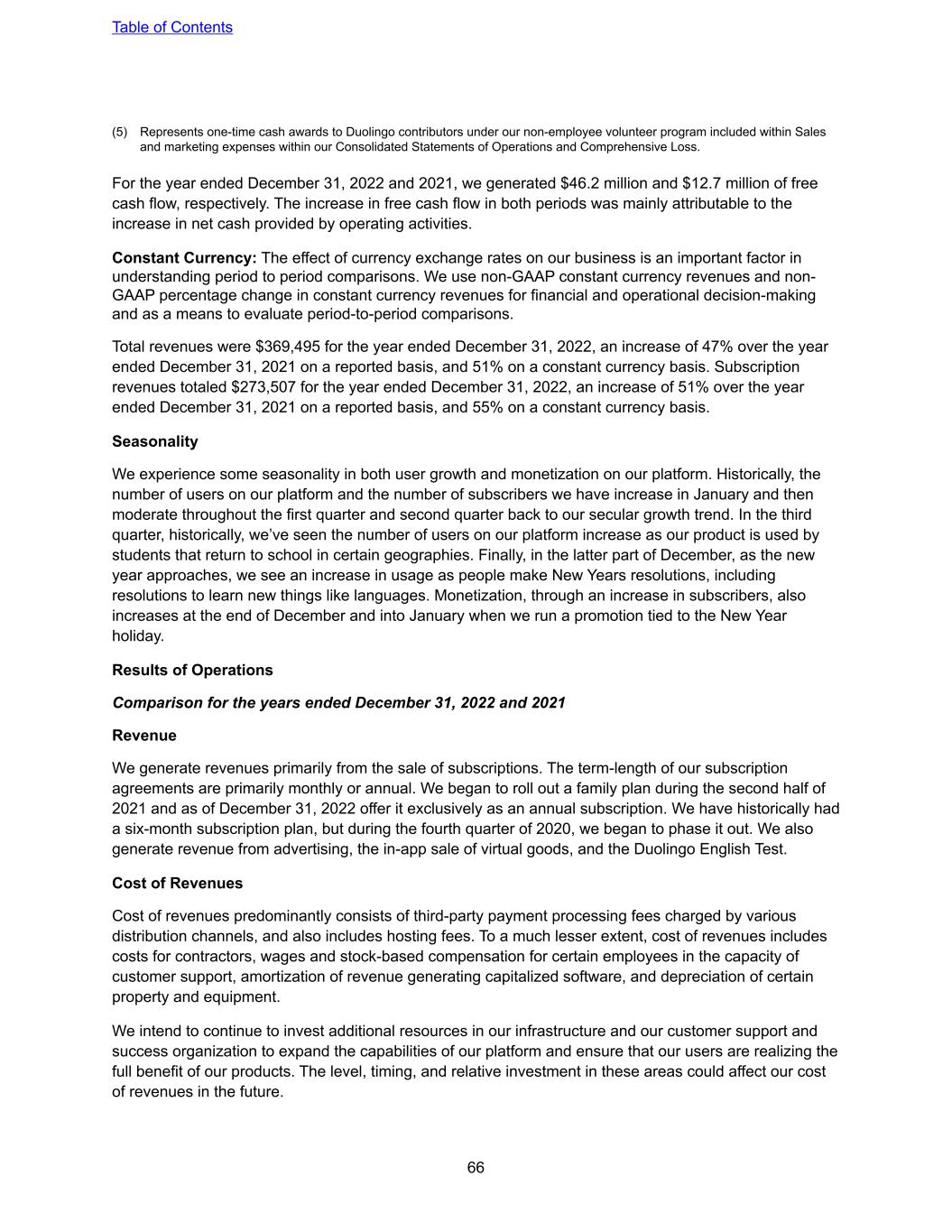
(5) Represents one-time cash awards to Duolingo contributors under our non-employee volunteer program included within Sales and marketing expenses within our Consolidated Statements of Operations and Comprehensive Loss. For the year ended December 31, 2022 and 2021, we generated $46.2 million and $12.7 million of free cash flow, respectively. The increase in free cash flow in both periods was mainly attributable to the increase in net cash provided by operating activities. Constant Currency: The effect of currency exchange rates on our business is an important factor in understanding period to period comparisons. We use non-GAAP constant currency revenues and non- GAAP percentage change in constant currency revenues for financial and operational decision-making and as a means to evaluate period-to-period comparisons. Total revenues were $369,495 for the year ended December 31, 2022, an increase of 47% over the year ended December 31, 2021 on a reported basis, and 51% on a constant currency basis. Subscription revenues totaled $273,507 for the year ended December 31, 2022, an increase of 51% over the year ended December 31, 2021 on a reported basis, and 55% on a constant currency basis. Seasonality We experience some seasonality in both user growth and monetization on our platform. Historically, the number of users on our platform and the number of subscribers we have increase in January and then moderate throughout the first quarter and second quarter back to our secular growth trend. In the third quarter, historically, we’ve seen the number of users on our platform increase as our product is used by students that return to school in certain geographies. Finally, in the latter part of December, as the new year approaches, we see an increase in usage as people make New Years resolutions, including resolutions to learn new things like languages. Monetization, through an increase in subscribers, also increases at the end of December and into January when we run a promotion tied to the New Year holiday. Results of Operations Comparison for the years ended December 31, 2022 and 2021 Revenue We generate revenues primarily from the sale of subscriptions. The term-length of our subscription agreements are primarily monthly or annual. We began to roll out a family plan during the second half of 2021 and as of December 31, 2022 offer it exclusively as an annual subscription. We have historically had a six-month subscription plan, but during the fourth quarter of 2020, we began to phase it out. We also generate revenue from advertising, the in-app sale of virtual goods, and the Duolingo English Test. Cost of Revenues Cost of revenues predominantly consists of third-party payment processing fees charged by various distribution channels, and also includes hosting fees. To a much lesser extent, cost of revenues includes costs for contractors, wages and stock-based compensation for certain employees in the capacity of customer support, amortization of revenue generating capitalized software, and depreciation of certain property and equipment. We intend to continue to invest additional resources in our infrastructure and our customer support and success organization to expand the capabilities of our platform and ensure that our users are realizing the full benefit of our products. The level, timing, and relative investment in these areas could affect our cost of revenues in the future. Table of Contents 66
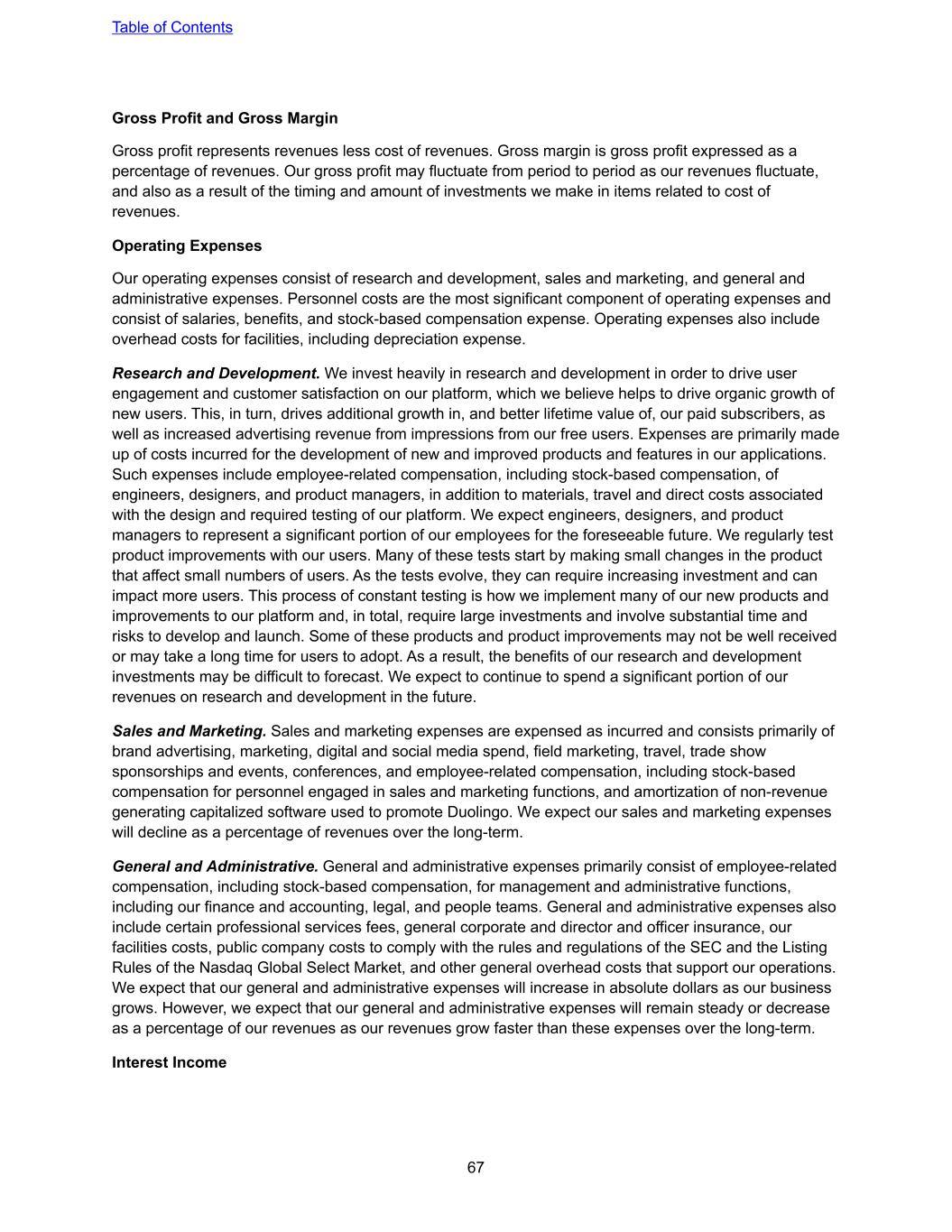
Gross Profit and Gross Margin Gross profit represents revenues less cost of revenues. Gross margin is gross profit expressed as a percentage of revenues. Our gross profit may fluctuate from period to period as our revenues fluctuate, and also as a result of the timing and amount of investments we make in items related to cost of revenues. Operating Expenses Our operating expenses consist of research and development, sales and marketing, and general and administrative expenses. Personnel costs are the most significant component of operating expenses and consist of salaries, benefits, and stock-based compensation expense. Operating expenses also include overhead costs for facilities, including depreciation expense. Research and Development. We invest heavily in research and development in order to drive user engagement and customer satisfaction on our platform, which we believe helps to drive organic growth of new users. This, in turn, drives additional growth in, and better lifetime value of, our paid subscribers, as well as increased advertising revenue from impressions from our free users. Expenses are primarily made up of costs incurred for the development of new and improved products and features in our applications. Such expenses include employee-related compensation, including stock-based compensation, of engineers, designers, and product managers, in addition to materials, travel and direct costs associated with the design and required testing of our platform. We expect engineers, designers, and product managers to represent a significant portion of our employees for the foreseeable future. We regularly test product improvements with our users. Many of these tests start by making small changes in the product that affect small numbers of users. As the tests evolve, they can require increasing investment and can impact more users. This process of constant testing is how we implement many of our new products and improvements to our platform and, in total, require large investments and involve substantial time and risks to develop and launch. Some of these products and product improvements may not be well received or may take a long time for users to adopt. As a result, the benefits of our research and development investments may be difficult to forecast. We expect to continue to spend a significant portion of our revenues on research and development in the future. Sales and Marketing. Sales and marketing expenses are expensed as incurred and consists primarily of brand advertising, marketing, digital and social media spend, field marketing, travel, trade show sponsorships and events, conferences, and employee-related compensation, including stock-based compensation for personnel engaged in sales and marketing functions, and amortization of non-revenue generating capitalized software used to promote Duolingo. We expect our sales and marketing expenses will decline as a percentage of revenues over the long-term. General and Administrative. General and administrative expenses primarily consist of employee-related compensation, including stock-based compensation, for management and administrative functions, including our finance and accounting, legal, and people teams. General and administrative expenses also include certain professional services fees, general corporate and director and officer insurance, our facilities costs, public company costs to comply with the rules and regulations of the SEC and the Listing Rules of the Nasdaq Global Select Market, and other general overhead costs that support our operations. We expect that our general and administrative expenses will increase in absolute dollars as our business grows. However, we expect that our general and administrative expenses will remain steady or decrease as a percentage of our revenues as our revenues grow faster than these expenses over the long-term. Interest Income Table of Contents 67
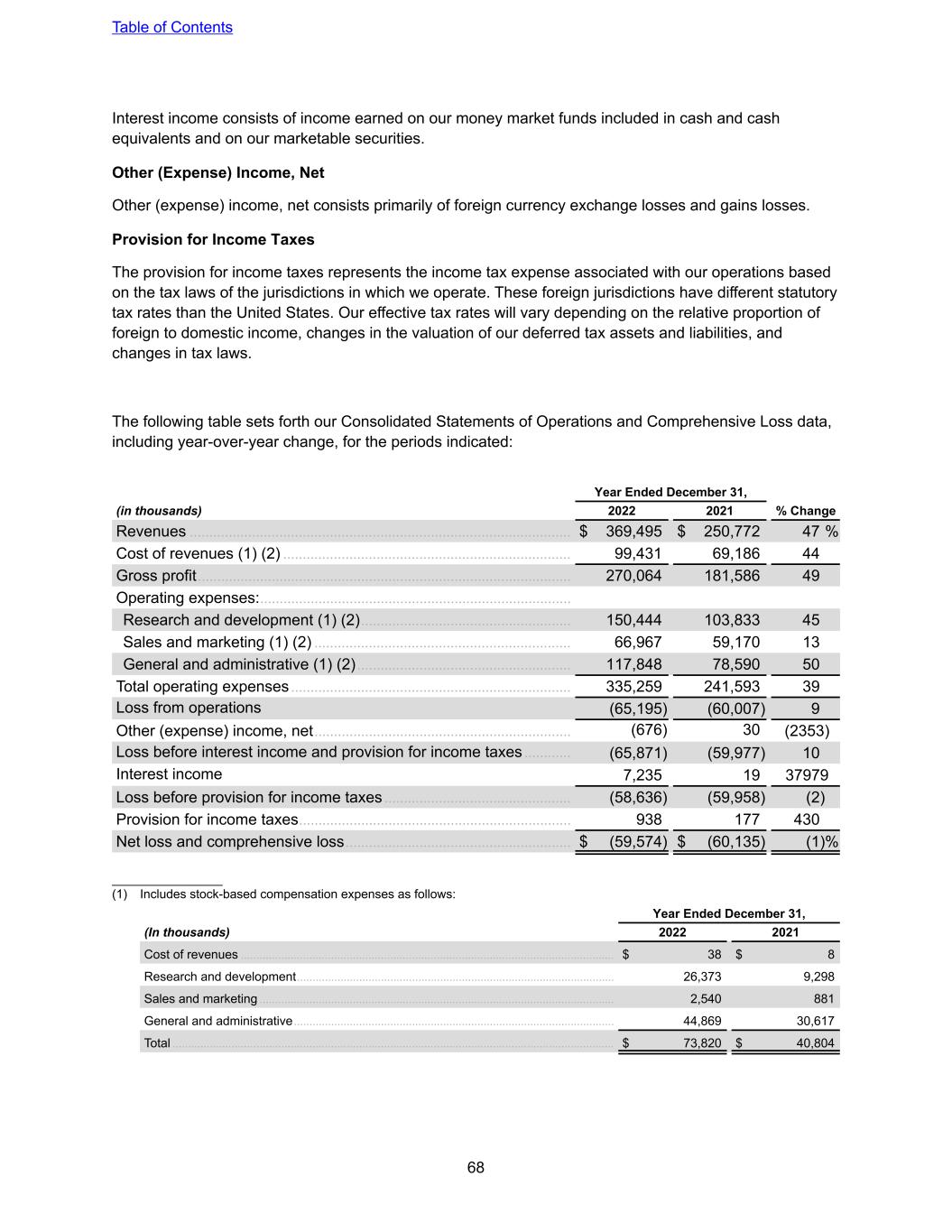
Interest income consists of income earned on our money market funds included in cash and cash equivalents and on our marketable securities. Other (Expense) Income, Net Other (expense) income, net consists primarily of foreign currency exchange losses and gains losses. Provision for Income Taxes The provision for income taxes represents the income tax expense associated with our operations based on the tax laws of the jurisdictions in which we operate. These foreign jurisdictions have different statutory tax rates than the United States. Our effective tax rates will vary depending on the relative proportion of foreign to domestic income, changes in the valuation of our deferred tax assets and liabilities, and changes in tax laws. The following table sets forth our Consolidated Statements of Operations and Comprehensive Loss data, including year-over-year change, for the periods indicated: Year Ended December 31, (in thousands) 2022 2021 % Change Revenues .................................................................................................. $ 369,495 $ 250,772 47 % Cost of revenues (1) (2) .......................................................................... 99,431 69,186 44 Gross profit ................................................................................................ 270,064 181,586 49 Operating expenses: ................................................................................ Research and development (1) (2) ...................................................... 150,444 103,833 45 Sales and marketing (1) (2) .................................................................. 66,967 59,170 13 General and administrative (1) (2) ....................................................... 117,848 78,590 50 Total operating expenses ........................................................................ 335,259 241,593 39 Loss from operations (65,195) (60,007) 9 Other (expense) income, net .................................................................. (676) 30 (2353) Loss before interest income and provision for income taxes ............ (65,871) (59,977) 10 Interest income 7,235 19 37979 Loss before provision for income taxes ................................................ (58,636) (59,958) (2) Provision for income taxes ...................................................................... 938 177 430 Net loss and comprehensive loss .......................................................... $ (59,574) $ (60,135) (1) % ________________ (1) Includes stock-based compensation expenses as follows: Year Ended December 31, (In thousands) 2022 2021 Cost of revenues ........................................................................................................................ $ 38 $ 8 Research and development ...................................................................................................... 26,373 9,298 Sales and marketing .................................................................................................................. 2,540 881 General and administrative ....................................................................................................... 44,869 30,617 Total .............................................................................................................................................. $ 73,820 $ 40,804 Table of Contents 68
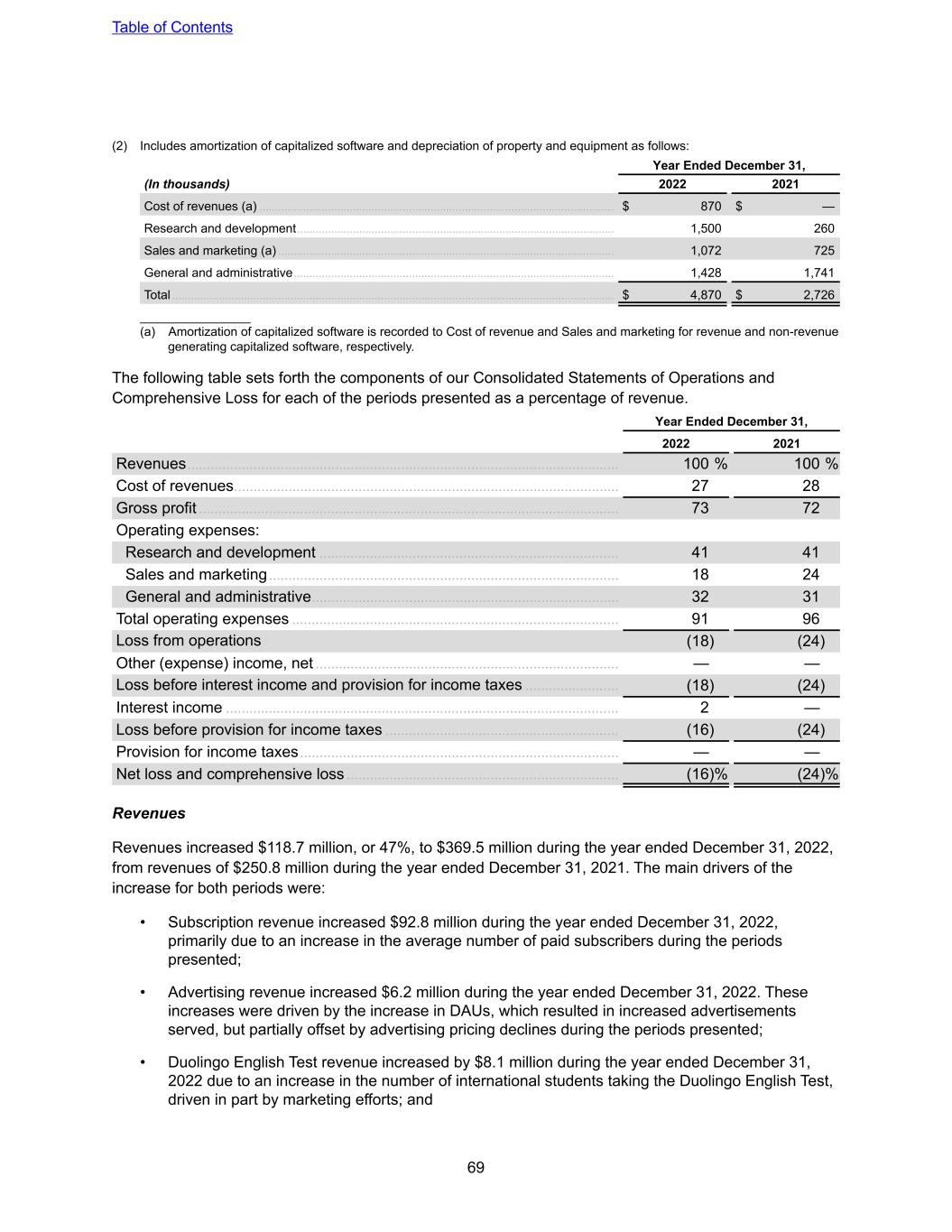
(2) Includes amortization of capitalized software and depreciation of property and equipment as follows: Year Ended December 31, (In thousands) 2022 2021 Cost of revenues (a) .................................................................................................................. $ 870 $ — Research and development ...................................................................................................... 1,500 260 Sales and marketing (a) ............................................................................................................ 1,072 725 General and administrative ....................................................................................................... 1,428 1,741 Total .............................................................................................................................................. $ 4,870 $ 2,726 ________________ (a) Amortization of capitalized software is recorded to Cost of revenue and Sales and marketing for revenue and non-revenue generating capitalized software, respectively. The following table sets forth the components of our Consolidated Statements of Operations and Comprehensive Loss for each of the periods presented as a percentage of revenue. Year Ended December 31, 2022 2021 Revenues ............................................................................................................... 100 % 100 % Cost of revenues ................................................................................................... 27 28 Gross profit ............................................................................................................ 73 72 Operating expenses: Research and development ............................................................................. 41 41 Sales and marketing .......................................................................................... 18 24 General and administrative ............................................................................... 32 31 Total operating expenses .................................................................................... 91 96 Loss from operations (18) (24) Other (expense) income, net .............................................................................. — — Loss before interest income and provision for income taxes ........................ (18) (24) Interest income ..................................................................................................... 2 — Loss before provision for income taxes ............................................................ (16) (24) Provision for income taxes .................................................................................. — — Net loss and comprehensive loss ...................................................................... (16) % (24) % Revenues Revenues increased $118.7 million, or 47%, to $369.5 million during the year ended December 31, 2022, from revenues of $250.8 million during the year ended December 31, 2021. The main drivers of the increase for both periods were: • Subscription revenue increased $92.8 million during the year ended December 31, 2022, primarily due to an increase in the average number of paid subscribers during the periods presented; • Advertising revenue increased $6.2 million during the year ended December 31, 2022. These increases were driven by the increase in DAUs, which resulted in increased advertisements served, but partially offset by advertising pricing declines during the periods presented; • Duolingo English Test revenue increased by $8.1 million during the year ended December 31, 2022 due to an increase in the number of international students taking the Duolingo English Test, driven in part by marketing efforts; and Table of Contents 69
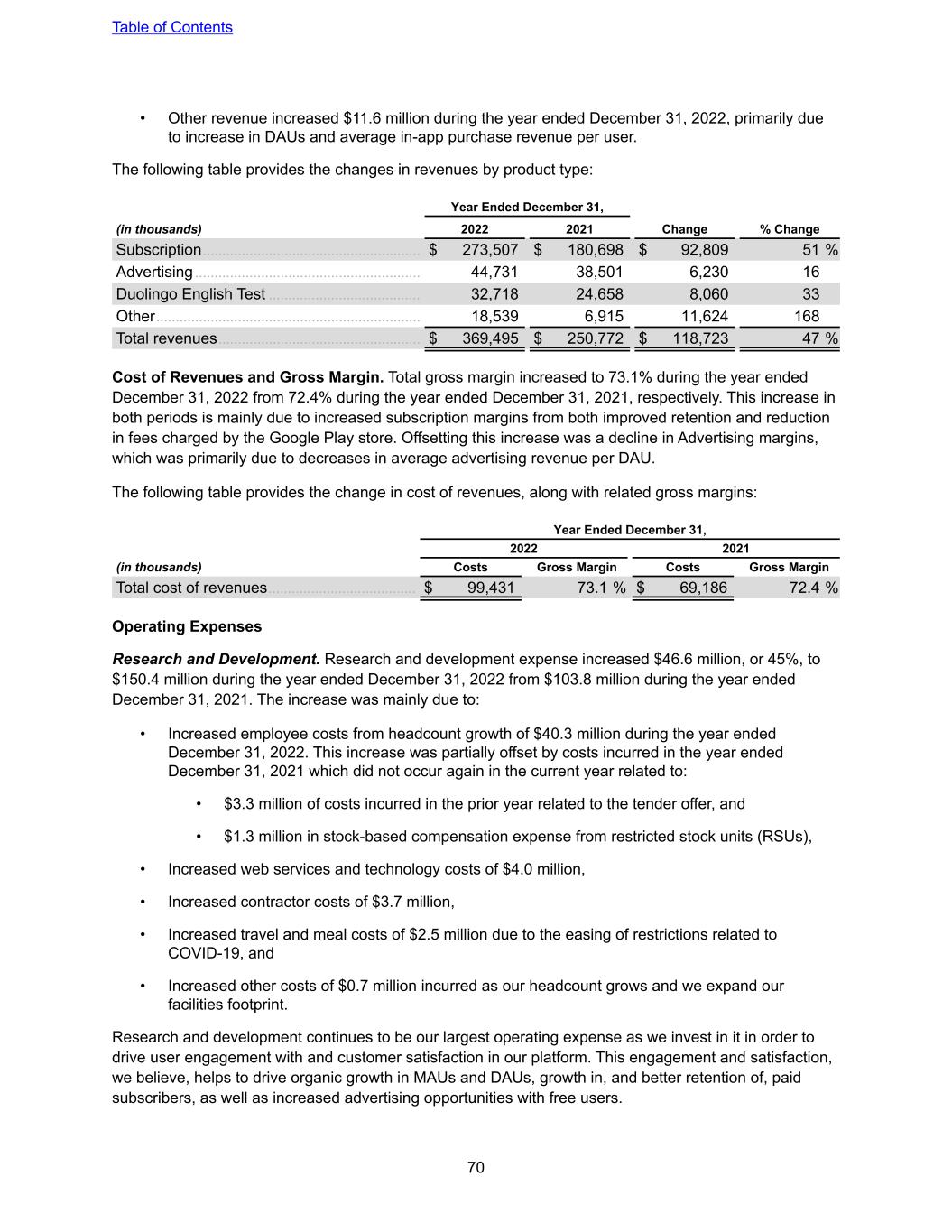
• Other revenue increased $11.6 million during the year ended December 31, 2022, primarily due to increase in DAUs and average in-app purchase revenue per user. The following table provides the changes in revenues by product type: Year Ended December 31, (in thousands) 2022 2021 Change % Change Subscription ........................................................ $ 273,507 $ 180,698 $ 92,809 51 % Advertising .......................................................... 44,731 38,501 6,230 16 Duolingo English Test ....................................... 32,718 24,658 8,060 33 Other .................................................................... 18,539 6,915 11,624 168 Total revenues .................................................... $ 369,495 $ 250,772 $ 118,723 47 % Cost of Revenues and Gross Margin. Total gross margin increased to 73.1% during the year ended December 31, 2022 from 72.4% during the year ended December 31, 2021, respectively. This increase in both periods is mainly due to increased subscription margins from both improved retention and reduction in fees charged by the Google Play store. Offsetting this increase was a decline in Advertising margins, which was primarily due to decreases in average advertising revenue per DAU. The following table provides the change in cost of revenues, along with related gross margins: Year Ended December 31, 2022 2021 (in thousands) Costs Gross Margin Costs Gross Margin Total cost of revenues ...................................... $ 99,431 73.1 % $ 69,186 72.4 % Operating Expenses Research and Development. Research and development expense increased $46.6 million, or 45%, to $150.4 million during the year ended December 31, 2022 from $103.8 million during the year ended December 31, 2021. The increase was mainly due to: • Increased employee costs from headcount growth of $40.3 million during the year ended December 31, 2022. This increase was partially offset by costs incurred in the year ended December 31, 2021 which did not occur again in the current year related to: • $3.3 million of costs incurred in the prior year related to the tender offer, and • $1.3 million in stock-based compensation expense from restricted stock units (RSUs), • Increased web services and technology costs of $4.0 million, • Increased contractor costs of $3.7 million, • Increased travel and meal costs of $2.5 million due to the easing of restrictions related to COVID-19, and • Increased other costs of $0.7 million incurred as our headcount grows and we expand our facilities footprint. Research and development continues to be our largest operating expense as we invest in it in order to drive user engagement with and customer satisfaction in our platform. This engagement and satisfaction, we believe, helps to drive organic growth in MAUs and DAUs, growth in, and better retention of, paid subscribers, as well as increased advertising opportunities with free users. Table of Contents 70
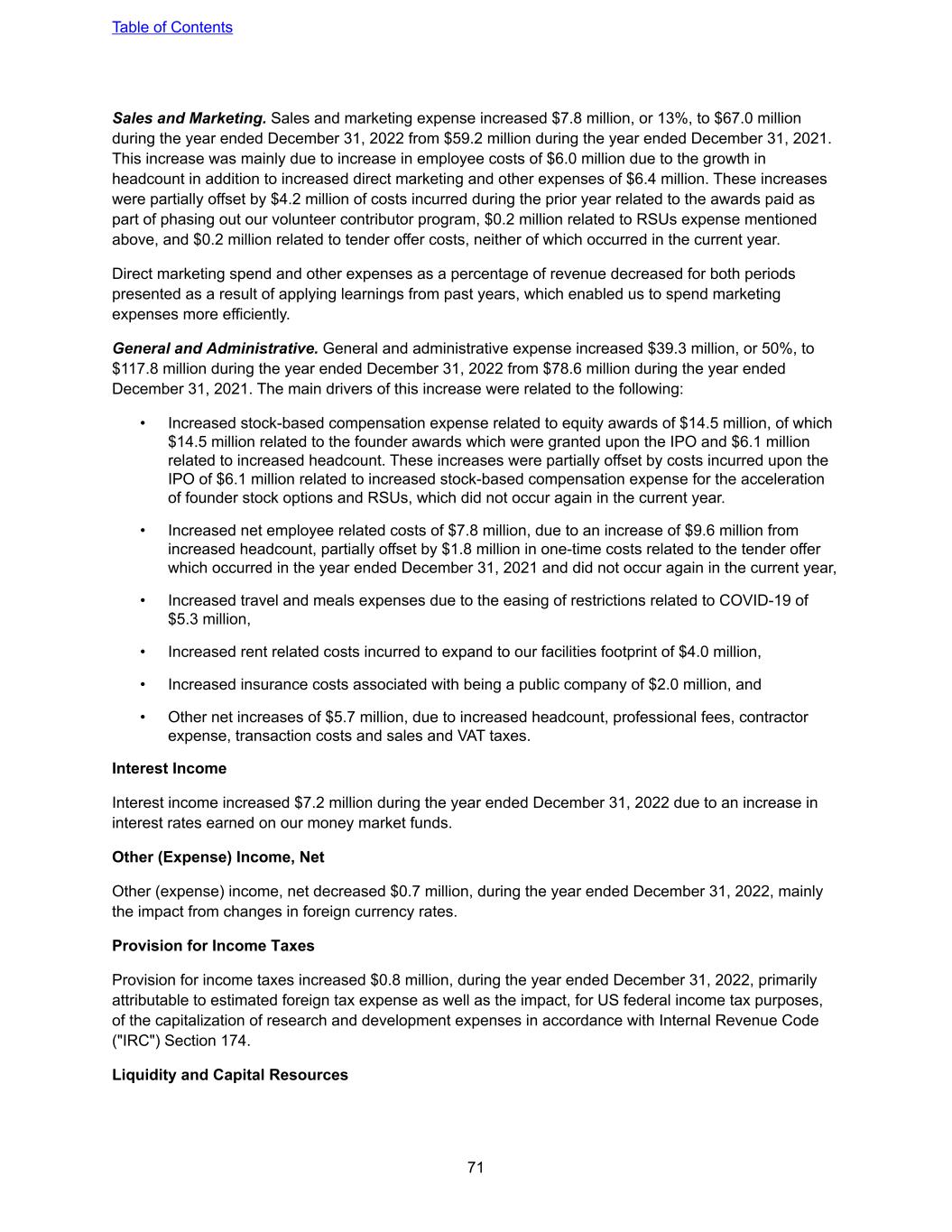
Sales and Marketing. Sales and marketing expense increased $7.8 million, or 13%, to $67.0 million during the year ended December 31, 2022 from $59.2 million during the year ended December 31, 2021. This increase was mainly due to increase in employee costs of $6.0 million due to the growth in headcount in addition to increased direct marketing and other expenses of $6.4 million. These increases were partially offset by $4.2 million of costs incurred during the prior year related to the awards paid as part of phasing out our volunteer contributor program, $0.2 million related to RSUs expense mentioned above, and $0.2 million related to tender offer costs, neither of which occurred in the current year. Direct marketing spend and other expenses as a percentage of revenue decreased for both periods presented as a result of applying learnings from past years, which enabled us to spend marketing expenses more efficiently. General and Administrative. General and administrative expense increased $39.3 million, or 50%, to $117.8 million during the year ended December 31, 2022 from $78.6 million during the year ended December 31, 2021. The main drivers of this increase were related to the following: • Increased stock-based compensation expense related to equity awards of $14.5 million, of which $14.5 million related to the founder awards which were granted upon the IPO and $6.1 million related to increased headcount. These increases were partially offset by costs incurred upon the IPO of $6.1 million related to increased stock-based compensation expense for the acceleration of founder stock options and RSUs, which did not occur again in the current year. • Increased net employee related costs of $7.8 million, due to an increase of $9.6 million from increased headcount, partially offset by $1.8 million in one-time costs related to the tender offer which occurred in the year ended December 31, 2021 and did not occur again in the current year, • Increased travel and meals expenses due to the easing of restrictions related to COVID-19 of $5.3 million, • Increased rent related costs incurred to expand to our facilities footprint of $4.0 million, • Increased insurance costs associated with being a public company of $2.0 million, and • Other net increases of $5.7 million, due to increased headcount, professional fees, contractor expense, transaction costs and sales and VAT taxes. Interest Income Interest income increased $7.2 million during the year ended December 31, 2022 due to an increase in interest rates earned on our money market funds. Other (Expense) Income, Net Other (expense) income, net decreased $0.7 million, during the year ended December 31, 2022, mainly the impact from changes in foreign currency rates. Provision for Income Taxes Provision for income taxes increased $0.8 million, during the year ended December 31, 2022, primarily attributable to estimated foreign tax expense as well as the impact, for US federal income tax purposes, of the capitalization of research and development expenses in accordance with Internal Revenue Code ("IRC") Section 174. Liquidity and Capital Resources Table of Contents 71
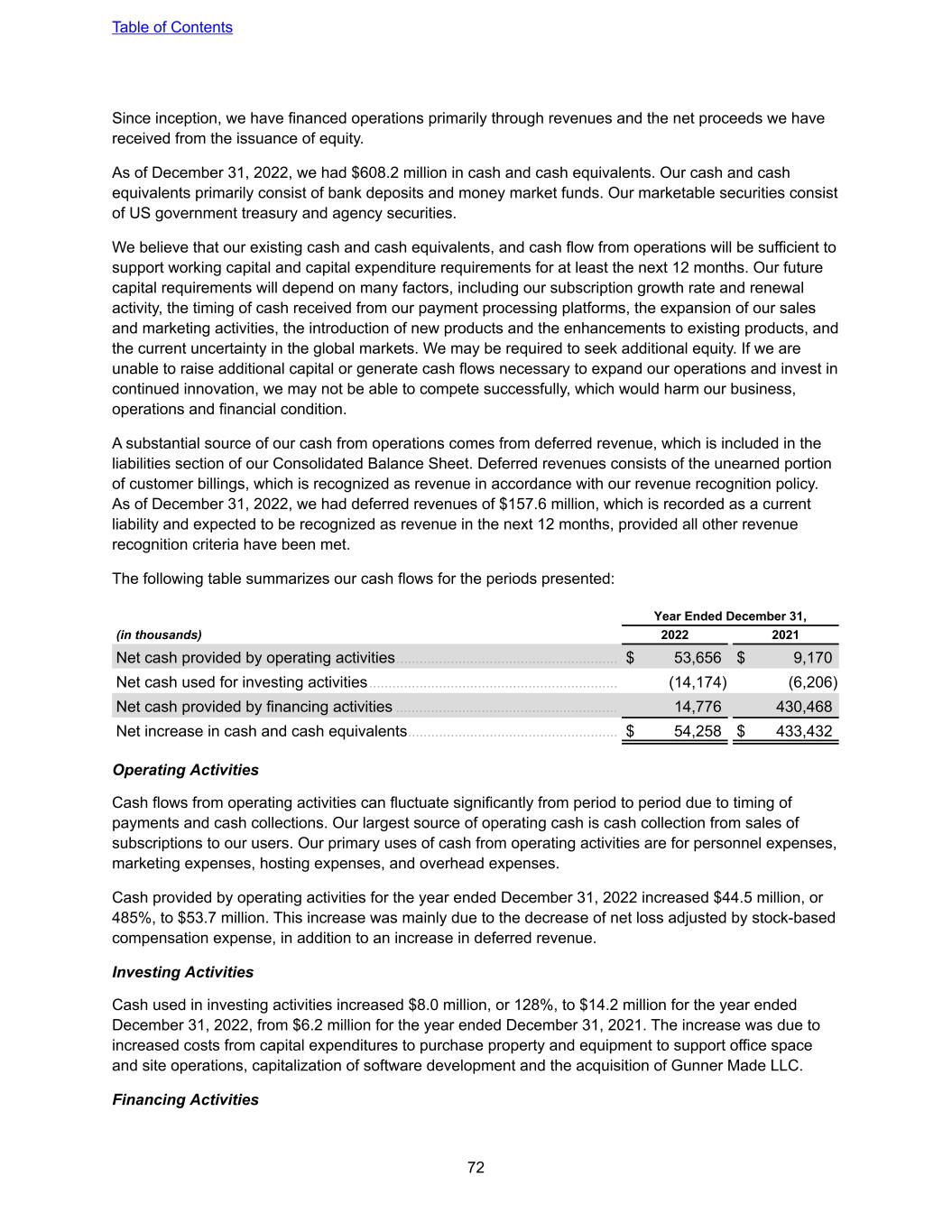
Since inception, we have financed operations primarily through revenues and the net proceeds we have received from the issuance of equity. As of December 31, 2022, we had $608.2 million in cash and cash equivalents. Our cash and cash equivalents primarily consist of bank deposits and money market funds. Our marketable securities consist of US government treasury and agency securities. We believe that our existing cash and cash equivalents, and cash flow from operations will be sufficient to support working capital and capital expenditure requirements for at least the next 12 months. Our future capital requirements will depend on many factors, including our subscription growth rate and renewal activity, the timing of cash received from our payment processing platforms, the expansion of our sales and marketing activities, the introduction of new products and the enhancements to existing products, and the current uncertainty in the global markets. We may be required to seek additional equity. If we are unable to raise additional capital or generate cash flows necessary to expand our operations and invest in continued innovation, we may not be able to compete successfully, which would harm our business, operations and financial condition. A substantial source of our cash from operations comes from deferred revenue, which is included in the liabilities section of our Consolidated Balance Sheet. Deferred revenues consists of the unearned portion of customer billings, which is recognized as revenue in accordance with our revenue recognition policy. As of December 31, 2022, we had deferred revenues of $157.6 million, which is recorded as a current liability and expected to be recognized as revenue in the next 12 months, provided all other revenue recognition criteria have been met. The following table summarizes our cash flows for the periods presented: Year Ended December 31, (in thousands) 2022 2021 Net cash provided by operating activities ......................................................... $ 53,656 $ 9,170 Net cash used for investing activities ................................................................ (14,174) (6,206) Net cash provided by financing activities ......................................................... 14,776 430,468 Net increase in cash and cash equivalents ...................................................... $ 54,258 $ 433,432 Operating Activities Cash flows from operating activities can fluctuate significantly from period to period due to timing of payments and cash collections. Our largest source of operating cash is cash collection from sales of subscriptions to our users. Our primary uses of cash from operating activities are for personnel expenses, marketing expenses, hosting expenses, and overhead expenses. Cash provided by operating activities for the year ended December 31, 2022 increased $44.5 million, or 485%, to $53.7 million. This increase was mainly due to the decrease of net loss adjusted by stock-based compensation expense, in addition to an increase in deferred revenue. Investing Activities Cash used in investing activities increased $8.0 million, or 128%, to $14.2 million for the year ended December 31, 2022, from $6.2 million for the year ended December 31, 2021. The increase was due to increased costs from capital expenditures to purchase property and equipment to support office space and site operations, capitalization of software development and the acquisition of Gunner Made LLC. Financing Activities Table of Contents 72
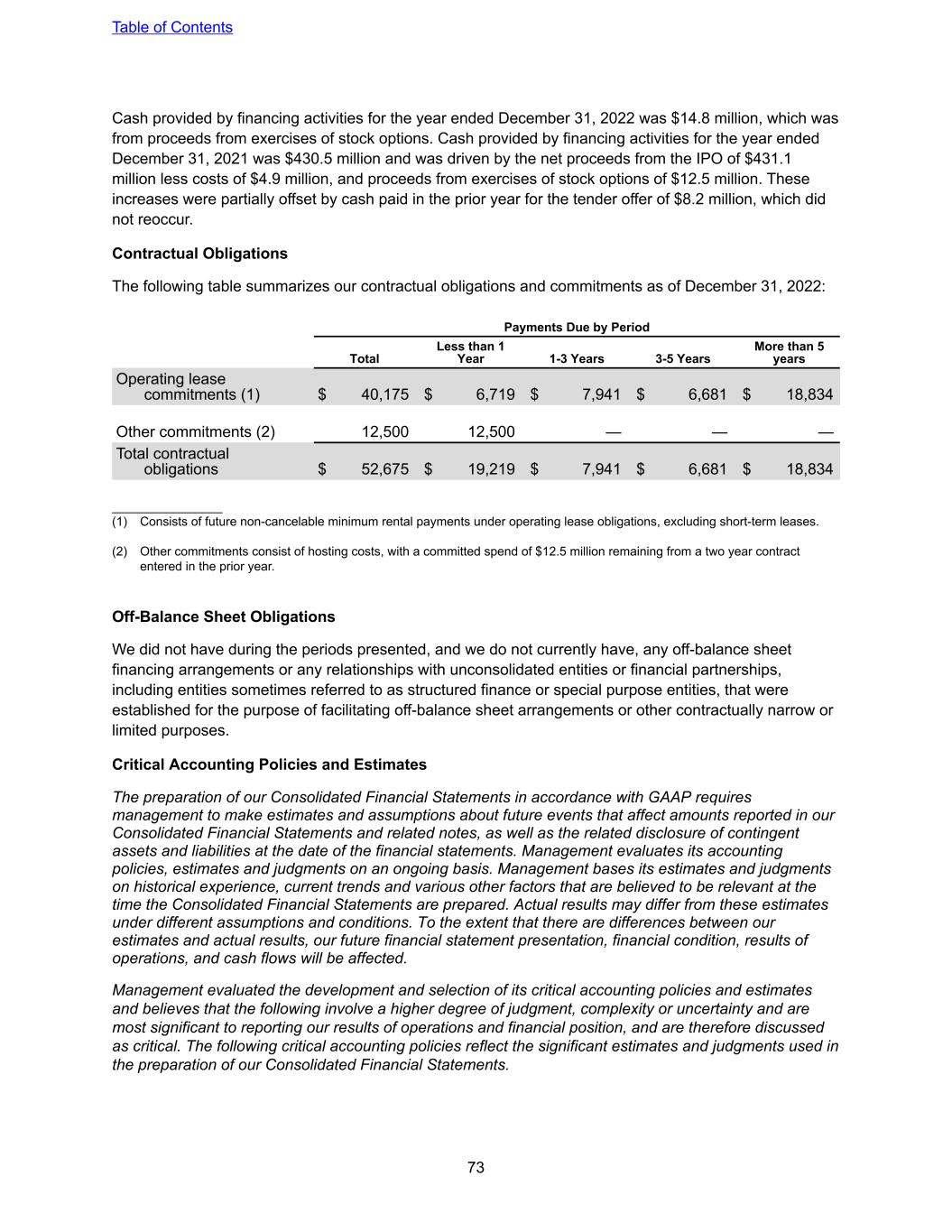
Cash provided by financing activities for the year ended December 31, 2022 was $14.8 million, which was from proceeds from exercises of stock options. Cash provided by financing activities for the year ended December 31, 2021 was $430.5 million and was driven by the net proceeds from the IPO of $431.1 million less costs of $4.9 million, and proceeds from exercises of stock options of $12.5 million. These increases were partially offset by cash paid in the prior year for the tender offer of $8.2 million, which did not reoccur. Contractual Obligations The following table summarizes our contractual obligations and commitments as of December 31, 2022: Payments Due by Period Total Less than 1 Year 1-3 Years 3-5 Years More than 5 years Operating lease commitments (1) $ 40,175 $ 6,719 $ 7,941 $ 6,681 $ 18,834 Other commitments (2) 12,500 12,500 — — — Total contractual obligations $ 52,675 $ 19,219 $ 7,941 $ 6,681 $ 18,834 ________________ (1) Consists of future non-cancelable minimum rental payments under operating lease obligations, excluding short-term leases. (2) Other commitments consist of hosting costs, with a committed spend of $12.5 million remaining from a two year contract entered in the prior year. Off-Balance Sheet Obligations We did not have during the periods presented, and we do not currently have, any off-balance sheet financing arrangements or any relationships with unconsolidated entities or financial partnerships, including entities sometimes referred to as structured finance or special purpose entities, that were established for the purpose of facilitating off-balance sheet arrangements or other contractually narrow or limited purposes. Critical Accounting Policies and Estimates The preparation of our Consolidated Financial Statements in accordance with GAAP requires management to make estimates and assumptions about future events that affect amounts reported in our Consolidated Financial Statements and related notes, as well as the related disclosure of contingent assets and liabilities at the date of the financial statements. Management evaluates its accounting policies, estimates and judgments on an ongoing basis. Management bases its estimates and judgments on historical experience, current trends and various other factors that are believed to be relevant at the time the Consolidated Financial Statements are prepared. Actual results may differ from these estimates under different assumptions and conditions. To the extent that there are differences between our estimates and actual results, our future financial statement presentation, financial condition, results of operations, and cash flows will be affected. Management evaluated the development and selection of its critical accounting policies and estimates and believes that the following involve a higher degree of judgment, complexity or uncertainty and are most significant to reporting our results of operations and financial position, and are therefore discussed as critical. The following critical accounting policies reflect the significant estimates and judgments used in the preparation of our Consolidated Financial Statements. Table of Contents 73
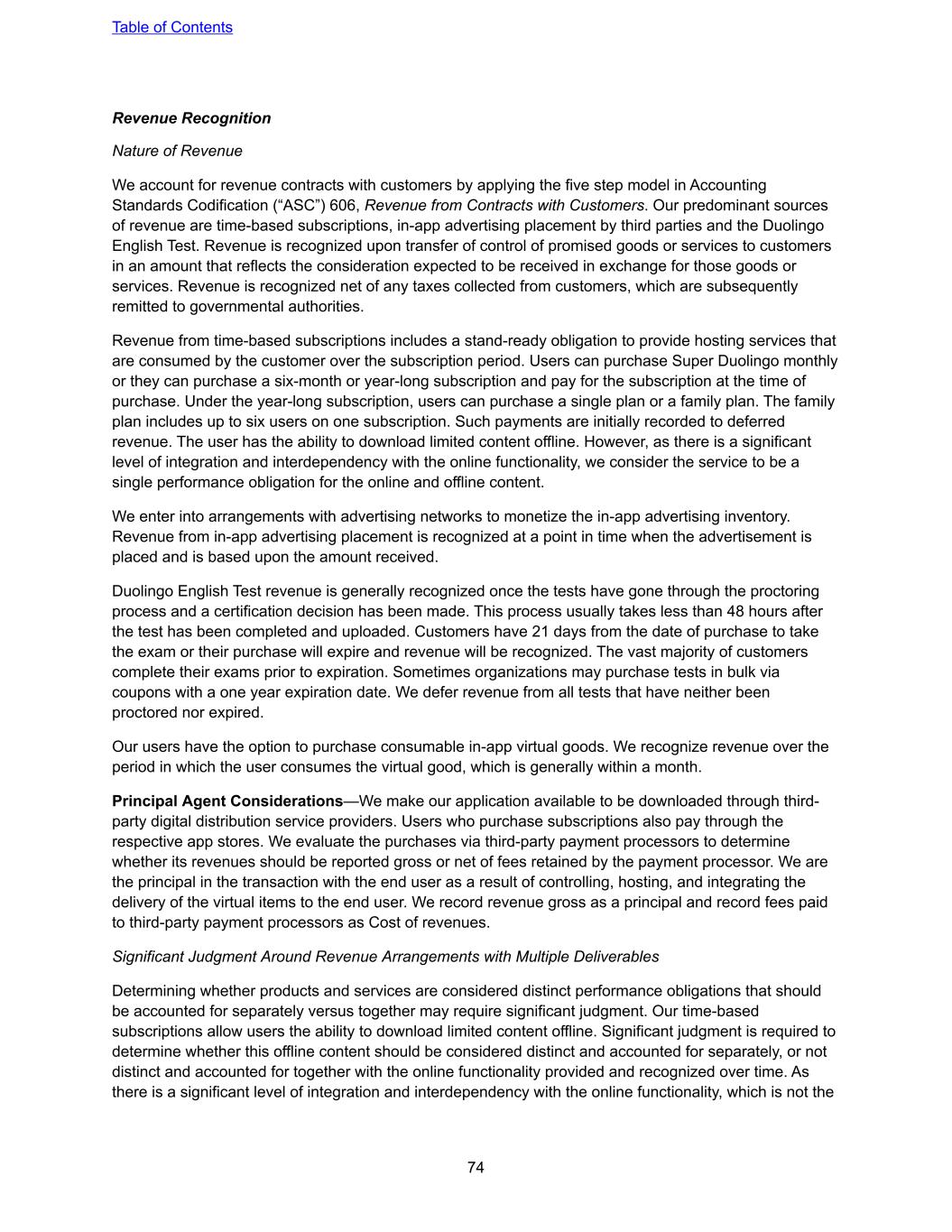
Revenue Recognition Nature of Revenue We account for revenue contracts with customers by applying the five step model in Accounting Standards Codification (“ASC”) 606, Revenue from Contracts with Customers. Our predominant sources of revenue are time-based subscriptions, in-app advertising placement by third parties and the Duolingo English Test. Revenue is recognized upon transfer of control of promised goods or services to customers in an amount that reflects the consideration expected to be received in exchange for those goods or services. Revenue is recognized net of any taxes collected from customers, which are subsequently remitted to governmental authorities. Revenue from time-based subscriptions includes a stand-ready obligation to provide hosting services that are consumed by the customer over the subscription period. Users can purchase Super Duolingo monthly or they can purchase a six-month or year-long subscription and pay for the subscription at the time of purchase. Under the year-long subscription, users can purchase a single plan or a family plan. The family plan includes up to six users on one subscription. Such payments are initially recorded to deferred revenue. The user has the ability to download limited content offline. However, as there is a significant level of integration and interdependency with the online functionality, we consider the service to be a single performance obligation for the online and offline content. We enter into arrangements with advertising networks to monetize the in-app advertising inventory. Revenue from in-app advertising placement is recognized at a point in time when the advertisement is placed and is based upon the amount received. Duolingo English Test revenue is generally recognized once the tests have gone through the proctoring process and a certification decision has been made. This process usually takes less than 48 hours after the test has been completed and uploaded. Customers have 21 days from the date of purchase to take the exam or their purchase will expire and revenue will be recognized. The vast majority of customers complete their exams prior to expiration. Sometimes organizations may purchase tests in bulk via coupons with a one year expiration date. We defer revenue from all tests that have neither been proctored nor expired. Our users have the option to purchase consumable in-app virtual goods. We recognize revenue over the period in which the user consumes the virtual good, which is generally within a month. Principal Agent Considerations—We make our application available to be downloaded through third- party digital distribution service providers. Users who purchase subscriptions also pay through the respective app stores. We evaluate the purchases via third-party payment processors to determine whether its revenues should be reported gross or net of fees retained by the payment processor. We are the principal in the transaction with the end user as a result of controlling, hosting, and integrating the delivery of the virtual items to the end user. We record revenue gross as a principal and record fees paid to third-party payment processors as Cost of revenues. Significant Judgment Around Revenue Arrangements with Multiple Deliverables Determining whether products and services are considered distinct performance obligations that should be accounted for separately versus together may require significant judgment. Our time-based subscriptions allow users the ability to download limited content offline. Significant judgment is required to determine whether this offline content should be considered distinct and accounted for separately, or not distinct and accounted for together with the online functionality provided and recognized over time. As there is a significant level of integration and interdependency with the online functionality, which is not the Table of Contents 74
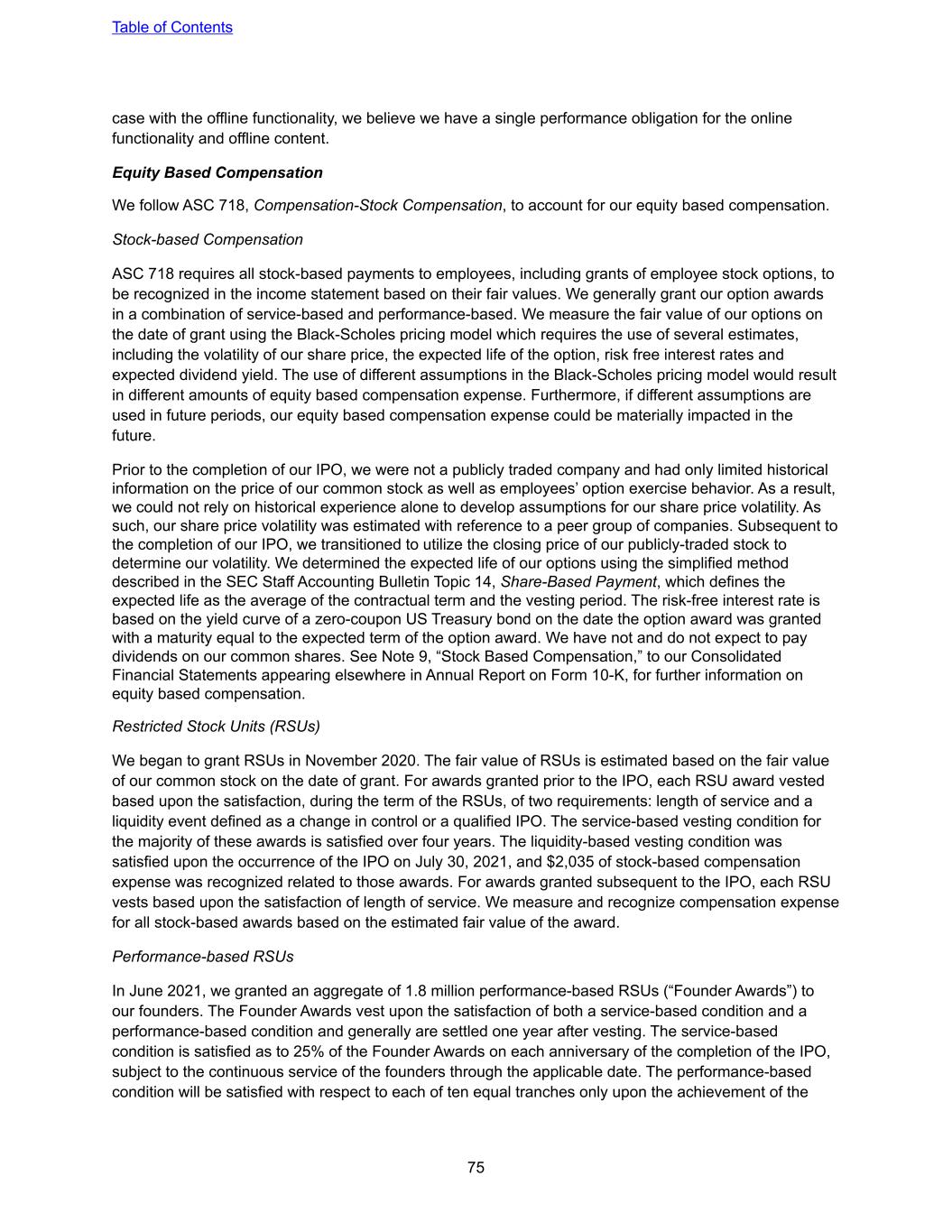
case with the offline functionality, we believe we have a single performance obligation for the online functionality and offline content. Equity Based Compensation We follow ASC 718, Compensation-Stock Compensation, to account for our equity based compensation. Stock-based Compensation ASC 718 requires all stock-based payments to employees, including grants of employee stock options, to be recognized in the income statement based on their fair values. We generally grant our option awards in a combination of service-based and performance-based. We measure the fair value of our options on the date of grant using the Black-Scholes pricing model which requires the use of several estimates, including the volatility of our share price, the expected life of the option, risk free interest rates and expected dividend yield. The use of different assumptions in the Black-Scholes pricing model would result in different amounts of equity based compensation expense. Furthermore, if different assumptions are used in future periods, our equity based compensation expense could be materially impacted in the future. Prior to the completion of our IPO, we were not a publicly traded company and had only limited historical information on the price of our common stock as well as employees’ option exercise behavior. As a result, we could not rely on historical experience alone to develop assumptions for our share price volatility. As such, our share price volatility was estimated with reference to a peer group of companies. Subsequent to the completion of our IPO, we transitioned to utilize the closing price of our publicly-traded stock to determine our volatility. We determined the expected life of our options using the simplified method described in the SEC Staff Accounting Bulletin Topic 14, Share-Based Payment, which defines the expected life as the average of the contractual term and the vesting period. The risk-free interest rate is based on the yield curve of a zero-coupon US Treasury bond on the date the option award was granted with a maturity equal to the expected term of the option award. We have not and do not expect to pay dividends on our common shares. See Note 9, “Stock Based Compensation,” to our Consolidated Financial Statements appearing elsewhere in Annual Report on Form 10-K, for further information on equity based compensation. Restricted Stock Units (RSUs) We began to grant RSUs in November 2020. The fair value of RSUs is estimated based on the fair value of our common stock on the date of grant. For awards granted prior to the IPO, each RSU award vested based upon the satisfaction, during the term of the RSUs, of two requirements: length of service and a liquidity event defined as a change in control or a qualified IPO. The service-based vesting condition for the majority of these awards is satisfied over four years. The liquidity-based vesting condition was satisfied upon the occurrence of the IPO on July 30, 2021, and $2,035 of stock-based compensation expense was recognized related to those awards. For awards granted subsequent to the IPO, each RSU vests based upon the satisfaction of length of service. We measure and recognize compensation expense for all stock-based awards based on the estimated fair value of the award. Performance-based RSUs In June 2021, we granted an aggregate of 1.8 million performance-based RSUs (“Founder Awards”) to our founders. The Founder Awards vest upon the satisfaction of both a service-based condition and a performance-based condition and generally are settled one year after vesting. The service-based condition is satisfied as to 25% of the Founder Awards on each anniversary of the completion of the IPO, subject to the continuous service of the founders through the applicable date. The performance-based condition will be satisfied with respect to each of ten equal tranches only upon the achievement of the Table of Contents 75
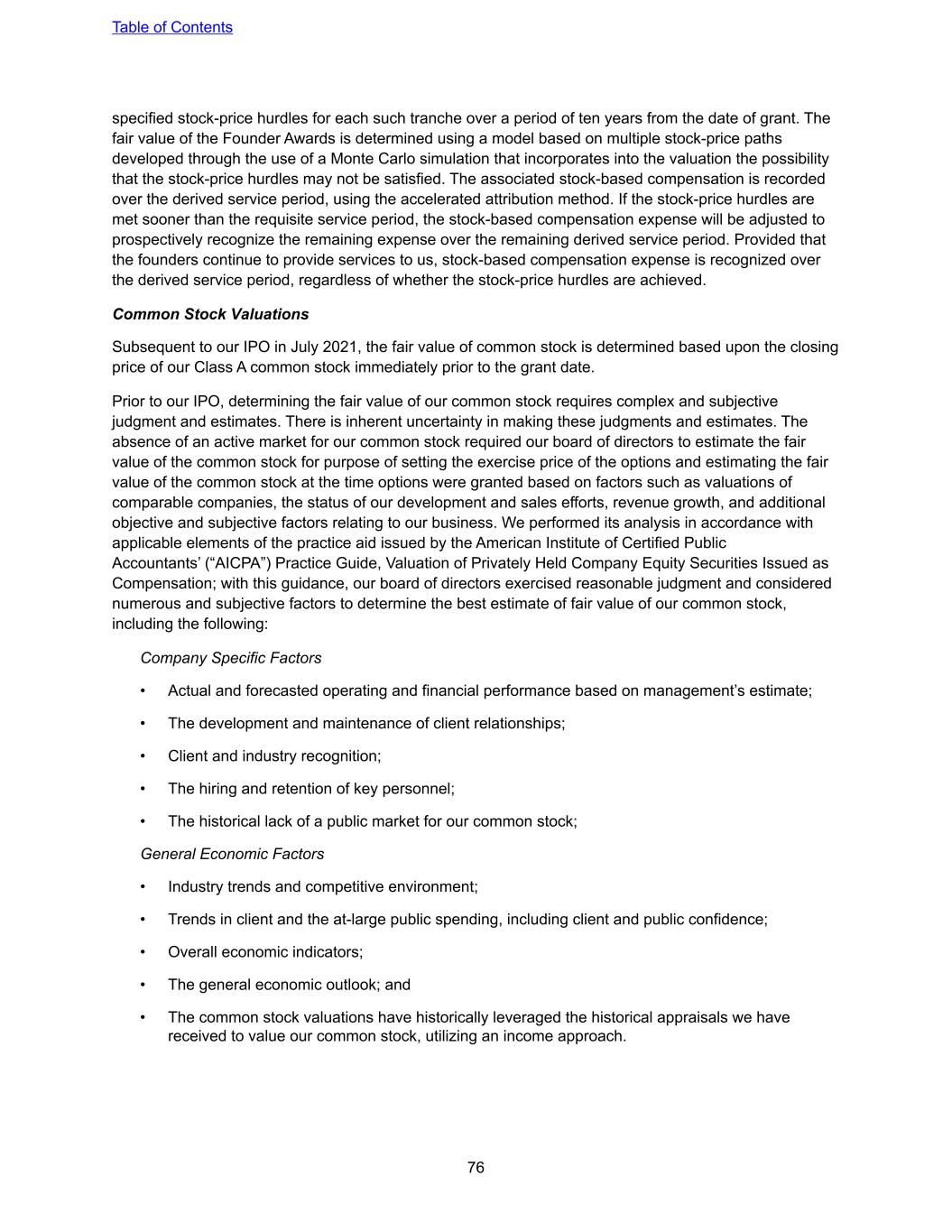
specified stock-price hurdles for each such tranche over a period of ten years from the date of grant. The fair value of the Founder Awards is determined using a model based on multiple stock-price paths developed through the use of a Monte Carlo simulation that incorporates into the valuation the possibility that the stock-price hurdles may not be satisfied. The associated stock-based compensation is recorded over the derived service period, using the accelerated attribution method. If the stock-price hurdles are met sooner than the requisite service period, the stock-based compensation expense will be adjusted to prospectively recognize the remaining expense over the remaining derived service period. Provided that the founders continue to provide services to us, stock-based compensation expense is recognized over the derived service period, regardless of whether the stock-price hurdles are achieved. Common Stock Valuations Subsequent to our IPO in July 2021, the fair value of common stock is determined based upon the closing price of our Class A common stock immediately prior to the grant date. Prior to our IPO, determining the fair value of our common stock requires complex and subjective judgment and estimates. There is inherent uncertainty in making these judgments and estimates. The absence of an active market for our common stock required our board of directors to estimate the fair value of the common stock for purpose of setting the exercise price of the options and estimating the fair value of the common stock at the time options were granted based on factors such as valuations of comparable companies, the status of our development and sales efforts, revenue growth, and additional objective and subjective factors relating to our business. We performed its analysis in accordance with applicable elements of the practice aid issued by the American Institute of Certified Public Accountants’ (“AICPA”) Practice Guide, Valuation of Privately Held Company Equity Securities Issued as Compensation; with this guidance, our board of directors exercised reasonable judgment and considered numerous and subjective factors to determine the best estimate of fair value of our common stock, including the following: Company Specific Factors • Actual and forecasted operating and financial performance based on management’s estimate; • The development and maintenance of client relationships; • Client and industry recognition; • The hiring and retention of key personnel; • The historical lack of a public market for our common stock; General Economic Factors • Industry trends and competitive environment; • Trends in client and the at-large public spending, including client and public confidence; • Overall economic indicators; • The general economic outlook; and • The common stock valuations have historically leveraged the historical appraisals we have received to value our common stock, utilizing an income approach. Table of Contents 76
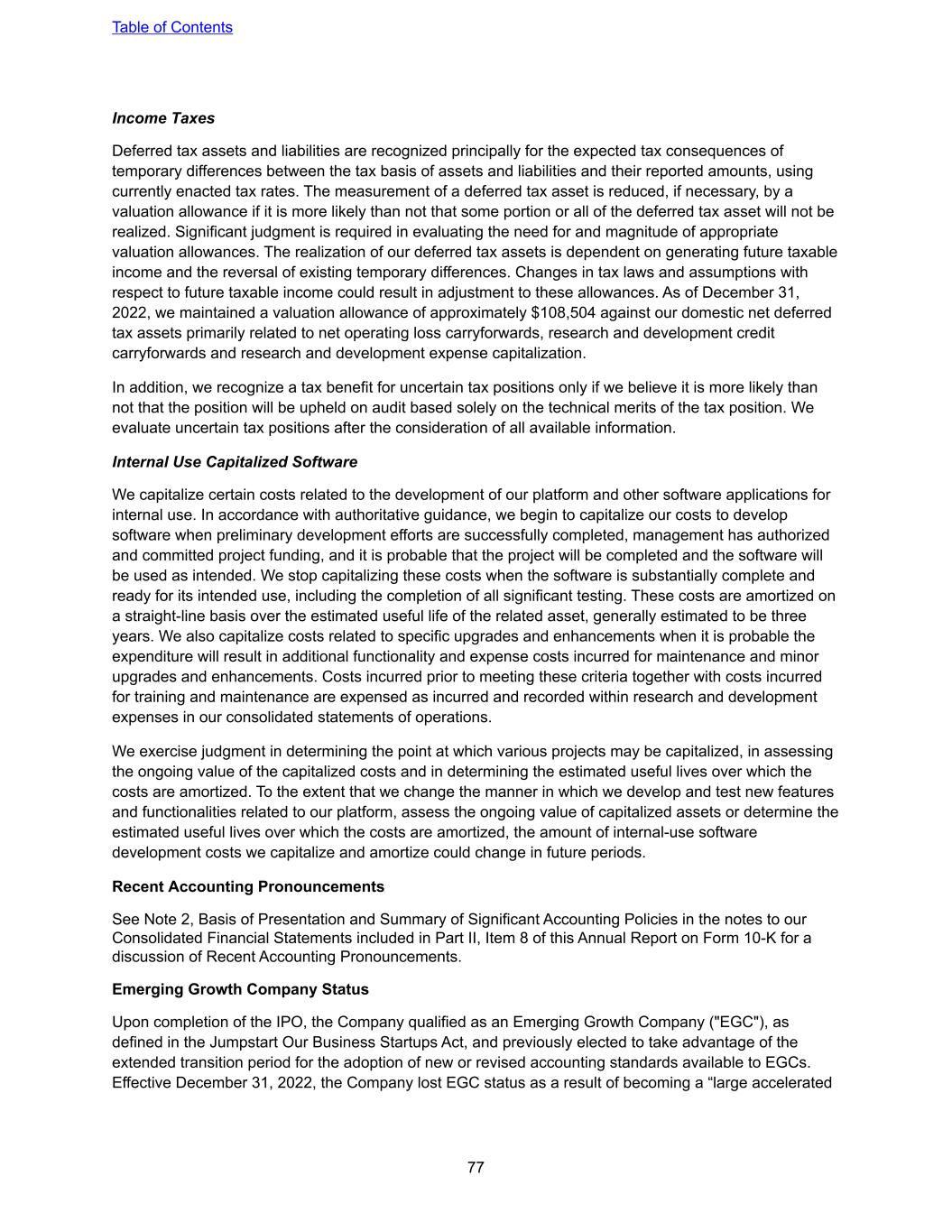
Income Taxes Deferred tax assets and liabilities are recognized principally for the expected tax consequences of temporary differences between the tax basis of assets and liabilities and their reported amounts, using currently enacted tax rates. The measurement of a deferred tax asset is reduced, if necessary, by a valuation allowance if it is more likely than not that some portion or all of the deferred tax asset will not be realized. Significant judgment is required in evaluating the need for and magnitude of appropriate valuation allowances. The realization of our deferred tax assets is dependent on generating future taxable income and the reversal of existing temporary differences. Changes in tax laws and assumptions with respect to future taxable income could result in adjustment to these allowances. As of December 31, 2022, we maintained a valuation allowance of approximately $108,504 against our domestic net deferred tax assets primarily related to net operating loss carryforwards, research and development credit carryforwards and research and development expense capitalization. In addition, we recognize a tax benefit for uncertain tax positions only if we believe it is more likely than not that the position will be upheld on audit based solely on the technical merits of the tax position. We evaluate uncertain tax positions after the consideration of all available information. Internal Use Capitalized Software We capitalize certain costs related to the development of our platform and other software applications for internal use. In accordance with authoritative guidance, we begin to capitalize our costs to develop software when preliminary development efforts are successfully completed, management has authorized and committed project funding, and it is probable that the project will be completed and the software will be used as intended. We stop capitalizing these costs when the software is substantially complete and ready for its intended use, including the completion of all significant testing. These costs are amortized on a straight-line basis over the estimated useful life of the related asset, generally estimated to be three years. We also capitalize costs related to specific upgrades and enhancements when it is probable the expenditure will result in additional functionality and expense costs incurred for maintenance and minor upgrades and enhancements. Costs incurred prior to meeting these criteria together with costs incurred for training and maintenance are expensed as incurred and recorded within research and development expenses in our consolidated statements of operations. We exercise judgment in determining the point at which various projects may be capitalized, in assessing the ongoing value of the capitalized costs and in determining the estimated useful lives over which the costs are amortized. To the extent that we change the manner in which we develop and test new features and functionalities related to our platform, assess the ongoing value of capitalized assets or determine the estimated useful lives over which the costs are amortized, the amount of internal-use software development costs we capitalize and amortize could change in future periods. Recent Accounting Pronouncements See Note 2, Basis of Presentation and Summary of Significant Accounting Policies in the notes to our Consolidated Financial Statements included in Part II, Item 8 of this Annual Report on Form 10-K for a discussion of Recent Accounting Pronouncements. Emerging Growth Company Status Upon completion of the IPO, the Company qualified as an Emerging Growth Company ("EGC"), as defined in the Jumpstart Our Business Startups Act, and previously elected to take advantage of the extended transition period for the adoption of new or revised accounting standards available to EGCs. Effective December 31, 2022, the Company lost EGC status as a result of becoming a “large accelerated Table of Contents 77

filer." As a result, we are no longer able to take advantage of the reduced disclosure requirements applicable to an EGC. Item 7A. Quantitative and Qualitative Disclosures About Market Risk Interest Rate Risk As of December 31, 2022, we had $517.0 million of cash equivalents invested in money market funds. Our cash and cash equivalents are held for working capital purposes in addition to future investments in our product. We do not enter into investments for trading or speculative purposes. Our investments are exposed to market risk due to a fluctuation in interest rates, which may affect our interest income and the fair market value of our investments. As of December 31, 2022, a hypothetical 10% relative change in interest rates would not have a material impact on our Consolidated Financial Statements. Foreign Currency Exchange Risk Our reporting currency and the functional currency of our wholly owned foreign subsidiaries is the US dollar. Certain of our payment providers translate our payments from local currency into USD at time of settlement, which means that during periods of a strengthening US dollar, our international receipts could be reduced. Our operating expenses are denominated in the currencies of the countries in which our operations are located, which are primarily in the United States and China. Our consolidated results of operations and cash flows are, therefore, subject to fluctuations due to changes in foreign currency exchange rates and may be adversely affected in the future due to changes in foreign exchange rates. In addition, as foreign currency exchange rates fluctuate, the translation of our international receipts into US dollars affects the period-over-period comparability of our operating results and can result in foreign currency exchange gains and losses. To date, we have not entered into any hedging arrangements with respect to foreign currency risk or other derivative financial instruments, although we may choose to do so in the future. A hypothetical 10% increase or decrease in the relative value of the US dollar to other currencies would not have a material effect on our operating results. Inflation Risk Inflationary factors such as increases in costs may adversely affect our results of operations. We do not believe that inflation has had a material effect on our business, financial condition or results of operations to date. If our costs were to become subject to significant inflationary pressures, we may not be able to fully offset such higher costs through price increases. Our inability or failure to do so could harm our business, financial condition or results of operations. Table of Contents 78
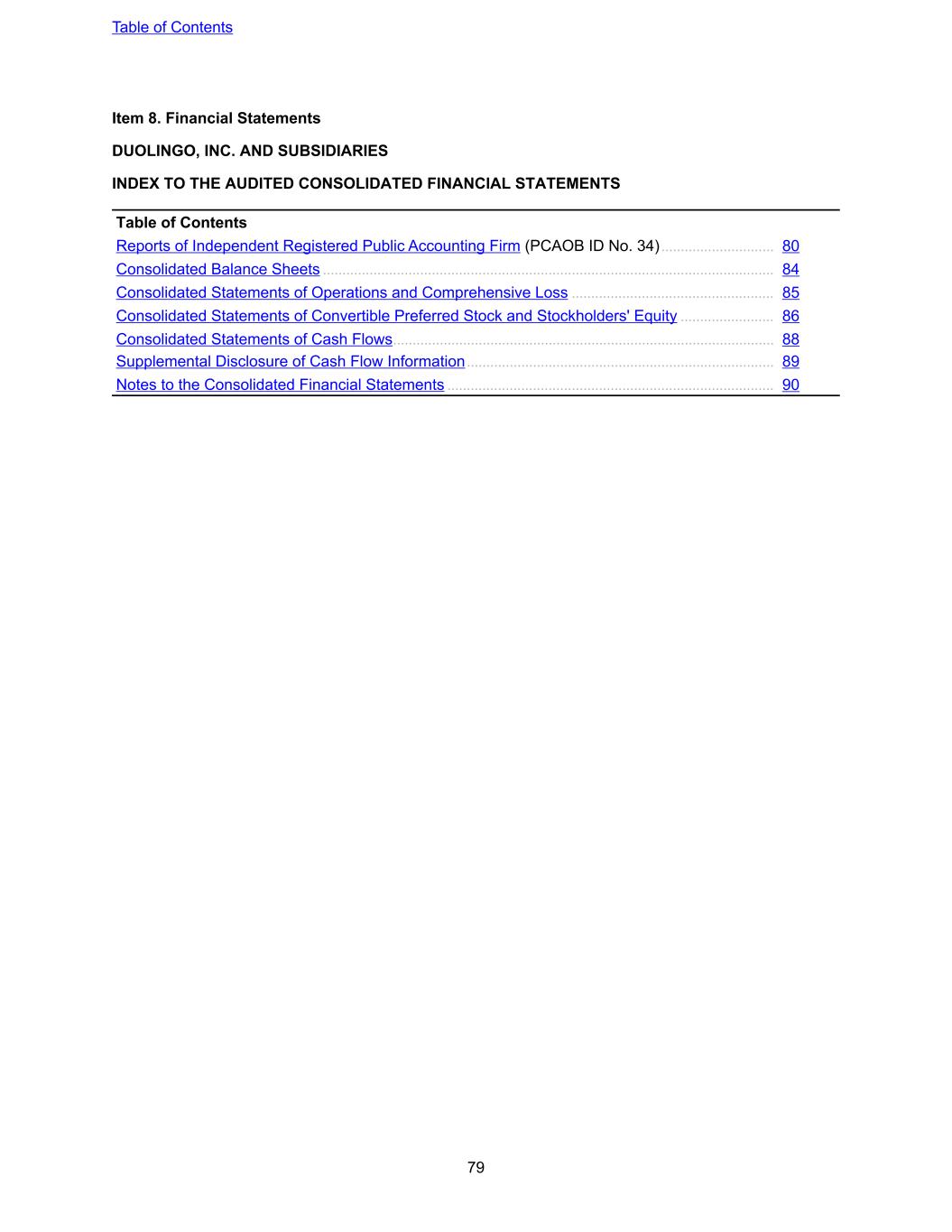
Item 8. Financial Statements DUOLINGO, INC. AND SUBSIDIARIES INDEX TO THE AUDITED CONSOLIDATED FINANCIAL STATEMENTS Table of Contents Reports of Independent Registered Public Accounting Firm (PCAOB ID No. 34) ............................. 80 Consolidated Balance Sheets .................................................................................................................... 84 Consolidated Statements of Operations and Comprehensive Loss .................................................... 85 Consolidated Statements of Convertible Preferred Stock and Stockholders' Equity ........................ 86 Consolidated Statements of Cash Flows .................................................................................................. 88 Supplemental Disclosure of Cash Flow Information ............................................................................... 89 Notes to the Consolidated Financial Statements .................................................................................... 90 Table of Contents 79
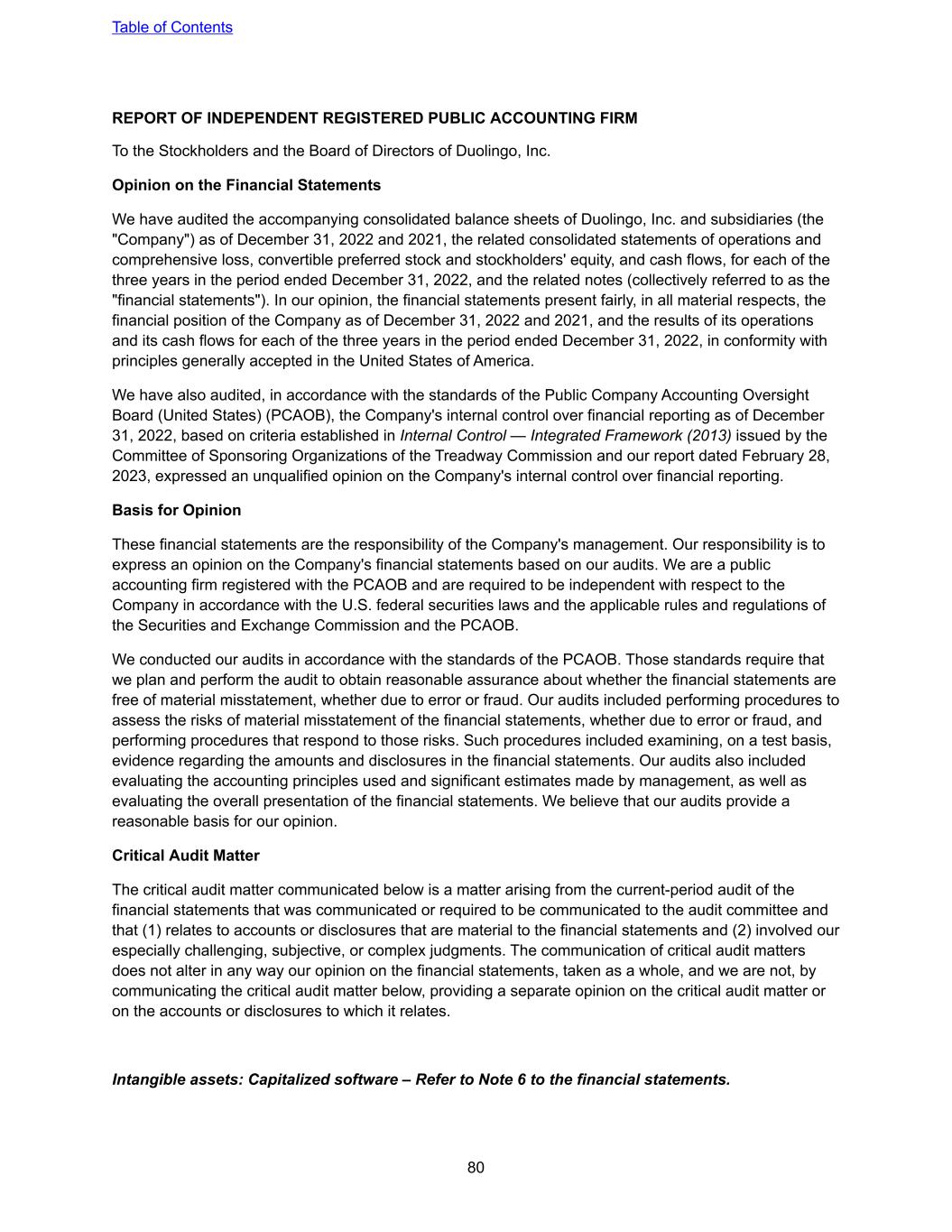
REPORT OF INDEPENDENT REGISTERED PUBLIC ACCOUNTING FIRM To the Stockholders and the Board of Directors of Duolingo, Inc. Opinion on the Financial Statements We have audited the accompanying consolidated balance sheets of Duolingo, Inc. and subsidiaries (the "Company") as of December 31, 2022 and 2021, the related consolidated statements of operations and comprehensive loss, convertible preferred stock and stockholders' equity, and cash flows, for each of the three years in the period ended December 31, 2022, and the related notes (collectively referred to as the "financial statements"). In our opinion, the financial statements present fairly, in all material respects, the financial position of the Company as of December 31, 2022 and 2021, and the results of its operations and its cash flows for each of the three years in the period ended December 31, 2022, in conformity with principles generally accepted in the United States of America. We have also audited, in accordance with the standards of the Public Company Accounting Oversight Board (United States) (PCAOB), the Company's internal control over financial reporting as of December 31, 2022, based on criteria established in Internal Control — Integrated Framework (2013) issued by the Committee of Sponsoring Organizations of the Treadway Commission and our report dated February 28, 2023, expressed an unqualified opinion on the Company's internal control over financial reporting. Basis for Opinion These financial statements are the responsibility of the Company's management. Our responsibility is to express an opinion on the Company's financial statements based on our audits. We are a public accounting firm registered with the PCAOB and are required to be independent with respect to the Company in accordance with the U.S. federal securities laws and the applicable rules and regulations of the Securities and Exchange Commission and the PCAOB. We conducted our audits in accordance with the standards of the PCAOB. Those standards require that we plan and perform the audit to obtain reasonable assurance about whether the financial statements are free of material misstatement, whether due to error or fraud. Our audits included performing procedures to assess the risks of material misstatement of the financial statements, whether due to error or fraud, and performing procedures that respond to those risks. Such procedures included examining, on a test basis, evidence regarding the amounts and disclosures in the financial statements. Our audits also included evaluating the accounting principles used and significant estimates made by management, as well as evaluating the overall presentation of the financial statements. We believe that our audits provide a reasonable basis for our opinion. Critical Audit Matter The critical audit matter communicated below is a matter arising from the current-period audit of the financial statements that was communicated or required to be communicated to the audit committee and that (1) relates to accounts or disclosures that are material to the financial statements and (2) involved our especially challenging, subjective, or complex judgments. The communication of critical audit matters does not alter in any way our opinion on the financial statements, taken as a whole, and we are not, by communicating the critical audit matter below, providing a separate opinion on the critical audit matter or on the accounts or disclosures to which it relates. Intangible assets: Capitalized software – Refer to Note 6 to the financial statements. Table of Contents 80
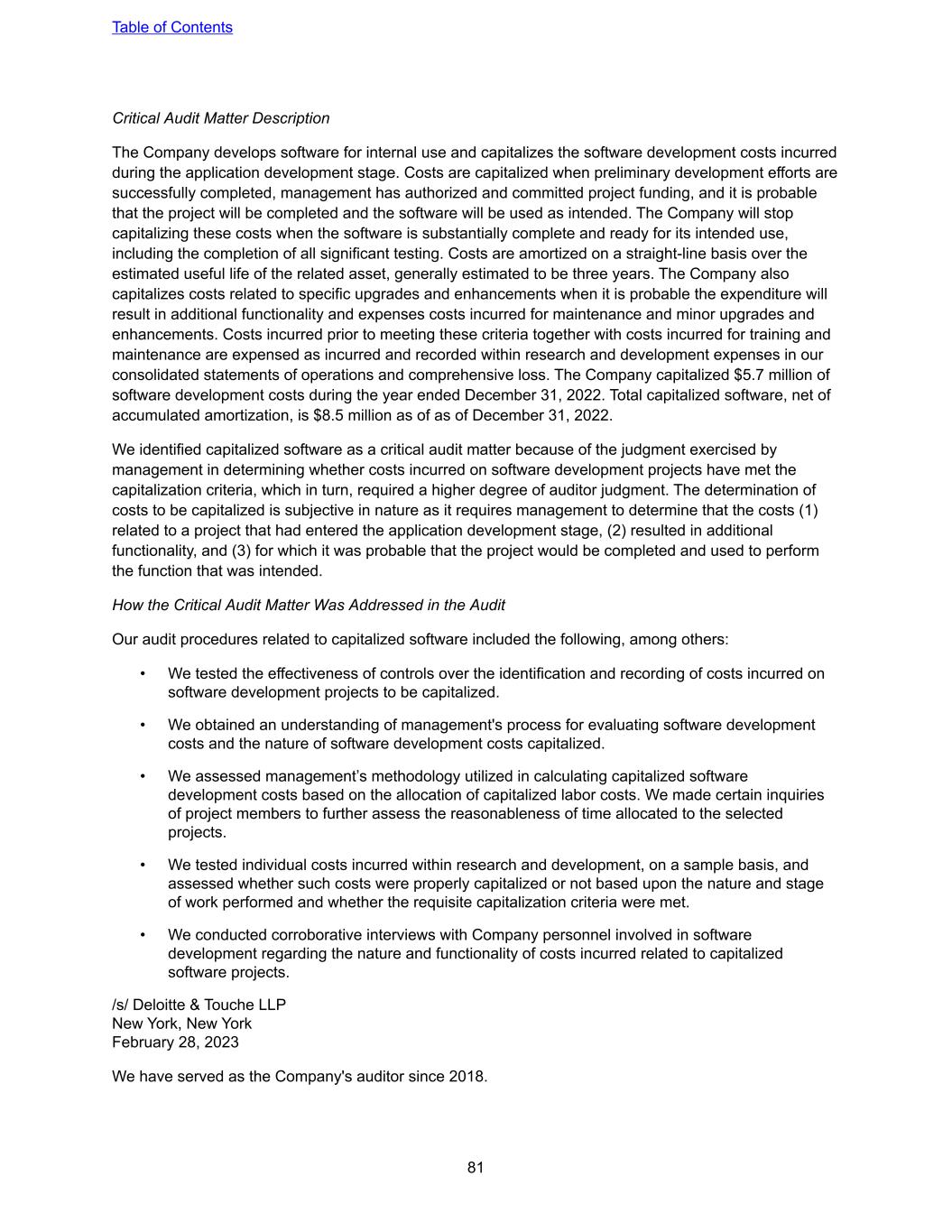
Critical Audit Matter Description The Company develops software for internal use and capitalizes the software development costs incurred during the application development stage. Costs are capitalized when preliminary development efforts are successfully completed, management has authorized and committed project funding, and it is probable that the project will be completed and the software will be used as intended. The Company will stop capitalizing these costs when the software is substantially complete and ready for its intended use, including the completion of all significant testing. Costs are amortized on a straight-line basis over the estimated useful life of the related asset, generally estimated to be three years. The Company also capitalizes costs related to specific upgrades and enhancements when it is probable the expenditure will result in additional functionality and expenses costs incurred for maintenance and minor upgrades and enhancements. Costs incurred prior to meeting these criteria together with costs incurred for training and maintenance are expensed as incurred and recorded within research and development expenses in our consolidated statements of operations and comprehensive loss. The Company capitalized $5.7 million of software development costs during the year ended December 31, 2022. Total capitalized software, net of accumulated amortization, is $8.5 million as of as of December 31, 2022. We identified capitalized software as a critical audit matter because of the judgment exercised by management in determining whether costs incurred on software development projects have met the capitalization criteria, which in turn, required a higher degree of auditor judgment. The determination of costs to be capitalized is subjective in nature as it requires management to determine that the costs (1) related to a project that had entered the application development stage, (2) resulted in additional functionality, and (3) for which it was probable that the project would be completed and used to perform the function that was intended. How the Critical Audit Matter Was Addressed in the Audit Our audit procedures related to capitalized software included the following, among others: • We tested the effectiveness of controls over the identification and recording of costs incurred on software development projects to be capitalized. • We obtained an understanding of management's process for evaluating software development costs and the nature of software development costs capitalized. • We assessed management’s methodology utilized in calculating capitalized software development costs based on the allocation of capitalized labor costs. We made certain inquiries of project members to further assess the reasonableness of time allocated to the selected projects. • We tested individual costs incurred within research and development, on a sample basis, and assessed whether such costs were properly capitalized or not based upon the nature and stage of work performed and whether the requisite capitalization criteria were met. • We conducted corroborative interviews with Company personnel involved in software development regarding the nature and functionality of costs incurred related to capitalized software projects. /s/ Deloitte & Touche LLP New York, New York February 28, 2023 We have served as the Company's auditor since 2018. Table of Contents 81
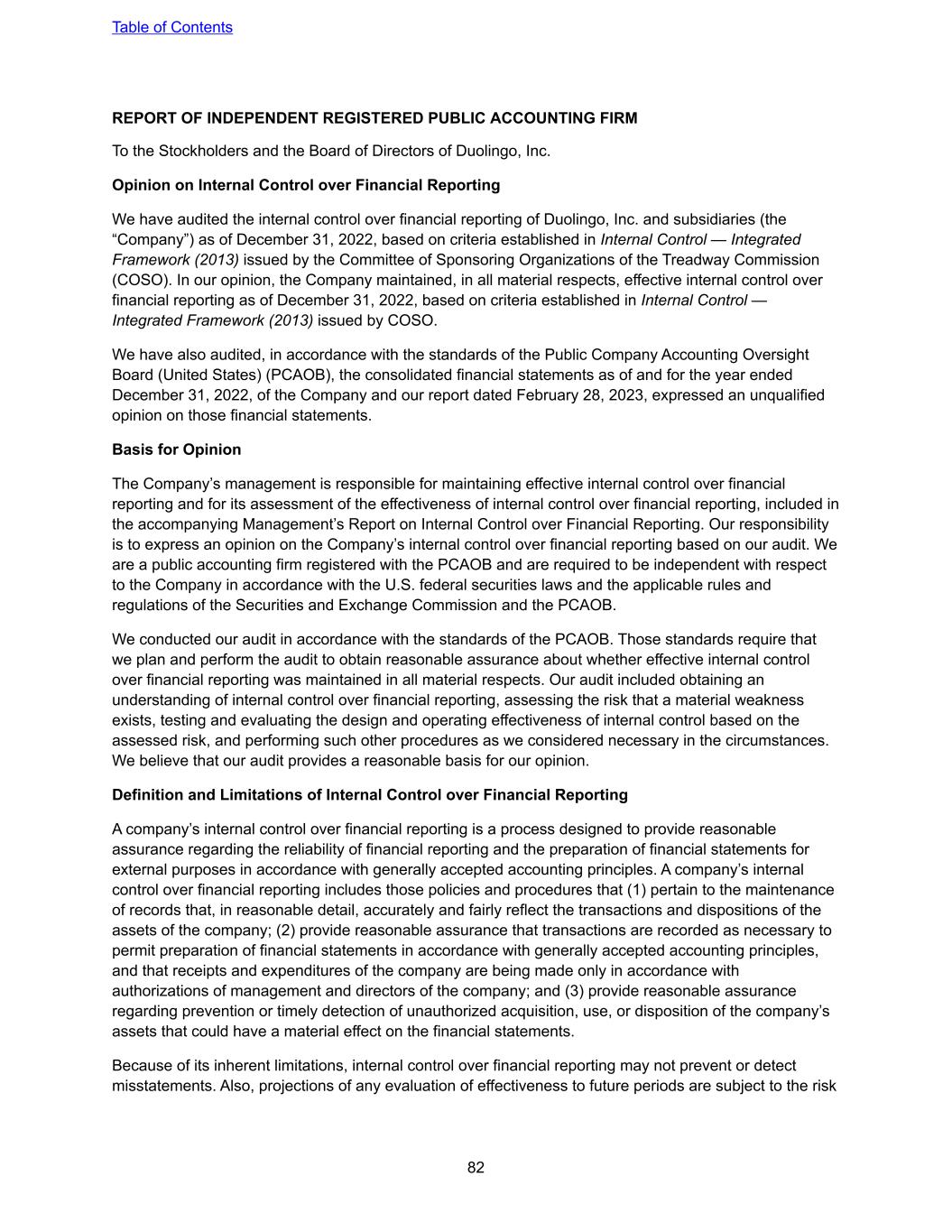
REPORT OF INDEPENDENT REGISTERED PUBLIC ACCOUNTING FIRM To the Stockholders and the Board of Directors of Duolingo, Inc. Opinion on Internal Control over Financial Reporting We have audited the internal control over financial reporting of Duolingo, Inc. and subsidiaries (the “Company”) as of December 31, 2022, based on criteria established in Internal Control — Integrated Framework (2013) issued by the Committee of Sponsoring Organizations of the Treadway Commission (COSO). In our opinion, the Company maintained, in all material respects, effective internal control over financial reporting as of December 31, 2022, based on criteria established in Internal Control — Integrated Framework (2013) issued by COSO. We have also audited, in accordance with the standards of the Public Company Accounting Oversight Board (United States) (PCAOB), the consolidated financial statements as of and for the year ended December 31, 2022, of the Company and our report dated February 28, 2023, expressed an unqualified opinion on those financial statements. Basis for Opinion The Company’s management is responsible for maintaining effective internal control over financial reporting and for its assessment of the effectiveness of internal control over financial reporting, included in the accompanying Management’s Report on Internal Control over Financial Reporting. Our responsibility is to express an opinion on the Company’s internal control over financial reporting based on our audit. We are a public accounting firm registered with the PCAOB and are required to be independent with respect to the Company in accordance with the U.S. federal securities laws and the applicable rules and regulations of the Securities and Exchange Commission and the PCAOB. We conducted our audit in accordance with the standards of the PCAOB. Those standards require that we plan and perform the audit to obtain reasonable assurance about whether effective internal control over financial reporting was maintained in all material respects. Our audit included obtaining an understanding of internal control over financial reporting, assessing the risk that a material weakness exists, testing and evaluating the design and operating effectiveness of internal control based on the assessed risk, and performing such other procedures as we considered necessary in the circumstances. We believe that our audit provides a reasonable basis for our opinion. Definition and Limitations of Internal Control over Financial Reporting A company’s internal control over financial reporting is a process designed to provide reasonable assurance regarding the reliability of financial reporting and the preparation of financial statements for external purposes in accordance with generally accepted accounting principles. A company’s internal control over financial reporting includes those policies and procedures that (1) pertain to the maintenance of records that, in reasonable detail, accurately and fairly reflect the transactions and dispositions of the assets of the company; (2) provide reasonable assurance that transactions are recorded as necessary to permit preparation of financial statements in accordance with generally accepted accounting principles, and that receipts and expenditures of the company are being made only in accordance with authorizations of management and directors of the company; and (3) provide reasonable assurance regarding prevention or timely detection of unauthorized acquisition, use, or disposition of the company’s assets that could have a material effect on the financial statements. Because of its inherent limitations, internal control over financial reporting may not prevent or detect misstatements. Also, projections of any evaluation of effectiveness to future periods are subject to the risk Table of Contents 82
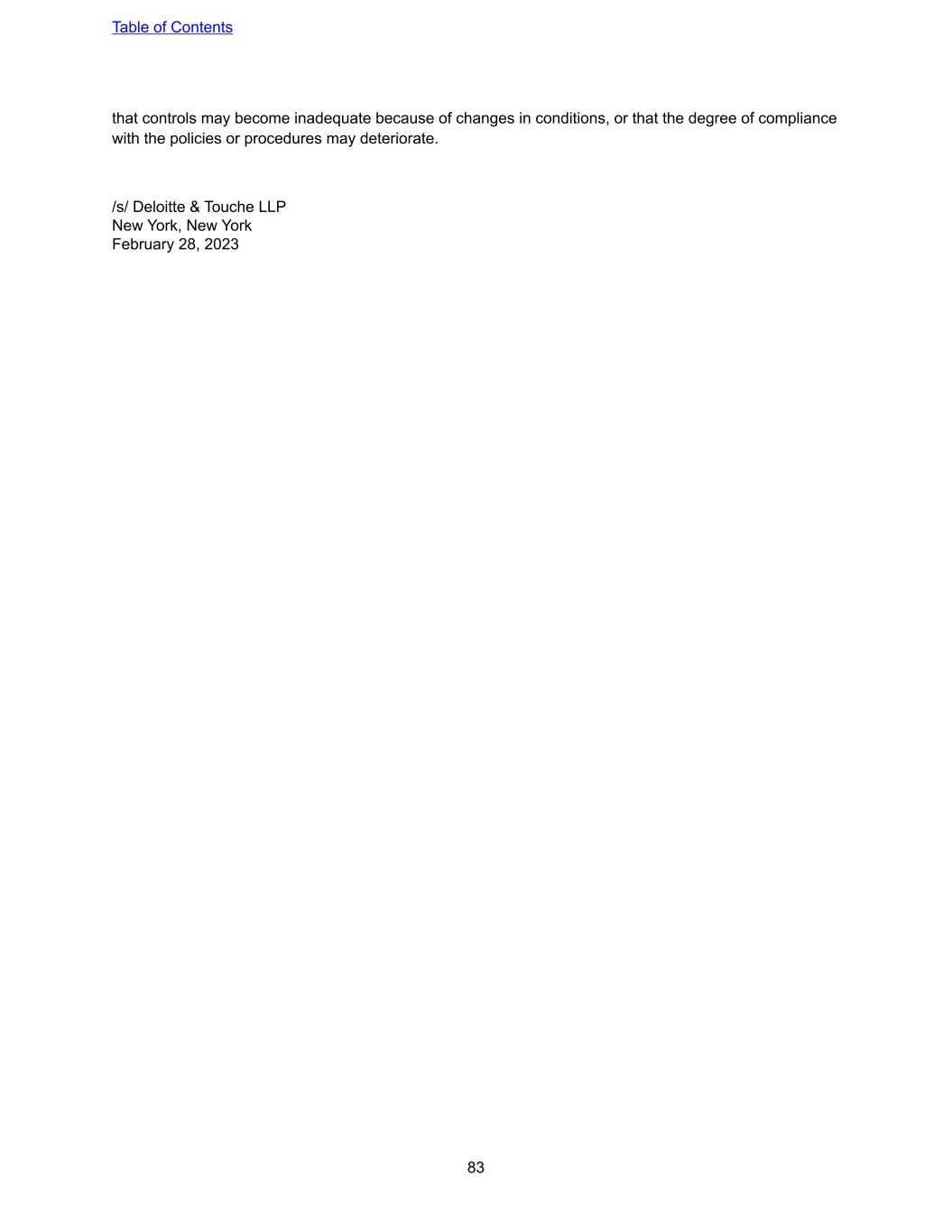
that controls may become inadequate because of changes in conditions, or that the degree of compliance with the policies or procedures may deteriorate. /s/ Deloitte & Touche LLP New York, New York February 28, 2023 Table of Contents 83
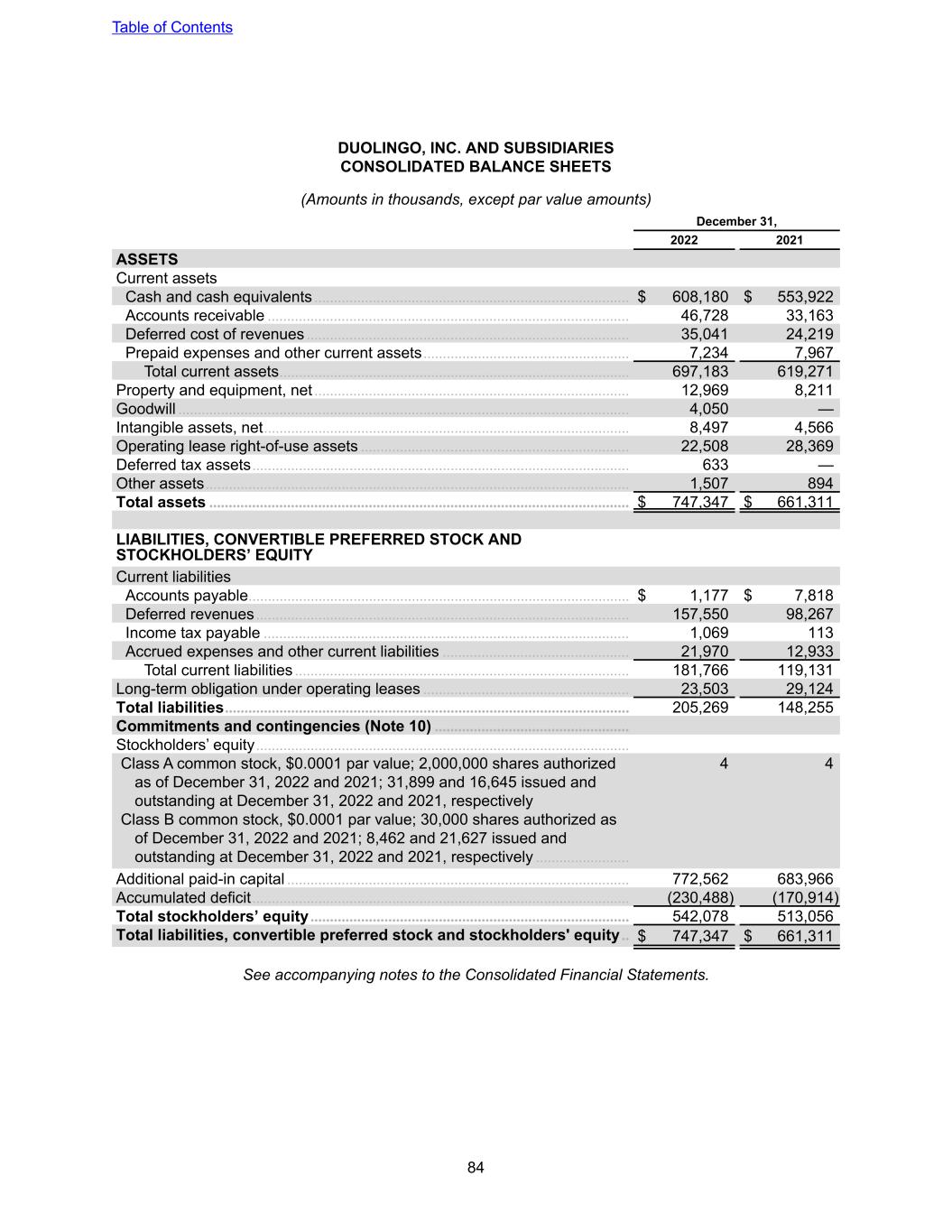
DUOLINGO, INC. AND SUBSIDIARIES CONSOLIDATED BALANCE SHEETS (Amounts in thousands, except par value amounts) December 31, 2022 2021 ASSETS Current assets Cash and cash equivalents ................................................................................. $ 608,180 $ 553,922 Accounts receivable ............................................................................................. 46,728 33,163 Deferred cost of revenues ................................................................................... 35,041 24,219 Prepaid expenses and other current assets ..................................................... 7,234 7,967 Total current assets .......................................................................................... 697,183 619,271 Property and equipment, net ................................................................................. 12,969 8,211 Goodwill .................................................................................................................... 4,050 — Intangible assets, net .............................................................................................. 8,497 4,566 Operating lease right-of-use assets ..................................................................... 22,508 28,369 Deferred tax assets ................................................................................................. 633 — Other assets ............................................................................................................. 1,507 894 Total assets ............................................................................................................ $ 747,347 $ 661,311 LIABILITIES, CONVERTIBLE PREFERRED STOCK AND STOCKHOLDERS’ EQUITY Current liabilities Accounts payable .................................................................................................. $ 1,177 $ 7,818 Deferred revenues ................................................................................................ 157,550 98,267 Income tax payable .............................................................................................. 1,069 113 Accrued expenses and other current liabilities ................................................ 21,970 12,933 Total current liabilities ...................................................................................... 181,766 119,131 Long-term obligation under operating leases ..................................................... 23,503 29,124 Total liabilities ........................................................................................................ 205,269 148,255 Commitments and contingencies (Note 10) .................................................. Stockholders’ equity ................................................................................................ Class A common stock, $0.0001 par value; 2,000,000 shares authorized as of December 31, 2022 and 2021; 31,899 and 16,645 issued and outstanding at December 31, 2022 and 2021, respectively Class B common stock, $0.0001 par value; 30,000 shares authorized as of December 31, 2022 and 2021; 8,462 and 21,627 issued and outstanding at December 31, 2022 and 2021, respectively ........................ 4 4 Additional paid-in capital ........................................................................................ 772,562 683,966 Accumulated deficit ................................................................................................. (230,488) (170,914) Total stockholders’ equity .................................................................................. 542,078 513,056 Total liabilities, convertible preferred stock and stockholders' equity .. $ 747,347 $ 661,311 See accompanying notes to the Consolidated Financial Statements. Table of Contents 84
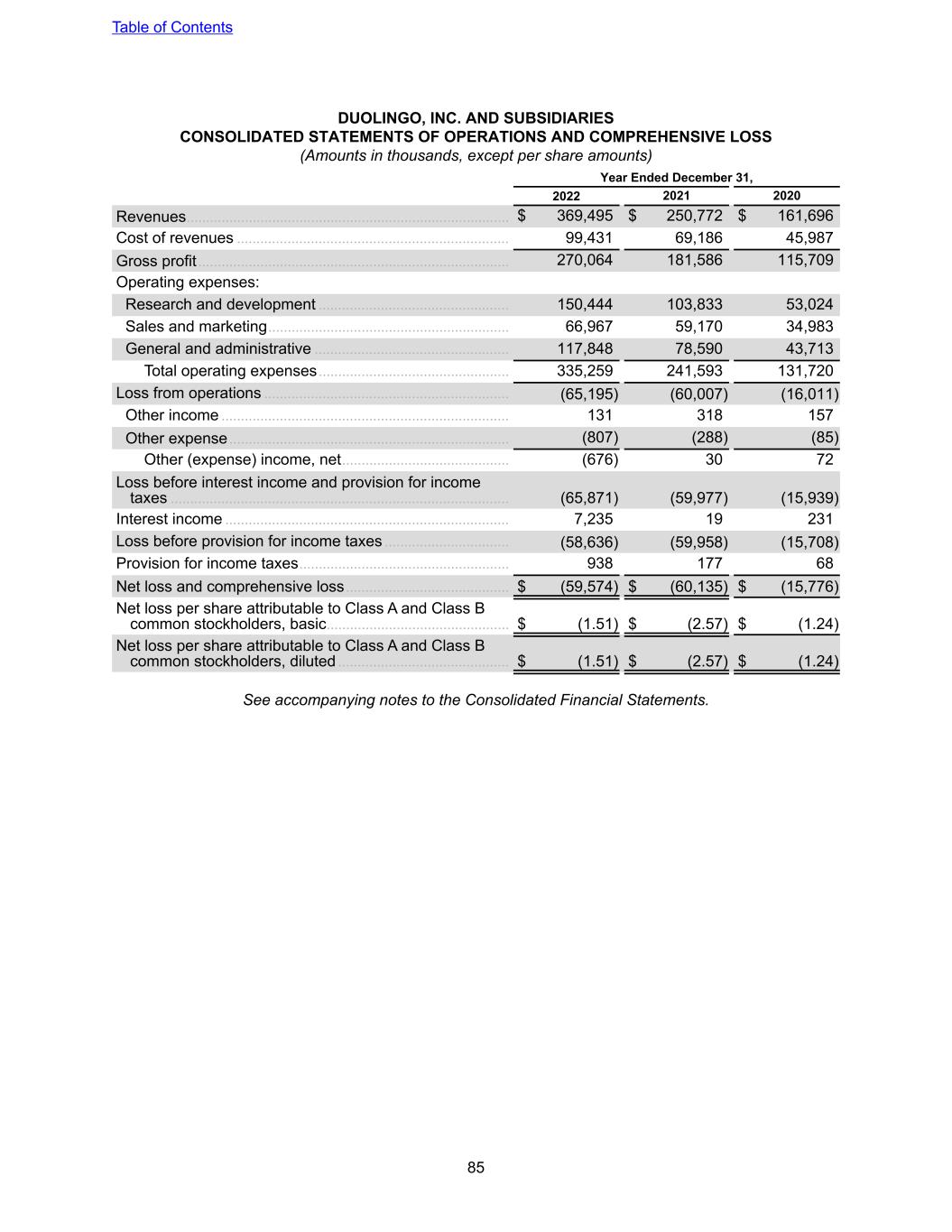
DUOLINGO, INC. AND SUBSIDIARIES CONSOLIDATED STATEMENTS OF OPERATIONS AND COMPREHENSIVE LOSS (Amounts in thousands, except per share amounts) Year Ended December 31, 2022 2021 2020 Revenues ................................................................................... $ 369,495 $ 250,772 $ 161,696 Cost of revenues ...................................................................... 99,431 69,186 45,987 Gross profit ................................................................................ 270,064 181,586 115,709 Operating expenses: Research and development ................................................. 150,444 103,833 53,024 Sales and marketing .............................................................. 66,967 59,170 34,983 General and administrative .................................................. 117,848 78,590 43,713 Total operating expenses ................................................. 335,259 241,593 131,720 Loss from operations ............................................................... (65,195) (60,007) (16,011) Other income .......................................................................... 131 318 157 Other expense ........................................................................ (807) (288) (85) Other (expense) income, net ........................................... (676) 30 72 Loss before interest income and provision for income taxes ....................................................................................... (65,871) (59,977) (15,939) Interest income ......................................................................... 7,235 19 231 Loss before provision for income taxes ................................ (58,636) (59,958) (15,708) Provision for income taxes ...................................................... 938 177 68 Net loss and comprehensive loss .......................................... $ (59,574) $ (60,135) $ (15,776) Net loss per share attributable to Class A and Class B common stockholders, basic ............................................... $ (1.51) $ (2.57) $ (1.24) Net loss per share attributable to Class A and Class B common stockholders, diluted ............................................ $ (1.51) $ (2.57) $ (1.24) See accompanying notes to the Consolidated Financial Statements. Table of Contents 85
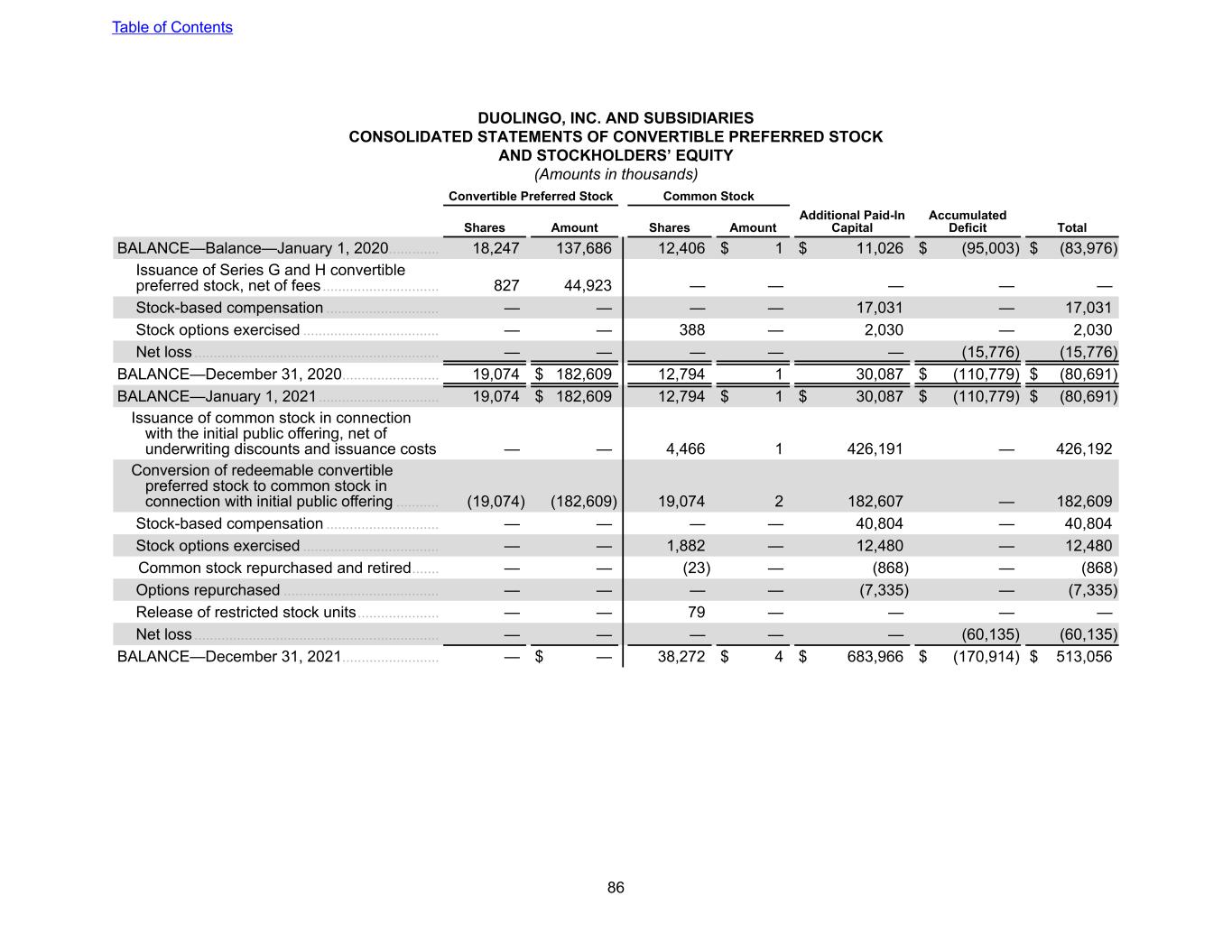
DUOLINGO, INC. AND SUBSIDIARIES CONSOLIDATED STATEMENTS OF CONVERTIBLE PREFERRED STOCK AND STOCKHOLDERS’ EQUITY (Amounts in thousands) Convertible Preferred Stock Common Stock Shares Amount Shares Amount Additional Paid-In Capital Accumulated Deficit Total BALANCE—Balance—January 1, 2020 ............. 18,247 137,686 12,406 $ 1 $ 11,026 $ (95,003) $ (83,976) Issuance of Series G and H convertible preferred stock, net of fees .............................. 827 44,923 — — — — — Stock-based compensation ............................. — — — — 17,031 — 17,031 Stock options exercised ................................... — — 388 — 2,030 — 2,030 Net loss ............................................................... — — — — — (15,776) (15,776) BALANCE—December 31, 2020 ......................... 19,074 $ 182,609 12,794 1 30,087 $ (110,779) $ (80,691) BALANCE—January 1, 2021 ............................... 19,074 $ 182,609 12,794 $ 1 $ 30,087 $ (110,779) $ (80,691) Issuance of common stock in connection with the initial public offering, net of underwriting discounts and issuance costs — — 4,466 1 426,191 — 426,192 Conversion of redeemable convertible preferred stock to common stock in connection with initial public offering ........... (19,074) (182,609) 19,074 2 182,607 — 182,609 Stock-based compensation ............................. — — — — 40,804 — 40,804 Stock options exercised ................................... — — 1,882 — 12,480 — 12,480 Common stock repurchased and retired ....... — — (23) — (868) — (868) Options repurchased ........................................ — — — — (7,335) — (7,335) Release of restricted stock units ..................... — — 79 — — — — Net loss ............................................................... — — — — — (60,135) (60,135) BALANCE—December 31, 2021 ......................... — $ — 38,272 $ 4 $ 683,966 $ (170,914) $ 513,056 Table of Contents 86
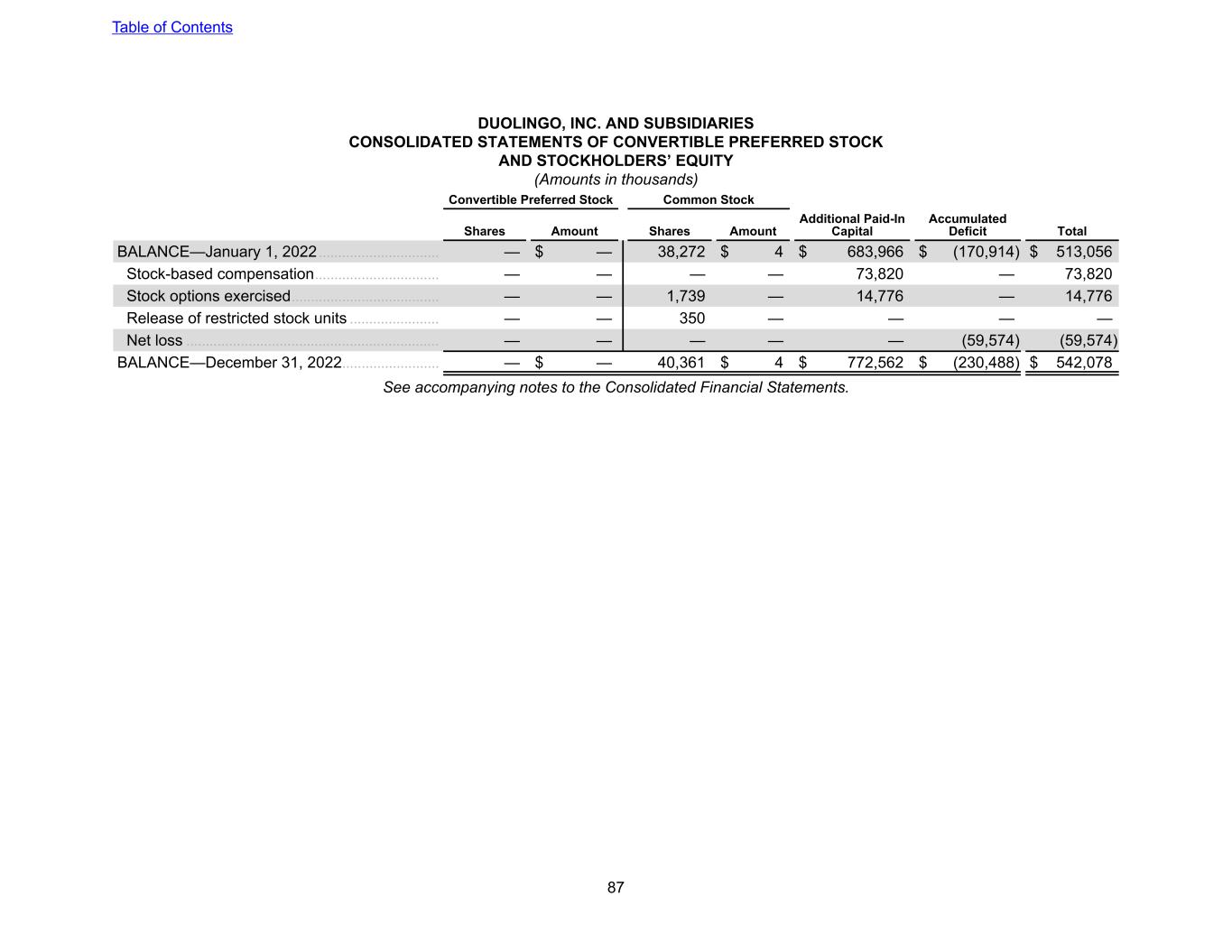
DUOLINGO, INC. AND SUBSIDIARIES CONSOLIDATED STATEMENTS OF CONVERTIBLE PREFERRED STOCK AND STOCKHOLDERS’ EQUITY (Amounts in thousands) Convertible Preferred Stock Common Stock Shares Amount Shares Amount Additional Paid-In Capital Accumulated Deficit Total BALANCE—January 1, 2022 ............................... — $ — 38,272 $ 4 $ 683,966 $ (170,914) $ 513,056 Stock-based compensation ................................ — — — — 73,820 — 73,820 Stock options exercised ...................................... — — 1,739 — 14,776 — 14,776 Release of restricted stock units ....................... — — 350 — — — — Net loss ................................................................. — — — — — (59,574) (59,574) BALANCE—December 31, 2022 ......................... — $ — 40,361 $ 4 $ 772,562 $ (230,488) $ 542,078 See accompanying notes to the Consolidated Financial Statements. Table of Contents 87
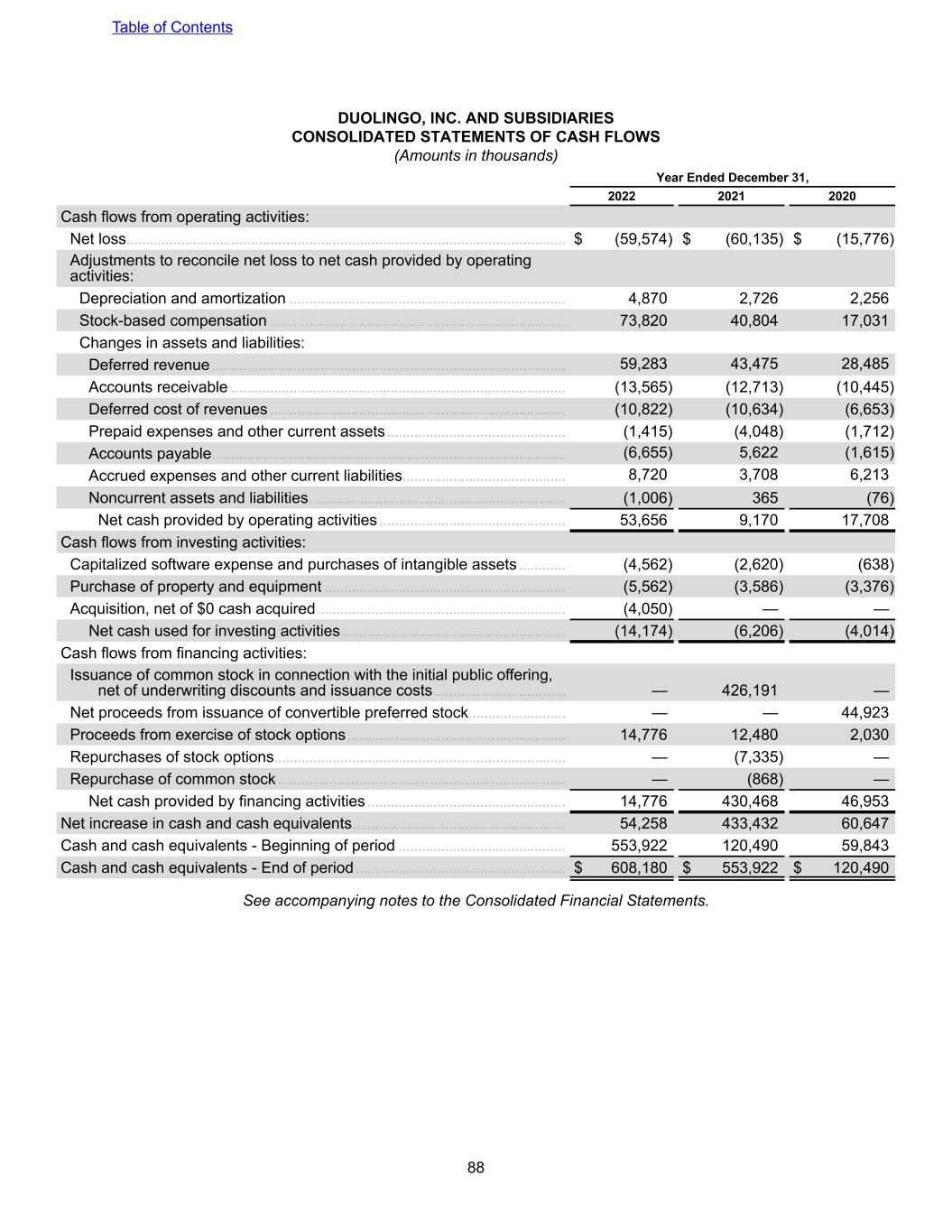
DUOLINGO, INC. AND SUBSIDIARIES CONSOLIDATED STATEMENTS OF CASH FLOWS (Amounts in thousands) Year Ended December 31, 2022 2021 2020 Cash flows from operating activities: Net loss ................................................................................................................. $ (59,574) $ (60,135) $ (15,776) Adjustments to reconcile net loss to net cash provided by operating activities: Depreciation and amortization ....................................................................... 4,870 2,726 2,256 Stock-based compensation ............................................................................ 73,820 40,804 17,031 Changes in assets and liabilities: Deferred revenue ........................................................................................... 59,283 43,475 28,485 Accounts receivable ...................................................................................... (13,565) (12,713) (10,445) Deferred cost of revenues ............................................................................ (10,822) (10,634) (6,653) Prepaid expenses and other current assets .............................................. (1,415) (4,048) (1,712) Accounts payable ........................................................................................... (6,655) 5,622 (1,615) Accrued expenses and other current liabilities .......................................... 8,720 3,708 6,213 Noncurrent assets and liabilities .................................................................. (1,006) 365 (76) Net cash provided by operating activities ................................................ 53,656 9,170 17,708 Cash flows from investing activities: Capitalized software expense and purchases of intangible assets ............ (4,562) (2,620) (638) Purchase of property and equipment .............................................................. (5,562) (3,586) (3,376) Acquisition, net of $0 cash acquired ................................................................ (4,050) — — Net cash used for investing activities .......................................................... (14,174) (6,206) (4,014) Cash flows from financing activities: Issuance of common stock in connection with the initial public offering, net of underwriting discounts and issuance costs .................................. — 426,191 — Net proceeds from issuance of convertible preferred stock ......................... — — 44,923 Proceeds from exercise of stock options ........................................................ 14,776 12,480 2,030 Repurchases of stock options ........................................................................... — (7,335) — Repurchase of common stock .......................................................................... — (868) — Net cash provided by financing activities ................................................... 14,776 430,468 46,953 Net increase in cash and cash equivalents ....................................................... 54,258 433,432 60,647 Cash and cash equivalents - Beginning of period ........................................... 553,922 120,490 59,843 Cash and cash equivalents - End of period ...................................................... $ 608,180 $ 553,922 $ 120,490 See accompanying notes to the Consolidated Financial Statements. Table of Contents 88
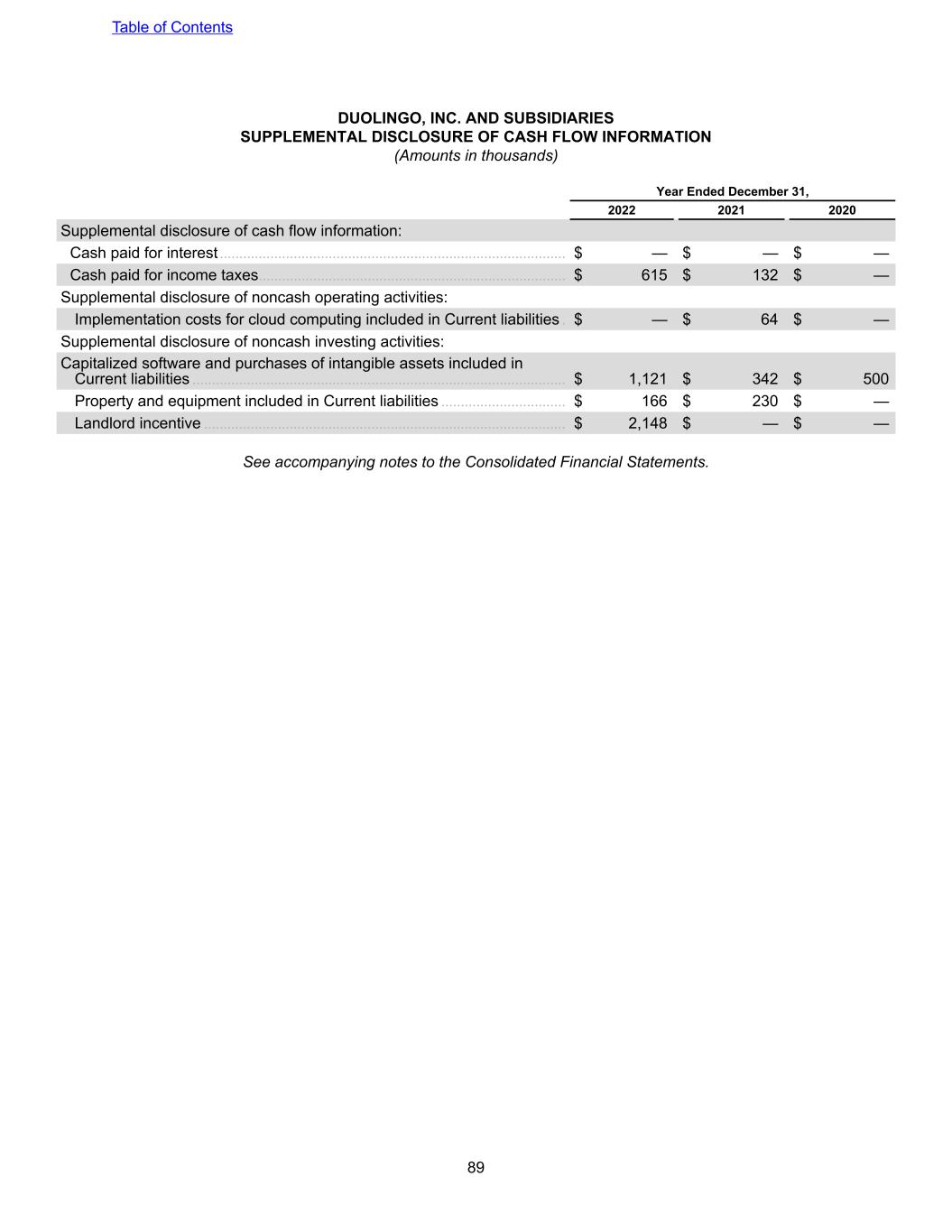
DUOLINGO, INC. AND SUBSIDIARIES SUPPLEMENTAL DISCLOSURE OF CASH FLOW INFORMATION (Amounts in thousands) Year Ended December 31, 2022 2021 2020 Supplemental disclosure of cash flow information: Cash paid for interest ......................................................................................... $ — $ — $ — Cash paid for income taxes ............................................................................... $ 615 $ 132 $ — Supplemental disclosure of noncash operating activities: Implementation costs for cloud computing included in Current liabilities . $ — $ 64 $ — Supplemental disclosure of noncash investing activities: Capitalized software and purchases of intangible assets included in Current liabilities ................................................................................................ $ 1,121 $ 342 $ 500 Property and equipment included in Current liabilities ................................ $ 166 $ 230 $ — Landlord incentive ............................................................................................. $ 2,148 $ — $ — See accompanying notes to the Consolidated Financial Statements. Table of Contents 89
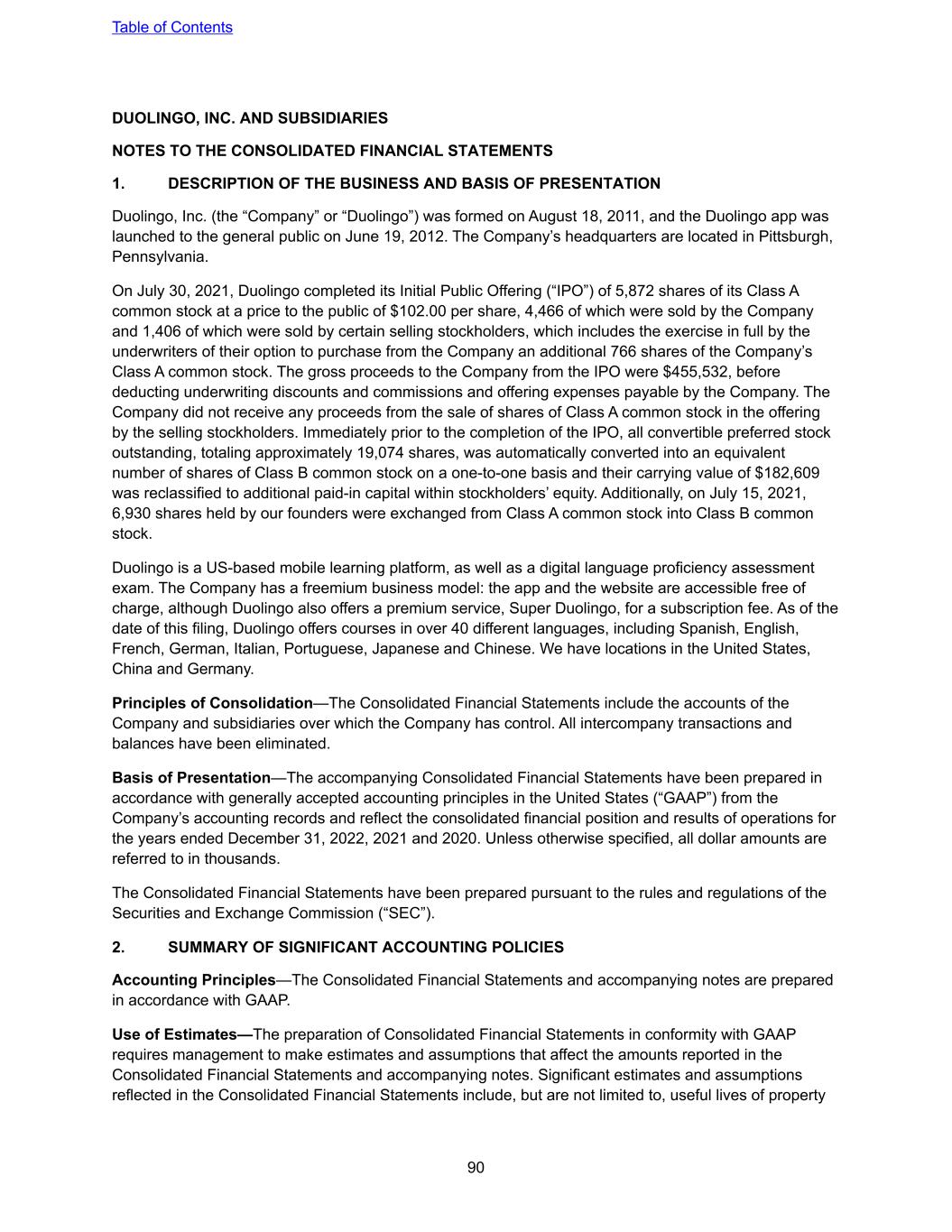
DUOLINGO, INC. AND SUBSIDIARIES NOTES TO THE CONSOLIDATED FINANCIAL STATEMENTS 1. DESCRIPTION OF THE BUSINESS AND BASIS OF PRESENTATION Duolingo, Inc. (the “Company” or “Duolingo”) was formed on August 18, 2011, and the Duolingo app was launched to the general public on June 19, 2012. The Company’s headquarters are located in Pittsburgh, Pennsylvania. On July 30, 2021, Duolingo completed its Initial Public Offering (“IPO”) of 5,872 shares of its Class A common stock at a price to the public of $102.00 per share, 4,466 of which were sold by the Company and 1,406 of which were sold by certain selling stockholders, which includes the exercise in full by the underwriters of their option to purchase from the Company an additional 766 shares of the Company’s Class A common stock. The gross proceeds to the Company from the IPO were $455,532, before deducting underwriting discounts and commissions and offering expenses payable by the Company. The Company did not receive any proceeds from the sale of shares of Class A common stock in the offering by the selling stockholders. Immediately prior to the completion of the IPO, all convertible preferred stock outstanding, totaling approximately 19,074 shares, was automatically converted into an equivalent number of shares of Class B common stock on a one-to-one basis and their carrying value of $182,609 was reclassified to additional paid-in capital within stockholders’ equity. Additionally, on July 15, 2021, 6,930 shares held by our founders were exchanged from Class A common stock into Class B common stock. Duolingo is a US-based mobile learning platform, as well as a digital language proficiency assessment exam. The Company has a freemium business model: the app and the website are accessible free of charge, although Duolingo also offers a premium service, Super Duolingo, for a subscription fee. As of the date of this filing, Duolingo offers courses in over 40 different languages, including Spanish, English, French, German, Italian, Portuguese, Japanese and Chinese. We have locations in the United States, China and Germany. Principles of Consolidation—The Consolidated Financial Statements include the accounts of the Company and subsidiaries over which the Company has control. All intercompany transactions and balances have been eliminated. Basis of Presentation—The accompanying Consolidated Financial Statements have been prepared in accordance with generally accepted accounting principles in the United States (“GAAP”) from the Company’s accounting records and reflect the consolidated financial position and results of operations for the years ended December 31, 2022, 2021 and 2020. Unless otherwise specified, all dollar amounts are referred to in thousands. The Consolidated Financial Statements have been prepared pursuant to the rules and regulations of the Securities and Exchange Commission (“SEC”). 2. SUMMARY OF SIGNIFICANT ACCOUNTING POLICIES Accounting Principles—The Consolidated Financial Statements and accompanying notes are prepared in accordance with GAAP. Use of Estimates—The preparation of Consolidated Financial Statements in conformity with GAAP requires management to make estimates and assumptions that affect the amounts reported in the Consolidated Financial Statements and accompanying notes. Significant estimates and assumptions reflected in the Consolidated Financial Statements include, but are not limited to, useful lives of property Table of Contents 90
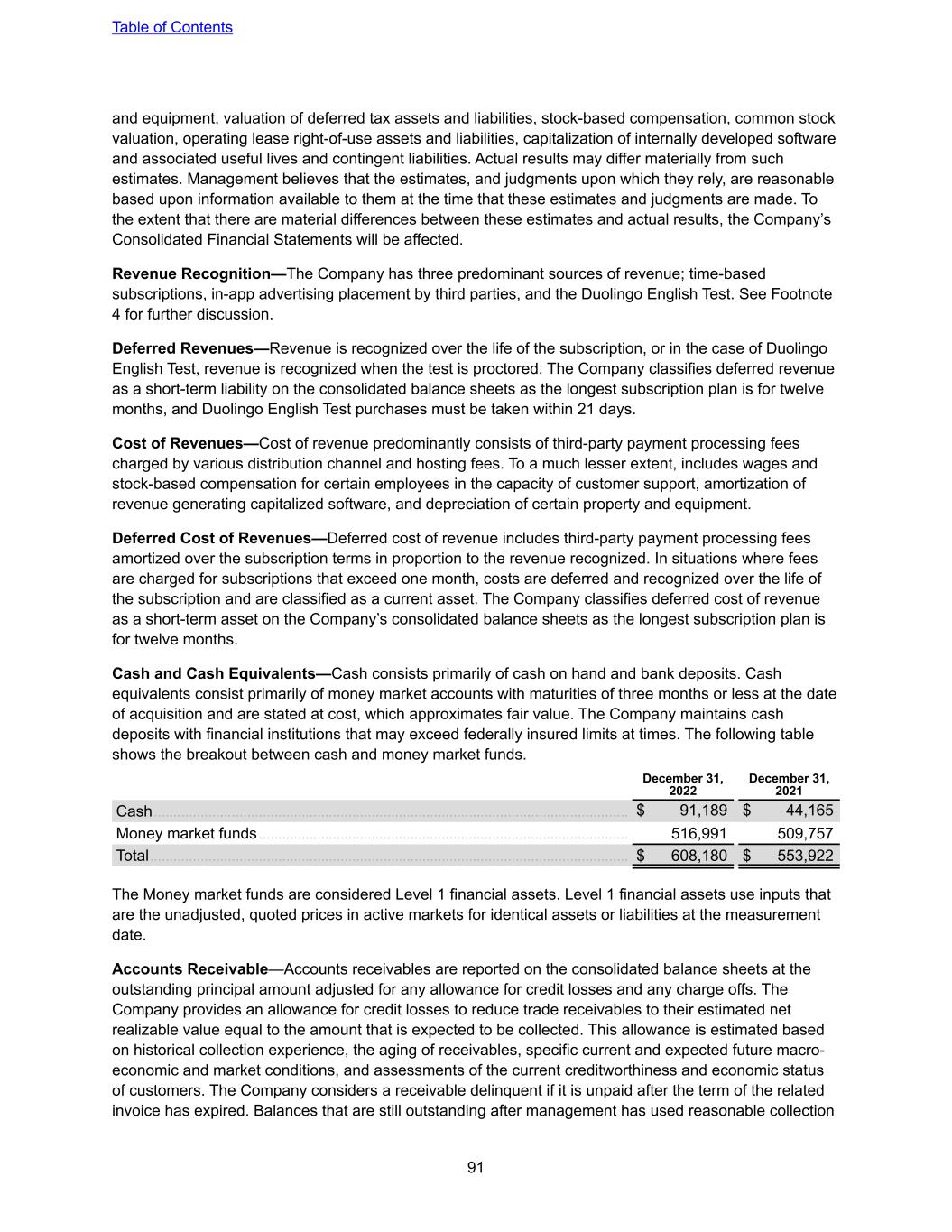
and equipment, valuation of deferred tax assets and liabilities, stock-based compensation, common stock valuation, operating lease right-of-use assets and liabilities, capitalization of internally developed software and associated useful lives and contingent liabilities. Actual results may differ materially from such estimates. Management believes that the estimates, and judgments upon which they rely, are reasonable based upon information available to them at the time that these estimates and judgments are made. To the extent that there are material differences between these estimates and actual results, the Company’s Consolidated Financial Statements will be affected. Revenue Recognition—The Company has three predominant sources of revenue; time-based subscriptions, in-app advertising placement by third parties, and the Duolingo English Test. See Footnote 4 for further discussion. Deferred Revenues—Revenue is recognized over the life of the subscription, or in the case of Duolingo English Test, revenue is recognized when the test is proctored. The Company classifies deferred revenue as a short-term liability on the consolidated balance sheets as the longest subscription plan is for twelve months, and Duolingo English Test purchases must be taken within 21 days. Cost of Revenues—Cost of revenue predominantly consists of third-party payment processing fees charged by various distribution channel and hosting fees. To a much lesser extent, includes wages and stock-based compensation for certain employees in the capacity of customer support, amortization of revenue generating capitalized software, and depreciation of certain property and equipment. Deferred Cost of Revenues—Deferred cost of revenue includes third-party payment processing fees amortized over the subscription terms in proportion to the revenue recognized. In situations where fees are charged for subscriptions that exceed one month, costs are deferred and recognized over the life of the subscription and are classified as a current asset. The Company classifies deferred cost of revenue as a short-term asset on the Company’s consolidated balance sheets as the longest subscription plan is for twelve months. Cash and Cash Equivalents—Cash consists primarily of cash on hand and bank deposits. Cash equivalents consist primarily of money market accounts with maturities of three months or less at the date of acquisition and are stated at cost, which approximates fair value. The Company maintains cash deposits with financial institutions that may exceed federally insured limits at times. The following table shows the breakout between cash and money market funds. December 31, 2022 December 31, 2021 Cash .......................................................................................................................... $ 91,189 $ 44,165 Money market funds ............................................................................................... 516,991 509,757 Total ........................................................................................................................... $ 608,180 $ 553,922 The Money market funds are considered Level 1 financial assets. Level 1 financial assets use inputs that are the unadjusted, quoted prices in active markets for identical assets or liabilities at the measurement date. Accounts Receivable—Accounts receivables are reported on the consolidated balance sheets at the outstanding principal amount adjusted for any allowance for credit losses and any charge offs. The Company provides an allowance for credit losses to reduce trade receivables to their estimated net realizable value equal to the amount that is expected to be collected. This allowance is estimated based on historical collection experience, the aging of receivables, specific current and expected future macro- economic and market conditions, and assessments of the current creditworthiness and economic status of customers. The Company considers a receivable delinquent if it is unpaid after the term of the related invoice has expired. Balances that are still outstanding after management has used reasonable collection Table of Contents 91
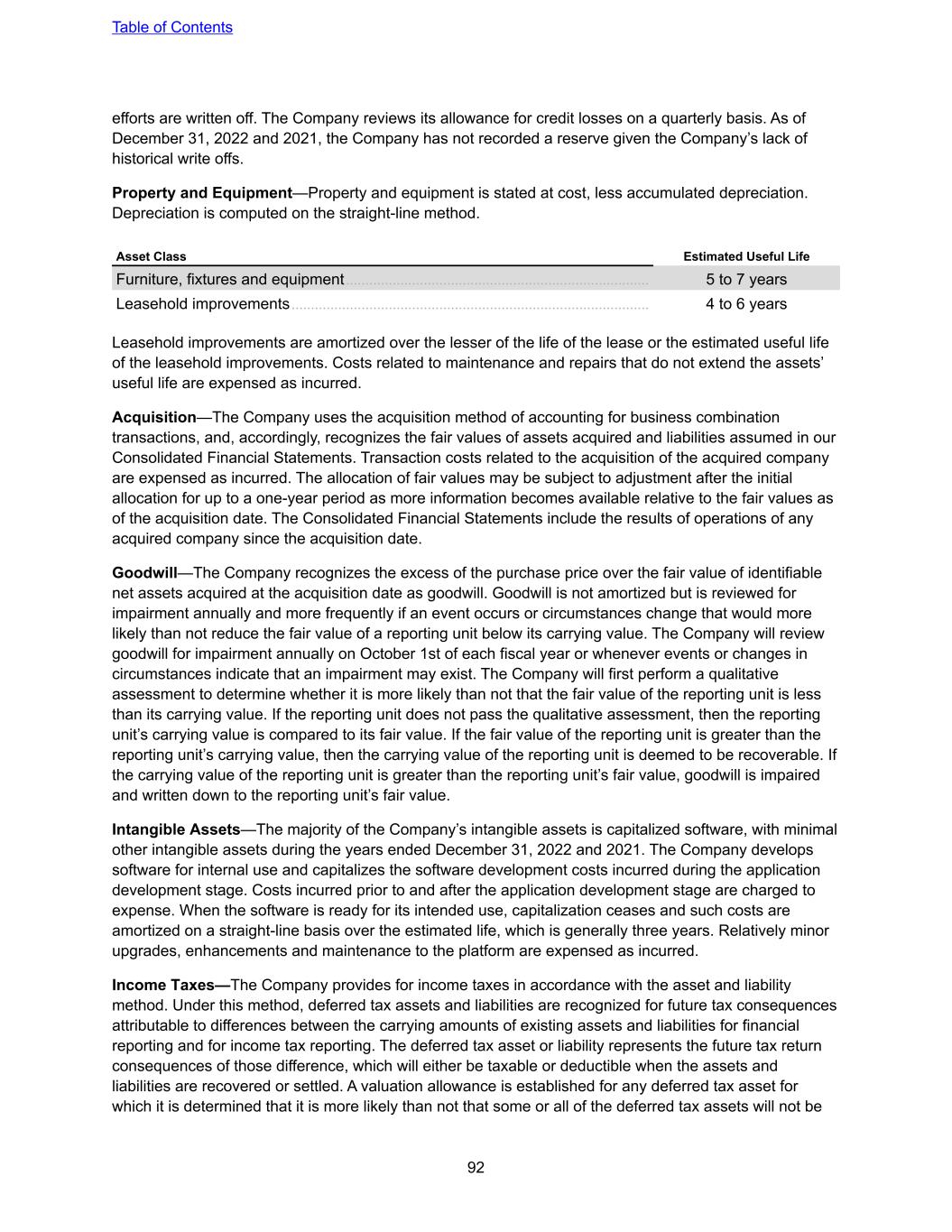
efforts are written off. The Company reviews its allowance for credit losses on a quarterly basis. As of December 31, 2022 and 2021, the Company has not recorded a reserve given the Company’s lack of historical write offs. Property and Equipment—Property and equipment is stated at cost, less accumulated depreciation. Depreciation is computed on the straight-line method. Asset Class Estimated Useful Life Furniture, fixtures and equipment .............................................................................. 5 to 7 years Leasehold improvements ............................................................................................ 4 to 6 years Leasehold improvements are amortized over the lesser of the life of the lease or the estimated useful life of the leasehold improvements. Costs related to maintenance and repairs that do not extend the assets’ useful life are expensed as incurred. Acquisition—The Company uses the acquisition method of accounting for business combination transactions, and, accordingly, recognizes the fair values of assets acquired and liabilities assumed in our Consolidated Financial Statements. Transaction costs related to the acquisition of the acquired company are expensed as incurred. The allocation of fair values may be subject to adjustment after the initial allocation for up to a one-year period as more information becomes available relative to the fair values as of the acquisition date. The Consolidated Financial Statements include the results of operations of any acquired company since the acquisition date. Goodwill—The Company recognizes the excess of the purchase price over the fair value of identifiable net assets acquired at the acquisition date as goodwill. Goodwill is not amortized but is reviewed for impairment annually and more frequently if an event occurs or circumstances change that would more likely than not reduce the fair value of a reporting unit below its carrying value. The Company will review goodwill for impairment annually on October 1st of each fiscal year or whenever events or changes in circumstances indicate that an impairment may exist. The Company will first perform a qualitative assessment to determine whether it is more likely than not that the fair value of the reporting unit is less than its carrying value. If the reporting unit does not pass the qualitative assessment, then the reporting unit’s carrying value is compared to its fair value. If the fair value of the reporting unit is greater than the reporting unit’s carrying value, then the carrying value of the reporting unit is deemed to be recoverable. If the carrying value of the reporting unit is greater than the reporting unit’s fair value, goodwill is impaired and written down to the reporting unit’s fair value. Intangible Assets—The majority of the Company’s intangible assets is capitalized software, with minimal other intangible assets during the years ended December 31, 2022 and 2021. The Company develops software for internal use and capitalizes the software development costs incurred during the application development stage. Costs incurred prior to and after the application development stage are charged to expense. When the software is ready for its intended use, capitalization ceases and such costs are amortized on a straight-line basis over the estimated life, which is generally three years. Relatively minor upgrades, enhancements and maintenance to the platform are expensed as incurred. Income Taxes—The Company provides for income taxes in accordance with the asset and liability method. Under this method, deferred tax assets and liabilities are recognized for future tax consequences attributable to differences between the carrying amounts of existing assets and liabilities for financial reporting and for income tax reporting. The deferred tax asset or liability represents the future tax return consequences of those difference, which will either be taxable or deductible when the assets and liabilities are recovered or settled. A valuation allowance is established for any deferred tax asset for which it is determined that it is more likely than not that some or all of the deferred tax assets will not be Table of Contents 92
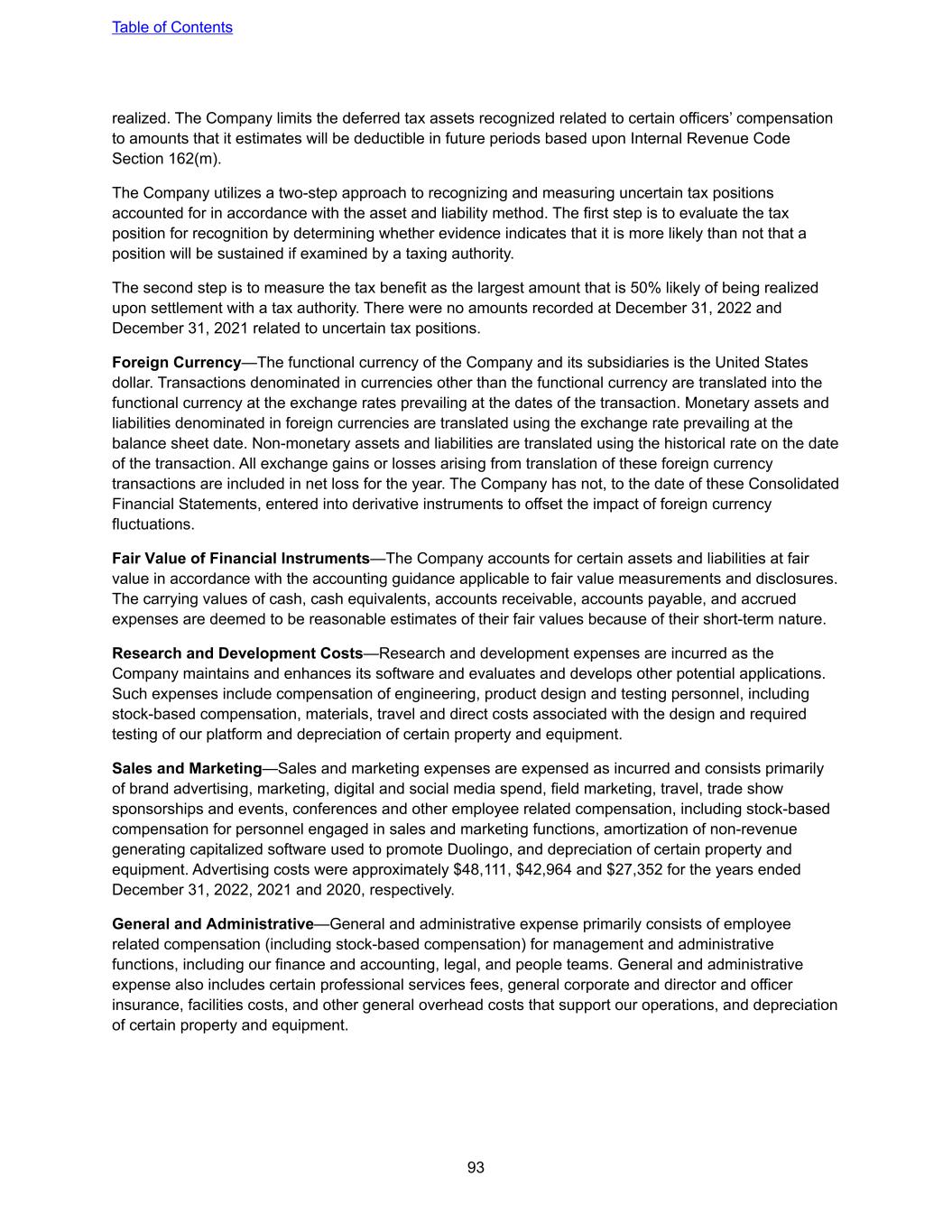
realized. The Company limits the deferred tax assets recognized related to certain officers’ compensation to amounts that it estimates will be deductible in future periods based upon Internal Revenue Code Section 162(m). The Company utilizes a two-step approach to recognizing and measuring uncertain tax positions accounted for in accordance with the asset and liability method. The first step is to evaluate the tax position for recognition by determining whether evidence indicates that it is more likely than not that a position will be sustained if examined by a taxing authority. The second step is to measure the tax benefit as the largest amount that is 50% likely of being realized upon settlement with a tax authority. There were no amounts recorded at December 31, 2022 and December 31, 2021 related to uncertain tax positions. Foreign Currency—The functional currency of the Company and its subsidiaries is the United States dollar. Transactions denominated in currencies other than the functional currency are translated into the functional currency at the exchange rates prevailing at the dates of the transaction. Monetary assets and liabilities denominated in foreign currencies are translated using the exchange rate prevailing at the balance sheet date. Non-monetary assets and liabilities are translated using the historical rate on the date of the transaction. All exchange gains or losses arising from translation of these foreign currency transactions are included in net loss for the year. The Company has not, to the date of these Consolidated Financial Statements, entered into derivative instruments to offset the impact of foreign currency fluctuations. Fair Value of Financial Instruments—The Company accounts for certain assets and liabilities at fair value in accordance with the accounting guidance applicable to fair value measurements and disclosures. The carrying values of cash, cash equivalents, accounts receivable, accounts payable, and accrued expenses are deemed to be reasonable estimates of their fair values because of their short-term nature. Research and Development Costs—Research and development expenses are incurred as the Company maintains and enhances its software and evaluates and develops other potential applications. Such expenses include compensation of engineering, product design and testing personnel, including stock-based compensation, materials, travel and direct costs associated with the design and required testing of our platform and depreciation of certain property and equipment. Sales and Marketing—Sales and marketing expenses are expensed as incurred and consists primarily of brand advertising, marketing, digital and social media spend, field marketing, travel, trade show sponsorships and events, conferences and other employee related compensation, including stock-based compensation for personnel engaged in sales and marketing functions, amortization of non-revenue generating capitalized software used to promote Duolingo, and depreciation of certain property and equipment. Advertising costs were approximately $48,111, $42,964 and $27,352 for the years ended December 31, 2022, 2021 and 2020, respectively. General and Administrative—General and administrative expense primarily consists of employee related compensation (including stock-based compensation) for management and administrative functions, including our finance and accounting, legal, and people teams. General and administrative expense also includes certain professional services fees, general corporate and director and officer insurance, facilities costs, and other general overhead costs that support our operations, and depreciation of certain property and equipment. Table of Contents 93
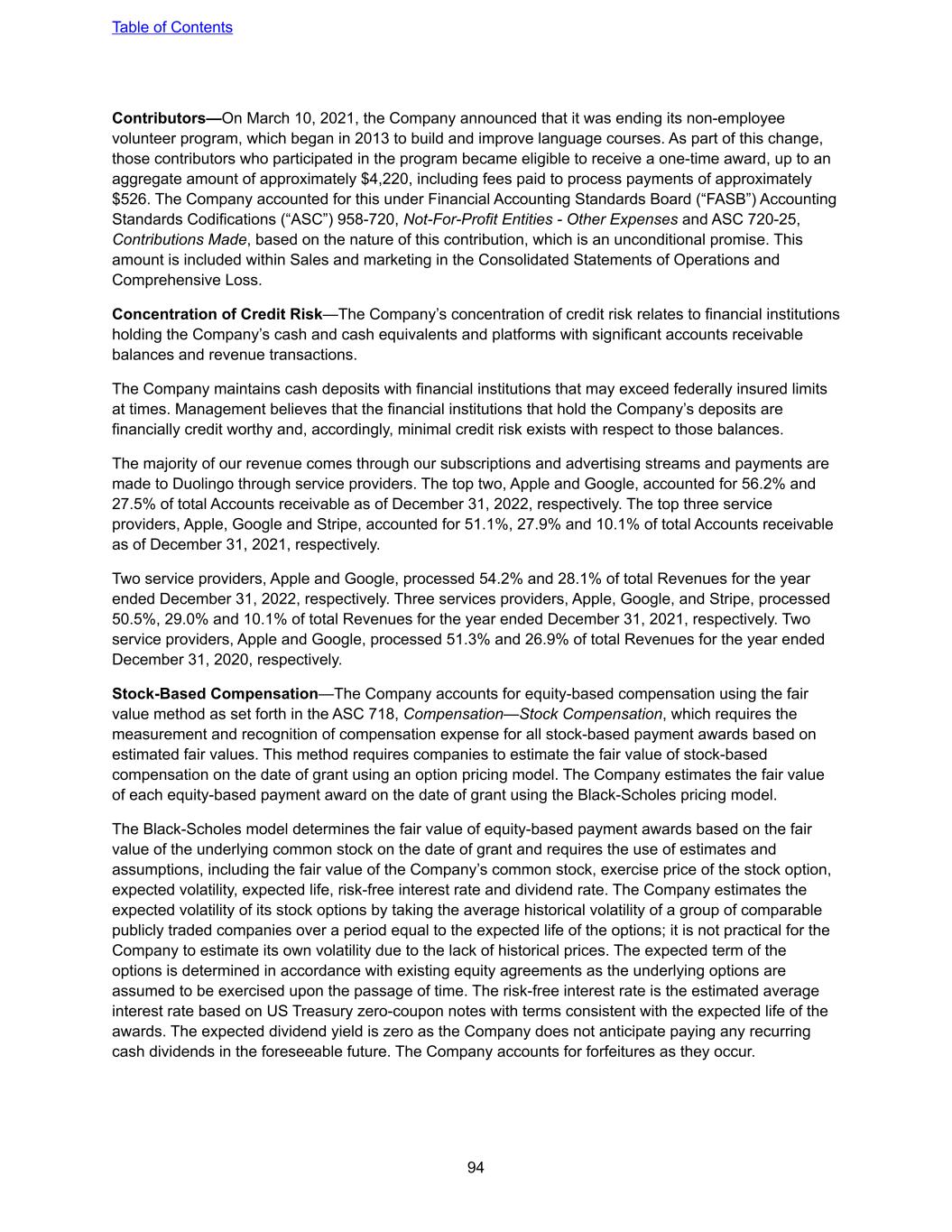
Contributors—On March 10, 2021, the Company announced that it was ending its non-employee volunteer program, which began in 2013 to build and improve language courses. As part of this change, those contributors who participated in the program became eligible to receive a one-time award, up to an aggregate amount of approximately $4,220, including fees paid to process payments of approximately $526. The Company accounted for this under Financial Accounting Standards Board (“FASB”) Accounting Standards Codifications (“ASC”) 958-720, Not-For-Profit Entities - Other Expenses and ASC 720-25, Contributions Made, based on the nature of this contribution, which is an unconditional promise. This amount is included within Sales and marketing in the Consolidated Statements of Operations and Comprehensive Loss. Concentration of Credit Risk—The Company’s concentration of credit risk relates to financial institutions holding the Company’s cash and cash equivalents and platforms with significant accounts receivable balances and revenue transactions. The Company maintains cash deposits with financial institutions that may exceed federally insured limits at times. Management believes that the financial institutions that hold the Company’s deposits are financially credit worthy and, accordingly, minimal credit risk exists with respect to those balances. The majority of our revenue comes through our subscriptions and advertising streams and payments are made to Duolingo through service providers. The top two, Apple and Google, accounted for 56.2% and 27.5% of total Accounts receivable as of December 31, 2022, respectively. The top three service providers, Apple, Google and Stripe, accounted for 51.1%, 27.9% and 10.1% of total Accounts receivable as of December 31, 2021, respectively. Two service providers, Apple and Google, processed 54.2% and 28.1% of total Revenues for the year ended December 31, 2022, respectively. Three services providers, Apple, Google, and Stripe, processed 50.5%, 29.0% and 10.1% of total Revenues for the year ended December 31, 2021, respectively. Two service providers, Apple and Google, processed 51.3% and 26.9% of total Revenues for the year ended December 31, 2020, respectively. Stock-Based Compensation—The Company accounts for equity-based compensation using the fair value method as set forth in the ASC 718, Compensation—Stock Compensation, which requires the measurement and recognition of compensation expense for all stock-based payment awards based on estimated fair values. This method requires companies to estimate the fair value of stock-based compensation on the date of grant using an option pricing model. The Company estimates the fair value of each equity-based payment award on the date of grant using the Black-Scholes pricing model. The Black-Scholes model determines the fair value of equity-based payment awards based on the fair value of the underlying common stock on the date of grant and requires the use of estimates and assumptions, including the fair value of the Company’s common stock, exercise price of the stock option, expected volatility, expected life, risk-free interest rate and dividend rate. The Company estimates the expected volatility of its stock options by taking the average historical volatility of a group of comparable publicly traded companies over a period equal to the expected life of the options; it is not practical for the Company to estimate its own volatility due to the lack of historical prices. The expected term of the options is determined in accordance with existing equity agreements as the underlying options are assumed to be exercised upon the passage of time. The risk-free interest rate is the estimated average interest rate based on US Treasury zero-coupon notes with terms consistent with the expected life of the awards. The expected dividend yield is zero as the Company does not anticipate paying any recurring cash dividends in the foreseeable future. The Company accounts for forfeitures as they occur. Table of Contents 94
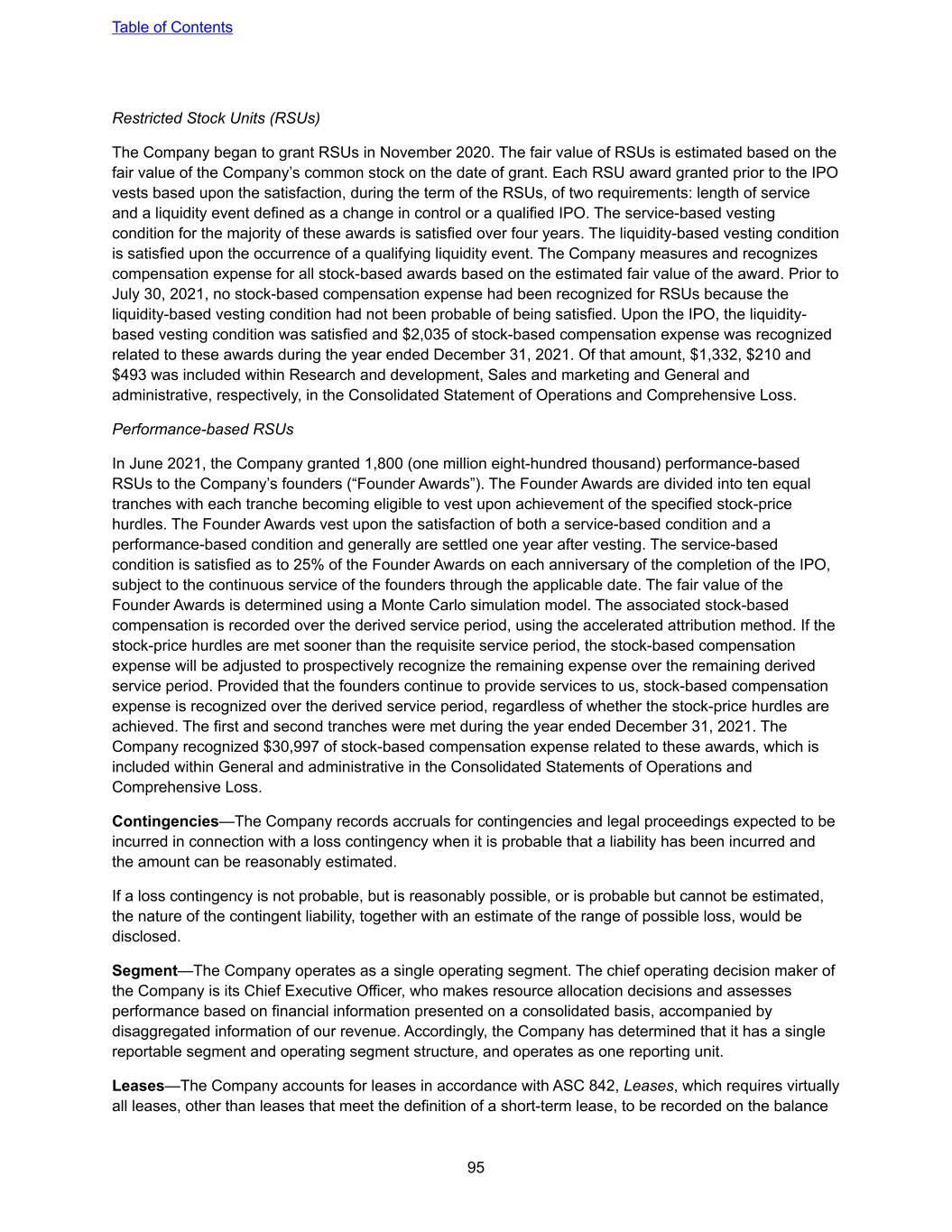
Restricted Stock Units (RSUs) The Company began to grant RSUs in November 2020. The fair value of RSUs is estimated based on the fair value of the Company’s common stock on the date of grant. Each RSU award granted prior to the IPO vests based upon the satisfaction, during the term of the RSUs, of two requirements: length of service and a liquidity event defined as a change in control or a qualified IPO. The service-based vesting condition for the majority of these awards is satisfied over four years. The liquidity-based vesting condition is satisfied upon the occurrence of a qualifying liquidity event. The Company measures and recognizes compensation expense for all stock-based awards based on the estimated fair value of the award. Prior to July 30, 2021, no stock-based compensation expense had been recognized for RSUs because the liquidity-based vesting condition had not been probable of being satisfied. Upon the IPO, the liquidity- based vesting condition was satisfied and $2,035 of stock-based compensation expense was recognized related to these awards during the year ended December 31, 2021. Of that amount, $1,332, $210 and $493 was included within Research and development, Sales and marketing and General and administrative, respectively, in the Consolidated Statement of Operations and Comprehensive Loss. Performance-based RSUs In June 2021, the Company granted 1,800 (one million eight-hundred thousand) performance-based RSUs to the Company’s founders (“Founder Awards”). The Founder Awards are divided into ten equal tranches with each tranche becoming eligible to vest upon achievement of the specified stock-price hurdles. The Founder Awards vest upon the satisfaction of both a service-based condition and a performance-based condition and generally are settled one year after vesting. The service-based condition is satisfied as to 25% of the Founder Awards on each anniversary of the completion of the IPO, subject to the continuous service of the founders through the applicable date. The fair value of the Founder Awards is determined using a Monte Carlo simulation model. The associated stock-based compensation is recorded over the derived service period, using the accelerated attribution method. If the stock-price hurdles are met sooner than the requisite service period, the stock-based compensation expense will be adjusted to prospectively recognize the remaining expense over the remaining derived service period. Provided that the founders continue to provide services to us, stock-based compensation expense is recognized over the derived service period, regardless of whether the stock-price hurdles are achieved. The first and second tranches were met during the year ended December 31, 2021. The Company recognized $30,997 of stock-based compensation expense related to these awards, which is included within General and administrative in the Consolidated Statements of Operations and Comprehensive Loss. Contingencies—The Company records accruals for contingencies and legal proceedings expected to be incurred in connection with a loss contingency when it is probable that a liability has been incurred and the amount can be reasonably estimated. If a loss contingency is not probable, but is reasonably possible, or is probable but cannot be estimated, the nature of the contingent liability, together with an estimate of the range of possible loss, would be disclosed. Segment—The Company operates as a single operating segment. The chief operating decision maker of the Company is its Chief Executive Officer, who makes resource allocation decisions and assesses performance based on financial information presented on a consolidated basis, accompanied by disaggregated information of our revenue. Accordingly, the Company has determined that it has a single reportable segment and operating segment structure, and operates as one reporting unit. Leases—The Company accounts for leases in accordance with ASC 842, Leases, which requires virtually all leases, other than leases that meet the definition of a short-term lease, to be recorded on the balance Table of Contents 95
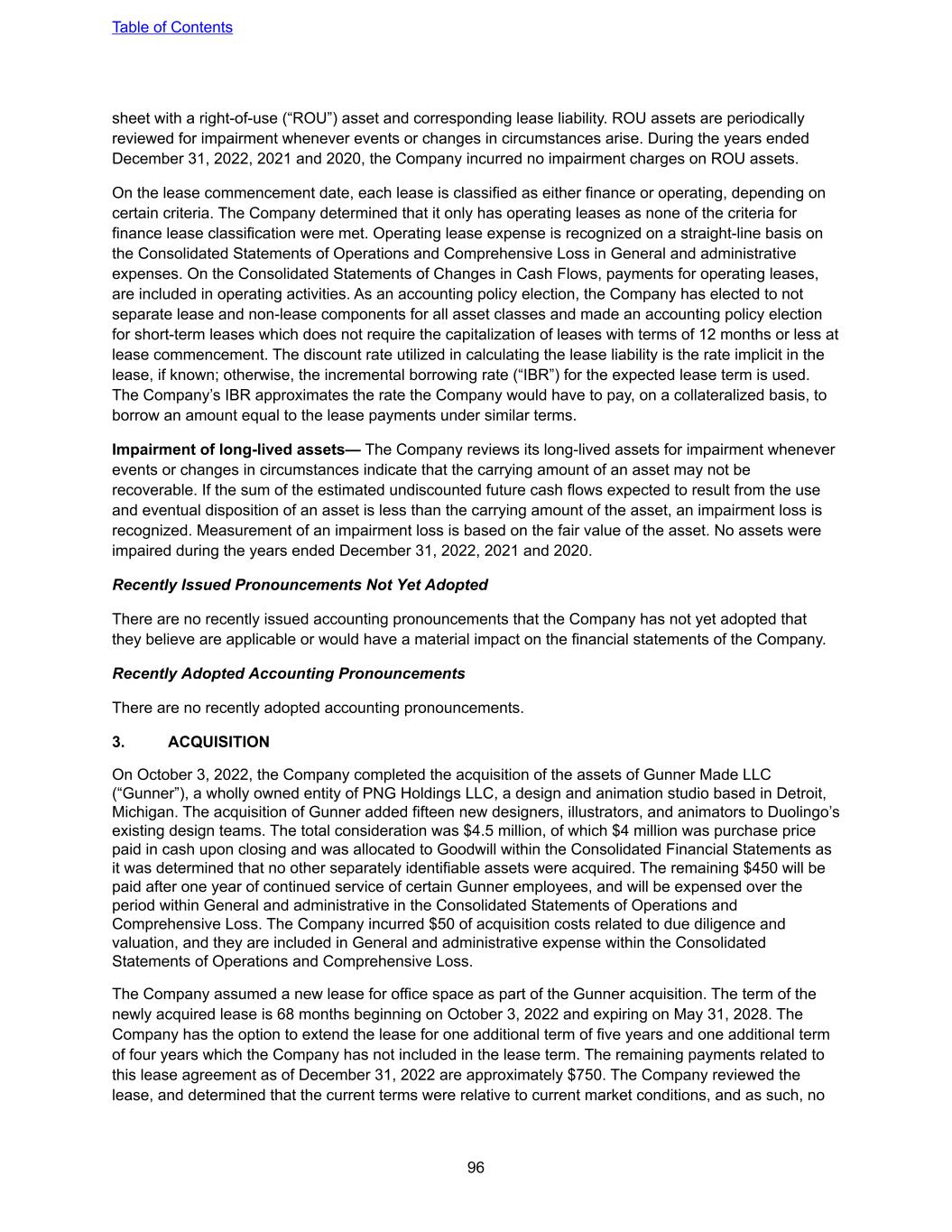
sheet with a right-of-use (“ROU”) asset and corresponding lease liability. ROU assets are periodically reviewed for impairment whenever events or changes in circumstances arise. During the years ended December 31, 2022, 2021 and 2020, the Company incurred no impairment charges on ROU assets. On the lease commencement date, each lease is classified as either finance or operating, depending on certain criteria. The Company determined that it only has operating leases as none of the criteria for finance lease classification were met. Operating lease expense is recognized on a straight-line basis on the Consolidated Statements of Operations and Comprehensive Loss in General and administrative expenses. On the Consolidated Statements of Changes in Cash Flows, payments for operating leases, are included in operating activities. As an accounting policy election, the Company has elected to not separate lease and non-lease components for all asset classes and made an accounting policy election for short-term leases which does not require the capitalization of leases with terms of 12 months or less at lease commencement. The discount rate utilized in calculating the lease liability is the rate implicit in the lease, if known; otherwise, the incremental borrowing rate (“IBR”) for the expected lease term is used. The Company’s IBR approximates the rate the Company would have to pay, on a collateralized basis, to borrow an amount equal to the lease payments under similar terms. Impairment of long-lived assets— The Company reviews its long-lived assets for impairment whenever events or changes in circumstances indicate that the carrying amount of an asset may not be recoverable. If the sum of the estimated undiscounted future cash flows expected to result from the use and eventual disposition of an asset is less than the carrying amount of the asset, an impairment loss is recognized. Measurement of an impairment loss is based on the fair value of the asset. No assets were impaired during the years ended December 31, 2022, 2021 and 2020. Recently Issued Pronouncements Not Yet Adopted There are no recently issued accounting pronouncements that the Company has not yet adopted that they believe are applicable or would have a material impact on the financial statements of the Company. Recently Adopted Accounting Pronouncements There are no recently adopted accounting pronouncements. 3. ACQUISITION On October 3, 2022, the Company completed the acquisition of the assets of Gunner Made LLC (“Gunner”), a wholly owned entity of PNG Holdings LLC, a design and animation studio based in Detroit, Michigan. The acquisition of Gunner added fifteen new designers, illustrators, and animators to Duolingo’s existing design teams. The total consideration was $4.5 million, of which $4 million was purchase price paid in cash upon closing and was allocated to Goodwill within the Consolidated Financial Statements as it was determined that no other separately identifiable assets were acquired. The remaining $450 will be paid after one year of continued service of certain Gunner employees, and will be expensed over the period within General and administrative in the Consolidated Statements of Operations and Comprehensive Loss. The Company incurred $50 of acquisition costs related to due diligence and valuation, and they are included in General and administrative expense within the Consolidated Statements of Operations and Comprehensive Loss. The Company assumed a new lease for office space as part of the Gunner acquisition. The term of the newly acquired lease is 68 months beginning on October 3, 2022 and expiring on May 31, 2028. The Company has the option to extend the lease for one additional term of five years and one additional term of four years which the Company has not included in the lease term. The remaining payments related to this lease agreement as of December 31, 2022 are approximately $750. The Company reviewed the lease, and determined that the current terms were relative to current market conditions, and as such, no Table of Contents 96
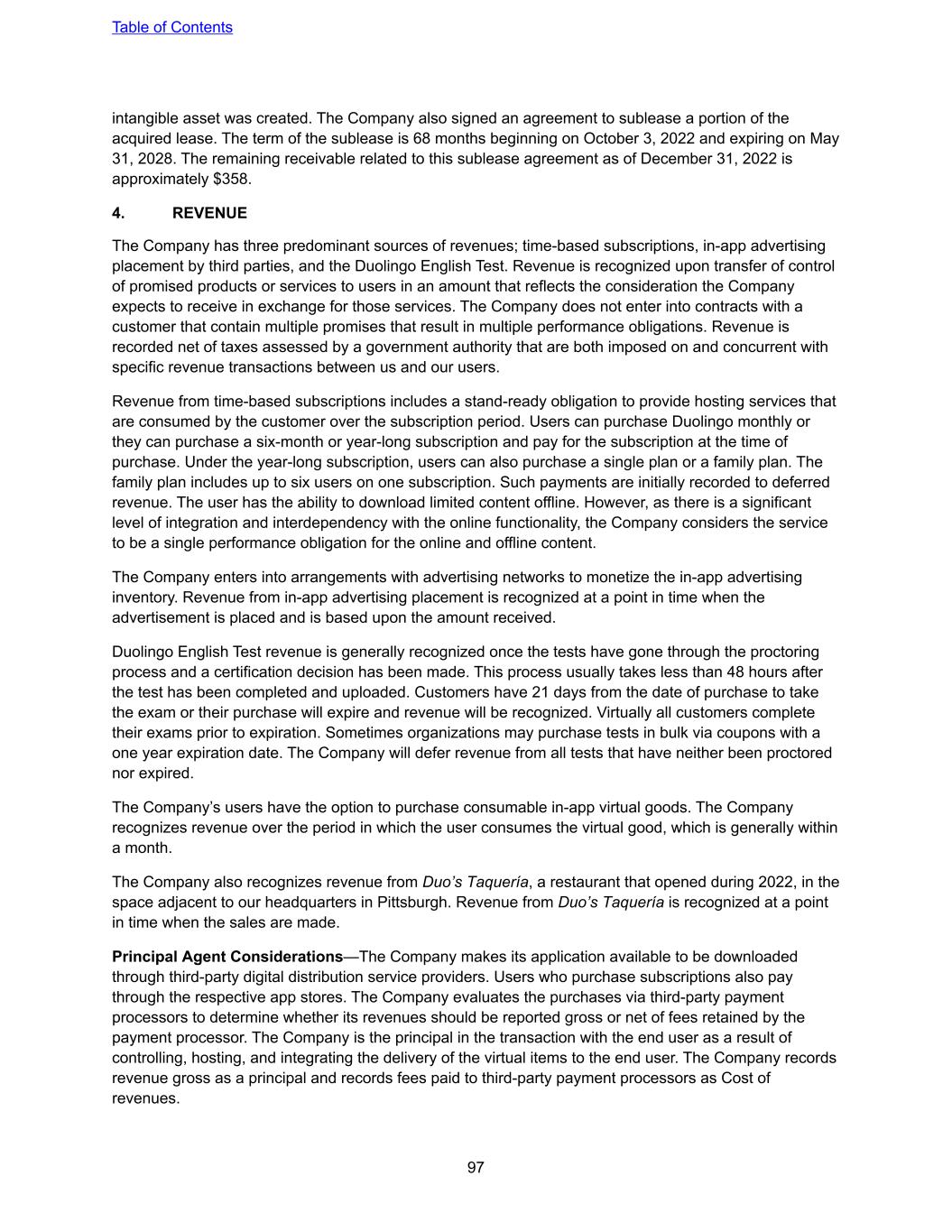
intangible asset was created. The Company also signed an agreement to sublease a portion of the acquired lease. The term of the sublease is 68 months beginning on October 3, 2022 and expiring on May 31, 2028. The remaining receivable related to this sublease agreement as of December 31, 2022 is approximately $358. 4. REVENUE The Company has three predominant sources of revenues; time-based subscriptions, in-app advertising placement by third parties, and the Duolingo English Test. Revenue is recognized upon transfer of control of promised products or services to users in an amount that reflects the consideration the Company expects to receive in exchange for those services. The Company does not enter into contracts with a customer that contain multiple promises that result in multiple performance obligations. Revenue is recorded net of taxes assessed by a government authority that are both imposed on and concurrent with specific revenue transactions between us and our users. Revenue from time-based subscriptions includes a stand-ready obligation to provide hosting services that are consumed by the customer over the subscription period. Users can purchase Duolingo monthly or they can purchase a six-month or year-long subscription and pay for the subscription at the time of purchase. Under the year-long subscription, users can also purchase a single plan or a family plan. The family plan includes up to six users on one subscription. Such payments are initially recorded to deferred revenue. The user has the ability to download limited content offline. However, as there is a significant level of integration and interdependency with the online functionality, the Company considers the service to be a single performance obligation for the online and offline content. The Company enters into arrangements with advertising networks to monetize the in-app advertising inventory. Revenue from in-app advertising placement is recognized at a point in time when the advertisement is placed and is based upon the amount received. Duolingo English Test revenue is generally recognized once the tests have gone through the proctoring process and a certification decision has been made. This process usually takes less than 48 hours after the test has been completed and uploaded. Customers have 21 days from the date of purchase to take the exam or their purchase will expire and revenue will be recognized. Virtually all customers complete their exams prior to expiration. Sometimes organizations may purchase tests in bulk via coupons with a one year expiration date. The Company will defer revenue from all tests that have neither been proctored nor expired. The Company’s users have the option to purchase consumable in-app virtual goods. The Company recognizes revenue over the period in which the user consumes the virtual good, which is generally within a month. The Company also recognizes revenue from Duo’s Taquería, a restaurant that opened during 2022, in the space adjacent to our headquarters in Pittsburgh. Revenue from Duo’s Taquería is recognized at a point in time when the sales are made. Principal Agent Considerations—The Company makes its application available to be downloaded through third-party digital distribution service providers. Users who purchase subscriptions also pay through the respective app stores. The Company evaluates the purchases via third-party payment processors to determine whether its revenues should be reported gross or net of fees retained by the payment processor. The Company is the principal in the transaction with the end user as a result of controlling, hosting, and integrating the delivery of the virtual items to the end user. The Company records revenue gross as a principal and records fees paid to third-party payment processors as Cost of revenues. Table of Contents 97
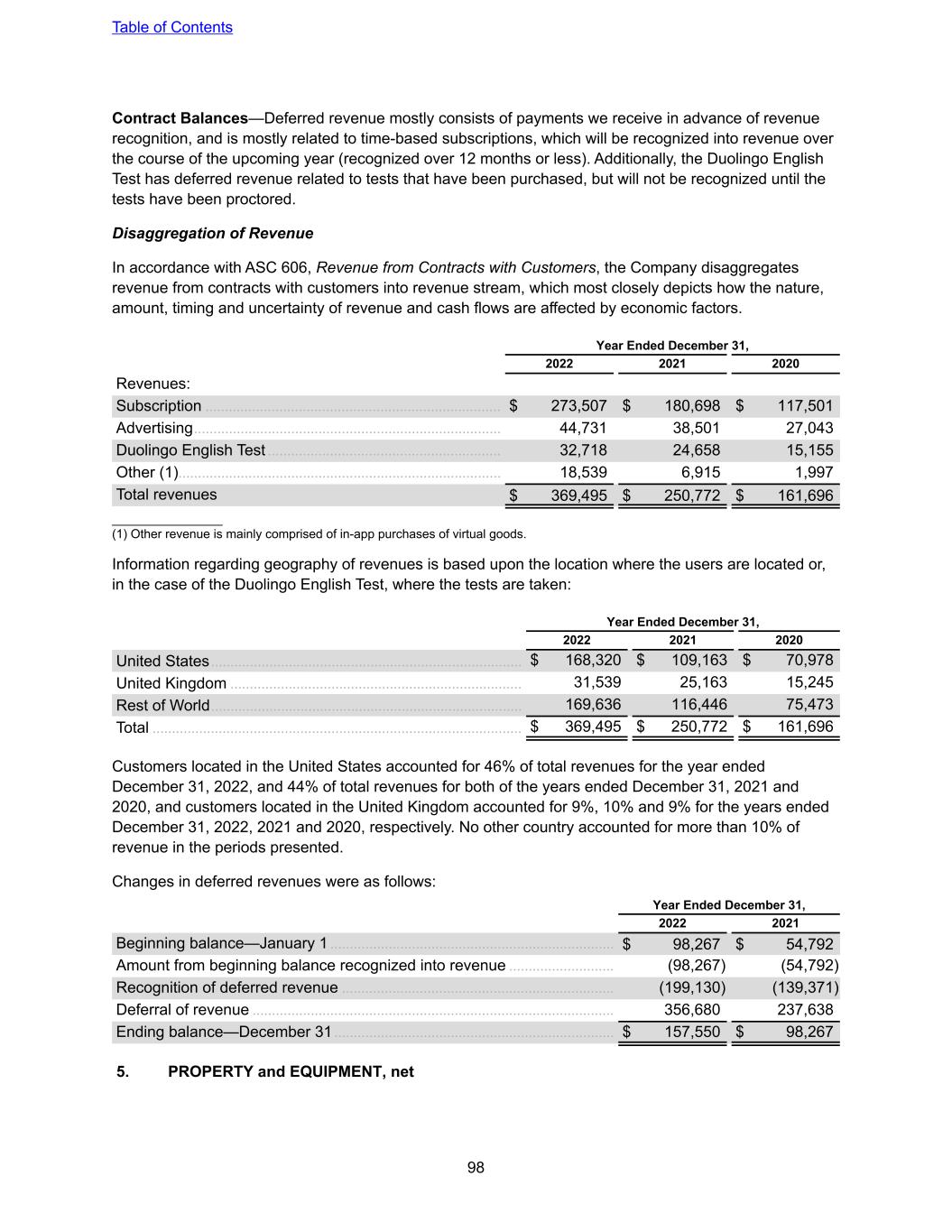
Contract Balances—Deferred revenue mostly consists of payments we receive in advance of revenue recognition, and is mostly related to time-based subscriptions, which will be recognized into revenue over the course of the upcoming year (recognized over 12 months or less). Additionally, the Duolingo English Test has deferred revenue related to tests that have been purchased, but will not be recognized until the tests have been proctored. Disaggregation of Revenue In accordance with ASC 606, Revenue from Contracts with Customers, the Company disaggregates revenue from contracts with customers into revenue stream, which most closely depicts how the nature, amount, timing and uncertainty of revenue and cash flows are affected by economic factors. Year Ended December 31, 2022 2021 2020 Revenues: Subscription ............................................................................ $ 273,507 $ 180,698 $ 117,501 Advertising ............................................................................... 44,731 38,501 27,043 Duolingo English Test ............................................................ 32,718 24,658 15,155 Other (1) ................................................................................... 18,539 6,915 1,997 Total revenues $ 369,495 $ 250,772 $ 161,696 ________________ (1) Other revenue is mainly comprised of in-app purchases of virtual goods. Information regarding geography of revenues is based upon the location where the users are located or, in the case of the Duolingo English Test, where the tests are taken: Year Ended December 31, 2022 2021 2020 United States ................................................................................ $ 168,320 $ 109,163 $ 70,978 United Kingdom ........................................................................... 31,539 25,163 15,245 Rest of World ................................................................................ 169,636 116,446 75,473 Total ............................................................................................... $ 369,495 $ 250,772 $ 161,696 Customers located in the United States accounted for 46% of total revenues for the year ended December 31, 2022, and 44% of total revenues for both of the years ended December 31, 2021 and 2020, and customers located in the United Kingdom accounted for 9%, 10% and 9% for the years ended December 31, 2022, 2021 and 2020, respectively. No other country accounted for more than 10% of revenue in the periods presented. Changes in deferred revenues were as follows: Year Ended December 31, 2022 2021 Beginning balance—January 1 ......................................................................... $ 98,267 $ 54,792 Amount from beginning balance recognized into revenue ........................... (98,267) (54,792) Recognition of deferred revenue ...................................................................... (199,130) (139,371) Deferral of revenue ............................................................................................. 356,680 237,638 Ending balance—December 31 ........................................................................ $ 157,550 $ 98,267 5. PROPERTY and EQUIPMENT, net Table of Contents 98
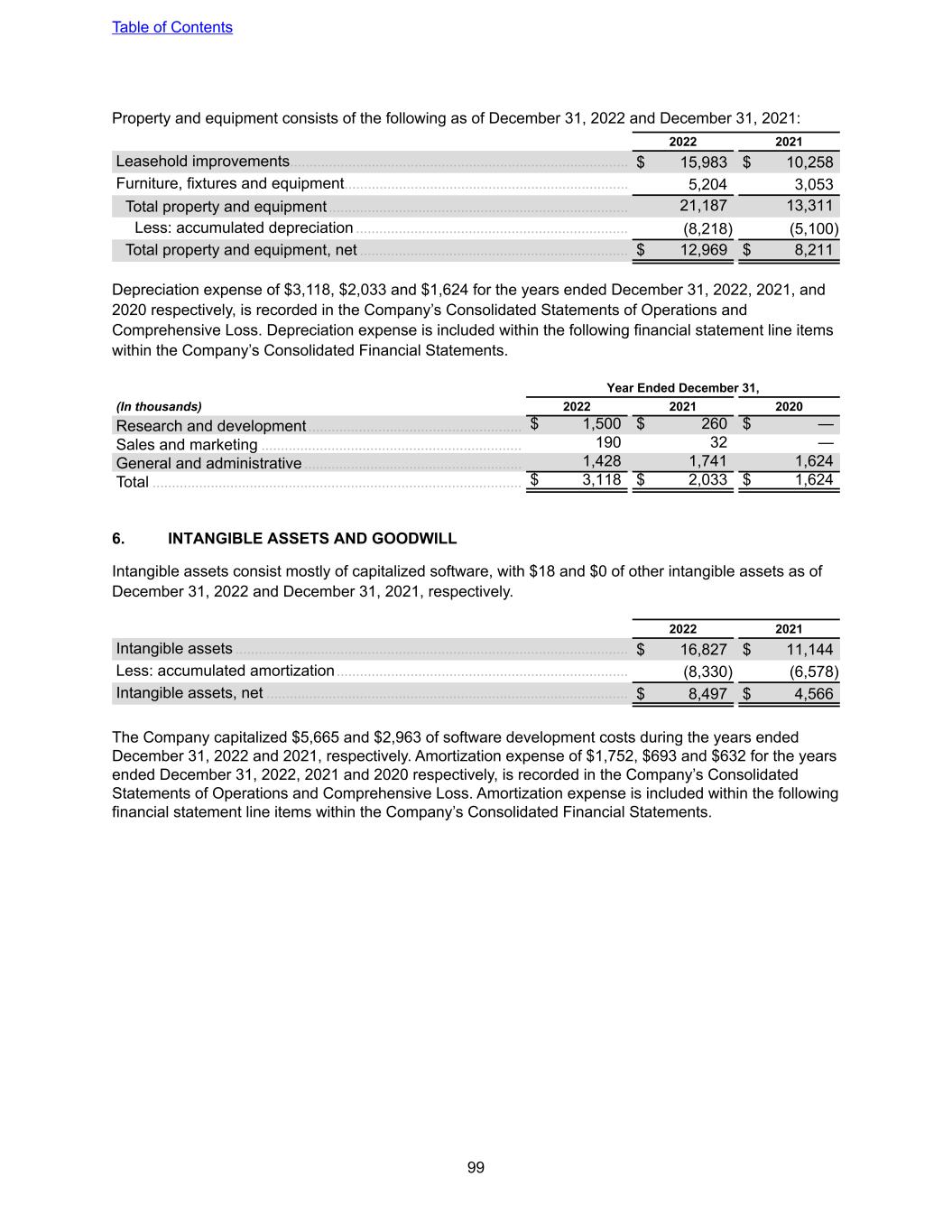
Property and equipment consists of the following as of December 31, 2022 and December 31, 2021: 2022 2021 Leasehold improvements ....................................................................................... $ 15,983 $ 10,258 Furniture, fixtures and equipment ......................................................................... 5,204 3,053 Total property and equipment ............................................................................. 21,187 13,311 Less: accumulated depreciation ...................................................................... (8,218) (5,100) Total property and equipment, net ..................................................................... $ 12,969 $ 8,211 Depreciation expense of $3,118, $2,033 and $1,624 for the years ended December 31, 2022, 2021, and 2020 respectively, is recorded in the Company’s Consolidated Statements of Operations and Comprehensive Loss. Depreciation expense is included within the following financial statement line items within the Company’s Consolidated Financial Statements. Year Ended December 31, (In thousands) 2022 2021 2020 Research and development ....................................................... $ 1,500 $ 260 $ — Sales and marketing ................................................................... 190 32 — General and administrative ........................................................ 1,428 1,741 1,624 Total ............................................................................................... $ 3,118 $ 2,033 $ 1,624 6. INTANGIBLE ASSETS AND GOODWILL Intangible assets consist mostly of capitalized software, with $18 and $0 of other intangible assets as of December 31, 2022 and December 31, 2021, respectively. 2022 2021 Intangible assets ..................................................................................................... $ 16,827 $ 11,144 Less: accumulated amortization ........................................................................... (8,330) (6,578) Intangible assets, net ............................................................................................. $ 8,497 $ 4,566 The Company capitalized $5,665 and $2,963 of software development costs during the years ended December 31, 2022 and 2021, respectively. Amortization expense of $1,752, $693 and $632 for the years ended December 31, 2022, 2021 and 2020 respectively, is recorded in the Company’s Consolidated Statements of Operations and Comprehensive Loss. Amortization expense is included within the following financial statement line items within the Company’s Consolidated Financial Statements. Table of Contents 99
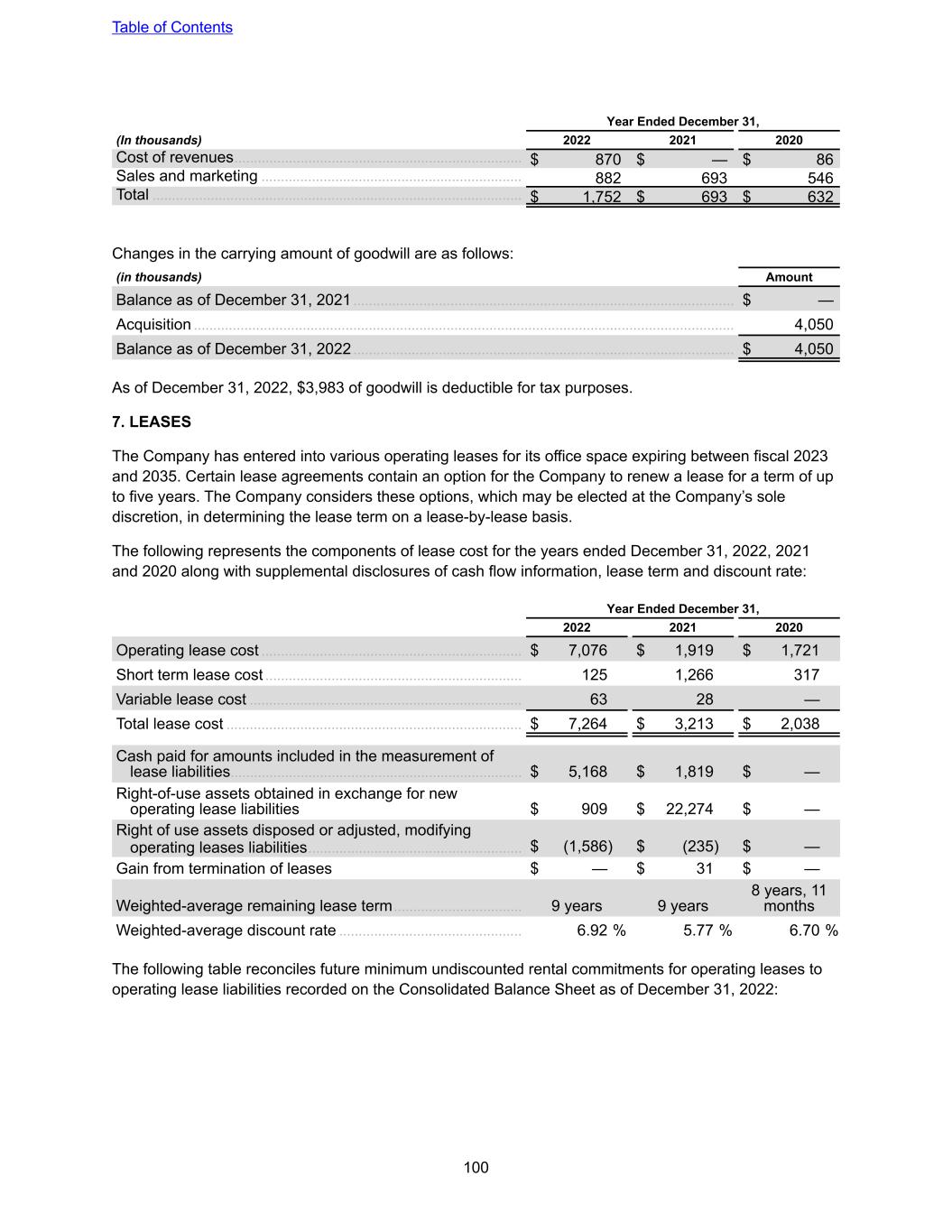
Year Ended December 31, (In thousands) 2022 2021 2020 Cost of revenues .......................................................................... $ 870 $ — $ 86 Sales and marketing ................................................................... 882 693 546 Total ............................................................................................... $ 1,752 $ 693 $ 632 Changes in the carrying amount of goodwill are as follows: (in thousands) Amount Balance as of December 31, 2021 .................................................................................................. $ — Acquisition ........................................................................................................................................... 4,050 Balance as of December 31, 2022 .................................................................................................. $ 4,050 As of December 31, 2022, $3,983 of goodwill is deductible for tax purposes. 7. LEASES The Company has entered into various operating leases for its office space expiring between fiscal 2023 and 2035. Certain lease agreements contain an option for the Company to renew a lease for a term of up to five years. The Company considers these options, which may be elected at the Company’s sole discretion, in determining the lease term on a lease-by-lease basis. The following represents the components of lease cost for the years ended December 31, 2022, 2021 and 2020 along with supplemental disclosures of cash flow information, lease term and discount rate: Year Ended December 31, 2022 2021 2020 Operating lease cost ................................................................... $ 7,076 $ 1,919 $ 1,721 Short term lease cost .................................................................. 125 1,266 317 Variable lease cost ...................................................................... 63 28 — Total lease cost ............................................................................ $ 7,264 $ 3,213 $ 2,038 Cash paid for amounts included in the measurement of lease liabilities ........................................................................... $ 5,168 $ 1,819 $ — Right-of-use assets obtained in exchange for new operating lease liabilities $ 909 $ 22,274 $ — Right of use assets disposed or adjusted, modifying operating leases liabilities ....................................................... $ (1,586) $ (235) $ — Gain from termination of leases $ — $ 31 $ — Weighted-average remaining lease term ................................. 9 years 9 years 8 years, 11 months Weighted-average discount rate ............................................... 6.92 % 5.77 % 6.70 % The following table reconciles future minimum undiscounted rental commitments for operating leases to operating lease liabilities recorded on the Consolidated Balance Sheet as of December 31, 2022: Table of Contents 100
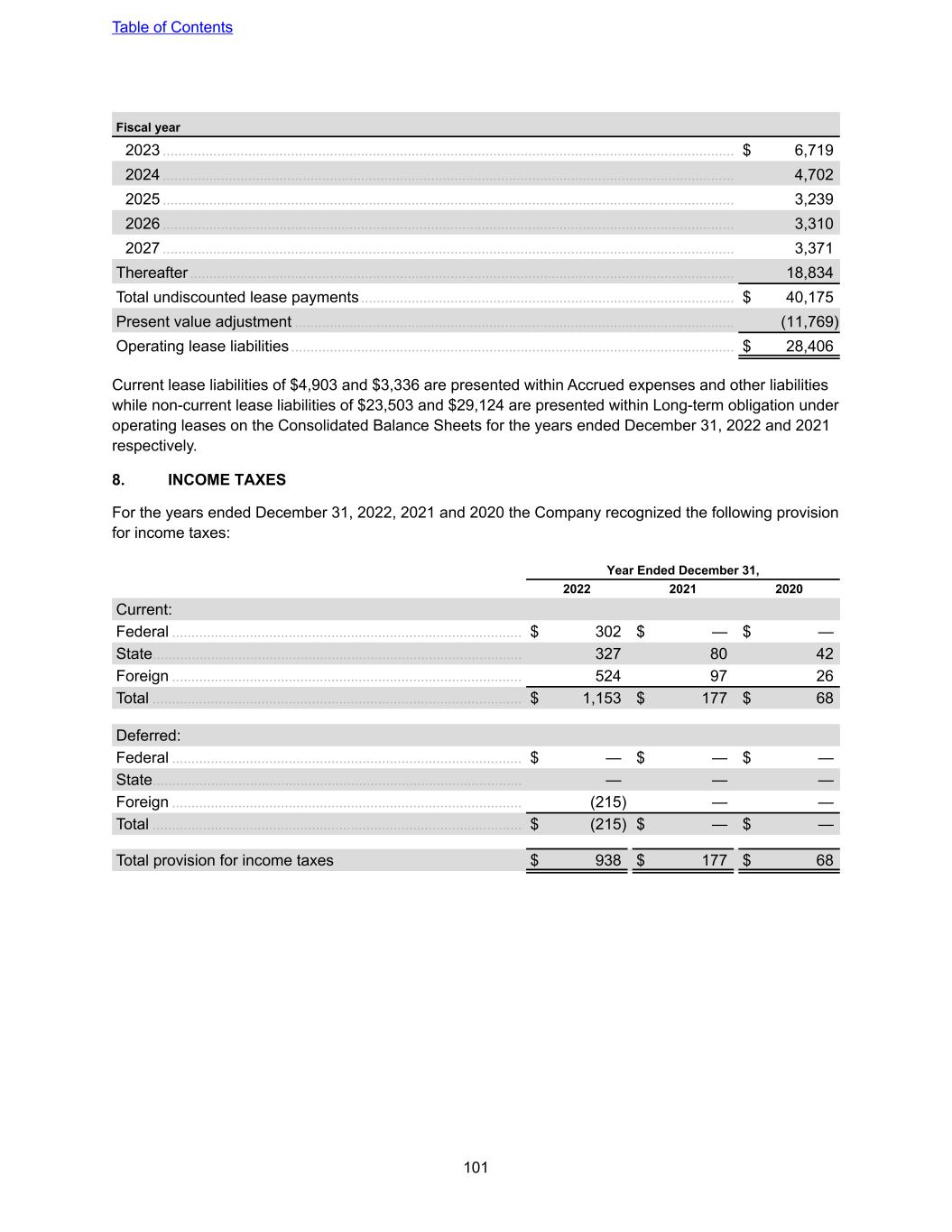
Fiscal year 2023 ................................................................................................................................................... $ 6,719 2024 ................................................................................................................................................... 4,702 2025 ................................................................................................................................................... 3,239 2026 ................................................................................................................................................... 3,310 2027 ................................................................................................................................................... 3,371 Thereafter ............................................................................................................................................ 18,834 Total undiscounted lease payments ................................................................................................ $ 40,175 Present value adjustment ................................................................................................................. (11,769) Operating lease liabilities .................................................................................................................. $ 28,406 Current lease liabilities of $4,903 and $3,336 are presented within Accrued expenses and other liabilities while non-current lease liabilities of $23,503 and $29,124 are presented within Long-term obligation under operating leases on the Consolidated Balance Sheets for the years ended December 31, 2022 and 2021 respectively. 8. INCOME TAXES For the years ended December 31, 2022, 2021 and 2020 the Company recognized the following provision for income taxes: Year Ended December 31, 2022 2021 2020 Current: Federal .......................................................................................... $ 302 $ — $ — State ............................................................................................... 327 80 42 Foreign .......................................................................................... 524 97 26 Total ............................................................................................... $ 1,153 $ 177 $ 68 Deferred: Federal .......................................................................................... $ — $ — $ — State ............................................................................................... — — — Foreign .......................................................................................... (215) — — Total ............................................................................................... $ (215) $ — $ — Total provision for income taxes $ 938 $ 177 $ 68 Table of Contents 101
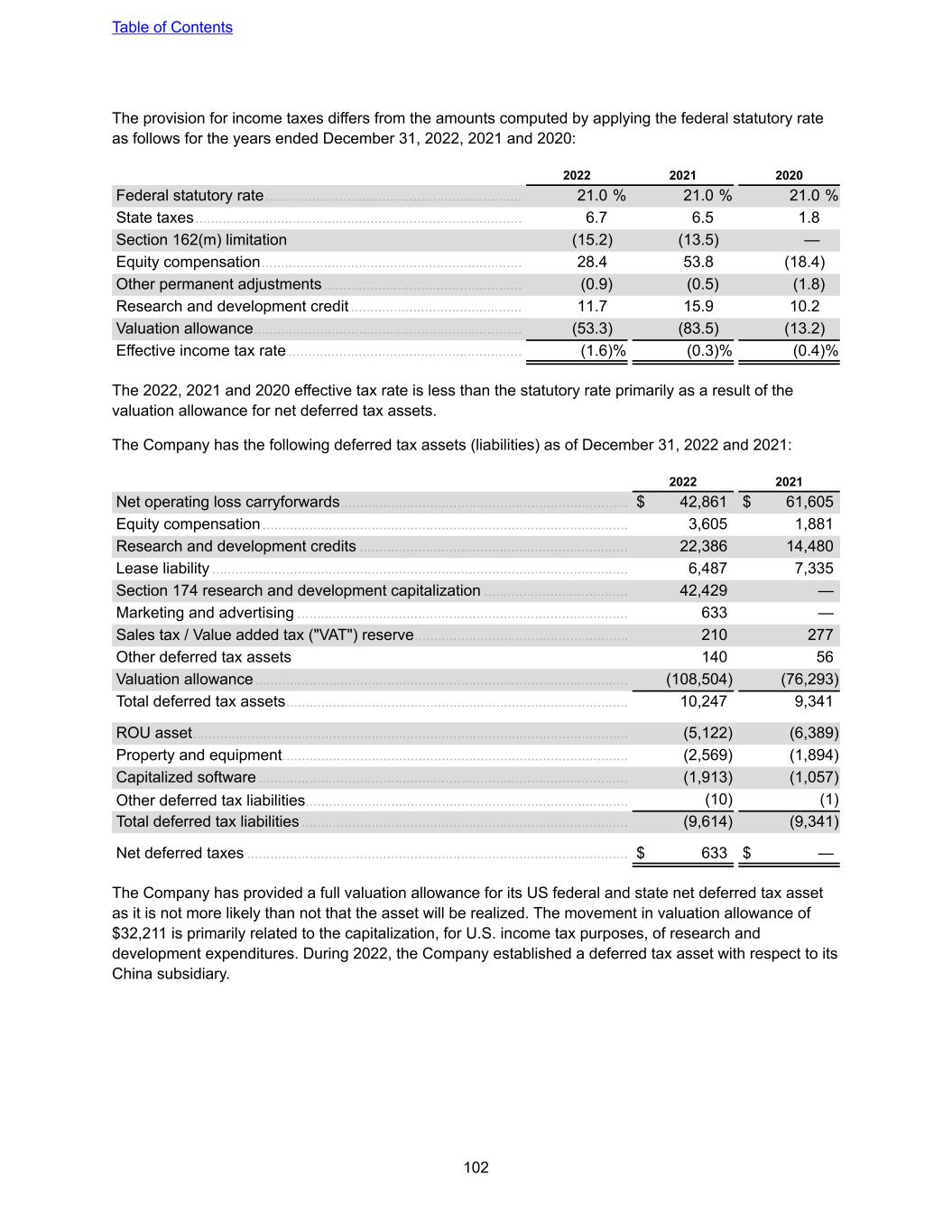
The provision for income taxes differs from the amounts computed by applying the federal statutory rate as follows for the years ended December 31, 2022, 2021 and 2020: 2022 2021 2020 Federal statutory rate .................................................................. 21.0 % 21.0 % 21.0 % State taxes .................................................................................... 6.7 6.5 1.8 Section 162(m) limitation (15.2) (13.5) — Equity compensation ................................................................... 28.4 53.8 (18.4) Other permanent adjustments ................................................... (0.9) (0.5) (1.8) Research and development credit ............................................ 11.7 15.9 10.2 Valuation allowance ..................................................................... (53.3) (83.5) (13.2) Effective income tax rate ............................................................ (1.6) % (0.3) % (0.4) % The 2022, 2021 and 2020 effective tax rate is less than the statutory rate primarily as a result of the valuation allowance for net deferred tax assets. The Company has the following deferred tax assets (liabilities) as of December 31, 2022 and 2021: 2022 2021 Net operating loss carryforwards .......................................................................... $ 42,861 $ 61,605 Equity compensation .............................................................................................. 3,605 1,881 Research and development credits ..................................................................... 22,386 14,480 Lease liability ........................................................................................................... 6,487 7,335 Section 174 research and development capitalization ..................................... 42,429 — Marketing and advertising ..................................................................................... 633 — Sales tax / Value added tax ("VAT") reserve ....................................................... 210 277 Other deferred tax assets 140 56 Valuation allowance ................................................................................................ (108,504) (76,293) Total deferred tax assets ........................................................................................ 10,247 9,341 ROU asset ................................................................................................................ (5,122) (6,389) Property and equipment ......................................................................................... (2,569) (1,894) Capitalized software ............................................................................................... (1,913) (1,057) Other deferred tax liabilities ................................................................................... (10) (1) Total deferred tax liabilities .................................................................................... (9,614) (9,341) Net deferred taxes .................................................................................................. $ 633 $ — The Company has provided a full valuation allowance for its US federal and state net deferred tax asset as it is not more likely than not that the asset will be realized. The movement in valuation allowance of $32,211 is primarily related to the capitalization, for U.S. income tax purposes, of research and development expenditures. During 2022, the Company established a deferred tax asset with respect to its China subsidiary. Table of Contents 102
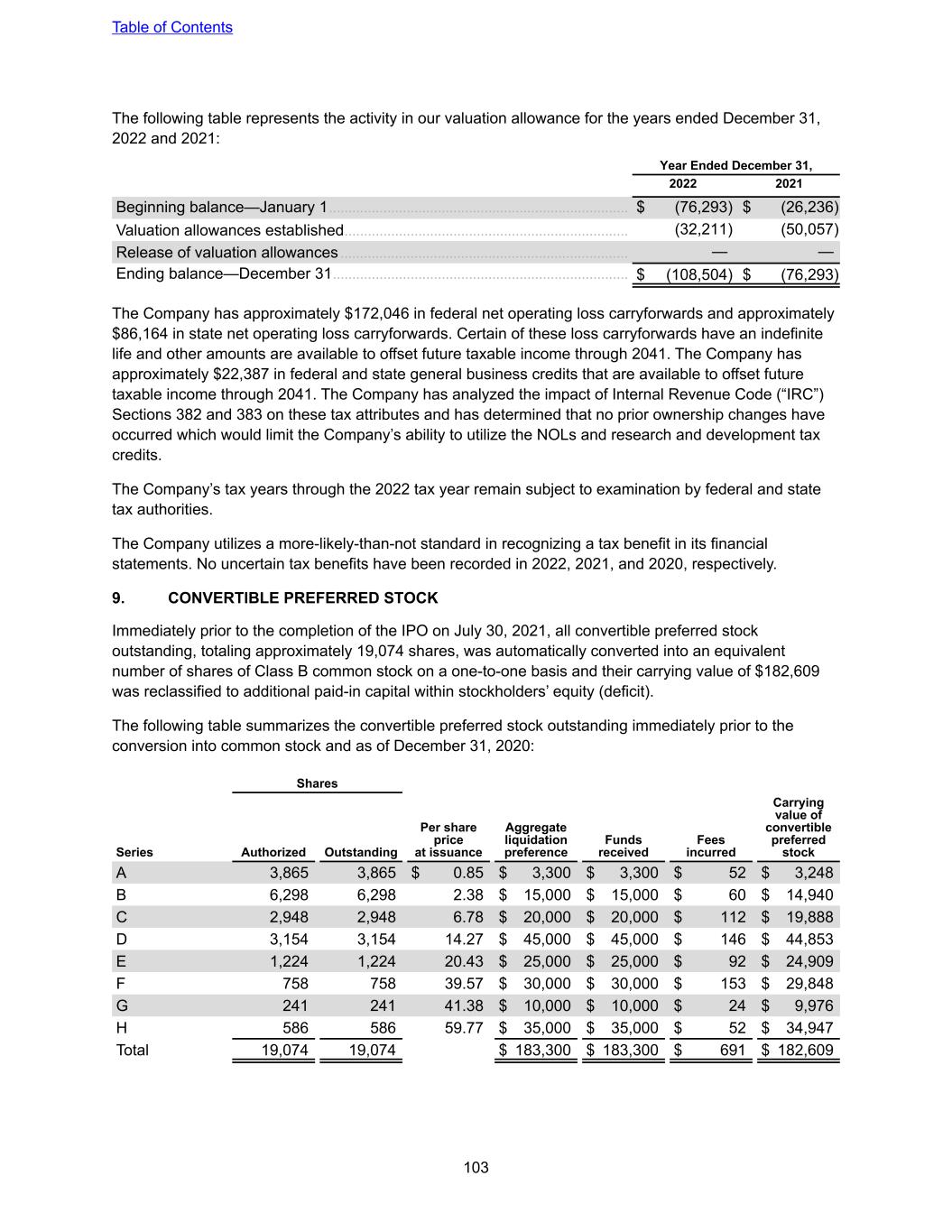
The following table represents the activity in our valuation allowance for the years ended December 31, 2022 and 2021: Year Ended December 31, 2022 2021 Beginning balance—January 1 ............................................................................. $ (76,293) $ (26,236) Valuation allowances established ......................................................................... (32,211) (50,057) Release of valuation allowances .......................................................................... — — Ending balance—December 31 ............................................................................ $ (108,504) $ (76,293) The Company has approximately $172,046 in federal net operating loss carryforwards and approximately $86,164 in state net operating loss carryforwards. Certain of these loss carryforwards have an indefinite life and other amounts are available to offset future taxable income through 2041. The Company has approximately $22,387 in federal and state general business credits that are available to offset future taxable income through 2041. The Company has analyzed the impact of Internal Revenue Code (“IRC”) Sections 382 and 383 on these tax attributes and has determined that no prior ownership changes have occurred which would limit the Company’s ability to utilize the NOLs and research and development tax credits. The Company’s tax years through the 2022 tax year remain subject to examination by federal and state tax authorities. The Company utilizes a more-likely-than-not standard in recognizing a tax benefit in its financial statements. No uncertain tax benefits have been recorded in 2022, 2021, and 2020, respectively. 9. CONVERTIBLE PREFERRED STOCK Immediately prior to the completion of the IPO on July 30, 2021, all convertible preferred stock outstanding, totaling approximately 19,074 shares, was automatically converted into an equivalent number of shares of Class B common stock on a one-to-one basis and their carrying value of $182,609 was reclassified to additional paid-in capital within stockholders’ equity (deficit). The following table summarizes the convertible preferred stock outstanding immediately prior to the conversion into common stock and as of December 31, 2020: Shares Series Authorized Outstanding Per share price at issuance Aggregate liquidation preference Funds received Fees incurred Carrying value of convertible preferred stock A 3,865 3,865 $ 0.85 $ 3,300 $ 3,300 $ 52 $ 3,248 B 6,298 6,298 2.38 $ 15,000 $ 15,000 $ 60 $ 14,940 C 2,948 2,948 6.78 $ 20,000 $ 20,000 $ 112 $ 19,888 D 3,154 3,154 14.27 $ 45,000 $ 45,000 $ 146 $ 44,853 E 1,224 1,224 20.43 $ 25,000 $ 25,000 $ 92 $ 24,909 F 758 758 39.57 $ 30,000 $ 30,000 $ 153 $ 29,848 G 241 241 41.38 $ 10,000 $ 10,000 $ 24 $ 9,976 H 586 586 59.77 $ 35,000 $ 35,000 $ 52 $ 34,947 Total 19,074 19,074 $ 183,300 $ 183,300 $ 691 $ 182,609 Table of Contents 103
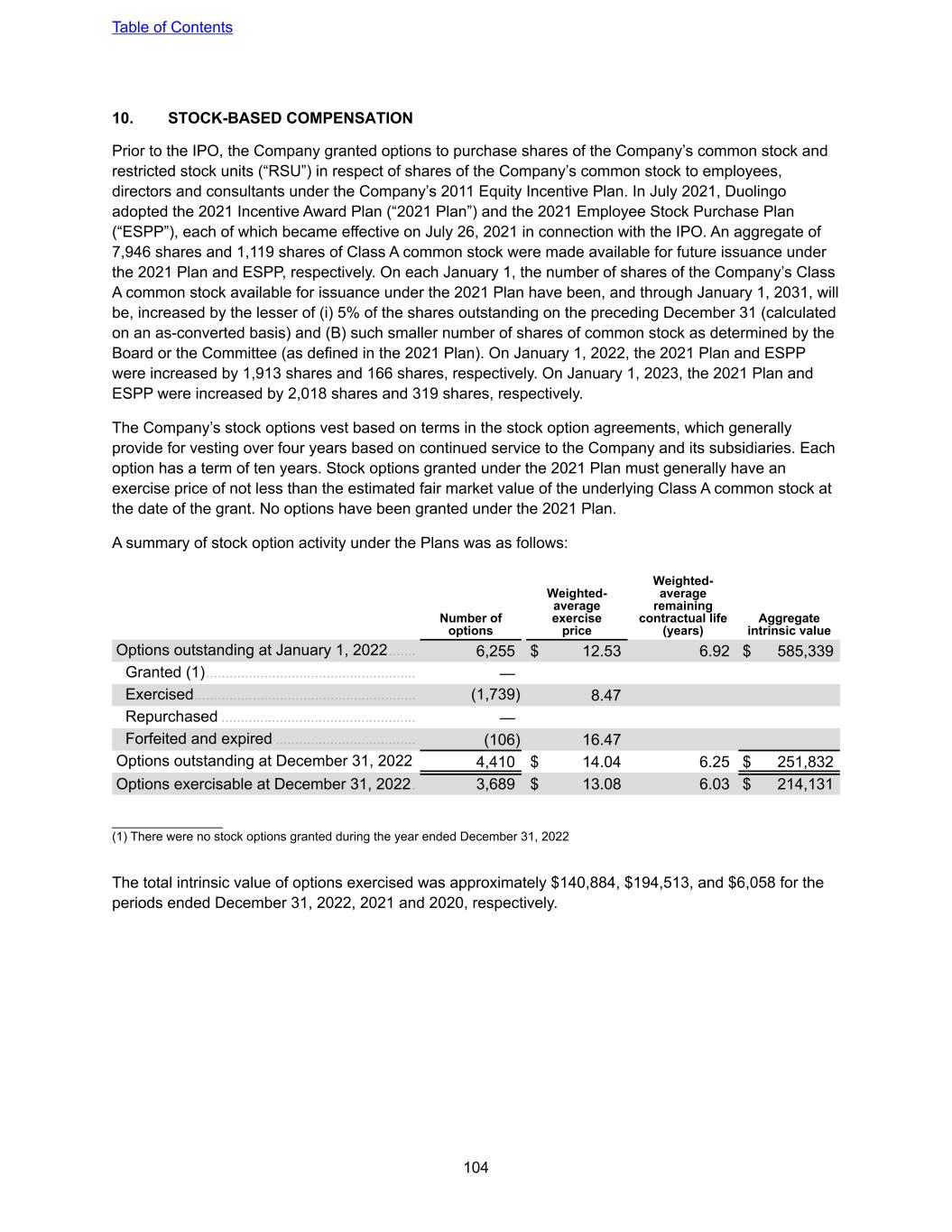
10. STOCK-BASED COMPENSATION Prior to the IPO, the Company granted options to purchase shares of the Company’s common stock and restricted stock units (“RSU”) in respect of shares of the Company’s common stock to employees, directors and consultants under the Company’s 2011 Equity Incentive Plan. In July 2021, Duolingo adopted the 2021 Incentive Award Plan (“2021 Plan”) and the 2021 Employee Stock Purchase Plan (“ESPP”), each of which became effective on July 26, 2021 in connection with the IPO. An aggregate of 7,946 shares and 1,119 shares of Class A common stock were made available for future issuance under the 2021 Plan and ESPP, respectively. On each January 1, the number of shares of the Company’s Class A common stock available for issuance under the 2021 Plan have been, and through January 1, 2031, will be, increased by the lesser of (i) 5% of the shares outstanding on the preceding December 31 (calculated on an as-converted basis) and (B) such smaller number of shares of common stock as determined by the Board or the Committee (as defined in the 2021 Plan). On January 1, 2022, the 2021 Plan and ESPP were increased by 1,913 shares and 166 shares, respectively. On January 1, 2023, the 2021 Plan and ESPP were increased by 2,018 shares and 319 shares, respectively. The Company’s stock options vest based on terms in the stock option agreements, which generally provide for vesting over four years based on continued service to the Company and its subsidiaries. Each option has a term of ten years. Stock options granted under the 2021 Plan must generally have an exercise price of not less than the estimated fair market value of the underlying Class A common stock at the date of the grant. No options have been granted under the 2021 Plan. A summary of stock option activity under the Plans was as follows: Number of options Weighted- average exercise price Weighted- average remaining contractual life (years) Aggregate intrinsic value Options outstanding at January 1, 2022 ....... 6,255 $ 12.53 6.92 $ 585,339 Granted (1) ...................................................... — Exercised ......................................................... (1,739) 8.47 Repurchased .................................................. — Forfeited and expired .................................... (106) 16.47 Options outstanding at December 31, 2022 4,410 $ 14.04 6.25 $ 251,832 Options exercisable at December 31, 2022 . 3,689 $ 13.08 6.03 $ 214,131 ________________ (1) There were no stock options granted during the year ended December 31, 2022 The total intrinsic value of options exercised was approximately $140,884, $194,513, and $6,058 for the periods ended December 31, 2022, 2021 and 2020, respectively. Table of Contents 104
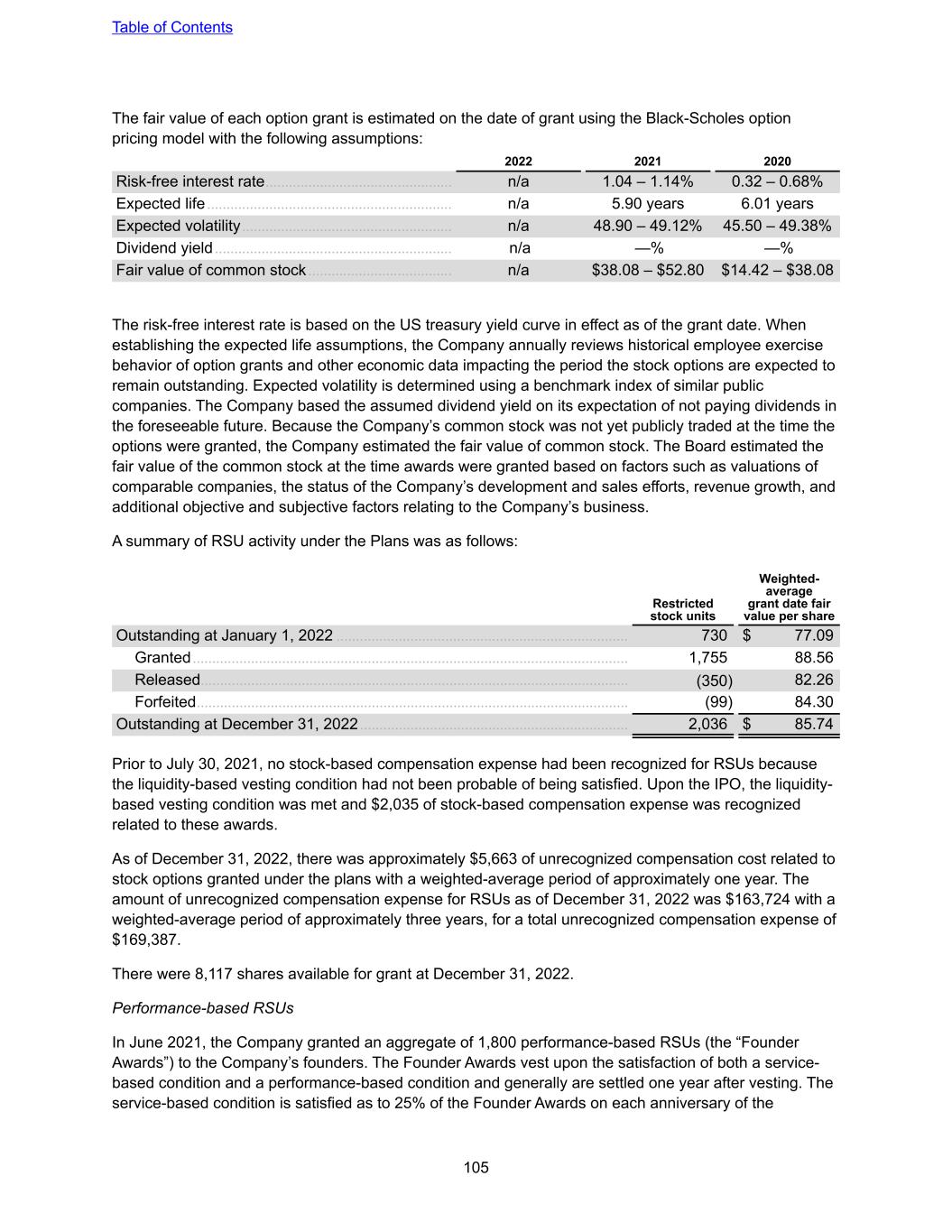
The fair value of each option grant is estimated on the date of grant using the Black-Scholes option pricing model with the following assumptions: 2022 2021 2020 Risk-free interest rate ................................................ n/a 1.04 – 1.14% 0.32 – 0.68% Expected life ............................................................... n/a 5.90 years 6.01 years Expected volatility ...................................................... n/a 48.90 – 49.12% 45.50 – 49.38% Dividend yield ............................................................. n/a —% —% Fair value of common stock ..................................... n/a $38.08 – $52.80 $14.42 – $38.08 The risk-free interest rate is based on the US treasury yield curve in effect as of the grant date. When establishing the expected life assumptions, the Company annually reviews historical employee exercise behavior of option grants and other economic data impacting the period the stock options are expected to remain outstanding. Expected volatility is determined using a benchmark index of similar public companies. The Company based the assumed dividend yield on its expectation of not paying dividends in the foreseeable future. Because the Company’s common stock was not yet publicly traded at the time the options were granted, the Company estimated the fair value of common stock. The Board estimated the fair value of the common stock at the time awards were granted based on factors such as valuations of comparable companies, the status of the Company’s development and sales efforts, revenue growth, and additional objective and subjective factors relating to the Company’s business. A summary of RSU activity under the Plans was as follows: Restricted stock units Weighted- average grant date fair value per share Outstanding at January 1, 2022 ........................................................................... 730 $ 77.09 Granted ................................................................................................................ 1,755 88.56 Released.............................................................................................................. (350) 82.26 Forfeited ............................................................................................................... (99) 84.30 Outstanding at December 31, 2022 ..................................................................... 2,036 $ 85.74 Prior to July 30, 2021, no stock-based compensation expense had been recognized for RSUs because the liquidity-based vesting condition had not been probable of being satisfied. Upon the IPO, the liquidity- based vesting condition was met and $2,035 of stock-based compensation expense was recognized related to these awards. As of December 31, 2022, there was approximately $5,663 of unrecognized compensation cost related to stock options granted under the plans with a weighted-average period of approximately one year. The amount of unrecognized compensation expense for RSUs as of December 31, 2022 was $163,724 with a weighted-average period of approximately three years, for a total unrecognized compensation expense of $169,387. There were 8,117 shares available for grant at December 31, 2022. Performance-based RSUs In June 2021, the Company granted an aggregate of 1,800 performance-based RSUs (the “Founder Awards”) to the Company’s founders. The Founder Awards vest upon the satisfaction of both a service- based condition and a performance-based condition and generally are settled one year after vesting. The service-based condition is satisfied as to 25% of the Founder Awards on each anniversary of the Table of Contents 105
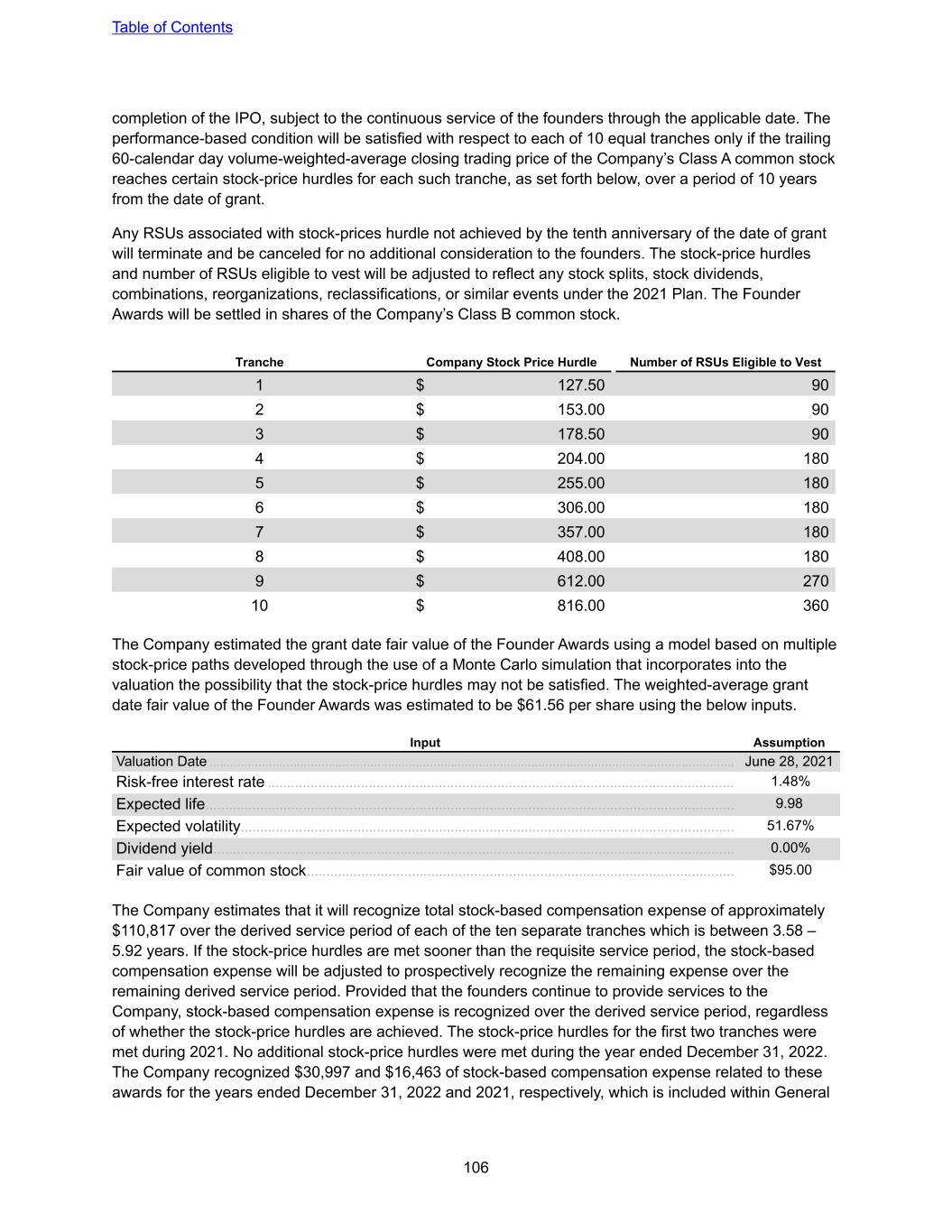
completion of the IPO, subject to the continuous service of the founders through the applicable date. The performance-based condition will be satisfied with respect to each of 10 equal tranches only if the trailing 60-calendar day volume-weighted-average closing trading price of the Company’s Class A common stock reaches certain stock-price hurdles for each such tranche, as set forth below, over a period of 10 years from the date of grant. Any RSUs associated with stock-prices hurdle not achieved by the tenth anniversary of the date of grant will terminate and be canceled for no additional consideration to the founders. The stock-price hurdles and number of RSUs eligible to vest will be adjusted to reflect any stock splits, stock dividends, combinations, reorganizations, reclassifications, or similar events under the 2021 Plan. The Founder Awards will be settled in shares of the Company’s Class B common stock. Tranche Company Stock Price Hurdle Number of RSUs Eligible to Vest 1 $ 127.50 90 2 $ 153.00 90 3 $ 178.50 90 4 $ 204.00 180 5 $ 255.00 180 6 $ 306.00 180 7 $ 357.00 180 8 $ 408.00 180 9 $ 612.00 270 10 $ 816.00 360 The Company estimated the grant date fair value of the Founder Awards using a model based on multiple stock-price paths developed through the use of a Monte Carlo simulation that incorporates into the valuation the possibility that the stock-price hurdles may not be satisfied. The weighted-average grant date fair value of the Founder Awards was estimated to be $61.56 per share using the below inputs. Input Assumption Valuation Date ...................................................................................................................................................... June 28, 2021 Risk-free interest rate ........................................................................................................................ 1.48% Expected life ........................................................................................................................................ 9.98 Expected volatility ............................................................................................................................... 51.67% Dividend yield ...................................................................................................................................... 0.00% Fair value of common stock .............................................................................................................. $95.00 The Company estimates that it will recognize total stock-based compensation expense of approximately $110,817 over the derived service period of each of the ten separate tranches which is between 3.58 – 5.92 years. If the stock-price hurdles are met sooner than the requisite service period, the stock-based compensation expense will be adjusted to prospectively recognize the remaining expense over the remaining derived service period. Provided that the founders continue to provide services to the Company, stock-based compensation expense is recognized over the derived service period, regardless of whether the stock-price hurdles are achieved. The stock-price hurdles for the first two tranches were met during 2021. No additional stock-price hurdles were met during the year ended December 31, 2022. The Company recognized $30,997 and $16,463 of stock-based compensation expense related to these awards for the years ended December 31, 2022 and 2021, respectively, which is included within General Table of Contents 106
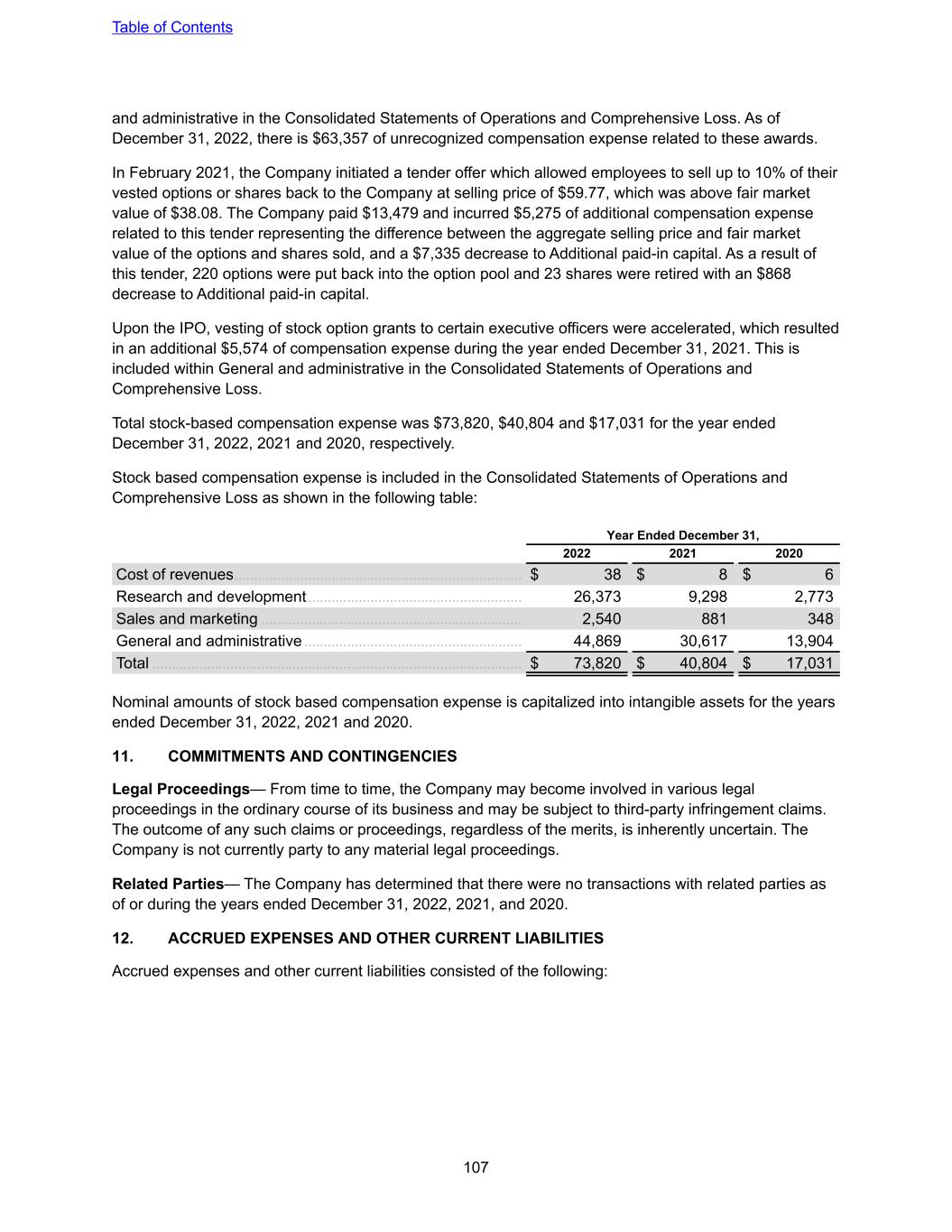
and administrative in the Consolidated Statements of Operations and Comprehensive Loss. As of December 31, 2022, there is $63,357 of unrecognized compensation expense related to these awards. In February 2021, the Company initiated a tender offer which allowed employees to sell up to 10% of their vested options or shares back to the Company at selling price of $59.77, which was above fair market value of $38.08. The Company paid $13,479 and incurred $5,275 of additional compensation expense related to this tender representing the difference between the aggregate selling price and fair market value of the options and shares sold, and a $7,335 decrease to Additional paid-in capital. As a result of this tender, 220 options were put back into the option pool and 23 shares were retired with an $868 decrease to Additional paid-in capital. Upon the IPO, vesting of stock option grants to certain executive officers were accelerated, which resulted in an additional $5,574 of compensation expense during the year ended December 31, 2021. This is included within General and administrative in the Consolidated Statements of Operations and Comprehensive Loss. Total stock-based compensation expense was $73,820, $40,804 and $17,031 for the year ended December 31, 2022, 2021 and 2020, respectively. Stock based compensation expense is included in the Consolidated Statements of Operations and Comprehensive Loss as shown in the following table: Year Ended December 31, 2022 2021 2020 Cost of revenues .......................................................................... $ 38 $ 8 $ 6 Research and development ....................................................... 26,373 9,298 2,773 Sales and marketing ................................................................... 2,540 881 348 General and administrative ........................................................ 44,869 30,617 13,904 Total ............................................................................................... $ 73,820 $ 40,804 $ 17,031 Nominal amounts of stock based compensation expense is capitalized into intangible assets for the years ended December 31, 2022, 2021 and 2020. 11. COMMITMENTS AND CONTINGENCIES Legal Proceedings— From time to time, the Company may become involved in various legal proceedings in the ordinary course of its business and may be subject to third-party infringement claims. The outcome of any such claims or proceedings, regardless of the merits, is inherently uncertain. The Company is not currently party to any material legal proceedings. Related Parties— The Company has determined that there were no transactions with related parties as of or during the years ended December 31, 2022, 2021, and 2020. 12. ACCRUED EXPENSES AND OTHER CURRENT LIABILITIES Accrued expenses and other current liabilities consisted of the following: Table of Contents 107
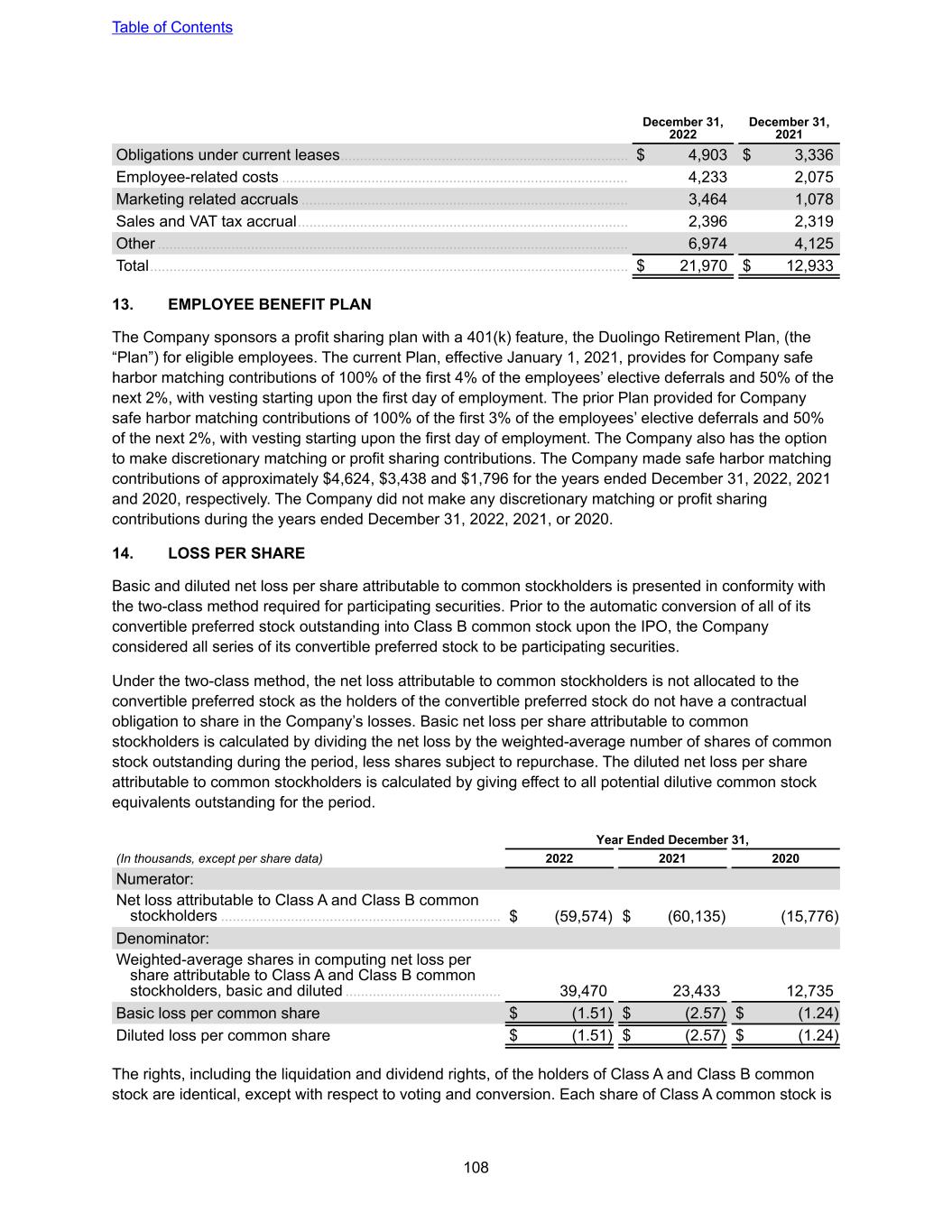
December 31, 2022 December 31, 2021 Obligations under current leases .......................................................................... $ 4,903 $ 3,336 Employee-related costs ......................................................................................... 4,233 2,075 Marketing related accruals .................................................................................... 3,464 1,078 Sales and VAT tax accrual ..................................................................................... 2,396 2,319 Other ......................................................................................................................... 6,974 4,125 Total ........................................................................................................................... $ 21,970 $ 12,933 13. EMPLOYEE BENEFIT PLAN The Company sponsors a profit sharing plan with a 401(k) feature, the Duolingo Retirement Plan, (the “Plan”) for eligible employees. The current Plan, effective January 1, 2021, provides for Company safe harbor matching contributions of 100% of the first 4% of the employees’ elective deferrals and 50% of the next 2%, with vesting starting upon the first day of employment. The prior Plan provided for Company safe harbor matching contributions of 100% of the first 3% of the employees’ elective deferrals and 50% of the next 2%, with vesting starting upon the first day of employment. The Company also has the option to make discretionary matching or profit sharing contributions. The Company made safe harbor matching contributions of approximately $4,624, $3,438 and $1,796 for the years ended December 31, 2022, 2021 and 2020, respectively. The Company did not make any discretionary matching or profit sharing contributions during the years ended December 31, 2022, 2021, or 2020. 14. LOSS PER SHARE Basic and diluted net loss per share attributable to common stockholders is presented in conformity with the two-class method required for participating securities. Prior to the automatic conversion of all of its convertible preferred stock outstanding into Class B common stock upon the IPO, the Company considered all series of its convertible preferred stock to be participating securities. Under the two-class method, the net loss attributable to common stockholders is not allocated to the convertible preferred stock as the holders of the convertible preferred stock do not have a contractual obligation to share in the Company’s losses. Basic net loss per share attributable to common stockholders is calculated by dividing the net loss by the weighted-average number of shares of common stock outstanding during the period, less shares subject to repurchase. The diluted net loss per share attributable to common stockholders is calculated by giving effect to all potential dilutive common stock equivalents outstanding for the period. Year Ended December 31, (In thousands, except per share data) 2022 2021 2020 Numerator: Net loss attributable to Class A and Class B common stockholders ........................................................................ $ (59,574) $ (60,135) (15,776) Denominator: Weighted-average shares in computing net loss per share attributable to Class A and Class B common stockholders, basic and diluted ........................................ 39,470 23,433 12,735 Basic loss per common share $ (1.51) $ (2.57) $ (1.24) Diluted loss per common share $ (1.51) $ (2.57) $ (1.24) The rights, including the liquidation and dividend rights, of the holders of Class A and Class B common stock are identical, except with respect to voting and conversion. Each share of Class A common stock is Table of Contents 108
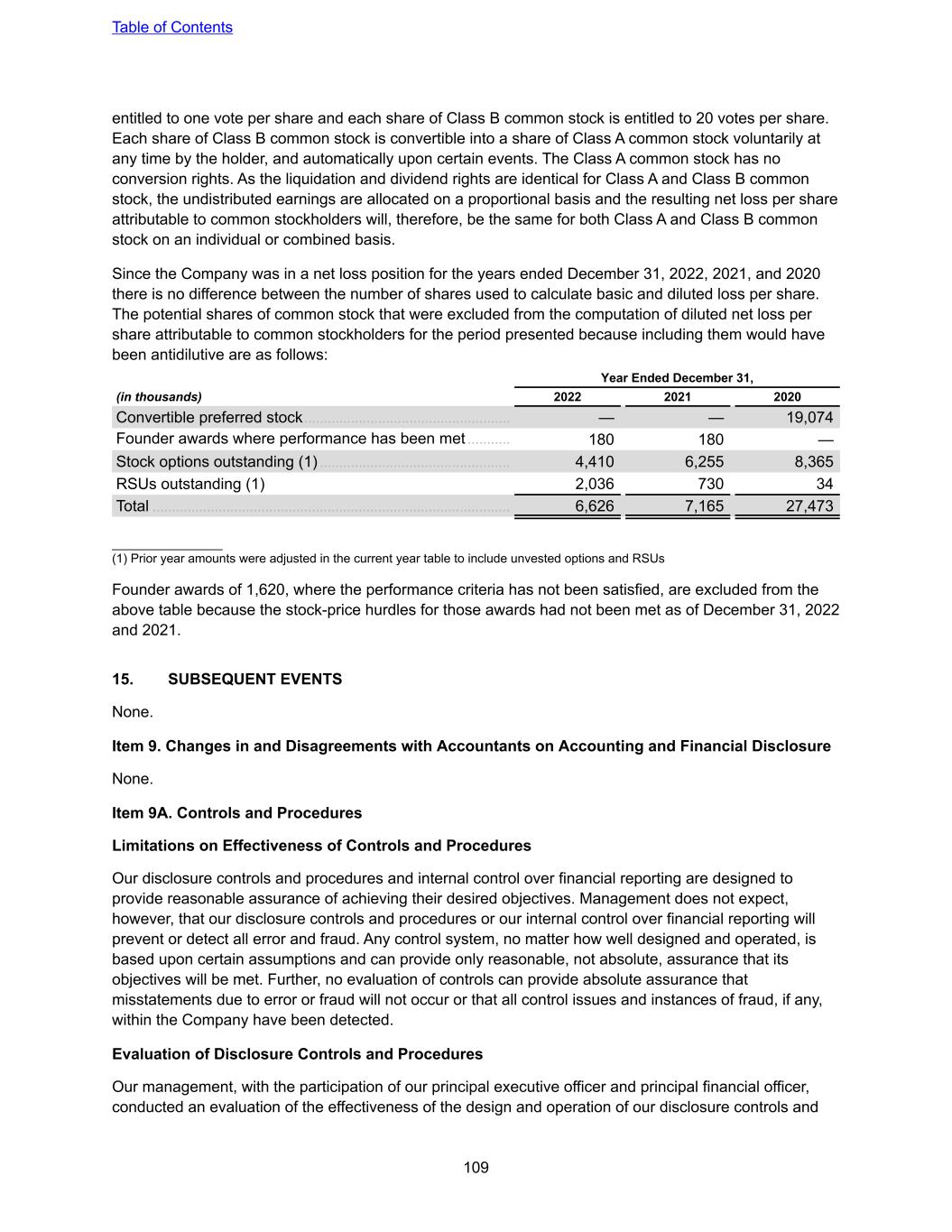
entitled to one vote per share and each share of Class B common stock is entitled to 20 votes per share. Each share of Class B common stock is convertible into a share of Class A common stock voluntarily at any time by the holder, and automatically upon certain events. The Class A common stock has no conversion rights. As the liquidation and dividend rights are identical for Class A and Class B common stock, the undistributed earnings are allocated on a proportional basis and the resulting net loss per share attributable to common stockholders will, therefore, be the same for both Class A and Class B common stock on an individual or combined basis. Since the Company was in a net loss position for the years ended December 31, 2022, 2021, and 2020 there is no difference between the number of shares used to calculate basic and diluted loss per share. The potential shares of common stock that were excluded from the computation of diluted net loss per share attributable to common stockholders for the period presented because including them would have been antidilutive are as follows: Year Ended December 31, (in thousands) 2022 2021 2020 Convertible preferred stock ..................................................... — — 19,074 Founder awards where performance has been met ........... 180 180 — Stock options outstanding (1) ................................................. 4,410 6,255 8,365 RSUs outstanding (1) 2,036 730 34 Total ............................................................................................ 6,626 7,165 27,473 ________________ (1) Prior year amounts were adjusted in the current year table to include unvested options and RSUs Founder awards of 1,620, where the performance criteria has not been satisfied, are excluded from the above table because the stock-price hurdles for those awards had not been met as of December 31, 2022 and 2021. 15. SUBSEQUENT EVENTS None. Item 9. Changes in and Disagreements with Accountants on Accounting and Financial Disclosure None. Item 9A. Controls and Procedures Limitations on Effectiveness of Controls and Procedures Our disclosure controls and procedures and internal control over financial reporting are designed to provide reasonable assurance of achieving their desired objectives. Management does not expect, however, that our disclosure controls and procedures or our internal control over financial reporting will prevent or detect all error and fraud. Any control system, no matter how well designed and operated, is based upon certain assumptions and can provide only reasonable, not absolute, assurance that its objectives will be met. Further, no evaluation of controls can provide absolute assurance that misstatements due to error or fraud will not occur or that all control issues and instances of fraud, if any, within the Company have been detected. Evaluation of Disclosure Controls and Procedures Our management, with the participation of our principal executive officer and principal financial officer, conducted an evaluation of the effectiveness of the design and operation of our disclosure controls and Table of Contents 109
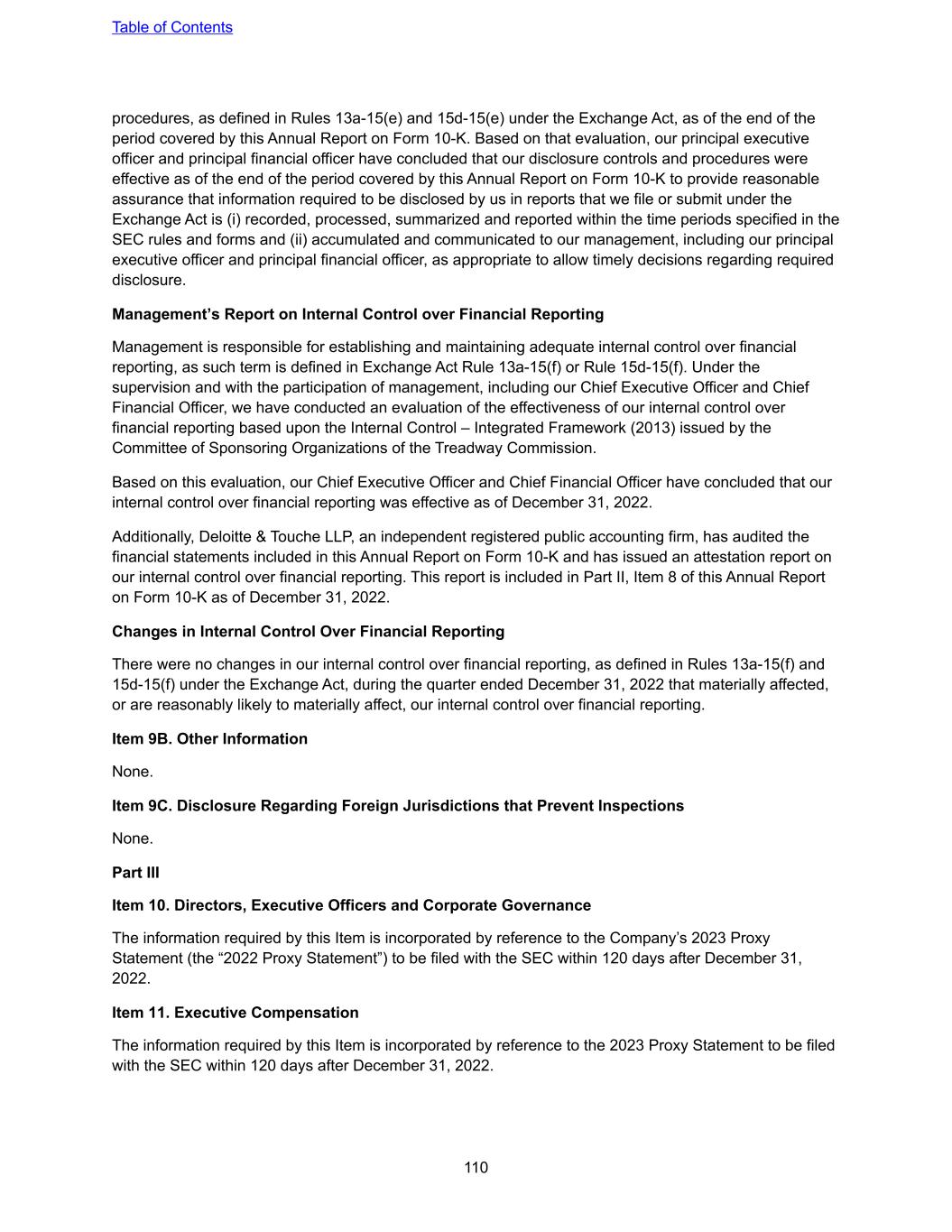
procedures, as defined in Rules 13a-15(e) and 15d-15(e) under the Exchange Act, as of the end of the period covered by this Annual Report on Form 10-K. Based on that evaluation, our principal executive officer and principal financial officer have concluded that our disclosure controls and procedures were effective as of the end of the period covered by this Annual Report on Form 10-K to provide reasonable assurance that information required to be disclosed by us in reports that we file or submit under the Exchange Act is (i) recorded, processed, summarized and reported within the time periods specified in the SEC rules and forms and (ii) accumulated and communicated to our management, including our principal executive officer and principal financial officer, as appropriate to allow timely decisions regarding required disclosure. Management’s Report on Internal Control over Financial Reporting Management is responsible for establishing and maintaining adequate internal control over financial reporting, as such term is defined in Exchange Act Rule 13a-15(f) or Rule 15d-15(f). Under the supervision and with the participation of management, including our Chief Executive Officer and Chief Financial Officer, we have conducted an evaluation of the effectiveness of our internal control over financial reporting based upon the Internal Control – Integrated Framework (2013) issued by the Committee of Sponsoring Organizations of the Treadway Commission. Based on this evaluation, our Chief Executive Officer and Chief Financial Officer have concluded that our internal control over financial reporting was effective as of December 31, 2022. Additionally, Deloitte & Touche LLP, an independent registered public accounting firm, has audited the financial statements included in this Annual Report on Form 10-K and has issued an attestation report on our internal control over financial reporting. This report is included in Part II, Item 8 of this Annual Report on Form 10-K as of December 31, 2022. Changes in Internal Control Over Financial Reporting There were no changes in our internal control over financial reporting, as defined in Rules 13a-15(f) and 15d-15(f) under the Exchange Act, during the quarter ended December 31, 2022 that materially affected, or are reasonably likely to materially affect, our internal control over financial reporting. Item 9B. Other Information None. Item 9C. Disclosure Regarding Foreign Jurisdictions that Prevent Inspections None. Part III Item 10. Directors, Executive Officers and Corporate Governance The information required by this Item is incorporated by reference to the Company’s 2023 Proxy Statement (the “2022 Proxy Statement”) to be filed with the SEC within 120 days after December 31, 2022. Item 11. Executive Compensation The information required by this Item is incorporated by reference to the 2023 Proxy Statement to be filed with the SEC within 120 days after December 31, 2022. Table of Contents 110
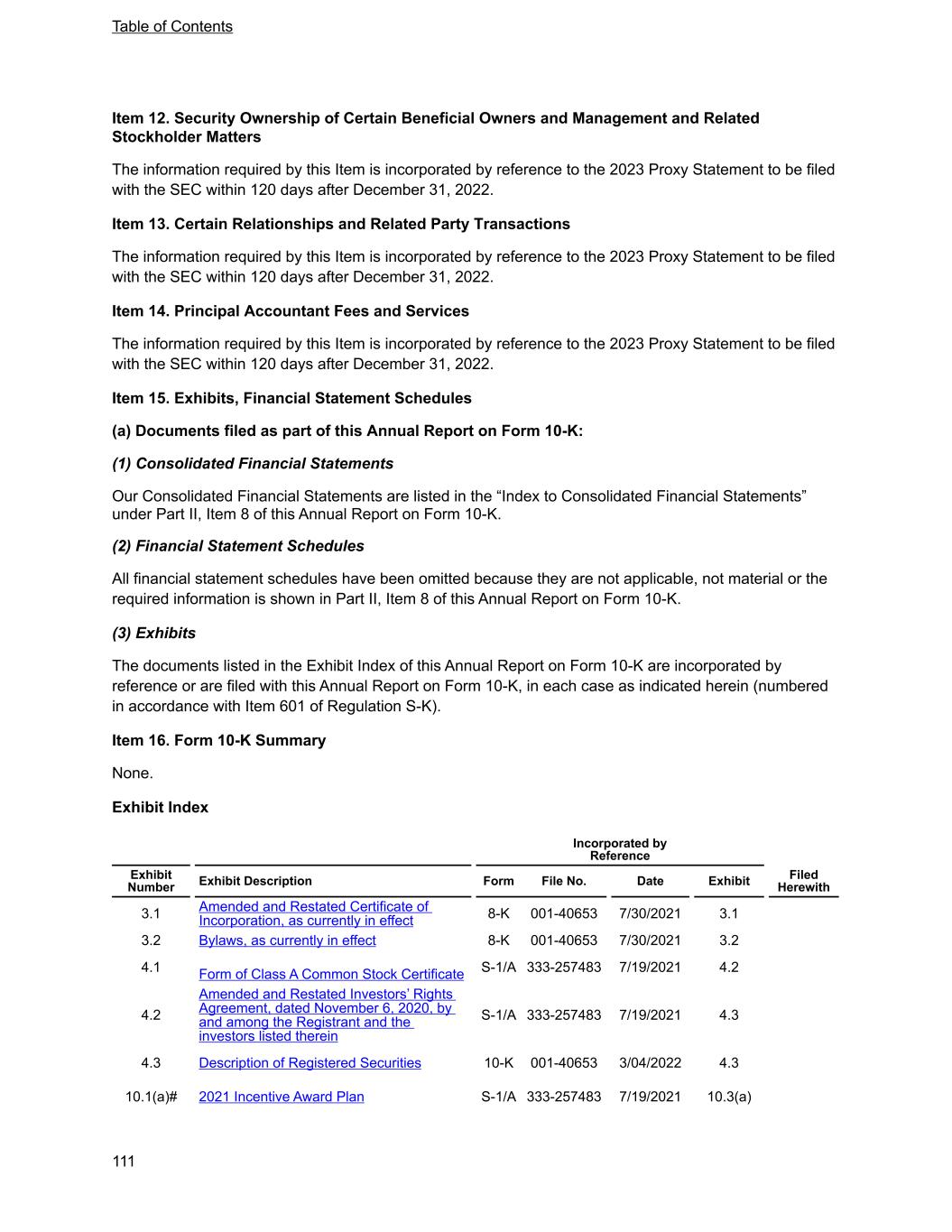
Item 12. Security Ownership of Certain Beneficial Owners and Management and Related Stockholder Matters The information required by this Item is incorporated by reference to the 2023 Proxy Statement to be filed with the SEC within 120 days after December 31, 2022. Item 13. Certain Relationships and Related Party Transactions The information required by this Item is incorporated by reference to the 2023 Proxy Statement to be filed with the SEC within 120 days after December 31, 2022. Item 14. Principal Accountant Fees and Services The information required by this Item is incorporated by reference to the 2023 Proxy Statement to be filed with the SEC within 120 days after December 31, 2022. Item 15. Exhibits, Financial Statement Schedules (a) Documents filed as part of this Annual Report on Form 10-K: (1) Consolidated Financial Statements Our Consolidated Financial Statements are listed in the “Index to Consolidated Financial Statements” under Part II, Item 8 of this Annual Report on Form 10-K. (2) Financial Statement Schedules All financial statement schedules have been omitted because they are not applicable, not material or the required information is shown in Part II, Item 8 of this Annual Report on Form 10-K. (3) Exhibits The documents listed in the Exhibit Index of this Annual Report on Form 10-K are incorporated by reference or are filed with this Annual Report on Form 10-K, in each case as indicated herein (numbered in accordance with Item 601 of Regulation S-K). Item 16. Form 10-K Summary None. Exhibit Index Incorporated by Reference Exhibit Number Exhibit Description Form File No. Date Exhibit Filed Herewith 3.1 Amended and Restated Certificate of Incorporation, as currently in effect 8-K 001-40653 7/30/2021 3.1 3.2 Bylaws, as currently in effect 8-K 001-40653 7/30/2021 3.2 4.1 Form of Class A Common Stock Certificate S-1/A 333-257483 7/19/2021 4.2 4.2 Amended and Restated Investors’ Rights Agreement, dated November 6, 2020, by and among the Registrant and the investors listed therein S-1/A 333-257483 7/19/2021 4.3 4.3 Description of Registered Securities 10-K 001-40653 3/04/2022 4.3 10.1(a)# 2021 Incentive Award Plan S-1/A 333-257483 7/19/2021 10.3(a) Table of Contents 111
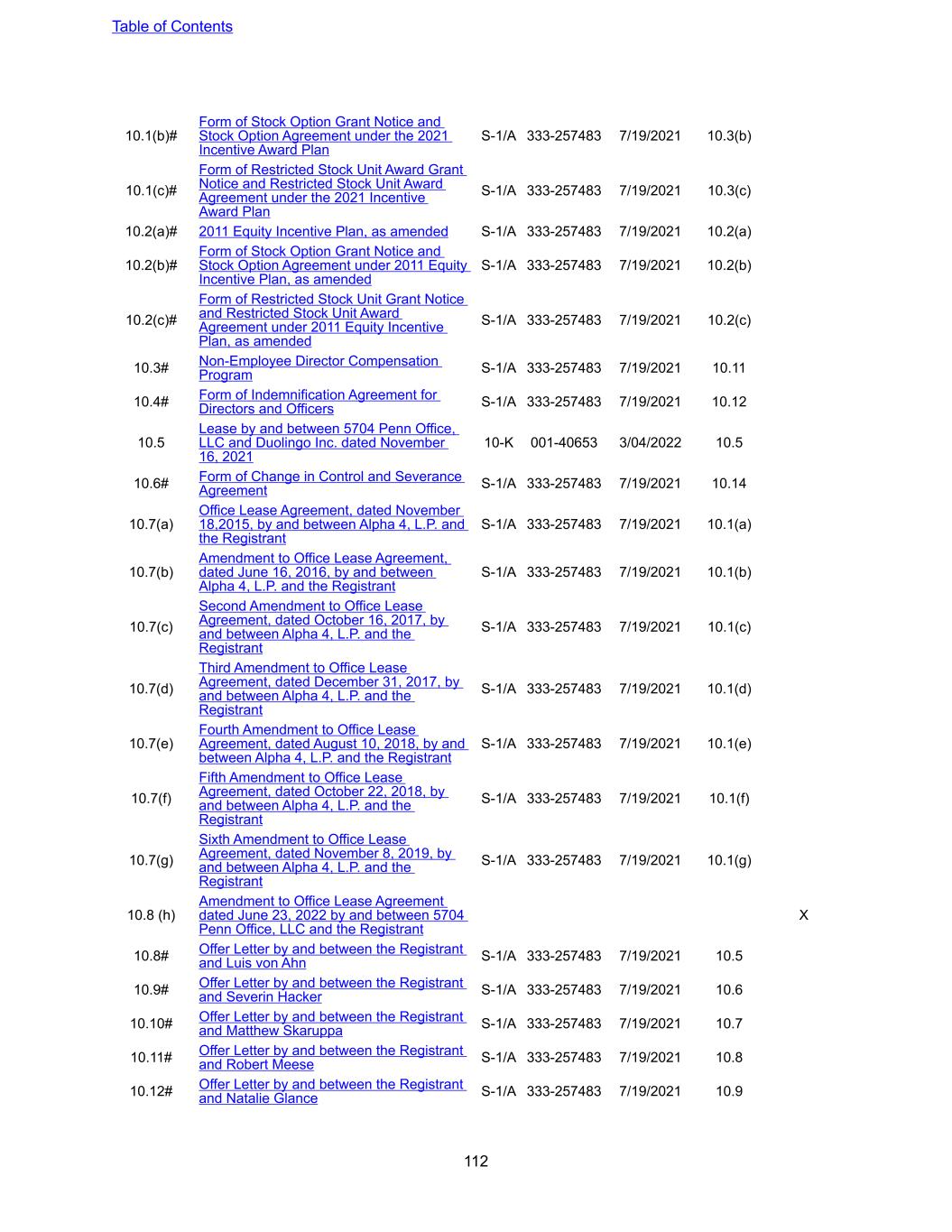
10.1(b)# Form of Stock Option Grant Notice and Stock Option Agreement under the 2021 Incentive Award Plan S-1/A 333-257483 7/19/2021 10.3(b) 10.1(c)# Form of Restricted Stock Unit Award Grant Notice and Restricted Stock Unit Award Agreement under the 2021 Incentive Award Plan S-1/A 333-257483 7/19/2021 10.3(c) 10.2(a)# 2011 Equity Incentive Plan, as amended S-1/A 333-257483 7/19/2021 10.2(a) 10.2(b)# Form of Stock Option Grant Notice and Stock Option Agreement under 2011 Equity Incentive Plan, as amended S-1/A 333-257483 7/19/2021 10.2(b) 10.2(c)# Form of Restricted Stock Unit Grant Notice and Restricted Stock Unit Award Agreement under 2011 Equity Incentive Plan, as amended S-1/A 333-257483 7/19/2021 10.2(c) 10.3# Non-Employee Director Compensation Program S-1/A 333-257483 7/19/2021 10.11 10.4# Form of Indemnification Agreement for Directors and Officers S-1/A 333-257483 7/19/2021 10.12 10.5 Lease by and between 5704 Penn Office, LLC and Duolingo Inc. dated November 16, 2021 10-K 001-40653 3/04/2022 10.5 10.6# Form of Change in Control and Severance Agreement S-1/A 333-257483 7/19/2021 10.14 10.7(a) Office Lease Agreement, dated November 18,2015, by and between Alpha 4, L.P. and the Registrant S-1/A 333-257483 7/19/2021 10.1(a) 10.7(b) Amendment to Office Lease Agreement, dated June 16, 2016, by and between Alpha 4, L.P. and the Registrant S-1/A 333-257483 7/19/2021 10.1(b) 10.7(c) Second Amendment to Office Lease Agreement, dated October 16, 2017, by and between Alpha 4, L.P. and the Registrant S-1/A 333-257483 7/19/2021 10.1(c) 10.7(d) Third Amendment to Office Lease Agreement, dated December 31, 2017, by and between Alpha 4, L.P. and the Registrant S-1/A 333-257483 7/19/2021 10.1(d) 10.7(e) Fourth Amendment to Office Lease Agreement, dated August 10, 2018, by and between Alpha 4, L.P. and the Registrant S-1/A 333-257483 7/19/2021 10.1(e) 10.7(f) Fifth Amendment to Office Lease Agreement, dated October 22, 2018, by and between Alpha 4, L.P. and the Registrant S-1/A 333-257483 7/19/2021 10.1(f) 10.7(g) Sixth Amendment to Office Lease Agreement, dated November 8, 2019, by and between Alpha 4, L.P. and the Registrant S-1/A 333-257483 7/19/2021 10.1(g) 10.8 (h) Amendment to Office Lease Agreement dated June 23, 2022 by and between 5704 Penn Office, LLC and the Registrant X 10.8# Offer Letter by and between the Registrant and Luis von Ahn S-1/A 333-257483 7/19/2021 10.5 10.9# Offer Letter by and between the Registrant and Severin Hacker S-1/A 333-257483 7/19/2021 10.6 10.10# Offer Letter by and between the Registrant and Matthew Skaruppa S-1/A 333-257483 7/19/2021 10.7 10.11# Offer Letter by and between the Registrant and Robert Meese S-1/A 333-257483 7/19/2021 10.8 10.12# Offer Letter by and between the Registrant and Natalie Glance S-1/A 333-257483 7/19/2021 10.9 Table of Contents 112
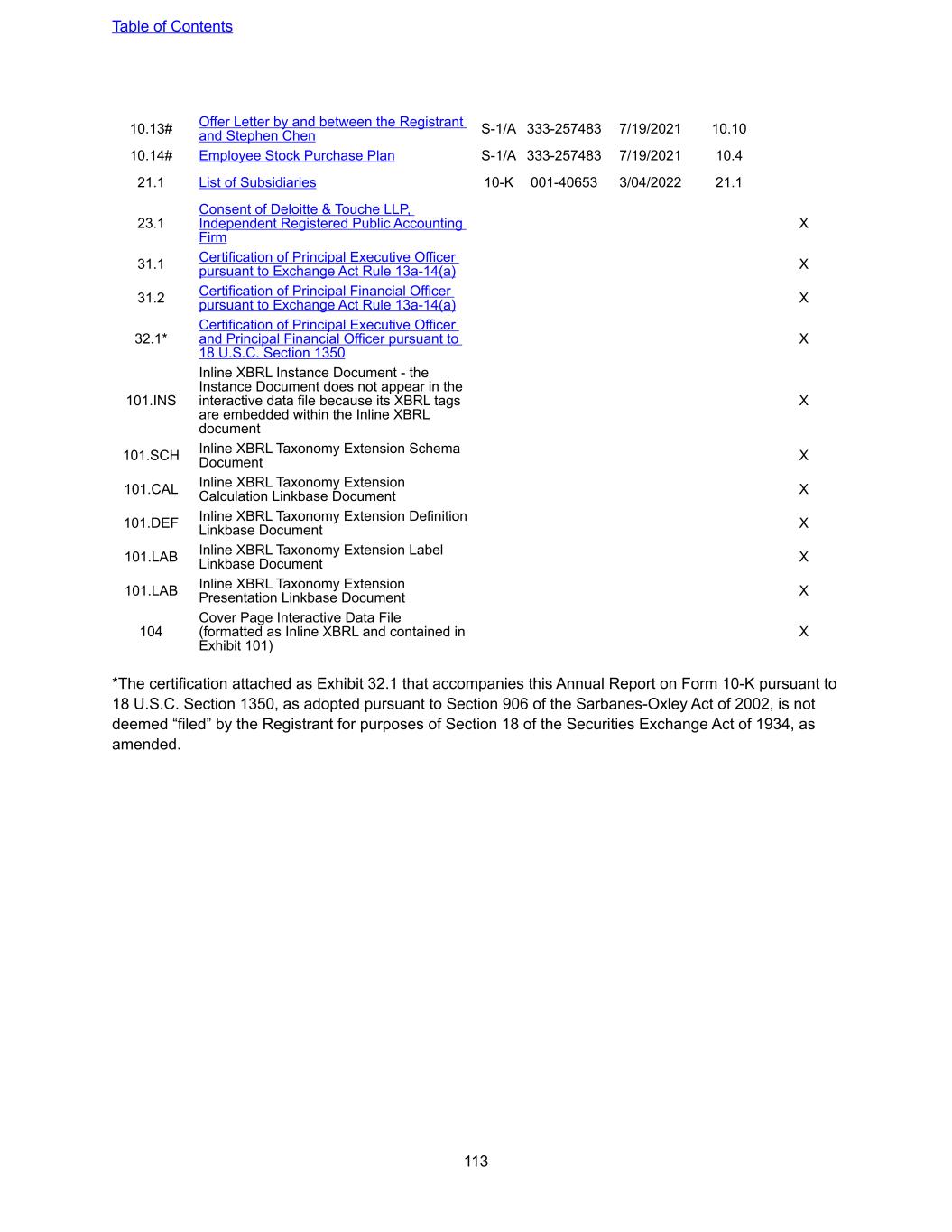
10.13# Offer Letter by and between the Registrant and Stephen Chen S-1/A 333-257483 7/19/2021 10.10 10.14# Employee Stock Purchase Plan S-1/A 333-257483 7/19/2021 10.4 21.1 List of Subsidiaries 10-K 001-40653 3/04/2022 21.1 23.1 Consent of Deloitte & Touche LLP, Independent Registered Public Accounting Firm X 31.1 Certification of Principal Executive Officer pursuant to Exchange Act Rule 13a-14(a) X 31.2 Certification of Principal Financial Officer pursuant to Exchange Act Rule 13a-14(a) X 32.1* Certification of Principal Executive Officer and Principal Financial Officer pursuant to 18 U.S.C. Section 1350 X 101.INS Inline XBRL Instance Document - the Instance Document does not appear in the interactive data file because its XBRL tags are embedded within the Inline XBRL document X 101.SCH Inline XBRL Taxonomy Extension Schema Document X 101.CAL Inline XBRL Taxonomy Extension Calculation Linkbase Document X 101.DEF Inline XBRL Taxonomy Extension Definition Linkbase Document X 101.LAB Inline XBRL Taxonomy Extension Label Linkbase Document X 101.LAB Inline XBRL Taxonomy Extension Presentation Linkbase Document X 104 Cover Page Interactive Data File (formatted as Inline XBRL and contained in Exhibit 101) X *The certification attached as Exhibit 32.1 that accompanies this Annual Report on Form 10-K pursuant to 18 U.S.C. Section 1350, as adopted pursuant to Section 906 of the Sarbanes-Oxley Act of 2002, is not deemed “filed” by the Registrant for purposes of Section 18 of the Securities Exchange Act of 1934, as amended. Table of Contents 113
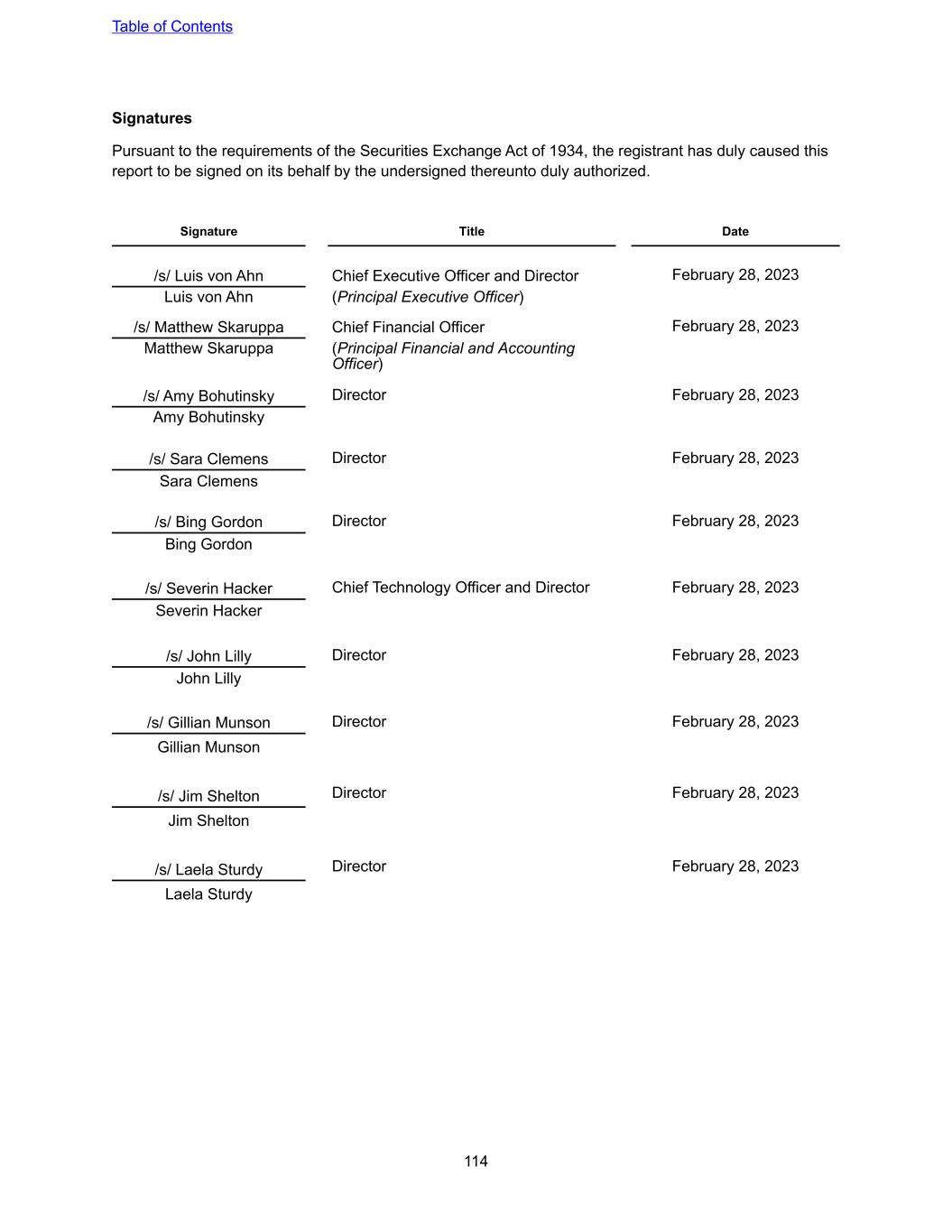
Signatures Pursuant to the requirements of the Securities Exchange Act of 1934, the registrant has duly caused this report to be signed on its behalf by the undersigned thereunto duly authorized. Signature Title Date /s/ Luis von Ahn Chief Executive Officer and Director February 28, 2023 Luis von Ahn (Principal Executive Officer) /s/ Matthew Skaruppa Chief Financial Officer February 28, 2023 Matthew Skaruppa (Principal Financial and Accounting Officer) /s/ Amy Bohutinsky Director February 28, 2023 Amy Bohutinsky /s/ Sara Clemens Director February 28, 2023 Sara Clemens /s/ Bing Gordon Director February 28, 2023 Bing Gordon /s/ Severin Hacker Chief Technology Officer and Director February 28, 2023 Severin Hacker /s/ John Lilly Director February 28, 2023 John Lilly /s/ Gillian Munson Director February 28, 2023 Gillian Munson /s/ Jim Shelton Director February 28, 2023 Jim Shelton /s/ Laela Sturdy Director February 28, 2023 Laela Sturdy Table of Contents 114
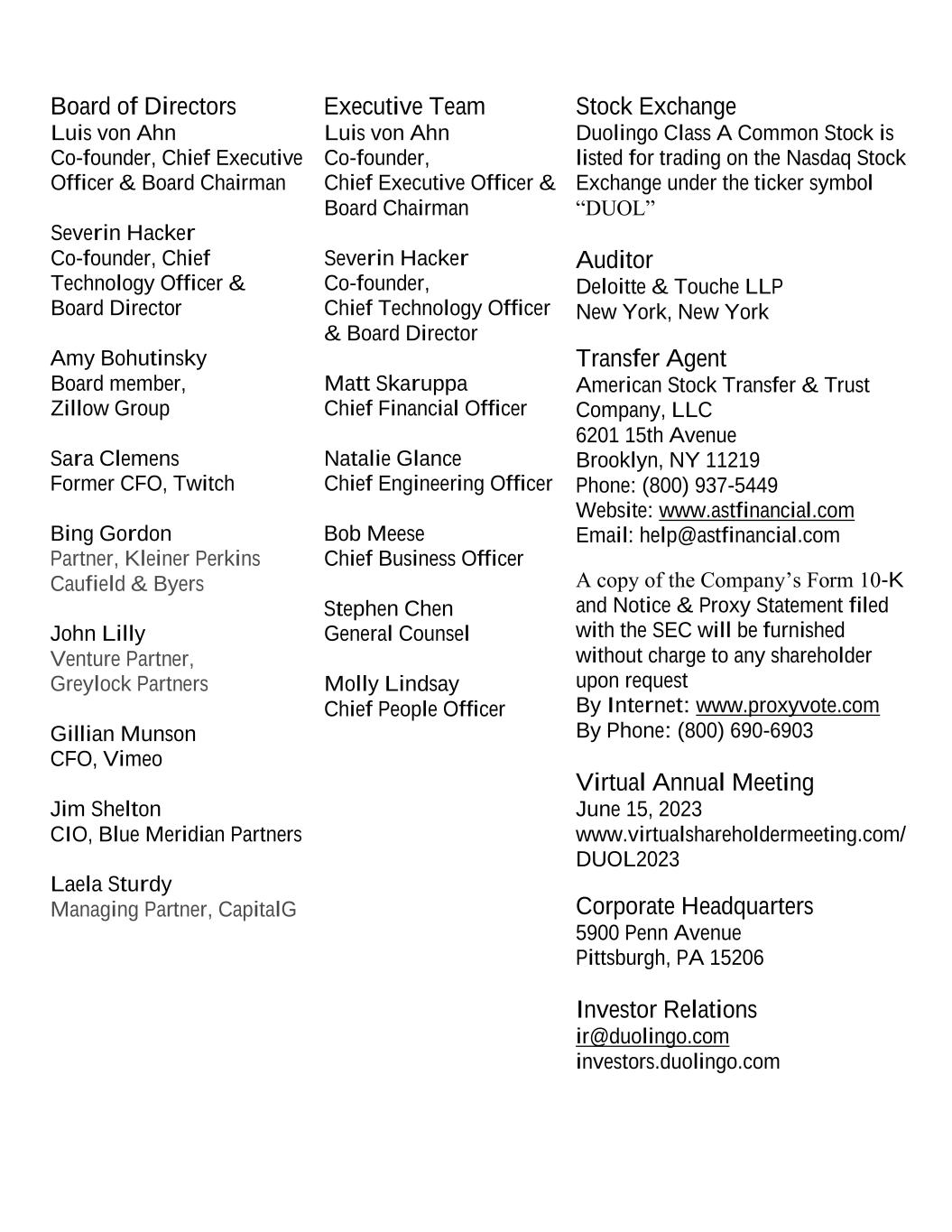
Board of Directors Executive Team Stock Exchange Luis von Ahn Co-founder, Chief Executive Officer & Board Chairman Severin Hacker Co-founder, Chief Technology Officer & Board Director Amy Bohutinsky Board member, Zillow Group Sara Clemens Former CFO, Twitch Bing Gordon Partner, Kleiner Perkins Caufield & Byers John Lilly Venture Partner, Greylock Partners Gillian Munson CFO, Vimeo Jim Shelton CIO, Blue Meridian Partners Laela Sturdy Managing Partner, CapitalG Luis von Ahn Co-founder, Chief Executive Officer & Board Chairman Severin Hacker Co-founder, Chief Technology Officer & Board Director Matt Skaruppa Chief Financial Officer Natalie Glance Chief Engineering Officer Bob Meese Chief Business Officer Stephen Chen General Counsel Molly Lindsay Chief People Officer Duolingo Class A Common Stock is listed for trading on the Nasdaq Stock Exchange under the ticker symbol “DUOL” Auditor Deloitte & Touche LLP New York, New York Transfer Agent American Stock Transfer & Trust Company, LLC 6201 15th Avenue Brooklyn, NY 11219 Phone: (800) 937-5449 Website: www.astfinancial.com Email: help@astfinancial.com A copy of the Company’s Form 10-K and Notice & Proxy Statement filed with the SEC will be furnished without charge to any shareholder upon request By Internet: www.proxyvote.com By Phone: (800) 690-6903 Virtual Annual Meeting June 15, 2023 www.virtualshareholdermeeting.com/ DUOL2023 Corporate Headquarters 5900 Penn Avenue Pittsburgh, PA 15206 Investor Relations ir@duolingo.com investors.duolingo.com